 Question. What {where?}is the feminine aspect represented at Gobekli tepe....
Question. What {where?}is the feminine aspect represented at Gobekli tepe....
Refresher: "How can we embody and integrate all the lessons learned into the very fabric of our being so that we do not have to fear individually or collectively the Great Turning at Hand. Feminine consciousness and wisdom remember {''belly'' link} the cycles of life and energy, that things ebb and flow in a recurrent process. Masculine consciousness and wisdom remind us of the necessity for demarcation and exploration of ever new and evolving realities; they remind us that tradition, LAW, order, and systems provide the vital containment of psychic life. The 'hieros gamos' of our time is this marriage of masculine and feminine...." Continued elsewhere.
Question 2. Any water sources at the base; or near; to that same ''Potbelly hill''?
A work in progress: ''Born around 185-187 BC., the only daughter of Ptolemy V and Cleopatra I, Cleopatra II makes her first notable appearance in the sources in March 175 BC., when she married her eldest brother Ptolemy VI {who was about eleven at the time}. Cleopatra II ascended the throne with Ptolemy VI as his co--ruler. In temple scenes the new queen is seen always standing behind her husband, but embodying between them the important ancient Egyptian concept of DUALITY. On the great pylon at Philae, the royal couple are shown offering wine, perfume and flowers to Isis, Horus, Hathor, Harpocrates, and Meret.....

West border = 30-60? {'thirty' - 'sixty'}.
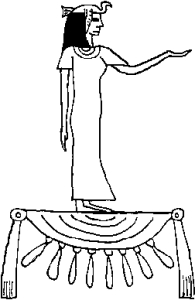
'Woodroffe' to enlarge.
Side note: ''Meret was a token wife occasionally given to Hapy, the god of the Nile flood. Her name being a reference to this, meaning simply the beloved. As token wife, she was usually depicted with the same associations as Hapy, having on her head either the blue lotus for Upper Egypt, or the papyrus plant for Lower Egypt. Since Hapy was the source of bountifulness, Meret was usually depicted with an offering bowl, as she was seen, being his wife, as the symbolic recipient of his generosity. Among the lower classes, where nationalism was less important than successful harvest, she was more strongly considered the wife of Hapy than the protectresses of Lower and Upper Egypt, which were more normally his wife in the upper classes. As a deity whose role was to be the symbolic receiver of bounty from the inundation of the Nile, she was strongly associated with rejoicing, such as singing and dancing.[1] Later stories tell that Meret was the goddess of the eighth hour, in the Book of Gates.''
''Swing {ing}'' to enlarge.
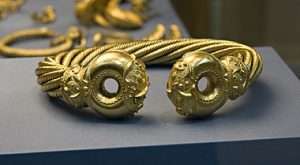
Eight strands each. 'Sixtyfour' in total.
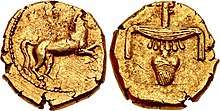
'Costly' / '120' to enlarge.
Continued: ''Another scene shows both making 'cult' offerings to Khnum, Satet, and Anuket. And at the temple of Kom Ombo, Cleopatra once more plays a supporting role to her husband - who wears the double crown - as they both STAND BEFORE Khonsu, Haroeris, and Sobek.....
Side note: Located on the banks of the Nile in a village of the same name, Kom Ombo is unique in Egypt as a double temple—dedicated to two deities, Sobek and Horus.
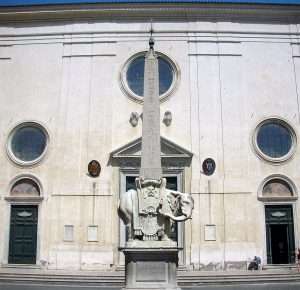 And/or: Liverpool is unusual in having two cathedrals (or should that be cathedra) As the title says Liverpool has two cathedrals so make sure this is the one you want to go to! It is the Gothic Anglican cathedral not the modernistic Catholic one affectionately known as Paddys wigwam in the city.
And/or: Liverpool is unusual in having two cathedrals (or should that be cathedra) As the title says Liverpool has two cathedrals so make sure this is the one you want to go to! It is the Gothic Anglican cathedral not the modernistic Catholic one affectionately known as Paddys wigwam in the city.
N/W tip of Europe.
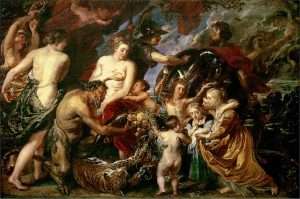
''Minerva protecting Peace from Mars or Peace and War is a painting by Peter Paul Rubens.'' Bitter and Sweet. Darkness and light. Male and female. Shadow / Light. BACK TO BACK? The youngest 'child' smack back in the middle {foreground}. Question. Animus aspect of Peace?
Continued: ''Haroeris is the sky god whose eyes are the sun and the moon. In various myths, however, he is also identified with the sun god, or functions as his son.''
Continued: ''In reality, due to the youth and inexperience of BOTH - the real power of the throne lay behind two ineffectual 'guardians': Eulaeus and Lenaeus. Despite a total lack of military experience, these two Greek courtiers quickly set Egypt on a collision course with king Antiochus IV Epiphanes, who had just ascended the Seleucid throne.
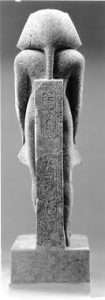
Fire and water. Which and why?
Both inaugurated a new form of rulership within the royal family when, in November 170 BC, they established a triumvirate of co-rulers: Ptolemy VI, Cleopatra II, and their youngest sibling 'Ptolemy the brother' as he was known at the time, although he was later called 'POTBELLY' because of his enormous size. The reasons for this 'triumvirate of siblings' to be placed on the throne remain unknown. It certainly had no pharaonic or Hellenistic precedent....Unfortunately, when Potbelly was prematurely elevated to the joint throne - a monster was born....The era of the triple co-rule ushered in the dawn of female supremacy - an age of 'girl power', which was to last until the sunset of the dynasty.''
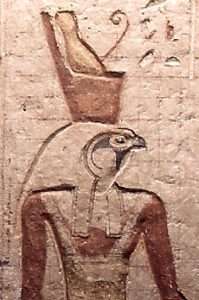
Haroeris.
'Mars Uncovered: Ancient God of War' / BBC4.
Mindset?
'Chickpea' ?
Recall the 'gap' or 'void' {of understanding} AS TO WHY there was a time lag between {as one example} the Bronze and Iron Age.
Horemheb.
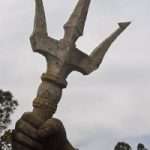
Metal of the mind.
''In ancient Rome a group of three men holding power, in particular ( the First Triumvirate ) the unofficial coalition of Julius Caesar, Pompey, and Crassus in 60 BC and ( the Second Triumvirate ) a coalition formed by Antony, Lepidus, and Octavian in 43 BC.''
And/or: ''Minerva protecting Peace from Mars or Peace and War is a painting by Peter Paul Rubens. He produced it in London between 1629 and 1630, during a diplomatic mission from the Spanish Netherlands to Charles I of England. It is now in the National Gallery, London.[1]
It shows Minerva (goddess of war, wisdom and crafts) fighting off Mars, with the nude figure of the goddess Pax (commonly known as "Peace" in English) in the centre.''
'Naked' / 'Garment' to enlarge.

Fake news or just the hair piece?
Side note: "We knew little about the Venus of the Aztecs and Mayans, and access to knowledge was restricted. We learned that the Peruvian name for Venus was Chasca, meaning 'curling hair'. The word suggests that the rays of the female star are visualized as locks of hair. Could our wings or flames be hair, reminders of the Greek imagery which gave us the word 'comet'? ['The Zelator']. Recall what ''hair'' and ''Venus'' represents within subject material.
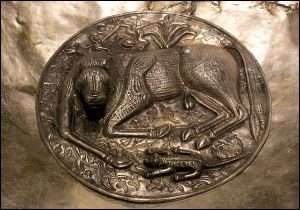
In the middle of the base plate. Asleep. Both male animal and human. 'Lower'?
And/or: "Why,’ I asked, ‘is the eclipse such a deep experience? What is this sense of sadness one feels? It is a far deeper experience than one would expect of the temporary shutting off of the light. I have not seen many eclipses, yet I know that it is an experience . . . rather, as they say, “as though someone were walking over my grave”. What is this experience?’ Mark had smiled at my outworn image, and, when I had finished the question, nodded: “This feeling of death is there because the symbolism of the eclipse reaches into the very fundament of the human soul. There is a sort of presage of death, but not in the way one might immediately imagine. You'll remember, from your readings of the hermetic literature, that there’s mention of ishon, the small man?” ‘I seem to have gone a long way from your question — yet this is not the case....
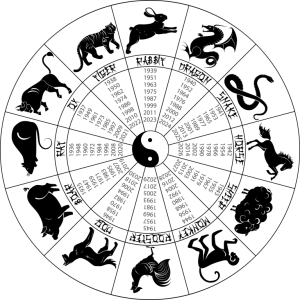
The Lunar Year of the Rat begins the Chinese zodiacal calendar.
Side note: "As I remember,’ said Christobel, ‘there was an eclipse {lunar?} at the Crucifixion. Well, darkness flowed over the face of the earth because the Sun had gone out — or at least something had happened. At any event, artists have always shown an interest in the symbolism behind the meeting of Sun and Moon — especially when painting the Crucifixion. In this panel, the Light returns in the higher body of Christ. The zodiac-Sun pours light into the crucified Christ, that, through Him, the Light may be made available to humanity. You can link this with the symbolism of Aries and Pisces, which we saw in the Salome panel. Here, light pours into the head of Christ, and the two men touch the feet of Christ with their own feet. Once again, it is an allegory of Aries and Pisces. In strictly Christian terms, it is a commentary on the first verses of the Gospel of St John."

Shepherd Kings?
And/or: Because Earth rotates on its axis from west to east, the Moon and the Sun (and all other celestial objects) appear to move from east to west across the sky. Viewed from above, however, the Moon orbits Earth in the same direction as our planet rotates. So, the Moon actually moves from west to east through our sky, albeit so slowly that we almost never notice it. During a total solar eclipse, however, we can see the Moon’s true motion as it crosses the Sun’s face from west to east. As this occurs, the Moon’s shadow follows it — moving in the same direction — and tracks a path across Earth’s surface.
NASA has created a helpful video, “Flying Around the Eclipse Shadow,” which illustrates this geometry if you’re still having trouble picturing it. You can watch it online at https://svs.gsfc.nasa.gov/4579....
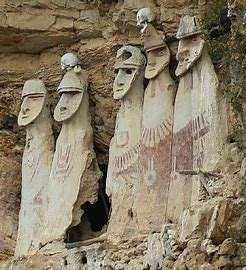
Above or below the clouds? And/or: Golgotha, (from Latin calva: “bald head” or “skull”), skull-shaped hill in ancient Jerusalem, the site of Jesus' Crucifixion. It is referred to in all four Gospels (Matthew 27:33, Mark 15:22, Luke 23:33, and John 19:17).
The saying "Red sky in the morning, sailor's warning" suggests that a red sunrise can indicate that a high pressure system has already passed, and a storm system may be moving in12. The idea is that weather patterns usually move from west to east, so if there are red skies in the morning, clouds may be drifting in from the west, potentially signalling an approaching storm3. However, it's important to note that this is not always accurate, as most tropical storms and hurricanes in the Atlantic move east to west....
“A red sky at night is a shepherd’s delight! A red sky in the morning is a shepherd’s warning.”
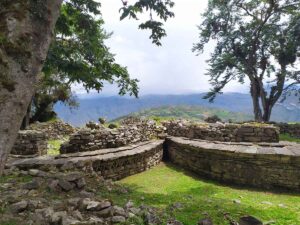
Rhombus shapes within the walls. Walls also contain the bones of the dead.
Side note: "The Chachapoyas, also called the "Warriors of the Clouds", was a culture of the Andes living in the cloud forests of the southern part of the Department of Amazonas of present-day Peru. The Inca Empire conquered their civilization shortly before the Spanish conquest in the 16th century. At the time of the arrival of the conquistadors, the Chachapoyas were one of the many nations ruled by the Incas, although their incorporation had been difficult due to their constant resistance to Inca troops....
 Predating the Inca by over six centuries, Chachapoya culture flourished from around AD 800 in Peru’s remote northern highlands, an area of crinkled mountains, deep canyons and lofty waterfalls where the eastern slopes of the Andes dissolve into the humid Amazon basin. Here a loosely unified society of cacicazgos (small kingdoms) gradually took root, farming terraced fields and acting as trading intermediaries between the Andes and the Amazon. The population, which may have numbered 500,000 at its peak, produced powerful shaman and engendered a tough fighting ethos. It evolved with little outside trauma until the invasion of the Inca in the 1470s.
Predating the Inca by over six centuries, Chachapoya culture flourished from around AD 800 in Peru’s remote northern highlands, an area of crinkled mountains, deep canyons and lofty waterfalls where the eastern slopes of the Andes dissolve into the humid Amazon basin. Here a loosely unified society of cacicazgos (small kingdoms) gradually took root, farming terraced fields and acting as trading intermediaries between the Andes and the Amazon. The population, which may have numbered 500,000 at its peak, produced powerful shaman and engendered a tough fighting ethos. It evolved with little outside trauma until the invasion of the Inca in the 1470s.
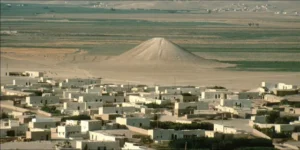
A more than 4,000-year-old artificial mound in Syria may be the world’s earliest known war memorial —known as the White Monument at Tell Banat—and concluded that the dead may have been members of an army. It is unclear when the 22metre-high mound was first constructed, but it underwent modifications over the centuries. It took its final form at some point between 2450 and 2300 BC, when steps were built into the mound’s sides, making it appear like a step pyramid. Human bones were placed into these steps, representing around 30 individuals—both adults and younger people, ranging in age from around 8 to 20. Egg-shaped slingers’ pellets {lozenge shaped?} used as weapons and the skins of donkey-like animals called kunga, often used to pull vehicles, were also buried in the mound. Their analysis showed that the kunga skins were buried with pairs of bodies, perhaps reflecting the remains of chariot teams; while elsewhere on the monument, in their own zone, people were buried alongside pellets, and so may have been foot soldiers. Taken together, it appeared that the individuals interred in the mound were buried as if they had died in battle. From the fragmentary condition of their bones, they had died some time before their burial in the White Monument, and had perhaps been brought from a cemetery or battlefield elsewhere.
Who the soldiers of Tell Banat may have been fighting is unknown, but there are two main possibilities: either they were caught up in a conflict between regional powers, or there was an internal conflict, Porter says.
With no written language, much of what is known about the Chachapoya is derived from archaeological remains found at funerary sites on hard to access limestone cliffs in Peru’s cloud forests. Characterised by sarcophagi with humanoid faces and cottage-like mausoleums that were built into the rockface and adorned with rust-red imagery, these stone tombs or chullpas, which still look down imposingly from isolated hillsides, suggest a vigorous independent culture that was markedly different from its Andean neighbours....The Chachapoya were famed for their weaving; their bright cloths with animalistic motifs were favoured garments of the Inca.
 Spanish colonial reports describing the Chachapoya as white-skinned and fair-haired were probably apocryphal, fuelling fantastical tales of their origins about mythical explorers from overseas....The greatest surviving manifestation of Chachapoya civilisation lies in the magnificent ruins of Kuélap, an urban, political and religious site that sits 3,000m above the Utcubamba river valley on a misty mountain ridge defended by 20m-high walls. Kuélap predates the citadel of Machu Picchu by at least 700 years and exhibits stone masonry skills as remarkable as those later displayed by the Inca. However, rather than construct the rectangular dwellings that were common to other South American civilisations, the Chachapoya built circular limestone structures that would have been covered with conical thatched roofs. Equally characteristic are the simple rhomboid friezes and sculpted serpents that decorate stone facades, symbols replicated in at least half a dozen other ruins in the area. Kuélap was abandoned in the late 1500s, possibly after a massacre and a fire.
Spanish colonial reports describing the Chachapoya as white-skinned and fair-haired were probably apocryphal, fuelling fantastical tales of their origins about mythical explorers from overseas....The greatest surviving manifestation of Chachapoya civilisation lies in the magnificent ruins of Kuélap, an urban, political and religious site that sits 3,000m above the Utcubamba river valley on a misty mountain ridge defended by 20m-high walls. Kuélap predates the citadel of Machu Picchu by at least 700 years and exhibits stone masonry skills as remarkable as those later displayed by the Inca. However, rather than construct the rectangular dwellings that were common to other South American civilisations, the Chachapoya built circular limestone structures that would have been covered with conical thatched roofs. Equally characteristic are the simple rhomboid friezes and sculpted serpents that decorate stone facades, symbols replicated in at least half a dozen other ruins in the area. Kuélap was abandoned in the late 1500s, possibly after a massacre and a fire.

Wire-cable car in Kuelap.
Kuélap is located on a limestone ridge on top of a mountain at an elevation of 3000 metres, on the left bank of the Utcubamba River.[1][4] It belongs to the district of Tingo, Luya Province, Amazonas.[1] The area is covered with cloud forests, with a variety of trees, orchids and epiphytes.[1] The protected zone covers an area of 218.33 ha (2.18 km2) and a buffer zone of 609.67 ha (6.10 km2), both protecting about 12 archaeological sites and the main site of Kuélap.[5]
The native Chachapoyas people occupied the site until the Inca Empire conquered the area around 1470 CE. Although the Inca tried to wipe out the Chachapoyas during their invasion, they were unsuccessful. A genetic study published in 2017 found that the indigenous people living in the region today have the same Chachapoyas DNA of their ancestors....
Weather in Kuelap is split between two seasons: rainy and dry. Weather wise, the best time to go to Kuelap is during the dry season, from May to September. You can expect mostly sunny days and limited rain. Temperatures are cooler, but the high altitude sun is still strong.
However, the rainy season, from October to April, can be a pleasant experience all the same. Temperatures are typically warmer, but chances of precipitation are higher. A light mist adds an extra layer of mystery and magic to the Kuelap Fortress, making for some unique photos. In addition, the rain means the nearby Gocta Falls are at their fullest, even more powerful and breathtaking....Kuelap, sometimes known as the “Machu Picchu of the North,”
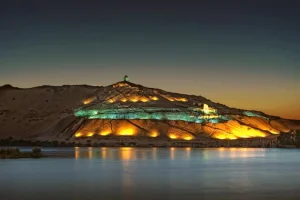
The tomb of Hirjuf is located at Qubbet el-Hawa, also known as the Valley of the Princes, a rocky location across Aswan. There are tombs from the Middle and New Empires as well as the Old Empire, which offer valuable insights into the lives of prominent officials.
The Dome of the Wind is a rocky mountain with a height of about 130 m. It is located on the west bank of the Nile near Aswan. The reason for the popularity of this mountain is that it contains tombs of priests, nobles, and governors of Aswan throughout the different ages, such as: The era of the Old Kingdom (Sixth Dynasty).
The Middle Kingdom (for the Twelfth Dynasty).
They also recently discovered tombs belonging to the modern state and the late era. The reason for naming the air dome by this name There is a tomb on the southern summit of the mountain belonging to one of the righteous saints and he is called “Sidi Ali Abu Al-Hawa”. It is a different and distinctive tomb, as its dome is painted white, and it is prominent so that you can see it from afar. The tomb is also distinguished by the fact that it was built on the ruins of a Coptic monastery (St. George). Tomb of Sidi Ali Abu Al-Hawa.
Continued: "According to a medieval legend, the remains of the apostle James, son of Zebedee were brought to Galicia for burial, where they were lost. Eight hundred years later the light of a bright star guided a shepherd, Pelagius the Hermit, who was watching his flock at night to the burial site in Santiago de Compostela.[5]  This site was originally called Mount Libredon and its physical topography leads prevalent sea borne winds to clear the cloud deck immediately overhead.[6] The shepherd quickly reported his discovery to the bishop of Iria, Theodemir.[5] The bishop declared that the remains were those of the apostle James and immediately notified King Alfonso II in Oviedo.[5] To honour St. James, the cathedral was built on the spot where his remains were said to have been found. The legend, which included numerous miraculous events, enabled the Catholic faithful to bolster support for their stronghold in northern Spain during the Christian crusades against the Moors, but also led to the growth and development of the city."
This site was originally called Mount Libredon and its physical topography leads prevalent sea borne winds to clear the cloud deck immediately overhead.[6] The shepherd quickly reported his discovery to the bishop of Iria, Theodemir.[5] The bishop declared that the remains were those of the apostle James and immediately notified King Alfonso II in Oviedo.[5] To honour St. James, the cathedral was built on the spot where his remains were said to have been found. The legend, which included numerous miraculous events, enabled the Catholic faithful to bolster support for their stronghold in northern Spain during the Christian crusades against the Moors, but also led to the growth and development of the city."
Continued: "The Gospel of Matthew, Chapter twentyseven, mentions that an earthquake coincided with the crucifixion: “And when Jesus had cried out again in a loud voice, he gave up his spirit. At that moment the curtain of the temple was torn in two from top to bottom. The earth shook, the rocks split and the tombs broke open.”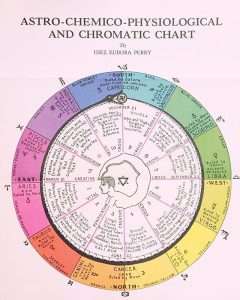 "Gabriel the archangel of the Moon. The Moon is above the left hand of Christ, while the Sun is above His right hand. The boat-like Moon is a symbol of the Waters, while the Sun is a symbol of Fire. These are the two opposite forces in the cosmos: in the mediaeval view of things, Fire rises, while Water descends. Yet the Christian mystery depends on the “miracle” by which Fire descends. See how a part of the Sun’s light — in the form of a wing — breaks away, and pours into the crown of Christ. This shows that Christ, although crucified and dead, is still alive. He is alive in the Quintessence."
"Gabriel the archangel of the Moon. The Moon is above the left hand of Christ, while the Sun is above His right hand. The boat-like Moon is a symbol of the Waters, while the Sun is a symbol of Fire. These are the two opposite forces in the cosmos: in the mediaeval view of things, Fire rises, while Water descends. Yet the Christian mystery depends on the “miracle” by which Fire descends. See how a part of the Sun’s light — in the form of a wing — breaks away, and pours into the crown of Christ. This shows that Christ, although crucified and dead, is still alive. He is alive in the Quintessence."
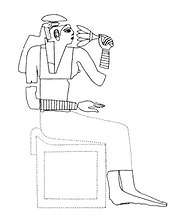
Wife / Mother / Grandmother of the Old Kingdom pharaohs.
A working example: "THE providential event which manifested itself among the Celts revealed to their meditations two great truths—the immortality of the soul, and the existence of God. The first of these truths took hold of them more than the second. They understood well enough how the invisible part of themselves which felt, became animated, thought, and finally willed, could survive the destruction of the body, since it could even watch while the body slept, and could offer in its dreams pictures more or less filled with sensations, passions, thoughts, and pleasures whose actual effect no longer existed; but they could with difficulty comprehend the idea of a universal Being, Creator, and Preserver of all beings. Their feeble intelligence had still need of something perceptible upon which it might support itself. The power of abstraction and of generalization was not strong enough to sustain them at this metaphysical height. It is not that they did not admit the name of Sublime Father that Voluspa had given to this unknown Being for whom she had commanded respect; but this very name of Father, instead of raising them to Him, persuaded them rather to make Him descend to them, in presenting this Being to them only as the first Father of the Borean Race and the most ancient of their ancestors." {Page 89 'Hermeneutic Interpretation of the Origins of the Social State of Man'}.
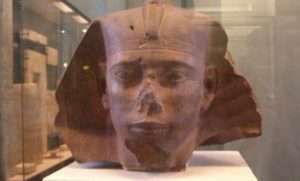
He is the king who introduced the royal title Sa-Rê (meaning “Son of Ra”) and the first to connect his cartouche name with the sun god Ra.
Side note: In what was to be an eventful night in the Garden of Gethsemane, a prayerful Jesus, in great agony, was speaking to His disciples when He was confronted by a multitude with swords and torches. They had come from the chief priest to arrest Him. Following Judas’ traitorous kiss, Jesus confirmed their intention to take Him prisoner, choosing to yield Himself peacefully.

Divided into 32. Ear shape?
However, Peter was not willing to let his Master be hauled off without a fight. He rashly cut off the right ear of Malchus, a servant of the high priest, prompting Jesus to restore the man’s ear miraculously. This merciful act would be His last miracle before being crucified (Matthew 26:47-56; Mark 14:43-50; Luke 22:47-53; John 18:1-12).
Healing the ear of a servant {'slave'?} is the final of the miracles of Jesus in the Gospels.[1] Even though the incident of the servant's ear being cut off is recorded in all four gospels, Matthew 26:51; Mark 14:47; Luke 22:51; and John 18:10–11; the servant and the disciple are named as Malchus and Simon Peter only in John. Only Luke records that Jesus healed the servant.
The Gospel of Luke (22:49-51) describes Jesus healing the servant of a high priest during the Arrest of Jesus after one of the followers of Jesus had cut his right ear off:
Grip of advantage.
When Jesus' followers saw what was going to happen, they said, "Lord, should we strike with our swords?" And one of them struck the servant of the high priest, cutting off his right ear. But Jesus answered, "No more of this!" And he touched the man's ear and healed him.[2]
This healing episode follows the kiss of Judas and is the last miracle reported in the Canonical Gospels prior to the Crucifixion of Jesus.

Keep fighting, crying, lying, or ranting? Which is Fake news?
No wonder, then, that the Lord admonished Peter: “Put up thy sword into the sheath” (John 18:11). Scripture elsewhere codifies the lesson as follows: “Be not overcome by evil, but overcome evil with good” (Rom. 12:21). This is not the time for fighting. “The weapons of our warfare are not carnal, but mighty through God” (2 Cor. 10:4). More importantly, you can’t share the work with the Mediator.
"Broken sword" to enlarge.
And/or: "David said to him, “Let me have the site of your threshing floor so I can build an altar to the Lord, that the plague on the people may be stopped. Sell it to me at the full price.23 Araunah said to David, “Take it! Let my lord the king do whatever pleases him. Look, I will give the oxen for the burnt offerings, the threshing sledges for the wood, and the wheat for the grain offering. I will give all this. 24 But King David replied to Araunah, “No, I insist on paying the full price. I will not take for the Lord what is yours, or sacrifice a burnt offering that costs me nothing.”

Six runs.
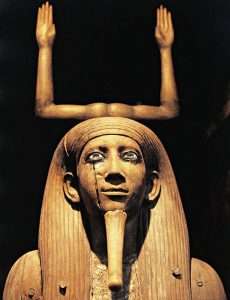 So David paid Araunah SIX hundred shekels[a] of gold for the site. 26 David built an altar to the Lord there and sacrificed burnt offerings and fellowship offerings. He called on the Lord, and the Lord answered him with fire from heaven on the altar of burnt offering.
So David paid Araunah SIX hundred shekels[a] of gold for the site. 26 David built an altar to the Lord there and sacrificed burnt offerings and fellowship offerings. He called on the Lord, and the Lord answered him with fire from heaven on the altar of burnt offering.
27 Then the Lord spoke to the angel, and he put his sword back into its sheath. 28 At that time, when David saw that the Lord had answered him on the threshing floor of Araunah the Jebusite, he offered sacrifices there. 29 The tabernacle of the Lord, which Moses had made in the wilderness, and the altar of burnt offering were at that time on the high place at Gibeon. 30 But David could not go before it to inquire of God, because he was afraid of the sword of the angel of the Lord." [1 Chronicles 21:18-30].
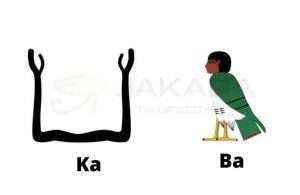 And/or: The word of the Lord came to me: 2 “Son of man, set your face against Jerusalem and preach against the sanctuary. Prophesy against the land of Israel 3 and say to her: ‘This is what the Lord says: I am against you. I will draw my sword from its sheath and cut off from you both the righteous and the wicked. 4 Because I am going to cut off the righteous and the wicked, my sword will be unsheathed against everyone from south to north. 5 Then all people will know that I the Lord have drawn my sword from its sheath; it will not return again.’
And/or: The word of the Lord came to me: 2 “Son of man, set your face against Jerusalem and preach against the sanctuary. Prophesy against the land of Israel 3 and say to her: ‘This is what the Lord says: I am against you. I will draw my sword from its sheath and cut off from you both the righteous and the wicked. 4 Because I am going to cut off the righteous and the wicked, my sword will be unsheathed against everyone from south to north. 5 Then all people will know that I the Lord have drawn my sword from its sheath; it will not return again.’
6 “Therefore groan, son of man! Groan before them with broken heart and bitter grief. 7 And when they ask you, ‘Why are you groaning?’ you shall say, ‘Because of the news that is coming. Every heart will melt with fear and every hand go limp; every spirit will become faint and every leg will be wet with urine.’ It is coming! It will surely take place, declares the Sovereign Lord.” [Ezekiel 21:2-8].
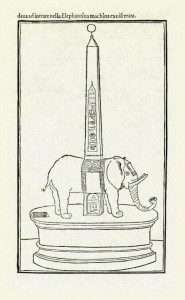
Moving 'mountains'?
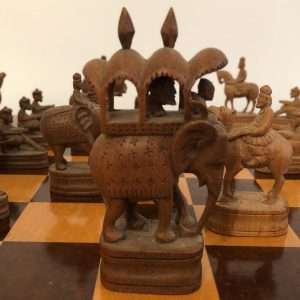
Antique Indian elephant chess piece representing the king.
Side note: The objects referred to as cylinder-sheaths, found in a number of the Nuri tombs, are of unknown purpose, and have not been recorded elsewhere. They consist of two parts: (a) a cylindrical tube, closed at the base by a circular disc, and (b) a shorter cylindrical tube open at both ends, fitted with an internal sleeve which projects beyond its lower end and slides inside (a). The decoration of (a) usually features a winged female figure as its main motif, with decorative borders above and below. The decoration of (b) consists of friezes of uraei, ram’s heads, or sometimes hieroglyphs, cartouches, flowers and the like. The upper end of (b) is open.....
Most of the tombs contained one or two cylinders, but there were fifteen in the pyramid of King Aspelta (c.600-580 BC). The decorative themes of Aspelta’s cylinders varied, but tended to feature goddesses such as Hathor, Mut, Isis, Tefnut, Anukis, and Satis. The cylinders were found grouped together on the floor of the burial chamber, and many had been smashed by fallen ceiling blocks, although this helped conceal the objects from looters. The cylinders given to Boston as a share of the finds were later conserved, although the ‘woody bits’ that were found inside during cleaning were not preserved or analysed. ['Ancient Egypt' / July-August 2024].

Any quiver?
Satet, Satit or Satjet, Satjit in Ancient Egyptian (Ancient Egyptian: Sṯt or Sṯı͗t,[8] lit. "Pourer" or "Shooter"), Greek: Satis, also known by numerous related names, was an Upper Egyptian goddess who, along with Khnum and Anuket, formed part of the Elephantine Triad. A protective deity of Egypt's southern border with Nubia, she came to personify the former annual flooding of the Nile and to serve as a war, hunting, and fertility goddess. She was sometimes conflated with Isis and Sopdet, goddess of the bright star Sirius,[9] which the Egyptians connected with the onset of the Nile flooding. Under the interpretatio graeca, she was conflated with Hera[9] and Juno.
The exact pronunciation of Egyptian is often uncertain since vowels were not recorded until a very late period. In transcription, the goddess's name also appears as Setis, Sati, Setet, Satet, Satit, and Sathit.[1] Derived from sṯ, meaning "eject", "shoot", "pour", or "throw", her name can be variously translated as "She who Shoots" or "She who Pours" depending on which of her roles is being emphasized.[1]
Her name was originally written with the hieroglyph for a linen garment's shoulder knot (S29); this was later replaced by Anuket's animal hide pierced by an arrow (F29).[9] She was also known by epithets, such as "Mistress of Elephantine"[9] and "She Who Runs Like an Arrow", thought to refer to the flowing river current.

"Bouquets of sorghum held in cylinders, from the temple of the lion-god Apedemak at Naqa in Sudan." Fingers to enlarge.
 And/or: "The sixth principle implies form. Properly, it is the vehicular side of consciousness. Its nature is substantive. One characteristic of occult philosophy is the theorem that every state of consciousness has its own particular type of matter. We have the idea in all magical philosophy of a so-called mental body or sheath, of a mind clothed with a fluidic body of thought, grounded in a substance of extreme tenuity and subtlety. Referred to the planet Mercury (not to the alchemical principle also of that name) which implies intelligence and consciousness of a kind, its elemental attribution is Water. This latter brings out the correspondence of a fluidic plastic substance forming the etheric or astral body of the mind. The appropriate alchemical principle is Salt, the last of the triad, conceived of as an inert, heavy mineral body. Just as the alchemical Mercury refers to Consciousness, and Sulphur to emotion and feeling, so this principle of Salt refers more particularly to the sheath or vehicle in which these faculties are grounded.....
And/or: "The sixth principle implies form. Properly, it is the vehicular side of consciousness. Its nature is substantive. One characteristic of occult philosophy is the theorem that every state of consciousness has its own particular type of matter. We have the idea in all magical philosophy of a so-called mental body or sheath, of a mind clothed with a fluidic body of thought, grounded in a substance of extreme tenuity and subtlety. Referred to the planet Mercury (not to the alchemical principle also of that name) which implies intelligence and consciousness of a kind, its elemental attribution is Water. This latter brings out the correspondence of a fluidic plastic substance forming the etheric or astral body of the mind. The appropriate alchemical principle is Salt, the last of the triad, conceived of as an inert, heavy mineral body. Just as the alchemical Mercury refers to Consciousness, and Sulphur to emotion and feeling, so this principle of Salt refers more particularly to the sheath or vehicle in which these faculties are grounded.....
Side note: "A finger-sized clay cylinder from a tomb in northern Syria appears to be the oldest example of writing using an alphabet rather than hieroglyphs or cuneiform. Researchers may have deciphered the oldest known scrap of alphabetic writing yet discovered, and it may be a nearly 4,500-year-old gift tag.

'Comb' to enlarge.
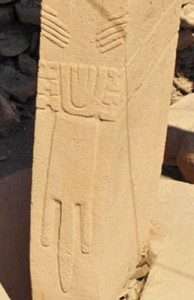 A clay cylinder found in a tomb holding six skeletons in northern Syria bears the word “silanu,” which may be a name, says Glenn Schwartz, an archaeologist at Johns Hopkins University. Schwartz discovered the finger-sized cylinder, along with three others bearing similar etchings, in a tomb at Tell Umm el-Marra, an ancient city that sits between modern-day Aleppo and the Euphrates River."
A clay cylinder found in a tomb holding six skeletons in northern Syria bears the word “silanu,” which may be a name, says Glenn Schwartz, an archaeologist at Johns Hopkins University. Schwartz discovered the finger-sized cylinder, along with three others bearing similar etchings, in a tomb at Tell Umm el-Marra, an ancient city that sits between modern-day Aleppo and the Euphrates River."
Other facts {clews} include: Rulers of Tuba/Dub {ancient Umm el- Marra} the capital being Aleppo in N/W Syria are referred to as king and little king ....The Little King {'Ishon'?} of which swears his oath of alliance with Ebla, in the temple of Hadda of Aleppo, NOT in the temple of Kura, the god of Ebla. The Sacred Lance {or Sacred Stone} of Ishtar of Tuba is a reference to the Queen....It was the center of a small kingdom - under the sovereignty of king Yamhad whose capital was Aleppo. It was near the border between Western dry farming zone and the Eastern pastoralist zone....The crossroads - on or near the 'middle' east-west road connecting the Euphrates valley with Aleppo and points west...
It was adjacent to the Nahr Deir Hafer, a stream flowing from the northern hills into the Jabbul lake...Extensive vineyards of which, allowed it to be an exporter of wine.
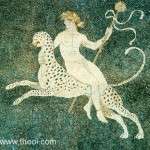
'Spotted Panther'.
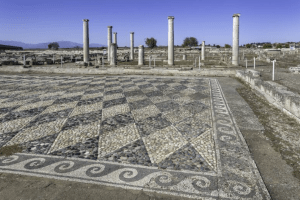 Continued: The Vine yields wine for man’s pleasure. But it does so only through the application of an intelligence and a skill external to itself. Itself unaided, it remains but a vine. So by the alchemical artifice of putrefaction and distillation, the crude material of the astro-mental sheath is purified, becoming, so to speak, the wine or spirit thereof. Noteworthy also, is the fact that the Vine and wine generally are sacred in mythology to Bacchus. On the Qabalistic Tree of Life he is referred to Tipharas, the solar centre, the source of reference of all the dying Gods who teach immortality, resurrection, and healing. The glorified and purified consciousness which is the Philosopher’s Stone is likewise a Tipharas attribution - and often is termed the Augoeides, the deathless solar body, the wedding garment of scripture. Thus the Stone is immortality, it is consciousness resurrected from death, gifted with divine healing." ['The Philosophers Stone' / Israel Regardie].
Continued: The Vine yields wine for man’s pleasure. But it does so only through the application of an intelligence and a skill external to itself. Itself unaided, it remains but a vine. So by the alchemical artifice of putrefaction and distillation, the crude material of the astro-mental sheath is purified, becoming, so to speak, the wine or spirit thereof. Noteworthy also, is the fact that the Vine and wine generally are sacred in mythology to Bacchus. On the Qabalistic Tree of Life he is referred to Tipharas, the solar centre, the source of reference of all the dying Gods who teach immortality, resurrection, and healing. The glorified and purified consciousness which is the Philosopher’s Stone is likewise a Tipharas attribution - and often is termed the Augoeides, the deathless solar body, the wedding garment of scripture. Thus the Stone is immortality, it is consciousness resurrected from death, gifted with divine healing." ['The Philosophers Stone' / Israel Regardie].
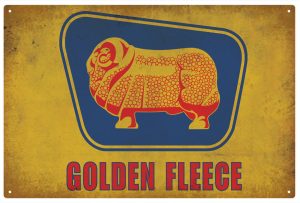
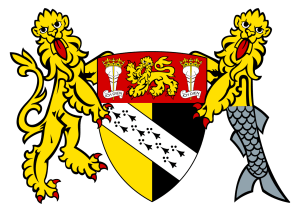
Norfolk: Spear points?
A Working example: An Anglo-Saxon burial ground with 138 graves found along the route of HS2 is one of the largest ever uncovered in the UK, experts have said. A skeleton with a weapon embedded in it, jewellery and weapons were among the finds in Wendover, Buckinghamshire. Evidence of Neolithic, Bronze Age, Iron Age and Roman activity was also found. Archaeologist Rachel Wood said the site's significance for the "historical and archaeological understanding" of Anglo-Saxon Britain was "huge".
The site contained 141 regular burials and five cremation burials. The male skeleton was found with a sharp iron object embedded into its spine, which experts believe may have caused or factored into his death. Other items unearthed in the excavation last year include 89 brooches, more than 2,000 amber beads, 51 knives, 40 buckles and 15 spearheads. A number of objects likely to have been used for grooming were also found, including toiletry sets with ear wax removers and toothpicks, tweezers, combs and even a cosmetic tube that might have been used as eyeliner or similar.

He is the king who introduced the royal title Sa-Rê (meaning “Son of Ra”) and the first to connect his cartouche name with the sun god Ra.
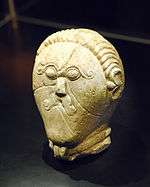
Celtic 'hero'. Twitching nose? 'Bristles'?
And/or: Fortysix is an auspicious number. In esoteric Freemasonry, a 33rd-degree master has the opportunity to advance further by taking 13 extra grades, or degrees. Therefore, a 46th-degree initiate is supposedly a master of space and time, a bodhisattva-like enlightened adept. In the King James Version of the Bible there is the curious incident of Psalm 46. When one counts 46 words down from the first word in Psalm 46, one comes to the word shake. If one counts 46 words from the bottom of Psalm 46, one comes to the word speare. This would indicate that the author, or authors, of the works of William Shakespeare, called by Victor Hugo “a cathedral of words,” are 46th-degree initiates. A hint of this can also be gleaned from the fact that 3 x 46 = 138, the number of the phrase Ben Elohim, or “Son of the Gods.” It is interesting to note that Francis Bacon was chosen by King James to head the translation team for the Bible. Other interesting ramifications of the number 46 include the number of the name of Adam, the first man. It is also said that it took 46 years to build King Solomon’s Temple. Each human being has 46 chromosomes. As we said above, 46 equals the name of God, Elhi, an ancient name for the El in the Sky, the High God of Draco. It is also the number of the Levite priests who ministered to that God. If we think of what the Lallemant credence has to tell us about the process of transformation, then 46 represents a level of personal attainment. By adding the extra three images of the Hendaye chapter, the personal connection of Elhi, 46, becomes the transpersonal connection of the Living God, El Chai, 49, depicted on the tympanum of Saint Trophime in Arles. ['The Mysteries of the Great Cross of Hendaye'].
'23'x 6?
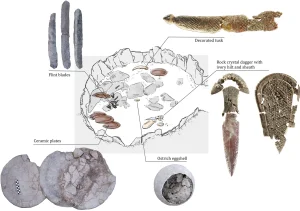
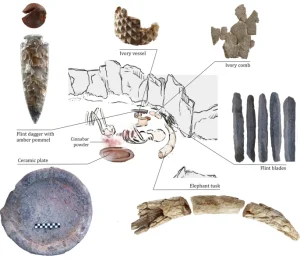 Side note: When archaeologists in 2008 discovered ivory tusks, amber, ostrich eggshells, and a rock crystal dagger in a 5000-year-old grave in the town of Valencina in southwest Spain, they assumed it belonged to an elite leader. They dubbed the individual within—likely the person with the highest social status in all of Iberia during the time—the Ivory Man.
Side note: When archaeologists in 2008 discovered ivory tusks, amber, ostrich eggshells, and a rock crystal dagger in a 5000-year-old grave in the town of Valencina in southwest Spain, they assumed it belonged to an elite leader. They dubbed the individual within—likely the person with the highest social status in all of Iberia during the time—the Ivory Man.
But that title would more accurately be the Ivory Lady, researchers assert today in Scientific Reports. A state-of-the-art analysis of the remains’ proteins indicates this esteemed person was a woman. Researchers say no men occupied a comparable status in this society.
Valencina, near modern-day Seville, sprawled over 450 hectares during its peak in the Copper Age, between 3200 B.C.E. and 2200 B.C.E. At the time, Risch says, it would have been a bit like “the New York City of Europe.” Emerging wealth from both productive hunting and agriculture funded an era of creativity, he says, and created a hub for trading, exchanging information, and feasting.
Most Iberians of the time were buried in group graves. However, the opulent grave discovered in 2008 contained only a single occupant.
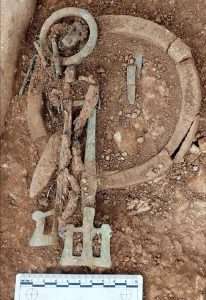
Ivory bag rings have been found in more than 70 cemeteries across southern, central, and eastern England dating to between the late-5th and 7th centuries AD. These rings are most frequently found in richly furnished female graves, and would have served as the framework for bags that hung at the waist.... Recent excavations at an early Anglo-Saxon cemetery in Scremby, Lincolnshire revealed a number of elaborate female burials containing such bag rings....Through a multi-methodological approach, we have established that the ivory used for the Scremby bag rings came from elephants living in an area of young volcanic rocks in Africa at some point during the 5th and 6th centuries AD.....Since most rings have been recovered near the hip, it is thought that the bags were suspended from the waist alongside other objects such as iron knives, pairs of copper alloy girdle hangers, and iron ‘latch lifters’ (Vogt, 1960, MacGregor, 1985: 111) (Fig. 3)....
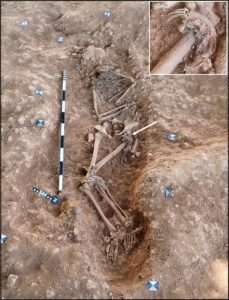
Burial of an adult female (SK17) from the early Anglo-Saxon cemetery at Scremby, Lincolnshire. Girdle hangers and a bag with an ivory ring are positioned at her left hip (white arrow / inset), whilst a pair of annular brooches were worn at the shoulders, strings of beads were hung around her neck, and a stone spindle whorl was placed near her right foot.
Compared with other burials in the Iberian region during the Copper Age, “the Ivory Lady totally stands out, head and shoulders above the rest, either male or female,” García Sanjuán says.
Her skeletal development suggests she was only seventeen to twentyfive years old when she died. The researchers hypothesize that she didn’t inherit her wealth and status because infant burials of this time lack grave goods, suggesting that prestige was not inherited. They propose the Ivory Lady had charisma or other unique skills that set her above other members of her society. And she wasn’t afraid to get her hands dirty: Her bones bear the signs of hard physical labor.
“This is a leader who leads through example,” García Sanjuán says. “She did not have a life of comfort or luxury.”
One remarkable piece of ivory found in her tomb is a full tusk from an African elephant, which must have come from that continent. Isotopes in her bones suggest she mostly lived locally, but if she had traveled to other regions, she might have had an edge in society, researchers say, “Mobility is something that’s very closely linked to power,” says Samantha Scott Reiter of the National Museum of Denmark, who wasn't involved in the study.
Elephant Island.

''A land is only as good as its leaders." {'The Kid Who Would be King." / 2019}.
African vs. Asian Elephants: African elephants have larger ears than their Asian counterparts. An African elephant’s ears can grow up to six feet long and four feet wide! Why the difference? African elephants live in sub-Saharan Africa, where they’re exposed to extreme temperatures and intense sun. In contrast, Asian elephants inhabit shady rainforests in Asia, so they don’t face the same heat challenges. As a result, Asian elephants have smaller ears.
'Dappled'.
Oak island.
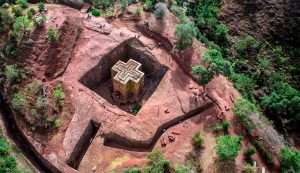
The Church of Saint George was carved downwards from a type of volcanic tuff. This is the sole architectural material that was used in the structure. It has been dated to the late 12th or early 13th century AD, and thought to have been constructed during the reign of King Gebre Mesqel Lalibela, of the late Zagwe dynasty. Question. 'FLAT' TOP?
Conflicting historical accounts by contemporary writers have also confounded the issue of which species of elephant was hunted for its ivory in the 5th-7th centuries AD. For example, writing in the 7th century, Isidore of Seville suggested a reliance on Asian elephants following the exhaustion of African herds during the preceding Roman period. Hills (2001: 135-6), however, makes a convincing argument that ivory entering Northern Europe at this time originated in East Africa, in particular via the Christian Kingdom of Aksum located in modern-day Eritrea and northern Ethiopia. Excavations at the site of Aksum have revealed considerable evidence for ivory working, and it is said the kingdom was a major manufacturer and distributor of ivory between the 3rd and 7th centuries AD (Phillipson, 2000a).
Chemical traces of wine, cannabis, and cinnabar—a bright, scarlet-colored form of mercury that can be used as a pigment or inhaled and ingested—were also found near her body. To the authors, these substances suggest she was involved in religious rituals.
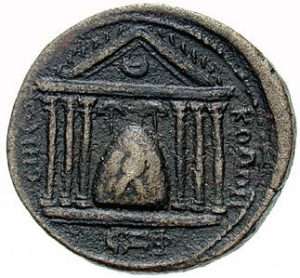
Pella (Greek: Πέλλα) is an ancient city located in Central Macedonia, Greece. It served as the capital of the ancient Greek kingdom of Macedon...The name is probably derived from the word pella, (Ancient Greek: πέλλα), "stone" which seems to appear in some other toponyms in Greece like Pellene....With the prefix "α" it forms the word ἀπέλλα, apella, "fence, enclosure of stones".[1][2] Robert Beekes relates the word πέλλα with the name of the city, but suggests that it probably has pre-Greek origin.
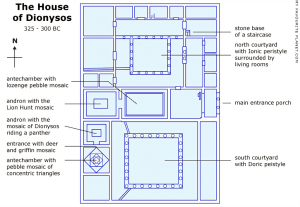 Side note: "You can trace the origins of wine all the way back through history… rumour has it that the god Dionysus – the son of Zeus and Semele – was the first to discover the fermented juice of the wild vine. The taste of the juice was so great that he quickly shared this newly discovered delight with the nymphs and mountain shepherds. When the shepherd tasted the wines for themselves, they soon forgot their sorrows and their souls filled with euphoria. But Dionysus did not rest on it; he decided to transform into a woman and went to find farmers and villagers and transferred to them his agricultural knowledge and wine production."
Side note: "You can trace the origins of wine all the way back through history… rumour has it that the god Dionysus – the son of Zeus and Semele – was the first to discover the fermented juice of the wild vine. The taste of the juice was so great that he quickly shared this newly discovered delight with the nymphs and mountain shepherds. When the shepherd tasted the wines for themselves, they soon forgot their sorrows and their souls filled with euphoria. But Dionysus did not rest on it; he decided to transform into a woman and went to find farmers and villagers and transferred to them his agricultural knowledge and wine production."

“Most certainly, I tell you, one who doesn’t enter by the door into the sheep fold, but climbs up some other way, is a thief and a robber."
And/or: "These tripods were typically crafted from bronze or clay. They consisted of three legs attached to a circular base, which supported a bowl or plate on top. The bowl or plate often featured intricate designs or patterns carved into it. Use of Tripods in Art and Sculpture: Tripods were not limited to religious rituals alone; they also played a significant role in art and sculpture during ancient times. Greek artists incorporated tripods into their works as decorative elements or as stands for displaying other objects. Greek vase painters often depicted mythological scenes with figures standing next to tripods. In architectural sculptures, tripods were carved as freestanding structures or as part of larger compositions. Sculptors used tripods as bases for statues or as supports for offering tables in temples."

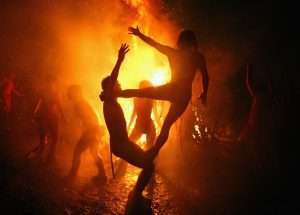
A sacrificial tripod, whose name comes from the Greek meaning "three-footed", is a three-legged piece of religious furniture used in offerings and other ritual procedures. This ritual role derives from its use as a simple support for a cooking vessel placed over a fire. As a seat or stand, the tripod is the most stable furniture construction for uneven ground, hence its use is universal and ancient.
Tripods had two types and several functions. Firstly, some oracles sat on large tripods to pronounce. Far more common were the tripods and bowls in which smaller sacrifices were burnt. These are particularly associated with Apollo and the Delphic oracle in ancient Greece. These were also given to temples as votive offerings, awarded as prizes in contests associated with religious festivals, and just given as gifts between individuals.
Continued: A nearby set of Copper Age burials, previously published, backs up the idea that women in the region held power. Located 100 meters south of the Ivory Lady’s tomb, a domed structure contains the only graves with a level of opulence close to that of the Ivory Lady, dated to two or three generations after she lived. Of the 20 people buried in the largest chamber, 15 have been confirmed to be women between the ages of 20 and 35. Some women were dressed in elaborate garments made from beads carved from marine shells, including a full-body tunic. All these women had very high levels of mercury in their bones, likely due to their exposure to cinnabar. The team speculates they may have been priestesses, with the Ivory Lady a founding religious ancestor. Taken together, the Ivory Lady and these women challenge longstanding views of prehistoric women as mere extensions of their powerful male partners, Reiter says.
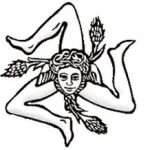
Isle of Man also has same.
Side note: The term ‘latchlifter’ is often applied to simple hooks with a handle which could be used to open a bolt. Manning (1985, 88-89, pls. 37-40) lists several iron examples from late Iron Age and Roman sites; they also occur in the early-medieval world, up to the 9th century (Ottaway in Evans and Loveluck 2009, 190). They do not appear to have been made from copper alloy. We have very few recorded on the PAS database; if you do record one, use the object type LATCHLIFTER. A date-range of 100 BC to 800 AD is probably appropriate.
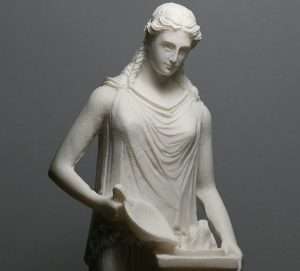
Hestia.
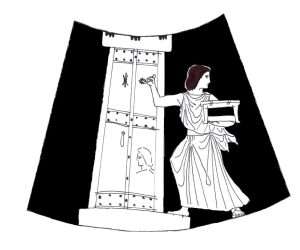 A working example: "Girdle hangers are an early Anglo Saxon dress accessory of the 5th and 6th centuries. As decorated copper-alloy copies of functional keys, occurring exclusively in a number of wealthier female graves in the Anglian regions, girdle hangers have attracted special attention among scholars. It is commonly assumed that they played a significant role as material symbols of female social, cultural and gender identity, the most prominent being their interpretation as insignia of a woman´s household authority. This rests on a number of written sources from other periods which give clues on the symbolic significance of keys in women´s lives. Up to the present day, this interpretation has not been the subject of an archaeological analysis, albeit the large number of contextual finds that have been excavated throughout England up to the present day. The purpose of the present PhD study is to provide such analysis. A systematic material and context analysis of girdle hangers based on the early Anglo-Saxon cemetery evidence is needed in order to explore the extent to which the material record itself can provide us with relevant data. Important observations on the finds material itself have been decisively brought forward by the growing number of metal-detected finds recorded through the PAS in recent years. Therefore the data collection will have to include this rich data.
A working example: "Girdle hangers are an early Anglo Saxon dress accessory of the 5th and 6th centuries. As decorated copper-alloy copies of functional keys, occurring exclusively in a number of wealthier female graves in the Anglian regions, girdle hangers have attracted special attention among scholars. It is commonly assumed that they played a significant role as material symbols of female social, cultural and gender identity, the most prominent being their interpretation as insignia of a woman´s household authority. This rests on a number of written sources from other periods which give clues on the symbolic significance of keys in women´s lives. Up to the present day, this interpretation has not been the subject of an archaeological analysis, albeit the large number of contextual finds that have been excavated throughout England up to the present day. The purpose of the present PhD study is to provide such analysis. A systematic material and context analysis of girdle hangers based on the early Anglo-Saxon cemetery evidence is needed in order to explore the extent to which the material record itself can provide us with relevant data. Important observations on the finds material itself have been decisively brought forward by the growing number of metal-detected finds recorded through the PAS in recent years. Therefore the data collection will have to include this rich data.
And/or: The ceremonial shield of the Tombs of Vergina is a decorative shield found in the Royal Tombs at Aigai / Aegae (now known as Vergina) in Northeast Greece.[1] The shield was found alongside other lavish grave goods and the remains of family members of Alexander the Great, including Philip II of Macedon. The ceremonial shield dates to the late fourth century B.C.E. and was discovered in 1976....
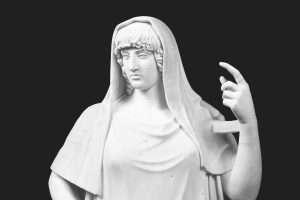
Guardian of the hearth. N/W?
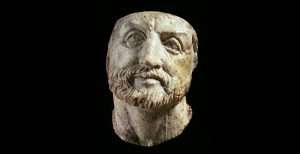
Ivory head of Phillip. Found in tomb. Little or big head? Sculpted? 'Joy'?
The ceremonial shield is in the basic form of an aspis but with more ornate decoration and is made of wood, leather, glass, gold, and ivory.[1][4] The front of the shield includes a geometric pattern of ivory surrounding the border, while a gold wreath encompasses two deteriorated ivory figures in the center.[4] Because of the erosion of the figures, their identities are not clear, but a male figures appears to tower over a smaller, female figure.[4] The reverse side of the shield includes an ornate golden handle in a "T" shape with floral designs at the ends. Near the middle of the handle grip, two small lions are carved into the gold.[4] Scholars such as N. G. L. Hammond believe that the figures are likely a symbol of power or royalty and that the shield's rich design fits with the other grave goods found in the royal tomb, which were made of gold, silver, and ivory.
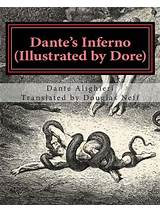
External / Internal.
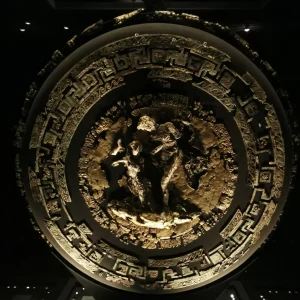
In 354 BCE, during the siege of Methone, Philip suffered his most severe wound: the loss of his right eye. The Oracle at Delphi had foretold this event, linking it to Philip’s sacrilegious act of spying on his wife, Olympia, during an intimate encounter with a snake. The Oracle revealed that the creature was Zeus-Ammon, the true father of Olympia’s child. Philip’s eye, which had witnessed this divine union, was destined to be lost1
From a different perspective: For our image, we've chosen the ceremonial shield found in the main burial chamber. It is chryselephantine, meaning made of gold and ivory. Those materials were considered the most valuable in the Greek World, and their combination was usually reserved to the statues of gods in major temples, like the one of Zeus at Olympia, one of the Seven Wonders of the Ancient World. The Vergina shield, using the same materials, is unique. The shield itself does not survive, as it was probably made of an organic material, leather or starched linen or wood. Its elaborate decorations do survive. Its presentation is a triumph of the art of archaeological conservation. It has wave patterns and meanders in ivory around the edge, interspersed with gold plaques showing the sun or star symbol that was apparently the emblem of the Macedonian royal dynasty.
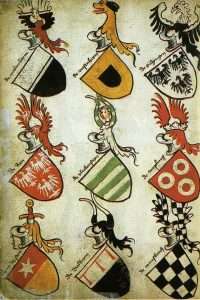
'Shield' patterns.
At the centre, there is a scene of two figures carved in ivory: a male Greek warrior killing an Amazon. This is almost certainly a depiction of Achilles, the greatest of the Greek legendary heroes and a supposed ancestor to Philip and Alexander, fighting the Amazon Queen Penthiselea, and falling in love with her the very moment he kills her.
And/or: "A new generation of forensics has turned up surprising results and taken us closer to establishing just who was buried and when. Materials on the remains, melted gold on bones, and a crippling leg wound reveals a limping warrior woman revered as an 'Amazon' at death, and a king adorned with a gold wreath and ceremonial shield as the flames climbed the pyre in emulation of a Homeric hero....The identity debate always needed to accommodate a weapon of great mystery: with the female bones lay a gold-plated Scythian 'gorytos', the hip-slung bow-and-arrow quivers of the formidable Scythian archers. Over 1,000 excavated graves in Ukraine and the Russian Steppes have proven the existence of these female warriors, latter-day 'Amazons', who were often buried with horses, weapons, tools and their typical nomad jewellery."
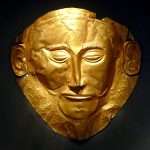 And/or: Melted gold droplets found on the upper vertebrae begged the question of whether the male was initially wearing his wreath as flames licked the funeral pyre because his incomplete gold oak wreath showed signs of intense heat and lacked the pieces found in the pyre remains heaped on the tomb roof. An ivory-and-glass-decorated ceremonial shield also showed signs of exposure to fire. It appears the dead king was presented to the onlookers battle-ready in all his finery as the fire began cleansing his corpse, before being whipped away for interment below with his collected and washed bones.
And/or: Melted gold droplets found on the upper vertebrae begged the question of whether the male was initially wearing his wreath as flames licked the funeral pyre because his incomplete gold oak wreath showed signs of intense heat and lacked the pieces found in the pyre remains heaped on the tomb roof. An ivory-and-glass-decorated ceremonial shield also showed signs of exposure to fire. It appears the dead king was presented to the onlookers battle-ready in all his finery as the fire began cleansing his corpse, before being whipped away for interment below with his collected and washed bones.

Tomb II remained unlooted and contained an exceptional amount of grave goods. An impressive gold larynx, decorated with plant motifs and marked with the star of Macedon, was found in the main room in a marble sarcophagus and contained the cremated remains of middle-aged male, thought to be Philip II (Andronicos, Thesslonike Museum: 27). Grave goods include: a large quantity of silver and bronze vessels, decorated furniture (an ivory couch), a splendid gold oak wreath (which adorned the cremated bones), a silver gilded diadem, weapons, armour and wine drinking vessels among others things (Borza: 258). Ivory heads that once adorned wooden beds were also found; two of the most impressive include a bust of Alexander the Great and another of King Philip II: they are “the only genuine portraits of the two rulers” (Andronicos, Thesslonike Museum: 15). In the antechamber, which is usually designated for grave goods, a second, less impressive gold larynx was found with the remains of a young woman.
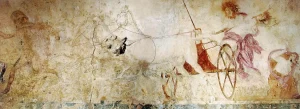
Excavation of the Great Tumulus at Vergina began in 1976. In 1977 he uncovered three fourth century tombs. Tomb I, which is usually referred to as the Tomb of Persephone, is a large cist grave. Because of looters, all that is left are bones belonging to a male, a female and an infant {Qurna?}. However, the Tomb of Persephone contains the best-preserved wall paintings from the time; one wall depicts the mythological scene of the Rape of Persephone, to which the tomb’s name is attributed. Most impressive of the three tombs is Tomb II, which is usually identified as the tomb of Philip II of Macedon. AND/OR: "A dual concept is contained in the seventh principle. The first half is itself a synthetic idea. Primarily it is a concept including the three Alchemical Principles of Salt, Sulpher and Mercury, considered as an undivided unit.....Three DORMANT principles, for which reason it is often called Mercury alone {not the planet}. Its other names are the Quintessence, Azoth, our Water, or the Astral Ether...It quintessentialises the four elements of Earth, Air, Water, and Fire. It is axiomatic that any single principle or unit is multiple when observed from a higher level - that is, with additional insight. A multiplicity is a unity when approached or seen from below......We may now glance at the remaining DUAL concept of the SEVENTH principle {Element 'earth' i.e., foundation}....The instinctive life, the body consciousness, or the brain mind. It corresponds with the mythological Persephone, the animal or unredeemed soul which is in exile from the promised land, lost, wandering in the wild darkness, ever in search for some abiding city...." [''The Philosophers Stone' / I. Regardie]. Question. How many wives did he have? QENA to enlarge + 'Smith and Jones' + "three and a half."
Interestingly, Aegae was not the only capital of ancient Macedonia. In the 5th century BCE, a new capital was founded at Pella, about 40 miles to the east, midway between Aegae and modern Thessaloniki1. However, Aegae remains a crucial archaeological site, and its extensive necropolis contains over 700 burial mounds, providing insights into the social structure and history of the ancient town.
''Today the village of Vergina overlaps the ancient site of Aigai {Aegae}, or the "place of the goats." Aigai was the first capital of ancient Macedonia and remained an important ceremonial center despite being supplanted by Pella...." [Page 26 'Archaeology' May-June 2024].
N.B. Abydos first capital city in Egypt {'eighth' nome} - before moving on to Memphis. Representing the union of Upper and Lower Egypt. Just as Phillip II united Greece.
Memphis (Arabic: مَنْف, romanized: Manf, pronounced [mænf]; Bohairic Coptic: ⲙⲉⲙϥⲓ; Greek: Μέμφις), or Men-nefer, was the ancient capital of Inebu-hedj, the first nome of Lower Egypt that was known as mḥw ("North").[3] Its ruins are located in the vicinity of the present-day village of Mit Rahina (Arabic: ميت رهينة), in markaz (county) Badrashin, Giza, Egypt.[4] This modern name is probably derived from the late Ancient Egyptian name for Memphis mjt-rhnt meaning "Road of the Ram-Headed Sphinxes."
Coincidence or a meaningful one?
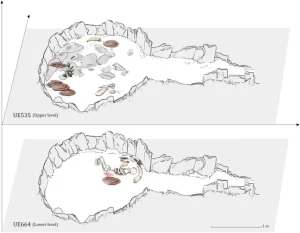
When archaeologists in 2008 discovered ivory tusks, amber, ostrich eggshells, and a rock crystal dagger WITH IVORY HILT and sheath in a 5000-year-old grave in the town of Valencina in southwest Spain, they assumed it belonged to an elite leader. They dubbed the individual within—likely the person with the highest social status in all of Iberia during the time—the Ivory Man.
But that title would more accurately be the Ivory Lady, researchers assert today in Scientific Reports. A state-of-the-art analysis of the remains’ proteins indicates this esteemed person was a woman. Researchers say no men occupied a comparable status in this society. Ivory comb also found along with flint dagger with amber pommel. Question. 'Key' shape?
Refresher: "Why,’ I asked, ‘is the eclipse such a deep experience? What is this sense of sadness one feels? It is a far deeper experience than one would expect of the temporary shutting off of the light. I have not seen many eclipses, yet I know that it is an experience . . . rather, as they say, “as though someone were walking over my grave”. What is this experience?’ Mark had smiled at my outworn image, and, when I had finished the question, nodded: “This feeling of death is there because the symbolism of the eclipse reaches into the very fundament of the human soul. There is a sort of presage of death, but not in the way one might immediately imagine. You'll remember, from your readings of the hermetic literature, that there’s mention of ishon, the small man?” ‘I seem to have gone a long way from your question — yet this is not the case....
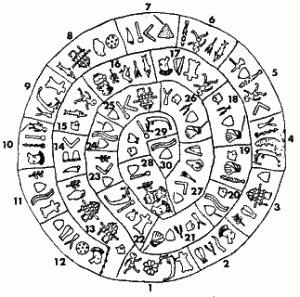
Asleep - ready to awaken?
When we experience an eclipse, we feel, as it were, the “death” of this dwarf. We feel that he has been dropped into a narcotic state. The human spine, which grows upwards towards the Sun, loses for a few seconds its upward thrust towards verticality.? It wishes to “sleep” — to become horizontal to the surface of the Earth. In this respect, it feels the impulse to become like the backbones of the animal realm — parallel to the Earth, and completely under the dominion of the Moon. The human is suddenly pulled back into its atavistic animal-like state. It needs to be led out of this state of being, which, in comparison with the human state, is virtually a sleep.’
There are the two Ways — the Way Up and the Way Down — and among the ways up is the Way of the Fool.
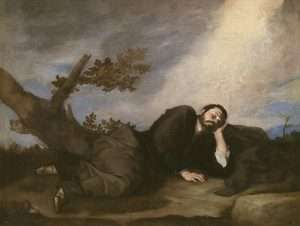
'Ladder' made from it?
 The zero marks the intersection between the Way Up and the Way down, where there is neither Up nor Down. After all, a wheel in motion must have some point at its centre which does not move — this is the STILL point mentioned in the hermetic literature. Even a ladder pitched between Heaven and Hell must have a point where there is neither up nor down: this much Dante recognized, with his usual genius, when he wrote in his Inferno about his experience at the centre of the Earth when the movement up suddenly became the movement down."” This could perhaps be the zero place. ‘Here, in this eclipse, my own mind perceives a meaning which is different from the one you perceive, yet however we define it, an eclipse is a meeting of circles which are zeros. See how the shadow of the Earth’s rim cuts the Moon down to a crescent. Soon, in a few minutes, the crescent will be gone.
The zero marks the intersection between the Way Up and the Way down, where there is neither Up nor Down. After all, a wheel in motion must have some point at its centre which does not move — this is the STILL point mentioned in the hermetic literature. Even a ladder pitched between Heaven and Hell must have a point where there is neither up nor down: this much Dante recognized, with his usual genius, when he wrote in his Inferno about his experience at the centre of the Earth when the movement up suddenly became the movement down."” This could perhaps be the zero place. ‘Here, in this eclipse, my own mind perceives a meaning which is different from the one you perceive, yet however we define it, an eclipse is a meeting of circles which are zeros. See how the shadow of the Earth’s rim cuts the Moon down to a crescent. Soon, in a few minutes, the crescent will be gone.
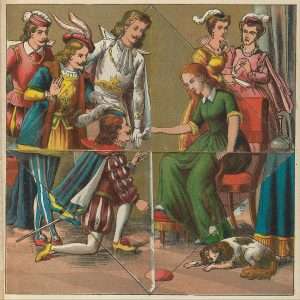
'Cracked mirror'. What's the remedy?
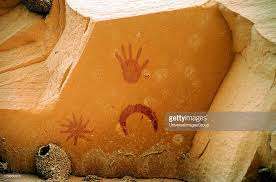 For a while, the Moon will appear to be a dark zero — a nothing. Then the cycle will begin again, breathing a new life of light into the Moon. Soon, it will become a great zero of light in the skies. This is a conjuring trick on a cosmic scale, which is repeated relatively few times in any lifetime. ‘Could this be one reason why the Fool of the Tarot pack is given the strange number zero? It is a curious number, for any esotericist will tell you that there is no such thing as nothing. Yet even the Fool, and even the eclipsed Moon, is not nothing, as behind appearance there is always spirit. In the past, scientists used to say that Nature abhors a vacuum — this may be true in a scientific sense, but it is certainly true in a Spiritual sense. There is no such thing as a vacuum, for the entire cosmos is a conspiracy against nothingness. Everywhere is filled with God: perhaps this is the secret of the zero?
For a while, the Moon will appear to be a dark zero — a nothing. Then the cycle will begin again, breathing a new life of light into the Moon. Soon, it will become a great zero of light in the skies. This is a conjuring trick on a cosmic scale, which is repeated relatively few times in any lifetime. ‘Could this be one reason why the Fool of the Tarot pack is given the strange number zero? It is a curious number, for any esotericist will tell you that there is no such thing as nothing. Yet even the Fool, and even the eclipsed Moon, is not nothing, as behind appearance there is always spirit. In the past, scientists used to say that Nature abhors a vacuum — this may be true in a scientific sense, but it is certainly true in a Spiritual sense. There is no such thing as a vacuum, for the entire cosmos is a conspiracy against nothingness. Everywhere is filled with God: perhaps this is the secret of the zero?
‘In any case, the eclipse is complete, and is answering your question about the zero. We are looking down the Earth’s shadow into what appears to be nothing: yet it is really the dancing ground of angels....
REFRESHER: "All have their keys, and set ascents; but man though he knows these, and hath more of his own, Sleeps at the ladder’s foot."Henry Vaughan: The Tempest.
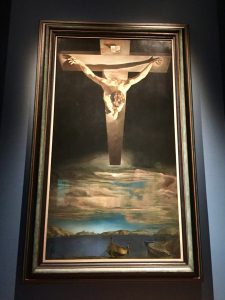
A beginning or end? 'Ladder'?
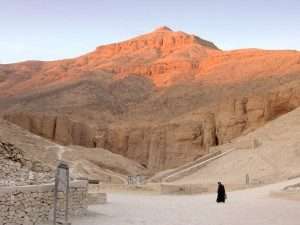
'She who loves silence'.
SIDE NOTE: "If we want to become anything, we must also "not-become" everything else. Before any vessel may be filled with any specific content, it must be empty. Before a single number is countable, Zero must be assumed. No Creation is possible without the Void. Writing can only be recorded on blank paper, or sound on a clean tape. Whatever we choose to call this ability of "switching off" or zeroing ourselves, it is undoubtedly the pre-requisite for all other magical abilities, and unless we can develop some degree of skill with our consciousness in this direction, there is little use hoping for much success elsewhere. In times gone by, people valued the power of Zero so much they devoted whole lives to its achievement, going into solitude and
silence in search of it....." {Page 24-5 ''Magical Ritual Mehods' / W. Gray}.
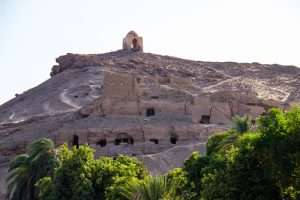
Qubbet el-Hawa or "Dome of the Wind" is a site on the western bank of the Nile, opposite Aswan, that serves as the resting place of ancient nobles and priests from the Old and Middle Kingdoms of ancient Egypt.
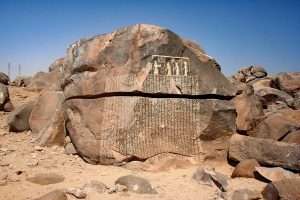
Up or down?
AND/OR: The prima materia was understood to have been ‘generated' by fire, born of water {'flood' waters?}, brought down from the sky by wind, and nourished by earth — the formation of matter, balanced by the elements, yet whose essential core — its DNA — remains a secret. All things created derive from its substance, yet its perfection is the achievement of the Great Work. The prima materia must be given over to the 'mother' to be shaped or ‘fixed' {'anchored'?}. When the ‘child' is growing it must be purged of its separate elements in order that it grows strong: the soul and spirit of the prima materia are matured. Next, the correspondences between micro-and macrocosm must be comprehended: the ‘youth' is sent to its 'father' for instruction in matters sublime. When this is achieved the ‘adult’ {Horus'?} returns to earth in order to practise this wisdom. The prima materia has been united with the quintessentia, which it mirrors, and discovers its adamantine purity and strength.
Side note: "Through study one acquires knowledge, through knowledge, love, which creates devotion, devotion creates repetition and by fixing repetition one creates in oneself experience, virtue and power, through which the miraculous work is done and the work in nature is of this quality."
Quantity/Quality as a means....

Wife / Mother / Grandmother of the Old Kingdom pharaohs.

Stump?
Continued: This process is that by which everything is created and, if imitated with wisdom, can effect healing, long-life and illumination of the whole world. The guardian of this work is Hermes Trismegistos himself: the child of the philosophers and inheritor of their accumulated wisdom, the youthful initiate in the mysteries of both mother and father, God and Goddess, and the mature guardian of the mysteries, the Agathodaimon of all who seek to achieve the Great Work. This meditation upon the text of the Emerald Tablet is offered as a working model for those who wish to go further in this Work. Alternatively, the reader may wish to work with the three unidentified concepts which are termed salt, sulphur and mercury.
These are not to be taken only as physical or chemical substances, but apply respectively to the body, soul and spirit. Together with the glyph of fig 21 and the Emerald Tablet, the correspondences of these processes and their interrelation can be explored in meditation. Similarly, the classical terms for the main alchemical processes can be employed in a meditative manner, namely, the nigredo, albedo and rubedo which we shall be investigating later in this chapter. Mercury, the metal of Hermes himself, is a bridge between the chemical substances employed in alchemy. Of all the metals, quick- silver (mercury) ‘did not participate in the last stages of earth’s densifymg (but) remained a 'fluid'. Just so, Hermes Trismegistos does not remain anchored in one mythos, but ranges throughout the systems and mythologies of many cultures, as messenger. The mercurial powers of Hermes are best assimilated under his symbolical representation as the Green Lion of the alchemical processes....
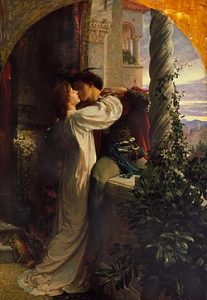
Rope or wooden ladder?
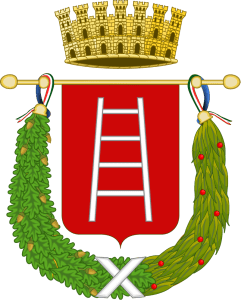
Verona: Coat of Arms
His continual shape-shifting connects the many levels, systems and processes and produces a wealth of knowledge as set forth in the Emerald Tablet: 'The green lion is extremely agile - And blows forth the sun’s colours - So that the reflection - May be seen on the plain.'
Hermes, as the Green Lion, explores the heights and depths the heavens, the earth and the waters beneath the earth. His example is the pattern which the alchemist follows (fig 22). The Green Lion Alchemy is the soul-price of the cosmos it teaches us to relate the infinite to the mundane, to find the presence of the divine in the daily circle of being. The process is a spiritual code used — as is the Tree of Life — by those who seek the Stone, as a system of correspondences through which to relate everything micro- and macrocosmically. The search for the Stone consists in refining the soul, purging it of elemental influences, until all that remains is a single unit — a perfectly tuned microcosm, reflecting the macrocosm. All matter is a mystery: the processes of alchemy are a ladder wherewith to transcend time and space until one stands at the highest point of creation, which is 'God'..."{'The Western Way' / C+J Matthews}.
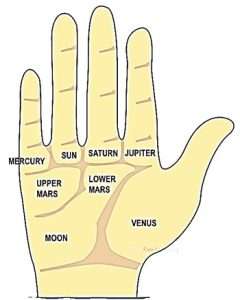
''The little finger is sometimes referred to as a pinky.''
 CONTINUED: The sunlight flushed pink light over us as we stepped into the outer world, beneath the plethora of zodiacal images on the walls. I had flown out to meet Mark because we had various ideas to discuss in connection with his book — especially those issues relating to footnotes and bibliographic sources — but, for one reason or another, we did not get around to these questions at all. On the night of the eclipse, we sat on one of the hillsides which rise between Grand Anse and Pink Gin Beach, and watched the slow motion of the Moon as it edged towards the drama of its eclipse. Our view was complete, undisturbed even by a wisp of cloud. We were leaning back into an incline of hillside, in a position from which we could most easily watch the Moon, which was almost reaching the zenith. From below came the distant thud of waves as the Atlantic broke on the sands of Pink Gin Beach. In the distance were the lights of houses and restaurants on the further side of the great bay around which nestled the port of St George’s. Here was peace, and I could see why Mark had adopted it as a retreat......
CONTINUED: The sunlight flushed pink light over us as we stepped into the outer world, beneath the plethora of zodiacal images on the walls. I had flown out to meet Mark because we had various ideas to discuss in connection with his book — especially those issues relating to footnotes and bibliographic sources — but, for one reason or another, we did not get around to these questions at all. On the night of the eclipse, we sat on one of the hillsides which rise between Grand Anse and Pink Gin Beach, and watched the slow motion of the Moon as it edged towards the drama of its eclipse. Our view was complete, undisturbed even by a wisp of cloud. We were leaning back into an incline of hillside, in a position from which we could most easily watch the Moon, which was almost reaching the zenith. From below came the distant thud of waves as the Atlantic broke on the sands of Pink Gin Beach. In the distance were the lights of houses and restaurants on the further side of the great bay around which nestled the port of St George’s. Here was peace, and I could see why Mark had adopted it as a retreat......
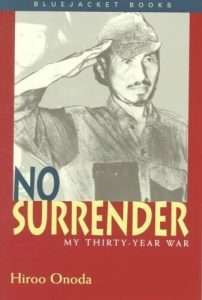
Side note: Onoda last remaining comrade, Private First Class Kinshichi Kozuka, was killed in 1972 from shots fired by local police while they were burning rice they had collected from local farmers - leaving Onada alone, until 1974. That was when he met and became friends with Norio Suzuki, a Japanese man who was travelling round the world looking for, as he put it, 'Lieutenant Onoda, a panda, and the Abominable Snowman, in that order'. He found Onoda and they became friends - but he still could not persuade him to 'surrender' ...Suzuki eventually learned that Onoda had been waiting for surrender orders from a superior officer, and after returning to Japan with photos of them together as proof of their meeting, the Japanese government located his former commanding officer, Major Yoshimi Taniguchi, who had become a bookseller since the war ended....
 Taniguchi went to Lubang Island and met with Onoda, to finally deliver on the promise he had made in 1944: 'Whatever happens, we'll come back for you,' before ordering him to 'cease military activities and operations immediately and place themselves under the command of the nearest superior officer'. Onoda finally surrendered, turning over his sword, 500 rounds of ammunition, hand grenades and the dagger given to him by his mother in 1944, for use in the event he was captured....Onoda was something of a celebrity after he returned to Japan, publishing his autobiography of life as a guerrilla fighter in a war which had long since ended. However he left the limelight behind in 1975 to move to Brazil and raise cattle - marrying in 1976 and only returning to Japan in 1984 where he founded an educational camp for young people, Onoda Shizen Juku (Onoda Nature Camp). Despite admitting he killed several people during his time on Lubang Island he was given a full pardon for his actions there by President Ferdinand Marcos. He died in 2014 aged 91, with the then Chief Cabinet Secretary Yoshihde Suga saying in tribute: 'I still vividly remember that I was reassured of the end of the war when Mr. Onoda returned to Japan'......"
Taniguchi went to Lubang Island and met with Onoda, to finally deliver on the promise he had made in 1944: 'Whatever happens, we'll come back for you,' before ordering him to 'cease military activities and operations immediately and place themselves under the command of the nearest superior officer'. Onoda finally surrendered, turning over his sword, 500 rounds of ammunition, hand grenades and the dagger given to him by his mother in 1944, for use in the event he was captured....Onoda was something of a celebrity after he returned to Japan, publishing his autobiography of life as a guerrilla fighter in a war which had long since ended. However he left the limelight behind in 1975 to move to Brazil and raise cattle - marrying in 1976 and only returning to Japan in 1984 where he founded an educational camp for young people, Onoda Shizen Juku (Onoda Nature Camp). Despite admitting he killed several people during his time on Lubang Island he was given a full pardon for his actions there by President Ferdinand Marcos. He died in 2014 aged 91, with the then Chief Cabinet Secretary Yoshihde Suga saying in tribute: 'I still vividly remember that I was reassured of the end of the war when Mr. Onoda returned to Japan'......"
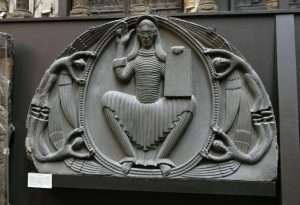
"Blank slate?"

Grenada_on_the_globe_Americas
The eclipse began shortly before 11.30p.m. Caribbean local time. The comet Hale-Bopp was, in theory at least, visible to the north-west, below Perseus and Cassiopeia. Unfortunately, neither I, nor Mark Hedsel saw the comet on that occasion."
'W / M' ?
A lunar eclipse is an astronomical event that occurs when the Moon moves into the Earth's shadow, causing the Moon to be darkened.[1] Such an alignment occurs during an eclipse season, approximately every six months, during the full moon phase, when the Moon's orbital plane is closest to the plane of the Earth's orbit. This can occur only when the Sun, Earth, and Moon are exactly or very closely aligned (in syzygy) with Earth between the other two, which can happen only on the night of a full moon when the Moon is near either lunar node. The type and length of a lunar eclipse depend on the Moon's proximity to the lunar node.[

The Lunar Year of the Rat begins the Chinese zodiacal calendar.
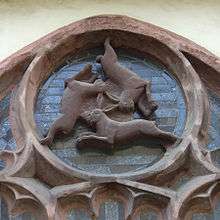
Man in the moon?
When the Moon is totally eclipsed by the Earth (a "deep eclipse"),[2][3] it takes on a reddish color that is caused by the planet when it completely blocks direct sunlight from reaching the Moon's surface, as the only light that is reflected from the lunar surface is what has been refracted by the Earth's atmosphere. This light appears reddish due to the Rayleigh scattering of blue light, the same reason sunrises and sunsets are more orange than during the day. Unlike a solar eclipse, which can only be viewed from a relatively small area of the world, a lunar eclipse may be viewed from anywhere on the night side of Earth. A total lunar eclipse can last up to nearly two hours, while a total solar eclipse lasts only a few minutes at any given place, because the Moon's shadow is smaller. Also, unlike solar eclipses, lunar eclipses are safe to view without any eye protection or special precautions.
The symbol for a lunar eclipse (or indeed, any body in the shadow of another) is ![]() (U+1F776 🝶).
(U+1F776 🝶).
Comet Hale–Bopp (formally designated C/1995 O1) is a comet that was one of the most widely observed of the 20th century and one of the brightest seen for many decades.
![]() Alan Hale and Thomas Bopp discovered Comet Hale–Bopp separately on July 23 {twentythree}, 1995, before it became visible to the naked eye. It is difficult to predict the maximum brightness of new comets with any degree of certainty, but Hale–Bopp exceeded most predictions when it passed perihelion on April 1, 1997, reaching about magnitude −1.8. It was visible to the naked eye for a record 18 months, due to its massive nucleus size. This is twice as long as the Great Comet of 1811, the previous record holder. Accordingly, Hale–Bopp was dubbed the great comet of 1997.
Alan Hale and Thomas Bopp discovered Comet Hale–Bopp separately on July 23 {twentythree}, 1995, before it became visible to the naked eye. It is difficult to predict the maximum brightness of new comets with any degree of certainty, but Hale–Bopp exceeded most predictions when it passed perihelion on April 1, 1997, reaching about magnitude −1.8. It was visible to the naked eye for a record 18 months, due to its massive nucleus size. This is twice as long as the Great Comet of 1811, the previous record holder. Accordingly, Hale–Bopp was dubbed the great comet of 1997.
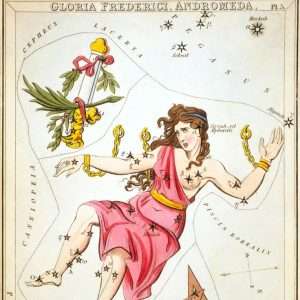 Cassiopeia was the wife of King Cepheus of Aethiopia. Her pride got the best of her when she bragged that her daughter Andromeda was more beautiful than the Nereids, part of Poseidon’s retinue. As punishment for this affront, Poseidon sent a sea monster Cetus to destroy Aethiopia. The only way to stop the destruction was to sacrifice their daughter Andromeda to the monster, so they chained her to a rock on the shore. Just as Cetus approached to claim his sacrifice, Perseus, returning from his slaying of Medusa, saw the beautiful Andromeda, and saved her from the beast. Aethiopia was saved. Upon Cassiopeia’s death, Poseidon placed her in the stars, where she was chained to her throne and must spend half of the year upside-down as further punishment.
Cassiopeia was the wife of King Cepheus of Aethiopia. Her pride got the best of her when she bragged that her daughter Andromeda was more beautiful than the Nereids, part of Poseidon’s retinue. As punishment for this affront, Poseidon sent a sea monster Cetus to destroy Aethiopia. The only way to stop the destruction was to sacrifice their daughter Andromeda to the monster, so they chained her to a rock on the shore. Just as Cetus approached to claim his sacrifice, Perseus, returning from his slaying of Medusa, saw the beautiful Andromeda, and saved her from the beast. Aethiopia was saved. Upon Cassiopeia’s death, Poseidon placed her in the stars, where she was chained to her throne and must spend half of the year upside-down as further punishment.
Abraham - Isaac - Burning BUSH as a means.....?
And/or: Multi coloured braided hair extensions found on many female skeleton bodies in shallow graves: "standard pit grave in the sand" at Amarna. Hundreds of bodies "with outlandish hairpiece matted to the skulls of the dead." Wrapped in mats. Bodies not mummified, rotted away, yet hair preserved - due to cows and goats fat mixed in with perfumes. It allowed preservation in the dry heat of the desert. Different types of hair from different individuals {mainly young?}. Linked to the goddess Hathor who was known as "She of the beautiful hair. Lady of the locks." [ 'Egyptians Unexplained Files' / S1 EP6].
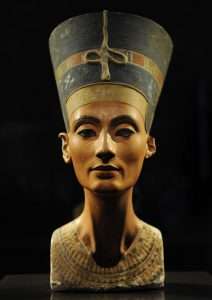
'Stamp of the feminine'. Real or symbolic?
Question. If East to West represents a ''land mass.'' Where on that same map would be a representation of a ''water mass.''
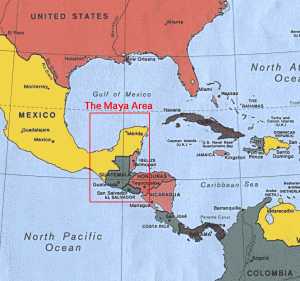
Question. Three parts water - one part land? Izapa at the 'lower' point. At the base of a Volcano. That 'one part' = the 'crystallization' of something? {S/W?}. All enlarged elsewhere. And/or: ''In Earth there is Four: Water and Fire. Three and One. Hence all stems from the relation of Fire One To Water Three.....We know that the Three of Water needs a Fire unit, the seed, in order to coagulate into Earth and become Four....." [Page 82/4 'The Egyptian Miracle' / R. A. Schwaller de Lubicz]. And/or: ''Of the Red man one, of the White wife three: which take thou and mix- then of the water four parts let there be - this mixture is our lead - which be moved by a gentle heat; and increased; until it sweats.'' [Page 71 'Mercurius' / P. Harpur].
Pacific / Atlantic - Warm / cold. Anything? Enlarged elsewhere.
A {working?} example: "The conditions of life in which a man is placed at the beginning of his work, in which, so to speak, the work finds him, are the best possible for him, at any rate, at the beginning of the work. These conditions are natural for him. These conditions are the man himself, because a man's life and its conditions correspond to what he is. Any conditions different from these created by life would be artificial for a man and in such artificial conditions the work would not be able to touch every side of his being at once. Thanks to this, the fourth way affects simultaneously every side of man's being. It is work on the three 'rooms' at once...So that when a man attains Will on the fourth way, he can make use of it because he has acquired control of all his bodily, emotional and intellectual functions. And besides, he has saved a great deal of time by working on the three sides {'rooms'} of his being in parallel and simultaneously... " ['In Search of the Miraculous']. Try ''side{s}''. Then follow the title of the book to 'see' it in its broader context.
Question. Agree/disagree.
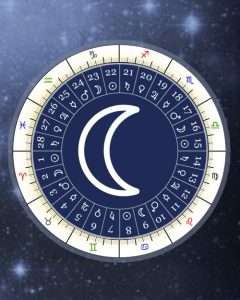
"The moon completes the full circle against the stars in about 27.3 days (Sidereal Lunar Month).
Lunar Mansions (also called Lunar Stations) are the equal segments of the ecliptic through which the Moon passes in its orbit."
And/or: "The difference between knowledge and understanding becomes clear when we realize that knowledge may be the function of one center {'ellipse' link?}. Understanding, however, is the function of three centers. Thus the thinking apparatus may know something. But understanding appears only when a man feels and senses what is connected with it. We have spoken earlier about mechanicalness. A man cannot say that he understands the idea of mechanicalness if he only knows about it with his mind. He must feel it with his whole mass, with his whole being; then he will understand it." [Same book, includes intalics].

Man in the moon? hare?
All the above in relation to thinking/feeling/willing. Purpose of. Anything?
Analogy? "...headed for the meeting place of Utah, Colorado, New Mexico, and Arizona, the point at which the Four Corners come together." ['Serpent of Light beyond 2012' ]. What some call the 'Stonehenge of the Southwest'. Notice its relation {position} to Hendaye.
And/or: "UTAH. The Beehive State - location of the Golden Spike, a monument to the linking of the Central Pacific and Union Pacific railroads, near Great Salt Lake....
Station.
The golden spike is the ceremonial 17.6-karat gold final spike driven by Leland Stanford to join the rails of the first transcontinental railroad across the United States connecting the Central Pacific Railroad from Sacramento and the Union Pacific Railroad from Omaha on May 10, 1869, at Promontory Summit, Utah Territory1. The tapping of the golden spike symbolized the completion of America's first transcontinental railroad2.
'Seventeen'?
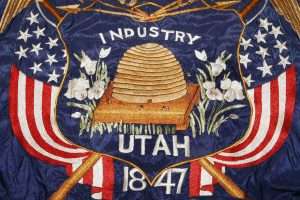 Utah's early settlers, who were primarily members of the Church of Jesus Christ of Latter-day Saints, also known as the LDS Church or the Mormon Church, saw the beehive as the perfect metaphor for their industriousness and hard work. The beehive appears on the state flag of Utah, along with the state motto: “Industry."
Utah's early settlers, who were primarily members of the Church of Jesus Christ of Latter-day Saints, also known as the LDS Church or the Mormon Church, saw the beehive as the perfect metaphor for their industriousness and hard work. The beehive appears on the state flag of Utah, along with the state motto: “Industry."
"The messenger of god said, The Quran was sent down in seven modes, each verse in it has an external and internal meaning, and at each boundary there is a vista [Tabari]." Taken from 'The Book of Hadiths': Sayings of the Prophet Muhammad, from the Mishkat al - Masabib] by C. L. Eaton].
Greek equivalent. Hermes being the Greek god of 'transitions and boundaries'. Think about it, relative to what Zeus and Apollo imply. What they represent. Same principle as Solomon in relation to 'his Temple'. A further 'development/understanding' of something.
"The name Apollo—unlike the related older name Paean—is generally not found in the Linear B (Mycenean Greek) texts, although there is a possible attestation in the lacunose form ]pe-rjo-[ (Linear B: ]𐀟𐁊-[) on the KN E 842 tablet,[7][8][9] though it has also been suggested that the name might actually read "Hyperion" ([u]-pe-rjo-[ne]).[10]
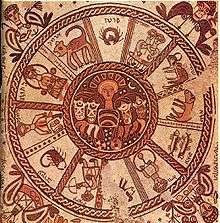
On the floor of a Synagogue.
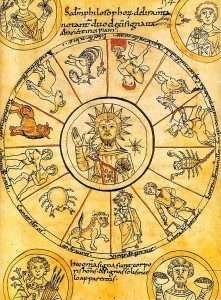 "The etymology of the name is uncertain. The spelling Ἀπόλλων (pronounced [a.pól.lɔːn] in Classical Attic) had almost superseded all other forms by the beginning of the common era, but the Doric form, Apellon (Ἀπέλλων), is more archaic, as it is derived from an earlier *Ἀπέλjων. It probably is a cognate to the Doric month Apellaios (Ἀπελλαῖος),[11] and the offerings apellaia (ἀπελλαῖα) at the initiation of the young men during the family-festival apellai (ἀπέλλαι).[12][13]
"The etymology of the name is uncertain. The spelling Ἀπόλλων (pronounced [a.pól.lɔːn] in Classical Attic) had almost superseded all other forms by the beginning of the common era, but the Doric form, Apellon (Ἀπέλλων), is more archaic, as it is derived from an earlier *Ἀπέλjων. It probably is a cognate to the Doric month Apellaios (Ἀπελλαῖος),[11] and the offerings apellaia (ἀπελλαῖα) at the initiation of the young men during the family-festival apellai (ἀπέλλαι).[12][13]
"According to some scholars, the words are derived from the Doric word apella (ἀπέλλα), which originally meant "wall," "fence for animals" and later "assembly within the limits of the square."[14][15] Apella (Ἀπέλλα) is the name of the popular assembly in Sparta,[14] corresponding to the ecclesia (ἐκκλησία).

“Most certainly, I tell you, one who doesn’t enter by the door into the sheep fold, but climbs up some other way, is a thief and a robber."
R. S. P. Beekes rejected the connection of the theonym with the noun apellai and suggested a Pre-Greek proto-form *Apalyun."..... Hesychius connects the name Apollo with the Doric ἀπέλλα (apella), which means "assembly", so that Apollo would be the god of political life, and he also gives the explanation σηκός (sekos), "fold", in which case Apollo would be the god of flocks and herds.[19] In the ancient Macedonian language πέλλα (pella) means "stone,"....."
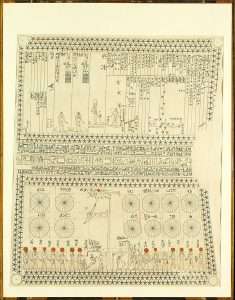
Astro ceiling in Senenmut bare tomb chamber. 'Folded'?
And/or: A moot hill or mons placiti (statute hill)[1] is a hill or mound historically used as an assembly or meeting place, as a moot hall is a meeting or assembly building, also traditionally to decide local issues. In early medieval Britain, such hills were used for "moots", meetings of local people to settle local business. Among other things, proclamations might be read; decisions might be taken; court cases might be settled at a moot.
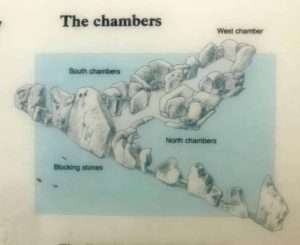
West Kennet long barrow.
Although some moot hills were naturally occurring features or had been created long before as burial mounds, others were purpose-built....
Although the word moot or mote is of Old English origin, deriving from the verb to meet, it has come to have a wider meaning throughout the United Kingdom; initially referring to any popular gathering.
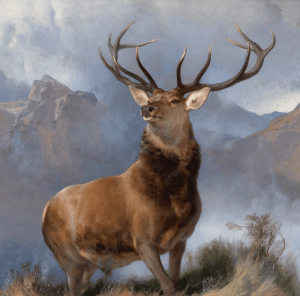
Landseer, The Monarch of the Glen 1851
In England, the word folkmoot in time came to mean a more specific local assembly with recognised legal rights. In Scotland the term is used in the literature for want of any other single accepted term.
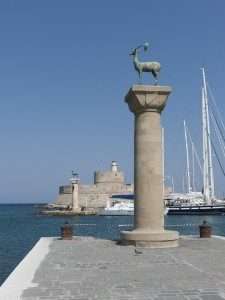
Stag and deer. 'Patronus' to enlarge.
The Scottish Gaelic place name "Tom a' Mhòid" translates as "the hill of the court". The Gaelic form has the familiar Gaelic word "mòd" in the context of the annual cultural event, a "gathering", but in this context, one for judgement and possible execution. The term is cognate with the English word "moot".....
And/or: The monument consists of the remains of the royal assembly and ceremonial inauguration site at Moot Hill and the medieval abbey of Scone. The abbey and Moot Hill lie immediately northeast of the Palace of Scone, about 50m above sea level. The royal assembly site at Scone originated as a power centre in the early medieval period. The moot continued to act as a royal focal point and was the primary coronation site for Scottish monarchs throughout the medieval and into the post medieval period. It is a large flat-topped artificial oval mound. The mound is approximately 100m in diameter north-south by 70m transversely and is surrounded by a ditch approximately 8m to 9m wide by 3m deep, which survives as a buried feature....
Side note: "Monarchy of the eye in relation to Democracy of the nose."
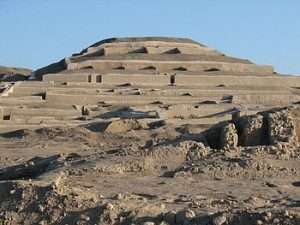
Assembly mound?
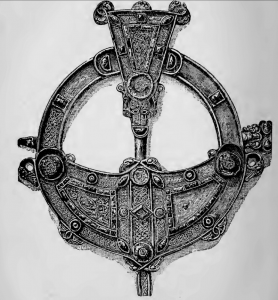
Tara brooch.
Assembly mounds, coronation locations, thing sites and judicial gathering places are common features in northwest Europe, and have a long history. While there are many important assembly sites in Scotland, such as Doomster Hill in Govan, Finlaggen in Islay, Dingwall, in Caithness and Law Ting Holm in Shetland, none are as well-known or have such a clearly recognised importance as Scone. The assembly site of Scone rose to prominence in the early medieval period. The mound may date from this period but it could also be a reused prehistoric feature. A similar development has been argued for other assembly sites; at Tynwald on the Isle of Mann, it has been suggested that the assembly mound is a modified prehistoric barrow. Whatever the origin of the mound at Scone by the ninth century it had become a regional power centre acting as the primary assembly place for the Kingdom of Scotland, a coronation site and potential royal centre. The importance of Scone for the kingdom is highlighted by its interchangeable use in historic documents with Scotland and Alba, as the early Kingdom of Scotland was often referred to as the Kingdom of Scone. This is very similar to the relationship between the royal site of Tara and the Kingdom of Ireland.

Isle of Man also has same.
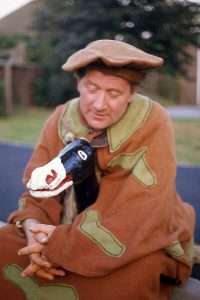
Flat top? Asleep ?
The earliest reference to the Moot Hill is a document from the tenth century referred to as the Chronicles of the Kings of Alba, which mentions the Hill of Faith in Scone. It was on the Hill of Faith in 906 that King Constantine II and the Bishop Cellach met and the King swore to uphold the customs of the church, the earliest reference to the Moot Hill and to a coronation carried out at the site with the involvement of a church official. This may have marked the transition from the coronation being a solely secular practice to one that had significant church involvement. Tradition has it that it was around this time that an ecclesiastical centre was founded at the site, possibly a Culdee monastery.
Side note: "The Hebrew term is beyt knesset "house of assembly" The Greek-derived word synagogue also means "assembly" and is commonly used in English. Ashkenazi Jews have traditionally used the Yiddish term shul (from the ancient Greek schola (which is also the source of the English "school") via the German Schule, "school") in everyday speech, and many continue to do so in English."
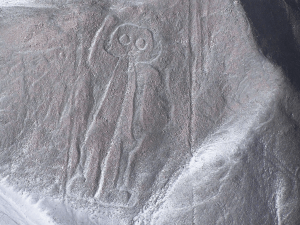
On the opposite side of a river - on the side of a hill. The only one? Raised hand. Same one?
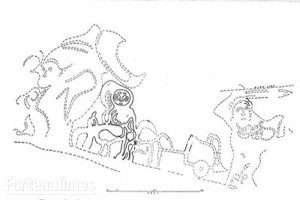 From a different perspective {a stage further?}: "The modern English word "Hebrew" is derived from Old French Ebrau, via Latin from the Ancient Greek Ἑβραῖος (hebraîos) and Aramaic 'ibrāy, all ultimately derived from Biblical Hebrew Ivri (עברי), one of several names for the Israelite (Jewish and Samaritan) people (Hebrews). It is traditionally understood to be an adjective based on the name of Abraham's ancestor, Eber, mentioned in Genesis 10:21. The name is believed to be based on the Semitic root ʕ-b-r (עבר), meaning "beyond", "other side", "across";[26] interpretations of the term "Hebrew" generally render its meaning as roughly "from the other side [of the river/desert]"—i.e., an exonym for the inhabitants of the land of Israel and Judah, perhaps from the perspective of Mesopotamia, Phoenicia or Transjordan (with the river referred to being perhaps the Euphrates, Jordan or Litani; or maybe the northern Arabian Desert between Babylonia and Canaan).[27] Compare the word Habiru or cognate Assyrian ebru, of identical meaning."
From a different perspective {a stage further?}: "The modern English word "Hebrew" is derived from Old French Ebrau, via Latin from the Ancient Greek Ἑβραῖος (hebraîos) and Aramaic 'ibrāy, all ultimately derived from Biblical Hebrew Ivri (עברי), one of several names for the Israelite (Jewish and Samaritan) people (Hebrews). It is traditionally understood to be an adjective based on the name of Abraham's ancestor, Eber, mentioned in Genesis 10:21. The name is believed to be based on the Semitic root ʕ-b-r (עבר), meaning "beyond", "other side", "across";[26] interpretations of the term "Hebrew" generally render its meaning as roughly "from the other side [of the river/desert]"—i.e., an exonym for the inhabitants of the land of Israel and Judah, perhaps from the perspective of Mesopotamia, Phoenicia or Transjordan (with the river referred to being perhaps the Euphrates, Jordan or Litani; or maybe the northern Arabian Desert between Babylonia and Canaan).[27] Compare the word Habiru or cognate Assyrian ebru, of identical meaning."
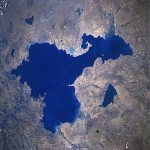
Where have you seen it before?
"The word 'mystic' is from the Greek word 'muo' which means ''to be silent.'' The true mystic realizes that the highest level of insight is realized and honoured in the nature of silence, for the fullness of reality as it exists and as it is experienced can never be fully expressed by descriptive utterance.'' [Chapter one, 'Jesus Christ Sun of God: Ancient Cosmology and Early Christian Symbolism' ].
El {Al} qurn ?
'Ain't No Mountain High Enough' / Marvin Gaye.
'The Lonely Mountain' ['The Hobbit'].
Question. What is the difference between the words ''magic'' {and/or 'magical'} and ''mystical?'' and why are they applied? Enlarged elsewhere. Try Part 4 before those first impressions make one yawn; while 'creating' an inner 'vision' of the armchair and TV set.

''Matter and spirit'' = 'Son of'?
A working example {i.e., in the 'ritual' sense of the word}: ''This was the secret of true, spiritual magic. Yes, timing is important, and tools can hold a charge, and portions and props add to energy and help to shift consciousness, and the focusing of ones mind, and the direction of ones will are essential, but ultimately, the true magical incredients are you and your connection to the divine. 'Magic' requires a capacity for communion with the sacred, because the magical realm that one enters is the realm of the heart. Without capacity for compassion and love, no magic will be truly spiritual in its texture, form, or results....The union of spirit and matter.'' [Page 219 'The Book of Shadows'].
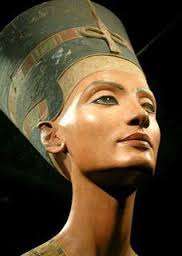
'Realm of the heart'?
From a different perspective: ''My thesis is that the language of poetic myth anciently current in the Mediterranean and Northern Europe was a' magical' language bound up with popular religious ceremonies in honour of the moon goddess, or muse, some of them dating from the Old Stone Age, and that this remains the language of TRUE poetry...." ['The White Goddess' / R. Graves].
The Quran uses 99 aspects/ names with the same intent {but from a different perspective} as the '72' mentioned earlier in relation to the Hebrew Kabbala. Both suggesting the importance of 'equilibrium' within that personnel journey, 99 aspects within the ''one.'' Within the 'whole'. Equals a completion of something, relative to an understanding. Explained throughout.
 That individual 'effort' represented astronomically no more so than with Orion. Sometimes shown with a club. Symbolic of that 'unknown' [ unconscious and or shadow ] state of mind. Or with a 'bow' now representing a conscious state of mind [ i.e.,positive in relation to the effort taken]. Symbolic of a 'direction' taken by way of focus of thought, emotion and will. Those three concepts that are used throughout [regardless of place, time or culture]. Represented now as something ''under his belt.'' Something achieved, in part or whole. Think about it, in relation to the effort taken by thought as opposed to 'a club.' Wild man link, whose brother was the 'green man'. [''Green language'' link. Both explained elsewhere].
That individual 'effort' represented astronomically no more so than with Orion. Sometimes shown with a club. Symbolic of that 'unknown' [ unconscious and or shadow ] state of mind. Or with a 'bow' now representing a conscious state of mind [ i.e.,positive in relation to the effort taken]. Symbolic of a 'direction' taken by way of focus of thought, emotion and will. Those three concepts that are used throughout [regardless of place, time or culture]. Represented now as something ''under his belt.'' Something achieved, in part or whole. Think about it, in relation to the effort taken by thought as opposed to 'a club.' Wild man link, whose brother was the 'green man'. [''Green language'' link. Both explained elsewhere].
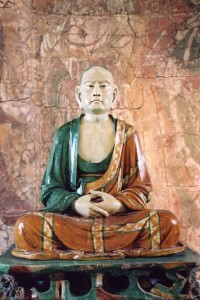
''In Britain today there is only one 'piece of objective art that expresses the spiritual world perfectly without the distorting influence of a human personalty...The Lohan, A chinese statue of a Buddhist monk.'' [Taken from The Secret History] . Question. That inner one? SILENCE? i.e.,what the author of The Presence of Other Worlds calls ''the wellspring of the psyche.'' Question. Why different colors on different shoulders, i.e.,left and right? Same question as why only the left shoulder in relation to the movements around the Ka'ba. Why should the right be left exposed? Understand those keys in order to understand why. In order to understand the subject as a whole. Clue, it has something to do with ''naked'' symbolism. Keep a check on those first impressions, i.e., put ''naked'' in the search box. Think about it, i.e., in relation to "an effort taken", by 'way of' thought/emotion/will, as opposed to an effort taken with a 'club', i.e.,wild man link. Explained elsewhere.
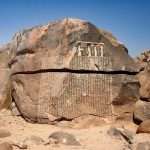 "The kings arrival in the sky is a new birth...The divine entities dance attendance on him, reassemble his bones, give him back the use of his senses, by opening his eyes and mouth, rituals which are accomplished 'magically' in the ''Room of Gold'' on the mummy or its effigy with two adzes and the presentation of a bull's thigh." [Extract from the book 'Egyptian Mysteries'].
"The kings arrival in the sky is a new birth...The divine entities dance attendance on him, reassemble his bones, give him back the use of his senses, by opening his eyes and mouth, rituals which are accomplished 'magically' in the ''Room of Gold'' on the mummy or its effigy with two adzes and the presentation of a bull's thigh." [Extract from the book 'Egyptian Mysteries'].
Question. Right or left thigh or does it matter?
Side note: ''The Inca's referred to gold as the 'sweat of the sun'...'' ['Pawn Stars' / 2020].
''In science Archimedes is said to have cried out ''i have found it'' after determining the means of finding the purity for GOLD.''
"Eureka" comes from the Ancient Greek word εὕρηκα heúrēka, meaning "I have found (it)", which is the first person singular perfect indicative active of the verb εὑρίσκω heurískō "I find".[1] It is closely related to heuristic, which refers to experience-based techniques for problem-solving, learning, and discovery.''
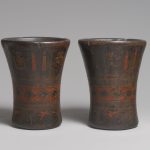
''Before the Spanish conquest- all mostly with geometric shapes/designs''.
''A Kero is an ancient South America ceremonial cup. Keros were often made in pairs and used for drinking chicha—corn beer—in political and religious rituals. In Inca times, the Inca king would exchange a divine toast with his “father” the sun. The symbolic exchange of “sharing a drink” permeated all levels of society.'' [Wiki].
'Hathor Rising' / A. Roberts.
The cheerful brilliance of the morning lent youth to Earth's old bones, touched the peak with gold, gleamed along the river and put the gardens en fete..." ['Her-Bak'].
''Peak'' in relation to Al-qurn. Anything?
"Having taken the bow, the great weapon of the Secret Teaching, one should fix in it, the arrow sharpened by constant meditation. Drawing it with a mind filled with that [Brahman]. Penetrate, O good looking youth, that imperishable as the Mark. [Mundaka Upanishad, ii 3, 4]. Taken from inset page, 'The Yoga of the Kathopanishad' by Sri Krishna Prem.
"The Pranava [Aum] is the bow, the arrow is the self. Brahman is said to be the mark. With heedfulness is it to be penetrated. One should become one with it as the arrow in the mark."[Same book, same page].
A different interpretation, but of the same ilk.
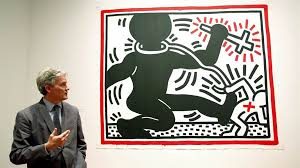
Another piece of objective art?
"Under the sign of Sagittarius you will learn single mindedness, the ability to follow your visions and develop your intuition. The secret behind all success is to be single minded....to speed directly towards the goal you are aiming....When the burning arrow is discharged you must follow it until it has reached its target ...Find a goal worth aiming for and strive toward it....If you aim your bow in the wrong direction, and persistently continue along this road you will inevitably get lost. The road back will therefore be long and troublesome. Here we touch on the second lesson of Sagittarius. The goals you are striving for should be based on intuition, idealism and higher vision." [Page 70, 'Esoteric Astrology' by Torgny Jansson].
Its physical representation, as an example...being the Stonehenge Archer, "purposely buried in an outer ditch". 'See' it?
And/or: Some say that the arrow of Sagittarius points towards the heart {Antares} - of the Scorpion.
Side note: "Why did you give him an astronomer's telescope to carry?...''Because he's searching in the clouds for the wellspring that is flowing at his feet''. ['Journey into the Light'].
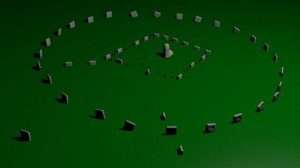
Inner or Outer?
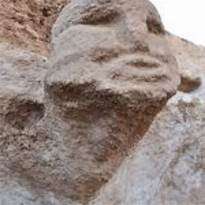
"Spirit or soul?"
''All one has to do is turn around the arrow of ones attention. The Katha Upanishad puts it this way: 'God made the senses turn outward, man therefore looks outwards, not into himself. But occasionally, a daring soul, desiring immortality {or understanding a 'mind set'}, has looked back and found himself. In fact the ''daring soul'' doesn't lack encouragement. He's surrounded by countless reminders and opportunities, countless means of reversing the arrow of attention - if only he's sufficiently inquisitive about his true identity, and only if he's willing to drop for a moment opinions about himself based on hearsay and memory, and imagination and to rely on the PRESENT EVIDENCE...." [Page 56 'On Having No Head' / D. Harding. Parenthesis, this readers].
Arrow of Time?
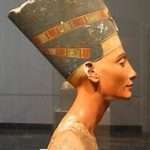
'Stretched'?
In astrophysics, spaghettification (sometimes referred to as the noodle effect)[1] is the vertical stretching and horizontal compression of objects into long thin shapes (rather like spaghetti) in a very strong, non-homogeneous gravitational field. It is caused by extreme tidal forces. In the most extreme cases, near a black hole, the stretching and compression are so powerful that no object can resist it. Within a small region, the horizontal compression balances the vertical stretching so that a small object being spaghettified experiences no net change in volume.
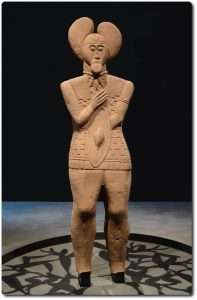
Mortal / immortal?
Stephen Hawking described the flight of a fictional astronaut who, passing within a black hole's event horizon, is "stretched like spaghetti" by the gravitational gradient (difference in gravitational force) from head to toe.[2] The reason this happens would be that the gravitational force exerted by the singularity would be much stronger at one end of the body than the other. If one were to fall into a black hole feet first, the gravity at their feet would be much stronger than at their head, causing the person to be vertically stretched. Along with that, the right side of the body will be pulled to the left, and the left side of the body will be pulled to the right, horizontally compressing the person.[3] However, the term spaghettification was established well before this.[4]
And/or: Singularity Point = "Punching a hole in space and time." {'Sky at Night: Greenwich: A Journey through Space and Time' / BBC4}.
'Void'? 'Zero'?
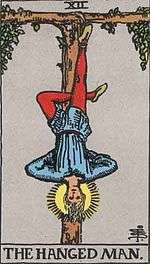
Common factors?
And/or: "Time and Space get twisted around {at the singularity point} - in other words that direction {when one is heading towards the singularity point} - is no longer a direction in space but only in time. Which is why reaching the singularity is as inevitable as in reaching tomorrow.
Primary over secondary? Personal touch?
'Turning the light around'.
Continued: N.B. Flint nodules {in the shape of arrow heads} at the base {foundation material}- of the small blue stones that divide {'boundary'} the river Avon from the end {and/or beginning} of the path that leads to/from Stonehenge. Prof. Pearson speculates that these smaller blue stones would be in a circular formation. This reader speculates - a semi circle, i.e.,a representation of 'half the journey' - link to 180 degrees {in number symbolism} or a u-turn {'landscape'}. Something half complete - a work still in progress.
Horseshoe shape? {in the micro sense of the word} as in the 'middle' of those sarsen stones?
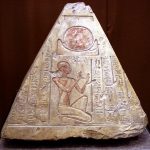
Benben capstone or should that be Benben-et?
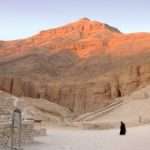 A working example: ''The semicircular 't' hieroglyph, denoting feminine gender, has been inserted into many of her titles.'' {Hatshepsut: From Queen to Pharaoh' / Metropolitan Museum].
A working example: ''The semicircular 't' hieroglyph, denoting feminine gender, has been inserted into many of her titles.'' {Hatshepsut: From Queen to Pharaoh' / Metropolitan Museum].
"In 520 BC Pythagoras returned to Samos and began a school called The Semi-Circle."
And/or: ''520 life size horses'' found within the 8000 terracotta army of 1st Emperor of China. Buried within a triangular mound. An inverted one is where his tomb is laid. As above so below. ['Ancient Worlds Revealed With Albert Lin': Army of the Afterlife' / 21.11.21].
Isaiah 19:19 for 'a different take' on the same theme.
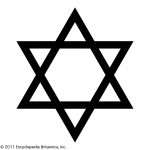
Copy cats?
Side note. A U-shaped wooden structure recently found 'buried' at Smiths Cove {'wet/dry'?} - Nova Scotia. ['Curse of Oak Island' / March 2019].
Follow the 'title' to see something other than the obvious.
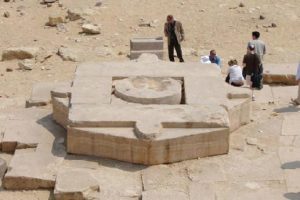
'Flower'? Archaeologists wonder why the switch from building pyramids to the sun gods - to temples of the sun gods beginning at Saqqara. 'Purification' {using 'water'} becoming paramount. ['Lost Treasures of Egypt' / S3 E2].
 N.B. 'Pigs' a link to the 'White Goddess' {i.e., sows}. In the ''underground'' sense of the word i.e., strong sense of smell - with nose 'close to the earth'. A universal concept. See R. Graves book.
N.B. 'Pigs' a link to the 'White Goddess' {i.e., sows}. In the ''underground'' sense of the word i.e., strong sense of smell - with nose 'close to the earth'. A universal concept. See R. Graves book.
And/or: A truffle is the fruiting body of a subterranean ascomycete fungus, one of the species of the genus Tuber....
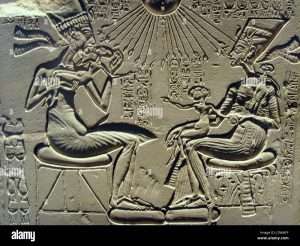
What are EACH sat on?
More than one hundred other genera of fungi are classified as truffles including Geopora, Peziza, Choiromyces, and Leucangium.[1] These genera belong to the class Pezizomycetes and the Pezizales order. Several truffle-like basidiomycetes are excluded from Pezizales, including Rhizopogon and Glomus.... Truffles are ectomycorrhizal fungi, so they are found in close association with tree roots. Spore dispersal is accomplished through fungivores, animals that eat fungi.[2] These fungi have ecological roles in nutrient cycling and drought tolerance
Truffles are ectomycorrhizal fungi, so they are found in close association with tree roots. Spore dispersal is accomplished through fungivores, animals that eat fungi.[2] These fungi have ecological roles in nutrient cycling and drought tolerance
Question. Prof. Pearson after studying with the local natives {Madagascar?} brings one of the 'elders' over to the UK for his opinion on Stonehenge. He is told that it represents the land of the dead/ancestors etc. Was he not told about that universal symbol of the 'river' - that represents a 'return journey' to the 'source' of something?
North to south or East to west?
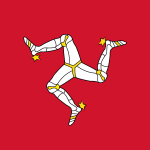
{One} example of: A triple aspect of something.
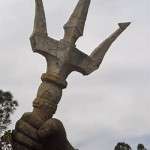 Refresher: Marden Henge {near Stonehenge} - recently discovered. Many times larger than Stonehenge. A definite link between 'it' and the river Avon: "The monument itself is only 'D' shaped {semicircle} - Its not a complete enclosure; in fact the whole of the southern side is formed by the river Avon. A great big meander in the river... And a number of springs within the henge as well." ['The Flying Archaeologist'. Enlarged elsewhere].
Refresher: Marden Henge {near Stonehenge} - recently discovered. Many times larger than Stonehenge. A definite link between 'it' and the river Avon: "The monument itself is only 'D' shaped {semicircle} - Its not a complete enclosure; in fact the whole of the southern side is formed by the river Avon. A great big meander in the river... And a number of springs within the henge as well." ['The Flying Archaeologist'. Enlarged elsewhere].
Side note: The spring of the river Avon - its source. Has a triple aspect to it. Purposely cut out - like a ''three legged animal''. Same program.
And/or: "This is an ancient bronze column, formed of three snake heads, the column being their bodies intertwined, unwinding into the heads that held aloft a great bowl, in classical Greece terms a great tripod, the word "tripod" coming from the Greek meaning "three-footed", used for making offerings or other ritual procedures to the Greek Gods. This ancient sacrificial tripod, originally came from Delphi, later relocated to Constantinople by Constantine I the Great in 324. Along the sides of the column are inscribed the names of more than 24 Greek city states, Greece at the time being no nation, but a land of cities sharing variations of classical Greek culture and religion."
Question. What does ''twentyfour'' represent. Try 'Mystery of Numbers'.Then ''tripod'' / ''trident''.
Try ''twentythree'' to get closer.
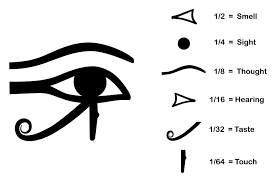
The 'stone' that David used to subdue Goliath {lower aspect} - in the 'middle' of the forehead. New Name? And/or: Seti the 1st began the most important building in Egypt: the Hypostyle Hall at Karnac - but it was his son Ramesses that finished it. David began the temple. Solomon finished it. Anything? Amun to Amun-Ra. Something that was once ''hidden'' has now a 'known' value. Question. Quantity or quality?
And/or: ''Sharata and Mesartim {stars in Aries} constitute the twentyseventh nakshatra - the Ashwins, or Horsemen...The Two Horsemen correspond to the Gemini of Rome, but figured as a horse's head. About 400 years before our era this superseded Krittika as leader of the nakshatras...Mesartim {i.e.,a northern binary star represented with the glyph {'Y'}}...has been called the First Star in Aries - as at one time nearest to the equinoctial point...AND/OR....El Nath - 'the butting one' - on the tip of the northern horn {of Hyades}. This title also appears for Aries and its star Hamal...one of the Hyades according to Whitall, is Ain, from the Arabic 'Ain', the eye, - the northern eye..." [Page 82/390-391 'Star Names Their Lore and Meaning'].
''Tripods'' within Homer's Illiad?
'Fire' link.
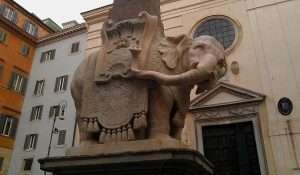

The Spanish word for shell is concha, commonly translated into concho. It’s thought that these jewelry adornments acquired their name from resembling shells.
The Navajo people have a long and vibrant history which is still visible today in their culture and art. Their jewelry is particularly noteworthy, as the unique artistry found in traditional items such as concho belts has been passed down through generations.
Concho belts are one of the most iconic pieces of Navajo jewelry, and they tell an insightful story of the culture and its evolution. When describing the development of concho belts, most historians use phases to describe how concho belts evolved.
Side note: : Our sages likened the entire joining of the Supernal Universes to their Root to the joining of the Bridegroom to the Bride. This is “because in the image of God He made man” (Genesis 9:6).....Thus, all the parts of both the male and female body form the “image of God.” It is thus written, “God created man in His image, in the image of God He created them, male and female He created them” (Genesis 1:27) ....All this is because man and woman are literally a counterpart of the Divine. Between them man and woman have the letters of the Tetragrammaton (YHVH). If a couple is worthy, the Divine Presence rests between them, since he provides the yod of the Divine Name, and she provides the heh.
The holy Sabbath is likewise referred to as both a bride and a queen. We thus inaugurate the Sabbath with the song, “Come my friend to greet the Bride ...” We conclude by saying, “Come O Bride ...” {'The Lost Princess' / Rebbe Nachman}.
And/or: Question. Any connection to 'Y' HVH. While recalling none other than Abraham 'sacrificing' a 'ram' {'Y'} on top of a particular 'mountain' that became the foundation of the very first temple?
Apple of the eye?
Refresher: "Error runs down an inclined plane, while truth has to laboriously climb its way up hill". Question. What picture {symbol?} represents it?
A {practical} example: ''The road ahead will be long - the climb steep.'' [Election victory speech/ Barack Obama].
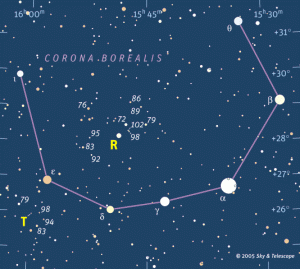
The Northern Crown.
Refresher..."Got to see it, rather than just read it..." John Humphrys talking to D. Tennant and Greg Doran in relation to the plays by W. Shakespeare. [400th anniversary. Radio 4. 23/04/16].
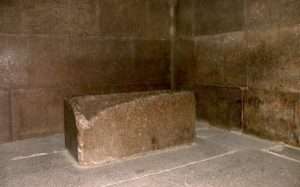
Beginning or end? Any lid?
Continued: A work in progress?...OR just a coincidence..."I asked the women to gather in the area along and in front of the wall and to sit comfortably there in a slight semi circle. Then i asked all the men to stand just in front of the women in a straight line, from edge to edge of the wall. We were now arranged in the shape of a long, shallow, lidded bowl, with the women inside the bowl, and the men forming the lid." ['Serpent of Light Beyond The 2012']. Try ''lid'' and/or ''bowl''.
Tower in relation to 'Temple'?
Side note: "The dry, sere landscape of rocks and sand lies in a small valley between the Theban Hills, dominated by the pyramid shaped mountain. Ancient Egyptians called Ta Dehent, indicating the top of the forehead or the third eye. Modern Egyptians have named it Al Qurn, the horn."
Unicorn?
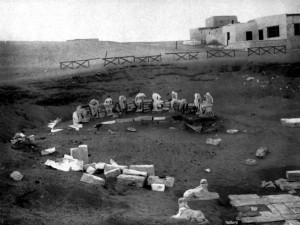
Semicircle of Greek sages {'perennial' philosophers?} - guarding the 'tomb' of Nectanebo 2nd. Central figure = Homer. Some link the same with Alexander - the 13th god. Question. Where would the 'other half' be represented? {'feminine' aspect?}. Clue. Recall Homers epics - what story did they tell? Enlarged elsewhere. Pleiades/Hyades?
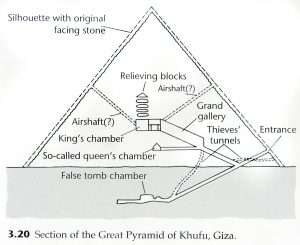
Off 'center'?
Analogy from a different perspective {i.e., different author{s} from a different time period} but the principle = the same?... "The question that Coomaraswamy set himself was stated on the first page of his transcript: 'The fundamental question to be asked will be at what is the {Sagittarian} archer shooting?' When i read this knowing the Sagittarian archer points his arrow right at the Galactic Center, i could scarcely believe what Coomaraswamy had written. The same paragraph emphasizes, however, that whatever astronomical references may be present, the mythological {or metaphysical} meaning is what will be of interest. In other words, Coomaraswamy intended to explore the metaphysical process of 'transcendence' as it relates to the mythology of Sagittarius rather than belabour any implied or demonstrated astronomical features." ['Galactic Alignment' / J. Jenkins].
Egyptian link = ‘Field of arrows’. [ Chasing mummies program ]...Link to [C]. Mr Sitchin calls the same "land of missiles". [see below ].
Symbolic of that inner ’combat’. For a comparison of the same but from two different ‘view points’ and its possible relevance within that overall framework. ‘Temple of/in man’. By R. Schwaller De Lubicz... and ’Zen in the art of Archery’. By E. Herrigel.
 Use that process {above} to define ''objectiveness'' and its purpose {and representation?} within subject material: i.e., as ONE example: "This would be to our great loss, for the symbolizing of the church points to a depth of art which has almost disappeared from our world. It points indeed to an 'esoteric art', an objective art, which is mentioned scarcely at all in our official histories of art, and is only remembered in a handful of occult texts largely unknown to historians." ['The Secret Zodiac'].
Use that process {above} to define ''objectiveness'' and its purpose {and representation?} within subject material: i.e., as ONE example: "This would be to our great loss, for the symbolizing of the church points to a depth of art which has almost disappeared from our world. It points indeed to an 'esoteric art', an objective art, which is mentioned scarcely at all in our official histories of art, and is only remembered in a handful of occult texts largely unknown to historians." ['The Secret Zodiac'].
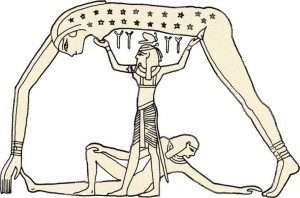
'Space' created to be objective: "Blue-lidded lady of the dawn, carrier of her fathers wisdom, let this old one rest in your arms." [Day seven: The Temple of Hathor at Denderah' from the book 'Invoking the Scribes of Ancient Egypt'].

Divided into thirtytwo plots. "The EYE of the swamp" mentioned.
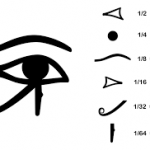
"EYE LEVEL"? An objective eye? Above or below the horizon line?
'On Having No Head: Zen and the Rediscovery of the Obvious' / D. E. Harding.
Follow the title of the book to 'see' Astrology/Astronomy in the esoteric {objective?} sense of the word.
Side note: In the swamp on Oak Island is found a ramp {"a foot or two below sea level"} that connects the 'paved' area {N/E} with the stone {'cobbled'?} path {begins in the S/E corner}, i.e., above sea level. {'The Curse of Oak Island' / S10 EP19}.
Wet / Dry. From darkness into the light.
Right angles?
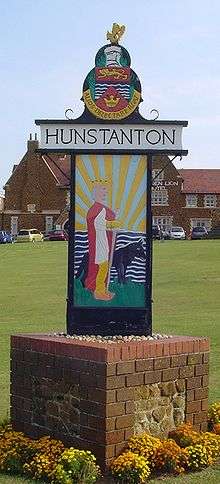
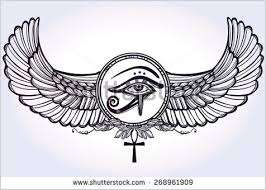
An objective eye: "The word 'mystery', comes down from the greeks...It is linked to the Egyptian word 'mes' meaning birth. The mystery of Horus is the story of his birth as a lame child and his transformation into the heroic warrior who battles chaos and learns to reconcile opposition. ...The Greeks also have have resonances with the Edfu mystery plays in which the initiate must catch a pig and 'sacrifice' it.....Edfu is the spot where Horus has to confront the Sethian aspect of himself to regain order and balance"....And/or: "The energy that is associated with the temple Edfu resonates strongly in my second chakra." Page 101/2 'Invoking the Scribes of Ancient Egypt'].
A {working?} example: "Do such works of objective art {'Lohan'?} exist at the present day,'' i asked. ''Of course they exist,'' answered G. ''The great Sphinx of Egypt is such a work of art, as well as some historically known works of architecture, certain statues of gods, and many other things. There are certain figures of gods and various mythological beings that can be read like books, only not with the mind but with the emotions, provided they are sufficiently developed...At all events, we grasped the meaning of what they wanted to convey to us across thousands of years, and not only the meaning, but all the feelings and the emotions connected with it as well. That indeed was art." ['In Search of the Miraculous']. Try ''Sphinx''.
Side note: For centuries Turquoise has been recognized as possessing the power to protect riders from injury due to falls. First used as amulets by Turkish soldiers, on their persons and attached to their bridles and trappings, it later came to be used for protection against falls of any kind. [Kunz, 109] Turquoise is also reputed to be influenced by the physical condition of the person who wears it. It is thought to grow pale when its owner is sick or sad, lose all color when the person dies, and gradually recover its color when transferred to a new healthy owner, its color deepening each day.
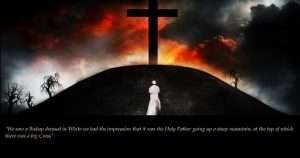
Isis (called "Aset" by the Egyptians), a daughter of Nut and Geb, is known in Ancient Egyptian mythology as a goddess of magic. Wife and sister of Osiris, Isis was originally considered a funerary goddess. After her resurrection via magic of Osiris, who had been killed by his brother Set, Isis was considered "more powerful than a thousand soldiers" and "the clever-tongued one whose speech never fails." She is sometimes invoked as an assistant in magical rituals in some traditions of contemporary Paganism. Her worship is also a focus of some Kemetic reconstructionist groups.
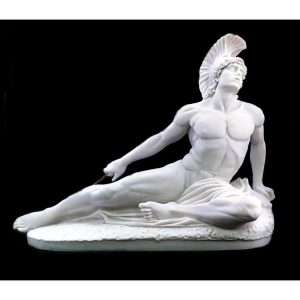
The death of Achilles.
Side note: "The men of Will, volitive or liberal, consider things only as isolated facts without any connection, seeing in man only man, in a king only a king, in a magistrate only a magistrate, without admitting as a thing existing by itself, either humanity or royalty or magistracy. These terms offer them only an abstract idea which is not attached to real existence. If they utter the word royalty, for example, they do not understand a thing pre-existent to a king, determining it to be a royal potentiality, but only a thing which issues from this being and which is designated as the dignity, pure and simple. Thus for them the king exists before royalty and creates it. Royalty is therefore only an abstraction and the king a fact, which when it is recognized as such by the people, in whatever manner, becomes legal.
But the prophetic men see all this in another manner: they admit universals, which the volitive men reject; and consider things not as isolated facts, but as links of a chain, which, without being the chain itself, yet constitute it. For them humanity, royalty, magistracy are things which they conceive as pre-existent to men, kings, magistrates, and placed by Destiny to determine the necessary existence. In the same manner, for example, as one can conceive that an army, when it is decreed with power of being, will necessarily involve the existence of a certain number of soldiers. These soldiers will not be isolated facts considered as soldiers, but facts co-ordinated to this end, of forming a whole which results from them if one wishes it, but from which also results, if one considers it as one ought, the primordial and creative idea which has decreed the army." {Page 496 'Hermetic Interpretation of the Origin of the Social State of Man'}.
'Golden chain'?
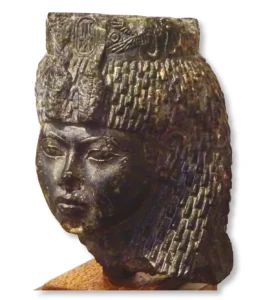
Smith or Jones?
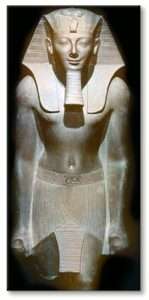
Spirit or soul?
Continued: The temple of Serabit el-Khadim is located on a plateau on top of a mountain in south-west Sinai. From earliest dynastic times, pharaohs sent expeditions to Sinai in search of turquoise and copper, and abundant seams of turquoise were found in the Serabit region. Hathor had the epithet ‘Lady of Turquoise’, so it is no surprise to find a temple dedicated to Hathor near the mine workings....The temple is compact, about 70m long by 35m wide, but full of stelae erected along its processional routes. Although the temple that we see today was started by Senusret I, Petrie reports finding the breast and back of a stone falcon, inscribed with the cartouche of Sneferu, which he thought dated to that king’s reign (c.2613-2589 BC). This would make it the earliest object found at the site, but Gardiner (1955) describes this dating as ‘very suspect’. It is probably a later piece on which the cartouche of Sneferu was written to celebrate his memory.
Forgetting/Remembering.
'Ancestors' to enlarge.
 Petrie also found a small head of green steatite {soap stone}. It is only 7cm high, but would have been part of a statuette, around 30cm tall, dedicated to Hathor. The cartouche on the forehead identifies Queen Tiye, wife of Amenhotep III. The head’s features follow the artistic principles of that time, with almond-shaped eyes and a thin nose. The down-turned mouth is often seen in portrayals of Tiye, and has led to her reputation as a tough character. Petrie writes of the ‘haughty dignity of the face’ and how the expression is one of ‘disdain without malice’. ['Page 52 'Ancient Egypt' - Nov-Dec 2024].
Petrie also found a small head of green steatite {soap stone}. It is only 7cm high, but would have been part of a statuette, around 30cm tall, dedicated to Hathor. The cartouche on the forehead identifies Queen Tiye, wife of Amenhotep III. The head’s features follow the artistic principles of that time, with almond-shaped eyes and a thin nose. The down-turned mouth is often seen in portrayals of Tiye, and has led to her reputation as a tough character. Petrie writes of the ‘haughty dignity of the face’ and how the expression is one of ‘disdain without malice’. ['Page 52 'Ancient Egypt' - Nov-Dec 2024].

"The phrase “hot on the heels” means in close pursuit of someone or something, or immediately after some event1. It originates from hunting terminology, where the “on the heels” part refers to a hunter’s literal closeness behind their quarry.” Cain and Able?

'Spirit' or 'Soul'? Male or female feet.
Tibetan Turquoise, or Chinese Turquoise, is green and carries a slightly different vibration than the more vivid blue. It is especially useful for clearing the Throat Chakra, and blockages of suppressed self-expression.
Speech?
Taurus?
Continued: {One} example: Oedipus and the riddle of the Sphinx {Thebes} - in relation to the Sphinx of Giza. {One} relates more to Male {androgynous} the other 'female'. {One} to spirit, the other soul. {One} to anima the other animus. Which and why? ['Mythology' {The Royal House of Thebes} / Edith Hamilton].
"What creature'', the Sphinx asked him, ''goes on four feet in the morning, on two at noonday, on three in the evening?''
Question. Where would the 'zenith' of something be represented in landscape symbolism?
"De Lubicz's work was interdisciplinary, and well grounded in the knowledge of ancient traditions. Like a cryptologist, he recognized that elements of the Sacred Science have always been with us, but as is typical of the modern mind, we have classified them in Aristotelian categories - as history, science, mythology, and occultism. Though the study of each is a dead end for understanding the great achievements of Egyptian civilization, when taken together they present a compelling picture of human {'man' / woman} potential." [Chapter one, 'The Sacred Tradition of Ancient Egypt'. Italics/parenthesis, this readfers]. Try ''gather''.
"The task of the scholar of esoteric studies is not to prove that such an invisible 'tradition', hidden behind the veil of historic events, did or did not exist; as such; before the Renaissance; rather, the task consists of trying to grasp and to describe the different facets of the emergence of this idea as it appears in the imaginary and the discourses of the last centuries [and/or millenniums. This readers input]. Quote by A. Faivre.
"For everyone who asks receives, and he who seeks finds, and to him who knocks it will be opened." New Testament.
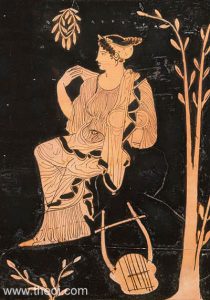 "Astrology is the progenitor of astronomy, and for many years the two existed as one science. Nowadays astronomy is considered an ''objective'' science of distances, masses,, speeds, etc., while Astrology is a "subjective" and intuitive science which not only deals with the astronomical delineation of horoscopes, but can also be called a philosophy which helps to explain the spiritual essence of life." [Extract taken from the book by Cicero]. Think about it in relation to the word 'synchronicity'...in relation to a 'framework'. i.e.,
"Astrology is the progenitor of astronomy, and for many years the two existed as one science. Nowadays astronomy is considered an ''objective'' science of distances, masses,, speeds, etc., while Astrology is a "subjective" and intuitive science which not only deals with the astronomical delineation of horoscopes, but can also be called a philosophy which helps to explain the spiritual essence of life." [Extract taken from the book by Cicero]. Think about it in relation to the word 'synchronicity'...in relation to a 'framework'. i.e.,
'On Having No Head: Zen and the Rediscovery of the Obvious' / D. E. Harding.
"Astrology is a form of imagination emerging from nature and having direct relevance for everyday life. It is an applied poetics, a vision of life on earth stimulated by movements in the heavens {'Royal Way'?}, which can take us into areas of self reflection as no other system of symbols and images can {Homers Illiad?}...Learning astrology is very similar to embarking on an apprenticeship. Astrology is a practical craft which cannot be mastered 'with the head' only. We each need to find our own unique relationship to astrology and our hard work is repaid when we find ourselves tapping into the living astrological tradition {'mindset'?} - at which point the subject, and each chart we study, begins to come alive for us..." [Intro. to the book 'Mapping the Psyche' / C. Martin].
''Mindset'' = Anthropology ?
 "There are in reality two branches of Astrology. The first is Exoteric Astrology which includes the mathematics of the art involved with charting a horoscope and the predictive arts. The second is Esoteric Astrology which deals with mysteries of the universe itself, the spiritual, moral, intellectual and physical dynamics of the cosmos. Esoteric Astrology reveals the universal pattern ['net' symbolism] of living, and the means by which human beings can align themselves with the spiritual fabric and 'pattern' of the universe. It is a system for understanding celestial energies and a method for viewing the universe as a symmetrical whole." [Same book].
"There are in reality two branches of Astrology. The first is Exoteric Astrology which includes the mathematics of the art involved with charting a horoscope and the predictive arts. The second is Esoteric Astrology which deals with mysteries of the universe itself, the spiritual, moral, intellectual and physical dynamics of the cosmos. Esoteric Astrology reveals the universal pattern ['net' symbolism] of living, and the means by which human beings can align themselves with the spiritual fabric and 'pattern' of the universe. It is a system for understanding celestial energies and a method for viewing the universe as a symmetrical whole." [Same book].
''The mind is more like a butterfly, to be caught in a gossamer web {'net'?} rather than a hard steel trap.'' [Page 130 'The Path Through the Labyrinth' / M. Green].
And/or..."Astrological determinism was immensely popular in the ancient world. Gnostic's were however, at pains to emphasize that the stars are not the cause of events here on earth, but rather archetypal patterns in the heavens which correspond to events on earth, and so help us to understand the ebb and flow of fate. The Christian gnostic Theodotus writes that the stars 'are not the cause of things, but a sign of what is taking place'. " [From the book by T. Freke and P. Gandy]. Try ''archetypal''.
Tidal / non-tidal?
'The Secret Zodiac: The Hidden Art in Mediaeval Astrology' by Fred Gettings.
"The joy of good conscious is the accord between the moral rhythms of the 'lower' and 'higher' self. The beatitude [Matthew v,8] promising those who have a pure heart that they will 'see' god - signifies the accordance of their basic rhythm with the 'divine' rhythm. Joy is therefore the state of harmony of the inner/outer rhythms - of rhythm below with that of above..." [Extract from the book by Tomberg]. Together with...
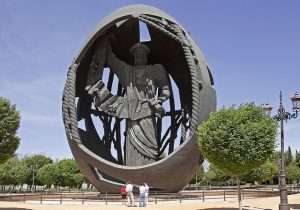
''The Birth of the New Man.'' 'Egg/Incarnation' to enlarge
"Because each of the constellations of the zodiac spends 6 months of the year below the horizon and 6 months above it, the zodiac was also seen as representing the wheel of reincarnation, which carries each individual through a recurring cycle of life and 'death'. " [From the book by T. Freke and P. Gandy].
'Horus; in/of the horizon' ?

Good or bad?
A practical example: ''Sometimes people are mean to me or stuff goes wrong. Then i get mad. When i get annoyed i go into a different version of me. In my bad version, it's like me wanting to be horrible, but in the good version of me, i want to take away the bad version - but the bad version keeps fighting back.'' [Kai / 'Dispatches: Growing Up Poor: Britain's Hidden Homeless Kids' / Channel 4 / 25.10.21].
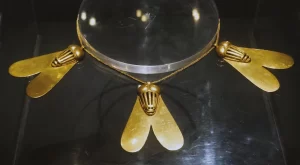 Astronomical equivalent {the very first representation?}: "The path of Jupiter never strays far from the ecliptic, and Homer faced a challenge when he had to express Athene's affection for or assistance to the warriors Achilles, Odysseus and Diomedes, whose personal stars lie at a good distance outside the zodiac. In the case of Achilles {Canis Major}, Homer says, that Athene supports him 'from afar', or that of the others 'that no man could see her'.{Therefore not within ''a line of sight''?}. When she 'moves up close' to Odysseus {Bootes}, Jupiter lies in the zodiac below his feet.
Astronomical equivalent {the very first representation?}: "The path of Jupiter never strays far from the ecliptic, and Homer faced a challenge when he had to express Athene's affection for or assistance to the warriors Achilles, Odysseus and Diomedes, whose personal stars lie at a good distance outside the zodiac. In the case of Achilles {Canis Major}, Homer says, that Athene supports him 'from afar', or that of the others 'that no man could see her'.{Therefore not within ''a line of sight''?}. When she 'moves up close' to Odysseus {Bootes}, Jupiter lies in the zodiac below his feet.
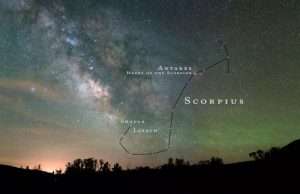
The tail end of the ''stinger'' = two swimming ducks.
In another instance Athene needs to move into the zodiac south of Perseus, whose feet only just reach into the zodiac, so she can hear Diomedes prayers. HOWEVER, Athene, has no difficulty when involved in the affairs of warriors whose stars and constellations lie IN the zodiac. As Jupiter travels through the broad shouldered and long legged constellation of Scorpius, Athene's infusion of fighting spirit into Menelaus is described with the well known simile of the fly: ' Therefore she put strength into his knees and shoulders and made him as bold as a fly, which, though driven off will yet come again and bite if it can'. On other occasions she assumes the voice or form of a mortal when Jupiter 'occults' or temporarily covers a star." {'Homer's Secret Iliad'].
Gadfly?

Hunter or hunted?
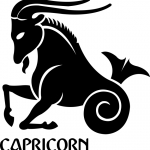 From a different perspective: ''The first time the spear pierced Ysbaddaden through the ball of his knee and he cries: 'Like the sting of a gadfly the poisoned iron has pained me.' The second time it pierced in the middle of his breast: 'Like the bite of a big-headed leech the iron has pained me'....The 3rd time Culhwch himself hurled it back...pierced through the ball of the eye: 'Like the bite of a mad dog'....the kind of animal used later to hunt the terrible boar.'' [Page 62 'A Celtic Quest' / J. Layard].
From a different perspective: ''The first time the spear pierced Ysbaddaden through the ball of his knee and he cries: 'Like the sting of a gadfly the poisoned iron has pained me.' The second time it pierced in the middle of his breast: 'Like the bite of a big-headed leech the iron has pained me'....The 3rd time Culhwch himself hurled it back...pierced through the ball of the eye: 'Like the bite of a mad dog'....the kind of animal used later to hunt the terrible boar.'' [Page 62 'A Celtic Quest' / J. Layard].
'Ysbaddaden' = giant/hawthorn links.
Question. What do 'shoulders' and 'knees' represent?
''A gadfly is a person who interferes with the status quo of a society or community by posing novel, potentially upsetting questions, usually directed at authorities. The term is originally associated with the ancient Greek philosopher Socrates in his defense when on trial for his life...Also a fly that bites livestock, especially a horse fly, a warble fly, or bot fly.''
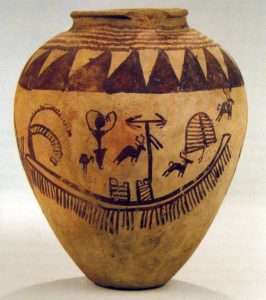
When the north wind blows. Heading south? East and west spear pointers?

'flat'?
And/or: ''Housman offered a secondary test of true poetry: 'everything that reminds me of her goes through me like a spear' {''Tip/wounded'' link?}. This is equally pertinent to the Theme.....The THEME, briefly, is the antique story, which falls into thirteen chapters and an epilogue of the birth, life, death and resurrection of the God of the Waxing year; the central chapters concern the gods losing battle with the god of the Waning year for 'love' of the capricious and all powerful Threefold Goddess {soul}….The poet identifies himself {spirit} with the god of the Waxing year and his Muse {'anima'} with the Goddess; the rival is his blood brother {'shadow'}, his other self, his weird....'' [Page 24 'The White Goddess' / R. Graves].
And/or: ''And thus it was, the fourth age of Middle Earth began. And the Fellowship of the Ring, though eternally bound by friendship and love was ended. Thirteen months to the day, since Gandalf sent us on our LONG journey - we found ourselves looking upon a familiar sight. We were home.'' ['The lord of the Rings: Return of the King'].
Neville Longbottom.
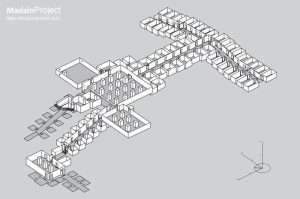
Belonging to the ''Sons of'' Ramses. The largest in the valley.
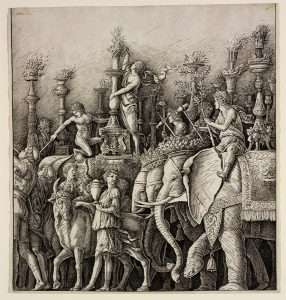
'light oxen': "A marsh is — according to ecological definitions — a wetland that is dominated by herbaceous rather than woody plant species."
A working example: ''In the sandstone relief at Abydos of the Temple of Ramses II - the Nile god Hapi appears as a long haired hermaphrodite...bent down on one knee, holding in his hands the flowering lotus and papyrus...Who floods the fields to nourish all those who thirst....They seem to say that when the waters of the unconscious rise toward the realm of consciousness {wet/dry'?}, then we have come to our time of renewal...Dawn always begins in the BONES.....The search for higher ground {'twentythree'?} may be metaphoric for the search of a higher spirituality.'' [Pages 124-130 'Dreams of Isis' / N. Ellis].
'Mountains low. Valleys high'.
Karnac to Gebel el Silsila.
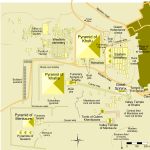
Which is more or less - ego?
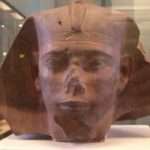 A working {practical} example: "We always hope for the best - and of course we should to a certain extent - but we should also {counterbalance} prepare ourselves for the worst. And that is the realistic approach. Hope for the best, prepare for the worst which allows that balance of mind to emerge {in the moment}. Because we then start to accept that we cant have total control over everything. That is the beginning of wisdom. To be able to embrace happiness and suffering in one taste. Not just having happiness and avoiding suffering. Which is what ones personal ego would say." ['Beyond Philosophy: What is Samsara' / Mirthy].
A working {practical} example: "We always hope for the best - and of course we should to a certain extent - but we should also {counterbalance} prepare ourselves for the worst. And that is the realistic approach. Hope for the best, prepare for the worst which allows that balance of mind to emerge {in the moment}. Because we then start to accept that we cant have total control over everything. That is the beginning of wisdom. To be able to embrace happiness and suffering in one taste. Not just having happiness and avoiding suffering. Which is what ones personal ego would say." ['Beyond Philosophy: What is Samsara' / Mirthy].
Side note: ''Mark adds that at the time of his writing, "...in worship of St John the Baptist, men stay up at night and make three kinds of fires: one is of clean bones and no wood and is called a "bonnefyre"; another is of clean wood and no bones, and is called a wakefyre, because men stay awake by it all night; and the third is made of both bones and wood and is called, "St. John's fire" (Festial 182)." These traditions largely ended after the Reformation, but persisted in rural areas up until the 19th century before petering out.[61]
And/or: ''The 13th-century monk of Winchcomb, Gloucestershire, who compiled a book of sermons for Christian feast days, recorded how St. John's Eve was celebrated in his time:
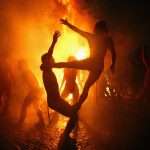
Eternal 'Triangle'?
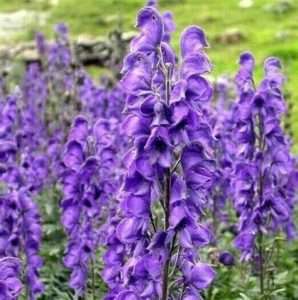
Aconitum napellus, monkshood,[2] aconite, Venus' chariot or wolfsbane, is a species of highly toxic flowering plants in the genus Aconitum of the family Ranunculaceae, native and endemic to western and central Europe. It is an herbaceous perennial plant growing to 1 m (3 ft 3 in) tall, with hairless stems and leaves. The leaves are rounded, 5–10 cm (2.0–3.9 in) diameter, palmately divided into five to seven deeply lobed segments. The flowers are dark purple to bluish-purple, narrow oblong helmet-shaped, 1–2 cm (0.39–0.79 in) tall. Plants native to Asia and North America formerly listed as A. napellus are now regarded as separate species. The plant is extremely poisonous in both ingestion and body contact.
Saint John's Fires, explained the monk of Winchcombe, were to drive away dragons, which were abroad on St. John's Eve, poisoning springs and wells. The wheel that was rolled downhill he gave its explanation: "The wheel is rolled to signify that the sun then rises to the highest point of its circle and at once turns back; thence it comes that the wheel is rolled."[20]
''In Austria, the Midsummer solstice is celebrated each year with a procession of ships down the Danube River as it flows through the wine-growing Wachau Valley north of Vienna. Up to 30 ships sail down the river in line as fireworks erupt from the banks and hill tops while bonfires blaze and the vineyards are lit up. Lighted castle ruins also erupt with fireworks during the 90-minute cruise downstream.''
Madeira to enlarge.
Refresher: "Not out but through." C. Jung.

 Side note: "Banjo enclosures are, perhaps, one of the most distinctive types of enclosure known in the British landscape. They are relatively small in area, predominantly sub-circular in outline and are notably furnished with a single, markedly elongated, entrance passageway; this funnelled approach giving the ground plan the appearance of a banjo or frying pan. They were first categorised in Wessex and appear to concentrate in discrete clusters in some areas of Hampshire, Dorset, and Wiltshire. More recently, a number have been recorded in the upper Thames Valley and the Cotswolds in Oxfordshire and Gloucestershire. Away from these foci, banjo enclosures occur less frequently with isolated examples scattered across southern and central England and across west Wales. They are often confused with other classes of enclosures, particularly small examples of roughly round or square plan with antennae ditches extending from their entranceways, but these lack the lengthened entrance passageway apparent in banjos.....
Side note: "Banjo enclosures are, perhaps, one of the most distinctive types of enclosure known in the British landscape. They are relatively small in area, predominantly sub-circular in outline and are notably furnished with a single, markedly elongated, entrance passageway; this funnelled approach giving the ground plan the appearance of a banjo or frying pan. They were first categorised in Wessex and appear to concentrate in discrete clusters in some areas of Hampshire, Dorset, and Wiltshire. More recently, a number have been recorded in the upper Thames Valley and the Cotswolds in Oxfordshire and Gloucestershire. Away from these foci, banjo enclosures occur less frequently with isolated examples scattered across southern and central England and across west Wales. They are often confused with other classes of enclosures, particularly small examples of roughly round or square plan with antennae ditches extending from their entranceways, but these lack the lengthened entrance passageway apparent in banjos.....

 Very few banjo enclosures survive in earthwork form; the majority are known from aerial photography and can be seen as crop- or soilmarks. They are usually found on hill slopes, valley sides or at the heads of now dry valleys and occur as isolated sites, as pairs, and occasionally in larger groups – banjo landscapes. The results of fieldwork at sites in Wiltshire and Dorset suggest that those individual enclosures grouped in multiple arrangements were contemporary with each other. Often, particularly so in examples with irregularly shaped enclosure boundaries, the passageway and ‘front’ of the enclosure are better defined than the remainder of the circuit, illustrating a concern with the main approach to the enclosure and a desire, perhaps, to create a more impressive and monumental façade.....Circular hand hewn storage pits - cut into the chalk - are frequently found." ['Historic England' / internet].
Very few banjo enclosures survive in earthwork form; the majority are known from aerial photography and can be seen as crop- or soilmarks. They are usually found on hill slopes, valley sides or at the heads of now dry valleys and occur as isolated sites, as pairs, and occasionally in larger groups – banjo landscapes. The results of fieldwork at sites in Wiltshire and Dorset suggest that those individual enclosures grouped in multiple arrangements were contemporary with each other. Often, particularly so in examples with irregularly shaped enclosure boundaries, the passageway and ‘front’ of the enclosure are better defined than the remainder of the circuit, illustrating a concern with the main approach to the enclosure and a desire, perhaps, to create a more impressive and monumental façade.....Circular hand hewn storage pits - cut into the chalk - are frequently found." ['Historic England' / internet].
Hewn / Unhewn.

Found at Pylos. Close to the Griffin warrior tomb. Banjo shape?
 And/or: "Not used as a rubbish pit. Once the grain is taken out a whole range of artefacts are put back in. Not random waste but a deliberate selected list of items: bones of horse, cow and sheep together with large slabs of pottery...Its seems symbolic .....as though once the pit is emptied it has to be refilled, perhaps as an offering to the gods. In one pit - an adult male laid face down on a bed of meat {cow bones}. All UNDERNEATH him. Looks like he's been ROLLED IN. Legs tangled up - seems like there's no ORDER to it. At least to our conventional eyes." ['Digging For Britain' / S1 EP1].
And/or: "Not used as a rubbish pit. Once the grain is taken out a whole range of artefacts are put back in. Not random waste but a deliberate selected list of items: bones of horse, cow and sheep together with large slabs of pottery...Its seems symbolic .....as though once the pit is emptied it has to be refilled, perhaps as an offering to the gods. In one pit - an adult male laid face down on a bed of meat {cow bones}. All UNDERNEATH him. Looks like he's been ROLLED IN. Legs tangled up - seems like there's no ORDER to it. At least to our conventional eyes." ['Digging For Britain' / S1 EP1].
PRONE.
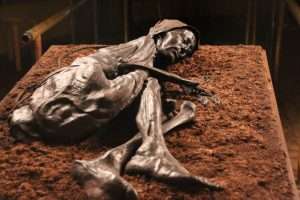
Bog = fen = 'altar'? All bog bodies found in S/E - N/W alignment?
'Twisted' / 'Narrow' to enlarge.
'Decommissioned' versus ......?
Higher/lower.
N.B. The Lindow bog man also in a prone position.
Question. What was his 'hat' made from?
Refresher: "Not out but through."

Tau cross shape? 'Fortysix' bone bodies within {i.e., skeletons}.
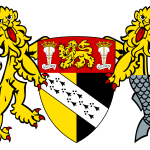
Red tongues? {Norfolk}.
Continued: From a different perspective: ''But, the most popular legend is about the West Kennet Long Barrow ghost, He is a man dressed in white robes with his hound. Apparently, if you visit the tomb on a Midsummer’s Day sunrise, you can find the white-robed man standing on top of the barrow. A huge hound sits at his feet with red ears. They stand silently, waiting and watching until the sun rises. Then, once it’s risen, they turn in unison to go back inside the tomb. Many farmers swear to it!....
'Shadow/light'.....
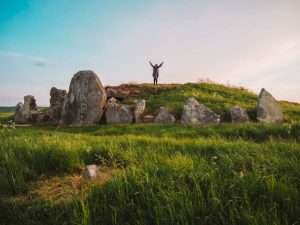
Any dogs? Green tongued?
Once you reach the top of the hill, you’ll get amazing views all over Avebury and you can see Silbury Hill in the distance – Wiltshire’s very own pyramid! [Sophie: 'Third Eye Traveller' / internet].
'Line of Sight' as a means.....?

And/or: ''Saint John's Day, the feast day of Saint John the Baptist, was established by the undivided Christian Church in the 4th century AD, in honour of the birth of the Saint John the Baptist, which the Gospel of Luke records as being six months before Jesus.[13][14] As the Western Christian Churches mark the birth of Jesus on December 25, Christmas, the Feast of Saint John (Saint John's Day) was established at midsummer, exactly six months before the former feast....By the sixth century, this solar cycle was completed by balancing Christ's conception and birth against the conception and birth of his cousin, John the Baptist. Such a relationship between Christ and his cousin was amply justified by the imagery of scripture. The Baptist was conceived six months before Christ (Luke 1:76); he was not himself the light, but was to give testimony concerning the light (John 1:8–9). Thus John's conception was celebrated on the eighth kalends of October (24 September: near the autumn equinox) and his birth on the eighth kalends of July (24 June: near the Summer solstice). If Christ's conception and birth took place on the 'growing days', it was fitting that John the Baptist's should take place on the 'lessening days' ('diebus decrescentibus'), for the Baptist himself had proclaimed that 'he must increase; but I must decrease' (John 3:30). By the late sixth century, the Nativity of John the Baptist (24 June) had become an important feast, counterbalancing at midsummer the midwinter feast of Christmas.
— Professor Éamonn Ó Carragáin, University College Cork

64 objective aspects. Good or bad?
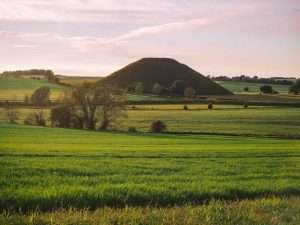
Silbury Hill: 'Truncated'?
Within Christian theology, this carries significance as John the Baptist "was understood to be preparing the way for Jesus", with John 3:30 stating "He must increase, but I must decrease"; this is symbolized in the fact that the "sun begins to diminish at the summer solstice and eventually increases at the winter solstice."
Galadriel?
From a different perspective: ''Shortly AFTER THE MONSOONS arrive on the Colorado Plateau and the Katsinam depart for their home on the San Francisco Peaks.....Orion rises due East to repose for a few moments on the horizon....the belt hovers vertically above the dark silhouette of the sleeping land {i.e., an hour before the sun in early July and three hours before by late July}.'' [Page 44 'The Orion Zone'].
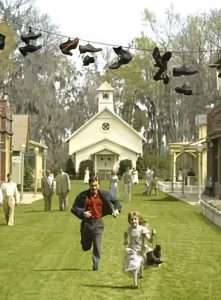
Friend. What happened to you're shoes? They kinda got ahead of me."

Siberia means ''sleeping land.''
And/or: If you are struggling to sleep Dr Gupta has this advice. “The big one is trust. We need to trust our sleep. The whole process of falling asleep is completely passive, even the language is to fall asleep. If sports got hold of it we would jump into sleep or something similar, but we don’t, we fall asleep. It’s passive, make a decision and allow it to happen – although sometimes its easier said than done.
“It’s human nature that we want to control our sleep, we want it to happen when we want it to, as opposed to taking time to work with it and understand it.
"Sleep is part of us and is programmed in us, wired to happen on its own accord and getting in the way of it is what makes it fall down. "The key is to trust your sleep to do its thing for you."
'137'?

Titania is a character in William Shakespeare's 1595–1596 play A Midsummer Night's Dream. In the play, she is the Queen of the fairies and wife of the Fairy King, Oberon. The pair are depicted as powerful natural spirits who together guarantee the fertility or health of the human and natural worlds.

Common factors?
Side note: ''Hieroglyphs mean 'holy writings', they are drawn on papyrus - the first paper in the world. The hieroglyph named Thoth holds the papyrus reed, because he was the person who introduced writing into the world. Other aspects = the head of the Ibis bird {which live among the reeds}, with long curved narrow beak, and pink feathers." [Page 21 'The Ancient Secret of the Flower of Life' / D. Melchizedek].
Bamboo Reed of the Hopi culture? [Page 14/15 'The Orion Zone' / G. A. David].
Thoth a link to Mercury - the planet that is very grey. Not known why until relatively recently - when it was discovered to contain large amounts of carbon and crystalline graphite from which such writing tools as pencils are made. Coincidence?
Gandalf the Grey.

Folded or unfolded?
Side note: On his 'return' journey home Odysseus finds himself on the island of Circe: ''Set me in a bath to be bathed with 'water' from the great cauldron, being mixed to my liking, - then being poured over my head and shoulders {strength returning?}. Eventually to be sat ''on a silver studded chair in the hall''.
 "Seat of First Occasion"? {i.e.,but in the UNmanifested sense of the word}?
"Seat of First Occasion"? {i.e.,but in the UNmanifested sense of the word}?
N.B. Saturn is 'ruler' of the human skeleton {knees?}.
Refresher: "Dawn begins in the bones"
Valley of the monkeys?
Question 2. What does it all represent? Why should it represent anything at all? Fable only?
N.B. Up to the 'battle' = Ten years. 'Return journey' = another 10 years. Question. What does 20 represent? A result of what?
Mostly 'males' up to the battle. 'Females' thereafter. Coincidence?

Found at Abydos. Question. What lies beyond after a 90 degree turn?
REFRESHER: ''Nineteen to begin with is an incomplete twenty, but is also a sacred number in the Near East...For medieval exegetes in the west, it combined the 12 signs of the zodiac with the 7 planets....'' ['The Mystery of Numbers' / Annemarie Schimmel].
What was the first island that Odysseus landed on his 'return' journey?
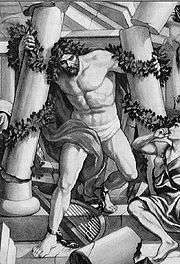 ''In 869 at the Eighth Ecumenical Council, the Church effectively closed the door to the spirit worlds by abolishing the ancient distinction between the vegetable dimension of the soul and the animal dimension of the spirit.'' [Page 343 'The Secret History of the World'].
''In 869 at the Eighth Ecumenical Council, the Church effectively closed the door to the spirit worlds by abolishing the ancient distinction between the vegetable dimension of the soul and the animal dimension of the spirit.'' [Page 343 'The Secret History of the World'].
Faith and hope only?
ONE working example {in the spiritual sense of the word}: ''Of all the gopis, Radhika, or Radha, because of her intense love for Krishna, was the closest to him. She manifested mahabhava and was united with her Beloved. This union represents, through sensuous language, a super sensuous experience...The Vaishnava scriptures advise one to propitiate Radha and obtain her grace {anima link} in order to realize 'Sri Krishna'. So the tortured devotee now turned his prayer to her. Within a short time he enjoyed her blessed vision. He saw and felt the figure of Radha disappearing into his own body....Her complexion was light yellow. Now one with Radha, he manifested the great estatic love, the mahabhava, which had found in her its fullest expression. Later Sri Ramakrishna said: 'The manifestation in the same individual of the NINETEEN different kinds of emotion for god is called in the books of bhakti, mahabhava. An ordinary man takes a whole lifetime to express even a single one of these.'' [Page 24/5 'The Gospel of Sri Ramakrishna'].
Distinction between East and West. The above a 'teaching/method' of the east. The west = the 'Mystery Schools'. Those ''visions'' {hieroglyphs/symbols} ''entered'' into the mind by way of the objective process. Both however = that universal mindset. PROVEN - in this case - with the number 19 and/or 'yellow'. Enlarged elsewhere.
19 snake kings?
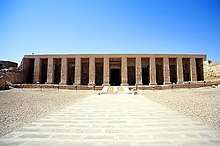
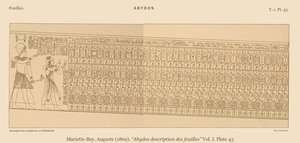
''Ramesses is shown holding a papyrus to read from with an accompanying text before him: Reciting praises by the hereditary prince; the eldest, of his body, his beloved (son), Ramesses, justified, true of voice. The text runs in six vertical columns above Ramesses, and is the speech given by Seti I: Words spoken by King Menmaatra. Bringing the god to his food offering, the making of offerings for the kings of Upper and Lower Egypt. Greetings to thee, Ptah Sokar, who is South-of-His Wall! Come, that I may make for thee these (things) which Horus made for his father Osiris.
The first fiftysix names shows an orderly progression of legitime rulers of Memphis. The kings who are not included are those whose rule over the Two Lands is questioned or who had some measure of political/religious bias towards them, for example, not ruling from Memphis.''
A work in progress: ''But where is the solar goddess? The best place to start to disentangle her role in the Osirian mysteries, however, is not Memphis itself, of which so little remains, but rather Abydos...where within the temple of Seti I, we shall find evidence concerning the resurgence of Memphite earth religion and the serpent eye goddess under the 19th Dynasty kings. The focal point of Abydos is the limestone temple built in the reign of Seti BUT completed by his son Ramses II {i.e., six either side of main open portal. Therefore 'thirteen' in total}....The 19th Dynasty continued the restoration work set in motion by Haremhab {i.e., 'right hand' man of Tutankhamun}, but were also driven by an urgent desire to reinstate the succession from father to son according to the ancient tradition of Horus succeeding Osiris...
''UNfinished'' to enlarge.
Continued: ''Abydos rises up from earth on the desert edge, silhouetted against the backdrop of the crescent shaped moon mountains beyond, which protectively enclose the hallowed city {'peristyle'?}. Further out to the west, in a remote desert spot, close to a great GAP in the mountain peak, lie the tombs {or possibly cenotaphs} of the First Dynasty kings.''
'Foremost of the Westerners'?
Continued: ''Each year pilgrims flocked {Ibis or Falcon?} to Abydos for the annual festival celebrating the resurrection of Osiris, and the triumph of Horus over Seth and his followers....Vast number of votive jars left behind which had originally contained food offerings {'meat'?} - now scattered in fragments - called 'Mother of Pots'. A great precessional way once led out to this area from behind Seti's temple....connecting the reigning king with these past rulers.'' [Pages 48/9 'My Heart My Mother: Death and Rebirth in Ancient Egypt' / A. Roberts].
'Ancestors' to enlarge.
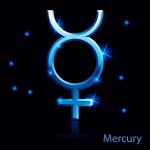
''Receptacle?

'Stamp of the feminine'. Real or symbolic? Light yellow?
And/or: ''The secret of the Holy Grail....is not that it represents a blood line.....it alludes to the vegetable part of our nature - as a living receptacle {'cup marks'}for our spirit or consciousness. The quest for the grail is a quest for a purified receptacle {'cup'}fit to carry a higher form of 'spirit' {i.e., as one example 'Krishna'} .....Rudolf Steiner, perhaps the greatest teacher of the esoteric, said that all serious work begins with work on the etheric, that is to say the vegetable body." [Page 342].
Try 'Smith' and 'Jones' to take it one or two steps further.
And/or: Chapter 'six' {'A Visit to Spiral Castle' }. Son of. Daughter of. Patriarch/Matriarch {OR anima/Animus?} as a means....
''Perhaps we have here the answer to the question which puzzled Herodotus: 'Who were the Hyperboreans?' Were they the 'back-of-the-north wind men', members of a north Wind cult, as the Thracians of the Sea of Marmara were? [Pager 95 'The White Goddess' / R. Graves].
A further link to Dionysus/Ariadne and the Northern Crown {'Crown of the North Wind'?}.
![]()
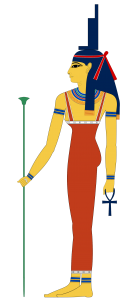 REFRESHER: "Cassiopeia is one of the oldest and popularly best known of our constellations, and her throne; ''the shinie Casseiopeia's chair'' of Spencer Faerie Queen, is a familiar object to the most youthful observer. It is also known as the Celestial 'W' when below the pole, and the Celestial 'M' when above it...Hyginus describes the figure as the Queen ''bound to her seat'' and thus secured when going around the pole - head downward- as a lesson selected by her 'enemies' {i.e., negative aspects?}, the sea-nymphs - as a lesson in humility...Known by the Greeks as 'She of the Throne' but at one time in Greece it was the Laconian Key: 'A brazen key she held, the handle turned, with steel and polished elephant ivory adorned' {Homer}.''
REFRESHER: "Cassiopeia is one of the oldest and popularly best known of our constellations, and her throne; ''the shinie Casseiopeia's chair'' of Spencer Faerie Queen, is a familiar object to the most youthful observer. It is also known as the Celestial 'W' when below the pole, and the Celestial 'M' when above it...Hyginus describes the figure as the Queen ''bound to her seat'' and thus secured when going around the pole - head downward- as a lesson selected by her 'enemies' {i.e., negative aspects?}, the sea-nymphs - as a lesson in humility...Known by the Greeks as 'She of the Throne' but at one time in Greece it was the Laconian Key: 'A brazen key she held, the handle turned, with steel and polished elephant ivory adorned' {Homer}.''
'Enchantment' to enlarge {and/or its variations i.e., enchant/enchanted etc}.
Any link to: ''the Chair of Lethe {of forgetfulness}, : ''that welds itself to the flesh, from which one cannot rise."

Tamar giving birth to Perez while twin brother Zerah is washed. Centre front: basket of swaddling bands is ready to wind round infants. Tamar is sitting on a birthing stool.
A working example: {i.e., something hinted at}: ''Nora stated the purpose of her visit: I was in need of a cook. She was ready to step into the breach....She would light a fire in the library if i liked....'It was Grandma's suggestion,' she said. Mrs {M}altravers - the wise woman...'' [Page 84 'Mercurius' /P. Harpur].
''Old Crone''?
Spirit leading to soul. 'Clouds' within a void - for that transition to occur. All within his personal Alchemical vessel - which he calls his ''double pelican'' {shape of a 'woman'}.
Janet in relation to Mrs B and Nora = synchronistic aspects of 'soul'. As a means...?
{To tell a story}?
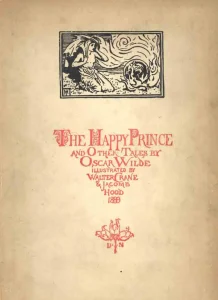
“The Happy Prince” is a short story by Oscar Wilde, part of his collection of short stories titled The Happy Prince and Other Tales, published in May 1888. Other short stories in this collection are “The Happy Prince,” “The Nightingale and the Rose,” “The Selfish Giant,” “The Devoted Friend,” and “The Remarkable Rocket.”
Side note: There are two pairs of twins in Genesis, but most of us only notice the first. Jacob and Esau get the headlines: the smooth wheeler-dealer who becomes the father of the Israelites and his hairy, oafish twin who gets tricked out of his birthright for a bowl of soup. By contrast, Perez and Zerah (Gen. 38) fly under the radar. They don’t appear in kids’ Bibles, or even sermons. Yet in many ways, they summarize the biblical story more crisply than any other siblings in Scripture.
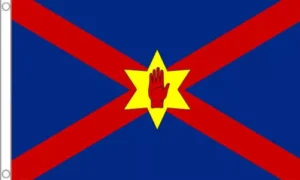
Flag of Ulster.
The twins are born to Judah and Tamar, the product of an incestuous relationship between a father and his daughter-in-law, whom he thinks is a prostitute (another story omitted from kids’ Bibles). Judah will become the tribe of kings, so it matters greatly which twin gets the inheritance. During childbirth, one brother’s hand emerges first, and a scarlet thread is tied around his wrist to confirm that he is the heir. But when he withdraws his hand, his brother barges past and is born first. The line-jumper is named Perez, which means breach or breakthrough. The one with the scarlet cord is called Zerah, which means dawn or rising. In those two names is found the heart of the gospel.
The world looks for a Zerah. We want a king who rises up and shines like the dawn. We want the firstborn, with a mark of royalty on his fist. But God chooses Perez, the boy of the breach, the child of breakthrough. He wants the sort of king we never would choose: a younger, weaker boy, without the obvious signs of kingship, who only triumphs because God breaks through on his behalf.
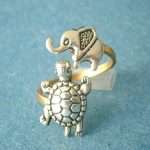
 As is: ''Beneath a winged sundisc with two pendant cobra's are two scenes BACK TO BACK {'Janus'?}, each depicting King Ahmose 1st presenting offerings to his grandmother Queen Tetisheri. Her vulture headddress, tall plumed crown, and elegant FLY - whisk are all queenly regalia. The king, who stands facing her, wears a short kilt, with a decorated front panel and a bull's tail attached behind {'bulls eye'?}. A dagger is stuck in his belt, and he grasps a staff and mace in one hand. In the scene on the left he wears the white crown, in that on the right the double crown. The long hieroglyphic text below purports to record a conversation between Ahmose and his queen, Ahmose - Nefertari, in which he declared his intention to build a shrine for Tetisheri in his own cult center at Abydos....When Ahmose commissioned this stela, late in his reign, he knew that he had inaugurated both a NEW dynasty and a new era. By emphasizing his descent {on both his mothers and fathers sides!} from Tetisheri, the MATRIARCH of the Seventeenth Dynasty, he proclaimed his own right to the throne.'' [Page 31 'Hatshepsut' / Metropolitan Museum of Art].
As is: ''Beneath a winged sundisc with two pendant cobra's are two scenes BACK TO BACK {'Janus'?}, each depicting King Ahmose 1st presenting offerings to his grandmother Queen Tetisheri. Her vulture headddress, tall plumed crown, and elegant FLY - whisk are all queenly regalia. The king, who stands facing her, wears a short kilt, with a decorated front panel and a bull's tail attached behind {'bulls eye'?}. A dagger is stuck in his belt, and he grasps a staff and mace in one hand. In the scene on the left he wears the white crown, in that on the right the double crown. The long hieroglyphic text below purports to record a conversation between Ahmose and his queen, Ahmose - Nefertari, in which he declared his intention to build a shrine for Tetisheri in his own cult center at Abydos....When Ahmose commissioned this stela, late in his reign, he knew that he had inaugurated both a NEW dynasty and a new era. By emphasizing his descent {on both his mothers and fathers sides!} from Tetisheri, the MATRIARCH of the Seventeenth Dynasty, he proclaimed his own right to the throne.'' [Page 31 'Hatshepsut' / Metropolitan Museum of Art].

Cows udder?
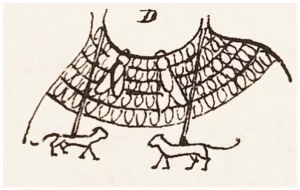 And/or: Ahmose defeats the Hyksos in Lower Egypt {Avaris} with the help of his 'soldiers' - one of which recieves {in ceremony} the 'gold' necklace SEVEN times for valour {Gold necklace of Valour}. Sometimes this award came with 'golden flies'. {because they never stop attacking - like a warrior/military}. He also brings back haunched backed slaves {hump?} for Ahmose the King. Ahmose who begins the eighteenth Dynasty {'eighteen'}. Amun becomes main god at Thebes {Luxor}. Karnac becomes central. {Ram headed Sphinx's}. It grew in every direction {E/W/S/N} with each king. His wife {sister?} Ahmose Nefertari becomes main Priestess of Amun + gods wife of Amun {FIRST time in Egyptian history}. As HIS wife she can then therefore ''give birth to 'son of a god' = ''the myth of divine birth''.... ['Legends of the Pharaoh'].
And/or: Ahmose defeats the Hyksos in Lower Egypt {Avaris} with the help of his 'soldiers' - one of which recieves {in ceremony} the 'gold' necklace SEVEN times for valour {Gold necklace of Valour}. Sometimes this award came with 'golden flies'. {because they never stop attacking - like a warrior/military}. He also brings back haunched backed slaves {hump?} for Ahmose the King. Ahmose who begins the eighteenth Dynasty {'eighteen'}. Amun becomes main god at Thebes {Luxor}. Karnac becomes central. {Ram headed Sphinx's}. It grew in every direction {E/W/S/N} with each king. His wife {sister?} Ahmose Nefertari becomes main Priestess of Amun + gods wife of Amun {FIRST time in Egyptian history}. As HIS wife she can then therefore ''give birth to 'son of a god' = ''the myth of divine birth''.... ['Legends of the Pharaoh'].
''The mammary gland of female cattle, sheep, goats, horses, and related animals, having two or more teats and hanging between the hind legs of the animal.''
'Hung/hang'?
And/or: "The sixth hour of the day carries the sun at NOON {'zenith'}. The sun is represented as a four headed ram, a symbol of its maximum potency. The four heads represent the four cardinal points." ['Ancient Egypt' / March-April 2024].
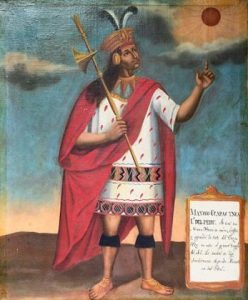
Trumpet call? Claxon?

"He is the king who introduced the royal title Sa-Rê (meaning “Son of Ra”) and the first to connect his cartouche name with the sun god Ra." Feathered serpent? - or is that only a southern hemisphere phenomenon?
A working example: The Mexicans had only a crude knowledge of nearly all the arts without perfecting any. Their writing consisted only of hieroglyphic pictures. They had nevertheless a sort of post by means of which the orders of the Emperor or important news was sent forward from the centre to the extremities of the Empire. Their year was divided into eighteen months of twenty days each, to which they added five complementary days, which indicates some astronomical knowledge. ‘Their agriculture, however, was imperfect. As they did not understand money, the taxes were paid in kind. Each thing, according to its kind was arranged in storehouses, from which they were drawn for the service of the state. The right of territorial property was known in Mexico; every free man possessed there a certain extent of land; but the social ties, still uncertain, showed as I have said, a social state at its dawn. {'Hermetic Interpretation of the Origins of the Social State of Man'].
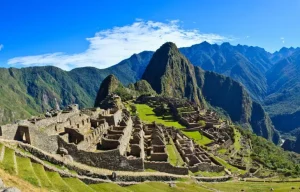
The House that Manco Capac built. High up in the clouds {above or below?}. 'Upper Rooms'?
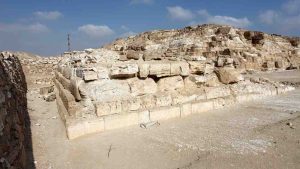
South-east corner of the Queens or Cult Pyramid, Djedefre pyramid, Abu Rawash, Egypt. Built on the highest spot in Egypt.
It’s believed that Manco Capac – sometimes known as Ayar Manco, Manco Inca and Manqu Qhapaq – was born sometime in the late twelfth century in a town called Tamputoco, which may be in the modern-day Peruvian province of Pumacurco, around 660 kilometres east of the famous Nazca Lines...
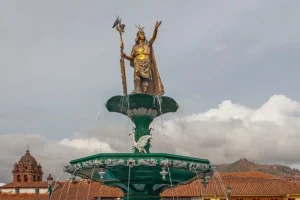
Lily or lotus?
The most well-known legend is that of Manco Cápac and Mama Ocllo, who were believed to be the children of the sun god Inti and the moon goddess Mama Quilla. According to this legend, they emerged from either the waters of Lake Titicaca or from a cave called Pacaritambo, depending on the version of the story.

"To travel in a straight line one has to follow one's nose."
Inti sent them to found a great civilisation and gave Manco Inca a golden staff. They were instructed to find the perfect place to establish their empire by thrusting the staff into the ground at a location where it would sink completely. After a journey of perhaps 400 kilometres north, they reached the fertile valley of Cusco, where the staff sank into the earth, indicating the chosen site.
Manco Cápac then established the city of Cusco and, as the first Inca leader, laid the foundation of the Inca Empire. Mama Ocllo taught the women, while Manco Cápac taught the men, setting the societal structures of the empire.
'Lonely Mountain' near by?
Continued: The frequency of eclipses varies depending on the type of eclipse12. In most calendar years, there are two lunar eclipses, but in some years, one, three, or none occur1. Solar eclipses occur two to five times a year, with five being exceptional1. The average number of total solar eclipses in a century is 66 for Earth as a whole1. Approximately once every eighteen months, a total solar eclipse is visible from some place on the Earth’s surface.
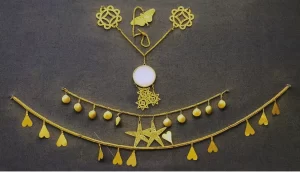

Any soldiers?
And/or: ''Gold fly-shaped pendants from ancient Egypt have been interpreted as military awards, possibly forming part of an honorary Order, that were given by the king to symbolise a brave soldier's persistence in battle. However, this interpretation is questionable as it relies on the self-presentation texts of two Egyptian soldiers, Ahmose Pennekhbet and Amenemhab Mahu, and yet examples of golden flies have been found in the burials of women and children, who were not normally associated with military activity in ancient Egypt. Furthermore, considering golden flies as symbols of persistence may reflect a modern outlook, in which flies are considered to be annoying pests, and the Egyptians may not have held the same perspective.'' [University of Manchester].
''Horse, fruit and crane flies are all species of the same winged insect.'' ['Tipping Point'].
 Side note: Nebu is the Egyptian symbol for gold. It depicts a golden collar with the ends hanging off the sides and seven {six?} spines dangling from the middle.
Side note: Nebu is the Egyptian symbol for gold. It depicts a golden collar with the ends hanging off the sides and seven {six?} spines dangling from the middle.
Recall the golden collar of Anubis.
''Domesticated/Tamed'' as a means...?
 Ancient Egyptians believed that gold was an indestructible and heavenly metal. The sun god, Ra, was often referred to as a mountain of gold. The Royal Tomb was known as the "House of Gold". The pharaohs of the Old Kingdom were called the "Golden Horus". The ancient Egyptian name for the city of Ombos, Nebet, also used the nebu hieroglyph.''
Ancient Egyptians believed that gold was an indestructible and heavenly metal. The sun god, Ra, was often referred to as a mountain of gold. The Royal Tomb was known as the "House of Gold". The pharaohs of the Old Kingdom were called the "Golden Horus". The ancient Egyptian name for the city of Ombos, Nebet, also used the nebu hieroglyph.''
''One of the few coins minted for ancient Egypt is the gold stater, issued during the 30th Dynasty. The reverse of the gold stater shows a horse reared up on its hind legs. The obverse has the two hieroglyphs for nfr and nb: "Perfect gold", or a common-era term: 'Fine'-gold.''
Recall other animals {lions?} with 'raised' legs.
Somerset to enlarge.
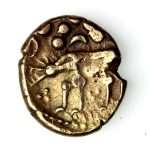
Teeth for a 'key'?
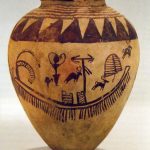
The Rump {poop deck} of a ship. Heading north?
Side note: '' Celtic Gold Norfolk Wolf Stater, circa 65-45B.C. of the Iceni tribe based in Norfolk and neighbouring parts of Suffolk and Cambridgshire. OBV, Stylised Apollo Head, Rev Wolf left, with bird seated on rump and pellet below. High grade Gold content, with Very well detailed wolf, showing bristles. 17mm in diameter.''
''In this usage, obverse means the front face of the object and reverse means the back face. The obverse of a coin is commonly called heads, because it often depicts the head of a prominent person, and the reverse tails.''
Convex/Concave?
Embossed/Debossed?
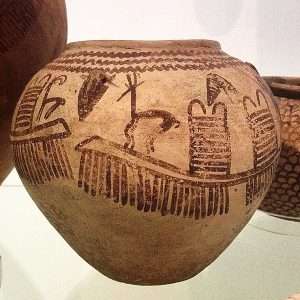
A leap across a gap?

Landing from a Leap?
Analogy: ''The Myth of Horus narrated on the second register of the inner walls of the Edfu Temple for example, features an epic victory of good versus evil in the killing scene where Horus the Son of Isis impales Seth in the form of a red Hippopotamus (Fairman, 1935: p. 27). The concept of such an encounter can be traced back to pre-historic Hierakonpolis, where the figurines of a falcon and a hippopotamus were found buried together inside a post-hole as a foundation deposit in the southeast corner of a pillared hall (structure 7) in the elite cemetery HK-6 (Droux & Friedman, 2007: pp. 7-9). This structures dates to the mid-4th Millennium B.C.E. The southeast corner hints that the two contenders were imagined dwelling in that area of the horizon where Sirius, Venus, and Mercury at times hover.''
Mars/Saturn/ Jupiter?
And/or: ''Horus, the jackal of Upper Egypt....the first born Horus -the Opener-of-the-Ways. As the first child to open the womb of his mother, Isis, - Geb identifies Horus with the god, Wepwawet {wolf}, whose name means 'Opener-of-the-Ways' ......whose tracks, every desert traveller knows to follow in order to find ways through unknown terrain {fenland?}....'' [Page 40 'My Heart My Mother: Death and Rebirth in Ancient Egypt'].
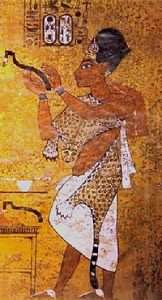
Opening of the 'mouth' in relation to the ''Monarchy of the eye and Democracy of the nose.''
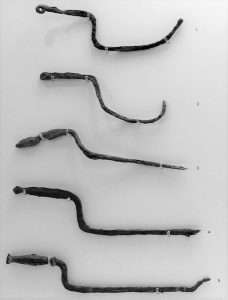
Straight lines and curves. 90/180?
Continued: In the tomb of Nefertari {Ramses II Wife} was found when first entered LEG bones, a pair of reed sandals {slippers?} and a ''ceremic object, glazed blue with copper salts'' within the cartouch {'oval'} of the pharaoh Ay - which was supported by the Egyptian Nebu symbol for 'gold'. ['Blowing Up History' / S5 EP12 / 20 mins].
''Ay was the penultimate pharaoh of ancient Egypt's 18th Dynasty. He held the throne of Egypt for a brief four-year period in the late 14th century BC. Prior to his rule, he was a close advisor to two, and perhaps three, other pharaohs of the dynasty. It is theorized that he was the power behind the throne during Tutankhamun's reign. His prenomen Kheperkheperure means "Everlasting are the Manifestations of Ra," while his nomen Ay it-netjer reads as "Ay, Father of the God.''
Continued: ''Three variants of the gold hieroglyph are ligatured with another hieroglyph: Egyptian language nbi, for "gild", or "gilt." (Gold and Foot). Gold and mace (club) for "silver." Gold and was scepter-("uas scepter"), for "electrum", dj'm.'' [Wiki].
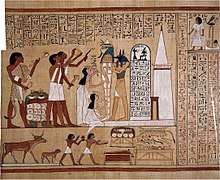
Priests of Anubis, the guide of the dead and the god of tombs and embalming, perform the opening of the mouth ritual. Extract from the Papyrus of Hunefer, a 19th-Dynasty Book of the Dead (c.1300 BCE)

"He is the king who introduced the royal title Sa-Rê (meaning “Son of Ra”) and the first to connect his cartouche name with the sun god Ra." What about the 'nose'?
The opening of the mouth ceremony (or ritual) was an ancient Egyptian ritual described in funerary texts such as the Pyramid Texts. From the Old Kingdom to the Roman Period, there is ample evidence of this ceremony, which was believed to give the deceased their fundamental senses to carry out tasks in the afterlife. Various practices were conducted on the corpse, including the use of specific instruments to touch body parts like the mouth and eyes. These customs were often linked with childbirth, which denoted rebirth and new beginnings. For instance, cutting bloody meat from animals as offerings for the deceased signified the birthing process, which typically involves blood, and represented the commencement of a new life. Additionally, tools like the peseshkef, which resembled the tail of a fish and were originally employed for cutting infants' umbilical cords, further emphasized the idea of "rebirth"
N.B. The soldier himself talks about the above: an account of his life - ''from beyond the grave in the first person singular'' - who served Ahmose the king of Upper/Lower Egypt from: ''Aboard the ship called the wild bull.'' ['Legends of the Pharaohs' / S2 EP1].
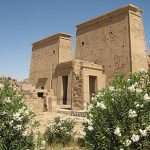
''Interface'' ?
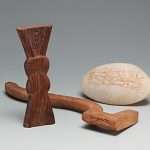
Where have you seen it before?
''As we have seen this {mind set} is especially interested in the interface between the animal and vegetable on the one hand and in the interface between the vegetable and the mineral on the other {'raised hands'?}. It is the key to understanding nature...The vegetable is the intermediary between thought and matter. It may be called the gateway between the worlds.'' [Page 445.].
Valleys/Hills?
A work in progress: The above will show how ambiguous these definitions are without some fairly illuminating system which may give a clarified vision of their import. It remains to be added that one’s first clairvoyant view of astral matter seems to be of a white or silvery cloud, smoke, or vapour, in a state of great activity and movement. The pictures that project themselves upon it slowly unwind themselves before the mental or inner vision like a cinematograph film..... 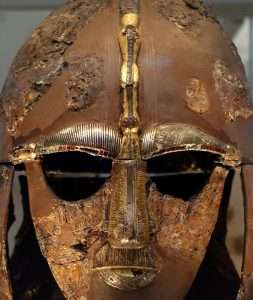
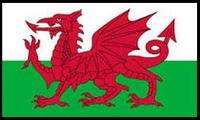
''The tongue of the Welsh dragon is the symbol of the Welsh Language Society.''
Because of the highly specialized nature of consciousness, its exaggerated independence and self-satisfaction and the guilt sense resulting therefrom, a barrier is erected in the psyche of modern man between the several levels of consciousness. The treatise calls this barrier set up by persistent repression, “the shadow and impurity by which the clouds hang over it, defile and keep away the light”. In fact, it is common evidence that many neurotics, feeling themselves cut off from their roots and thus from the vibrant stream of life about them, imagine that actually clouds do hang over them, darkening their lives. Freud calls this overshadowing cloud of self-criticism and recrimination the Super-ego. It prevents a free and adequate contact with people and things, dulls the brain, inhibiting the easy flow of life and light, the libido, from welling up from the Unconscious.
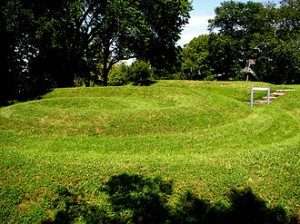
'Snake/Dragon head' on land. 'tail' in the sea.
The ray is, I take it, the light itself shining over and into consciousness after the latter has been separated from or has deliberately absorbed (accepted) its shadow.....IT is first something was a certain kind of cloud or darkness, which was condensed in-to water, and this water is that one thing in which all things were contained. But my question is: What was that nothing out of which the first cloudy chaos or something was made? Canst thou tell me? It may be thou dost think it is a mere nothing. It is indeed nihil quo ad nos - nothing that we perfectly know. It is nothing, as Dionysius saith: it is nothing that was created or of those things that are and nothing of that which thou dost call nothing-that is, of those things that are not, in thy empty, destructive sense....

Above or below?
But I have done. I will now speak something of generation and the ways of it, that the process of the philosophers upon this matter may be the better understood. You must know that Nature hath two extremes and between them a middle substance, which elsewhere we have called the middle nature. Example enough we have in the creation. The first extreme was that cloud or darkness whereof we have spoken formerly. Some call it the remote matter and the invisible chaos, but very improperly, for it was not invisible. This is the Jewish A in Soph outwardly, and it is the same with that Orphic night. ['The Philosophers Stone' / I. Regardie].

'M'?
And/or: ''Daily the clouds increase. Wafts of deadly vapour rise up from our sea and grow denser, like a preamble to some mighty deluge....I neglected my duties today {synchronistic?}. The lifting of the rain and my vague perturbation of soul prompted me to take a walk along the high ridge {of a mountain or hill?} of Grimm's Down. The cramped, stiffling village straggled along the valley below. Its inward looking inhabitants {Easter Island?} were too busy keeping an eye on each other to notice me sailing along like a cloud high above them!.... The goal of solution is only this: to divide that which is Above to that which is Below...That begins the process of seperation - which is the divorce of mercury and sulphur - soul and body of our matter. We call it the slaying of the dragon {spirit?}...'' [Page 75 'Mercurius'].
Cloud People?
The cloud of witnesses is a biblical phrase that refers to the multitude of faithful people who have gone before us and set an example of obedience to God12. The phrase comes from Hebrews 12:1, where the author urges the readers to run the race of faith with perseverance, looking to Jesus as the author and finisher of our faith. The cloud of witnesses is meant to inspire and encourage us to follow God in our own lives.
Side note: ''In the Chinese Zodiac the year of the snake directly follows the year of the dragon.'' ['Impossible'].
And/or: There is no year of the lion in the Chinese Zodiac.''
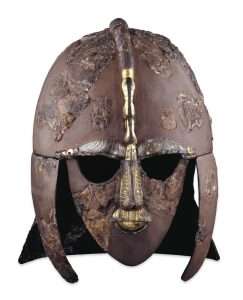
Dragon?
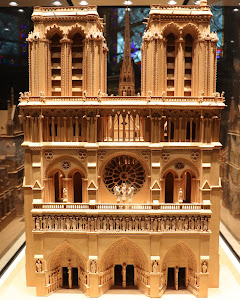
Notra Dame. A 'forest' of oaks below a lead roof.
And/or: Treasure belonging to Attila the Hun found in a 'forest' 10 miles outside the boundaries of Rome. Taken from conquests east-west. Over 100 pieces . Includes 'bowls' studded with gems; 'leaf' shaped brooches covered in gold and ''silver plated frames and clasps which when put together form a silver folding chair''. [Blowing Up History: Wrath of Attila the Hun].
'Bowls' in relation to Crescent?
''According to legend, Attila died of a nose bleed.'' ['The Chase' / 2018].
''In 453AD Attila died on his wedding night: His bride found him dead. Frightened of being accused of murdering him, she slept by his corpse all night. A 6th century historian reported: 'He fell not by rude or foe nor treachory but by joy and without pain'....'' ['Rome: Rise and Fall of an Empire' / S1 EP13].
''Ildico (fl. AD 453) was the last wife of the Hunnic ruler Attila. Her name is probably Germanic, a diminutive form of the noun *hildaz ("battle"),[1] a common element in Germanic female names (e.g. Svanhildr, Brynhildr and Gunnhildr), and Hildr ("battle") was the name of a Valkyrie. Her name is thus reconstructed as *Hildiko ("little Hildr"), and it is probably preserved in *Grímhild or *Krēmhild, the name of Ildico's later legendary version.[2]


Happy or Sad?
According to Priscus, Attila died after the feast celebrating their marriage in 453 AD, in which he suffered a severe nosebleed and choked to death in a stupor:
"Shortly before he died, as the historian Priscus relates, he took in marriage a very beautiful girl named Ildico, after countless other wives, as was the custom of his race. He had given himself up to excessive joy at his wedding, and as he lay on his back, heavy with wine and sleep, a rush of superfluous blood, which would ordinarily have flowed from his nose, streamed in deadly course down his throat and killed him, since it was hindered in the usual passages. Thus did drunkenness put a disgraceful end to a king renowned in war. On the following day, when a great part of the morning was spent, the royal attendants suspected some ill and, after a great uproar, broke in the doors. There they found the death of Attila accomplished by an effusion of blood, without any wound, and the girl with downcast face weeping beneath her veil."[3]
In Germanic heroic legends, she corresponds to Guðrún/Kriemhild, and in the Norse versions she deliberately killed Attila, in revenge for the death of her kinsmen.''

Hestia.
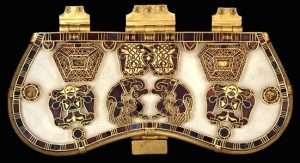
Sutton Hoo folded purse clasp: Wolfs / eagles and ducks.
Side note: In central Germany archaeologists unearth an iron folding chair dating to 600AD - placed at ''the foot of a deceased woman.'' Also found in the grave: ''necklace made of glass beads and a belt with dangling beads and brooches.'' Only a few dozen similar ancient ''folding chairs'' have been found throughout Europe - ''mostly in early medieval women's burials....During the Middle Ages, folding chairs were used as the official insignia of Bishops, and also for representing royalty.'' [Page 10 'Archaeology' / Nov/Dec / 2022].
Folding/UNfolding?
And/or: ''In 1904 Viking Longship unearthed in Norway {Oseberg ship}. Preserved because of the local STREAM had kept the surrounding BLUE clay that surround it 'wet'. Among the goods included 2 cows 15 horses and 6 dogs {i.e., 'twentythree' in total}. Weaving/sowing tools found + Quartz stone + 6 beds and 1 chair and cart. They all belonged to TWO women.'' ['Raiders of the Lost Past: The Viking Ship' / BBC4].
Question. What belongs to 'spirit'. What belongs to 'soul' ?
N.B. Quartz is made from fire and water.
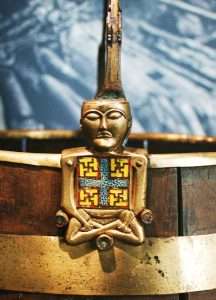 And/or: ''The back of the cart is decorated with cats, bringing to mind the cats that drew the cart of Frøya, the goddess of fertility. The front end of the cart shows a man lying on his back, being attacked by serpents. Could this be an illustration of the tale of Gunnar in the snake pit? These were familiar stories for the Vikings, and the symbolism of the carving may have had great significance that is largely unknown today.''
And/or: ''The back of the cart is decorated with cats, bringing to mind the cats that drew the cart of Frøya, the goddess of fertility. The front end of the cart shows a man lying on his back, being attacked by serpents. Could this be an illustration of the tale of Gunnar in the snake pit? These were familiar stories for the Vikings, and the symbolism of the carving may have had great significance that is largely unknown today.''
Get into that universal mind set to 'see' the ''unknown''.
All enlarged throughout.
The Wain?

Sad {'melancholy'} or joyous?
Side note: ''Stream that kept it all wet'' in relation to: ''When the waters come in, they awaken the bodies and the spirits, which are imprisoned and powerless.....Gradually they bestir themselves, rise up, and clothe themselves in bright colours, glorious as the flowers in spring. The spring is glad and rejoices in the blossoming ripeness they have put on.'' [Page 154 'Alchemical Studies'].
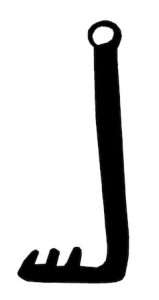
'Three' sections?
Continued: Horseshoe type 'buildings' in 'three' segments found - together with upturned vases. Found close to boundary/enclosure walls. Other clues towards defining a mind set within the same documentary: Elongated skulls / Oracle forecasts made from the 'right shoulder of a sheep, put into a fire' / Battlefield mentioned: ''5th {five} milestone away from Troyes''. [Attila's Forbidden Tomb' ].
''Troyes is the ancient capital of the Champagne-Ardennes region famous for its vineyards and the finest champagne. It lies in the heart of the Aube department in north-central France, approximately 150 km (93 miles) from Paris .'' [Wiki].
Side note: The idea of the forest {as royal hunting grounds} were 'invented' by the Normans.
N.B. Many upturned vases found throughout archaeology.
Continued: The narrator Simon Armitage asks the same question. Wonders how Odysseus can stay on this 'island' for a whole year {year and a day?} - while most of his 'men' are suffering {turned into 'pigs' etc.}: ''Odysseus behaviour is questionable to say the least. Has he forgotten his wife, the loyal Penelope, who's waiting for him back home? Or is he just recuperating after getting hopelessly lost, and watching most of his men die in agony? It all reminds me of a story about George Best...." ['Gods and Monsters': Homers Odyssey].
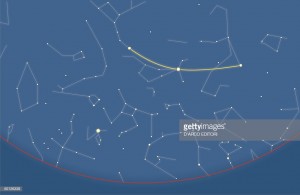 Transition between higher/lower? First '10' years that struggle of lower fighting {coming to terms?} with higher due to 'feminine' aspect {Helen} illegally {'sin'?} taken. THEREFORE a weak {'fall' link} aspect of the 'higher' {Paris}. Lower combines to 'challenge' higher. Lower eventually wins {'wooden' horse , i.e., by 'cunning' not by what the REAL 'horse' REPRESENTS}. 'Lower' now has to come to terms with a new ''state of BEING' while returning to its normal SOURCE. Hence a ''transition'' FROM lower to a now possible 'higher' state of conscious awareness. Both in the Micro {individual} and Macro sense of the word {represented with ''Precession''}. First 10 years more to do with spirit/shadow/ego. Remaining years = Spirit {male} coming to terms with soul {female} i.e. in the anima sense of the word. Hence the 'feminine' aspect more prevalent in the 'return' than the other {i.e.,Circe, Sirens, Calypso etc}. PRIORITIES CHANGING. A transition; a coming together; an awareness and understanding {of archetypes?} between 'worlds', i.e., ''pigs'' - recall what they REPRESENT in relation to the day to day stuff. The ongoing stuff. That transition ongoing towards ''home'' where a new beginning awaits. IF SUCCESSFUL. Odysseus is the only one who returns simply because all his 'lower' aspects have been overcome. A new man returns? {DEATH/REBIRTH?}. From a lower to a now higher learning curve {''arc''?} - of BEING?
Transition between higher/lower? First '10' years that struggle of lower fighting {coming to terms?} with higher due to 'feminine' aspect {Helen} illegally {'sin'?} taken. THEREFORE a weak {'fall' link} aspect of the 'higher' {Paris}. Lower combines to 'challenge' higher. Lower eventually wins {'wooden' horse , i.e., by 'cunning' not by what the REAL 'horse' REPRESENTS}. 'Lower' now has to come to terms with a new ''state of BEING' while returning to its normal SOURCE. Hence a ''transition'' FROM lower to a now possible 'higher' state of conscious awareness. Both in the Micro {individual} and Macro sense of the word {represented with ''Precession''}. First 10 years more to do with spirit/shadow/ego. Remaining years = Spirit {male} coming to terms with soul {female} i.e. in the anima sense of the word. Hence the 'feminine' aspect more prevalent in the 'return' than the other {i.e.,Circe, Sirens, Calypso etc}. PRIORITIES CHANGING. A transition; a coming together; an awareness and understanding {of archetypes?} between 'worlds', i.e., ''pigs'' - recall what they REPRESENT in relation to the day to day stuff. The ongoing stuff. That transition ongoing towards ''home'' where a new beginning awaits. IF SUCCESSFUL. Odysseus is the only one who returns simply because all his 'lower' aspects have been overcome. A new man returns? {DEATH/REBIRTH?}. From a lower to a now higher learning curve {''arc''?} - of BEING?
Side note: Djedefre = the first to use ''Son of''.
Spirit and soul now blended - becoming balanced. That ''once upon a time'' GIANT {external?} has {'changed'? therefore ''Circe'' link} into something more balanced - INTERNALLY. Spirit/soul. 'see' it? If you do then you have a better appraisal of such quotes as: " There were giants in the earth in those days; and also after that, when the 'sons' of God came in unto the 'daughters' of men, and they bare 'children' to them..." [Genesis 6:4].

Above or below the 'clouds'?

Witches hat or Hennin? Worn by 'royalty'.
Something extra: ''Whereas the 'witch' {i.e., female aspect in the 'negative' sense of the word} was slaughtered in a cave - the giants head {i.e., Ysbaddaden AFTER beard was shaved} - was exposed upon a mound.....It MAY be that the mound symbolizes the breast, with Ysbaddaden's head on its stake representing the 'bad nipple'....'' [ Page 198 'A Celtic Quest' ' J. Layard}.
The author {for this reader} complicates everything with his 'sexual' analysis throughout. Freud did the same with his single short-sighted obsession. A closer to the ''mark'' analysis to get within that mind set would be found within 'Jack and the Beanstalk'.
Question. A goatee beard?
From a different perspective: ''In an episode known as the temptation of Saint Antony....he was granted a vision of the 'devil' - a tall black man with his head in the clouds. He also 'saw' angels who were able to guide some human spirits up, beyond the devils reach.'' [Page 329 'The Secret History of the World' / J. Black].
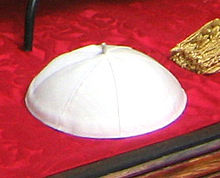
''Her body glows and TINGLES from the crown of the head to her TOES. I like learning about the universe in this way.'' [Page 203 'The Quest of the Rose']. Question. Blood red?
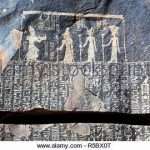
Toehold?
And/or: ''The curbing of desire brings us back to that odd phrase {'peculiar'?} of Ysbaddaden Pencawr's: 'I must needs dress my beard for me to be shaved. It will never settle unless the blood of the Black Witch be obtained, daughter of the White Witch {'duality' link} - from the Head of the Valley of Grief in the Uplands of Hell.'' [Page 195/6 'A Celtic Quest'].
Higher of the 'lower'?
Mountains low. Valleys high?
What would the next stage {cycle?} be REPRESENTED with?
"The 'good life' is a process. The good life is a process, not a state of being. It is a direction, not a destination. The good life constitutes a direction selected by the total organism, when there is psychological freedom to move in ANY direction." [Taken from Part three, 'on matters of existence' from the book, 'Striking Thoughts' { Bruce Lee's Wisdom for Daily Living} by J.Little]. And...
"I will present the psychological aspect of the tradition, particular Jungian thinking, and show how it relates to alchemy and, perhaps more importantly initiation - the later a relationship that has not been touched upon by other authors..." [Extract from the book 'The Magister' ].
This web page has ''touched'' on the above - throughout, i.e., try ''teacher'' in relation to higher/lower.

''Duc in Altum, built in 2014 to commemorate the PUBLIC life of Jesus and the dignity of women. The main ALTAR abstractly replicates a 1st century fishing boat in the ancient harbour.'' Question. Wind in the sails? And/or: ''After the 'miracle' of the multiplication of the SEVEN loaves of bread, Jesus gets into a boat and comes to the region of Magdala named Dalmanoutha. The name and place are disputed, being either Magdala or an area NORTH of same...Magdala = Migdal meaning 'tower'....'' [Page 30-32 'Mary Magdalene' / J. Ristine].
Or put simply as Mr Jung himself was requested to as explained in the introduction to his final book 'Man and His Symbols' from where the above quote was taken - {ten days after completion - he died] - CONSIDER those symbols {archetypes?} - with that universal framework in mind - RELATIVE to the 'Self' to understand the Micro within the Macro, i.e., you cant have one without the other - but one has to come before the other. See it? If you do, then one could say - the beginning of an initiation?
Secondary OVER primary?
'Second to none' or 'second childhood' as a means....?
And/or: ''Or maybe its the memory of what we all have stored within us from the start. After all, a myth is something that never was but is always happening. And the fact that so many of these early myths and scriptures tells us much about the same story about our potentials shows not just where we may have been but also what is coded within us - A SECOND NATURE, that is so much greater than our usual one.'' [Page 34 'A Mythic Life'].

The same Zodiac but now with the missing thirteenth; Smack bang, in the middle. Question. Recognize it? Where have you seen it before? Find it, to understand it.
[ ''A 6th century mosaic pavement found in a syna...gog...ue. That includes Greek - Byzantine elements.'' [ Wikipedia / Zodiac]
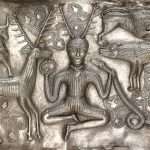
'Sat on' Spirit or soul ? Enthroned?
"Zeus ,too, as we have shown, battled not a 'dragon' but a serpent-god. As we shall show later on, there was a deep meaning attached to these ancient traditions of a struggle between a god of winds and a serpent deity. Here, however, we can only stress that battles among the gods for the divine Kingship were reported in the ancient texts as events that had unquestionably taken place".[page 67, same book]. Indeed they did, but only in that 'inner' sense. Recall the symbolism of dragon and serpent, relative to; as in this example; what the word 'Zeus' is a representation of.
"And in the alternation of the night and the day, and in what Allah sends down in sustenance from the sky, and revives therewith the earth after its death, and in the change of the winds...are signs for those that are wise." [Quran 45:5. Translation from Abdullah Yusuf Ali].
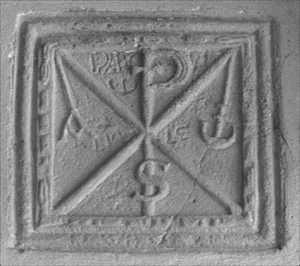
Lure?

The phrase “hot on the heels” means in close pursuit of someone or something, or immediately after some event. It originates from hunting terminology, where the “on the heels” part refers to a hunter’s literal closeness behind their quarry.
A Talmudic states The storm wind hangs between the arms of god like an amulet : The 'hanging' is, of course, the Teli. The storm wind is the slowly backward-turning spiral of precession and a good metaphor for the mystical experience itself. The prophet Nahum (1:3) declares, “His way is in the whirlwind,” and Psalms 50:3 agrees that to experience God is to plunge into the tempest that surrounds Him. The arms of the universe are the unmoving Teli, the ecliptic and galactic axes, from which the initiatory spiral of the equinoxes is suspended like an amulet. It is hard to overestimate the value of the knowledge of one’s location in space and in time that these three axes provided. It would also seem as if these axes were creating an address for Earth, the purpose of which remains a mystery. In verse 106 of the Bahir we read that the Teli is nothing but “the likeness before the Blessed Holy One,” or the face of God.'® Verse 96 of the Bahir addresses key alchemical symbols, and may in fact be our earliest mention of the philosopher’s stone. It begins: “What is the earth from which the heavens were graven [created]? It is the throne of the Blessed Holy One. It is the Precious Stone and the Sea of Wisdom.”!” The verse continues to suggest the spiritual value of the color blue, the traditional color of kingship in ancient cultures, by associating the sea with the sky and the sky with the higher light coming from the Throne of Creation......
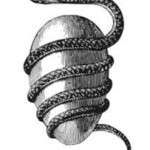
Inner/outer. A beginning or end?
Fulcanelli goes further, however, by emphasizing the word sabot as a spinning top, the Hebrew dreidel.....
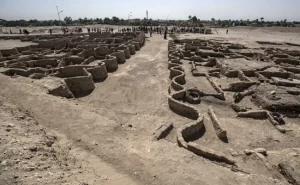
Amenhotep III fascination with the colour blue - began in the newest city of the Dazzling Aten.
This spinning refers to the whirlwind of the mystical experience, and the spinning of the celestial mill as the movement of the sky grinds out time. As we saw in chapter 4, this concept is an important one in the Bahir. Fulcanelli’s insistence on connecting these metaphors with the Feast of the Epiphany forces us to consider the significance of that moment in time. Is there an astronomical and eschatological clue here as well? ['The Mysteries of the Cross of Hendaye'].
Side note: ''Totnes (/ˈtɒtnɪs/ TOT-niss or /tɒtˈnɛs/ tot-NESS) is a market town and civil parish at the head of the estuary of the River Dart in Devon, England, within the South Devon Area of Outstanding Natural Beauty. It is about 5 miles (8.0 km) west of Paignton, about 7 miles (11 km) west-southwest of Torquay and about 20 miles (32 km) east-northeast of Plymouth. It is the administrative centre of the South Hams District Council.

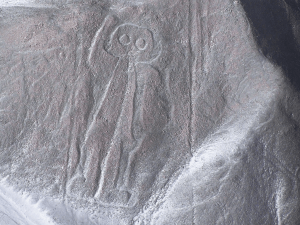 Totnes has a long recorded history, dating back to 907, when its first castle was built. By the twelfth century it was already an important market town, and its former wealth and importance may be seen from the number of merchants' houses built in the sixteenth and seventeenth centuries....According to the Historia Regum Britanniae written by Geoffrey of Monmouth in around 1136, "the coast of Totnes" was where Brutus of Troy, the mythical founder of Britain, first came ashore on the island.[8] Set into the pavement of Fore Street is the Brutus Stone, a small granite boulder[9][10] onto which, according to local legend, Brutus first stepped from his ship. As he did so, he was supposed to have declaimed: 'Here I stand and here I rest. And this town shall be called Totnes'.
Totnes has a long recorded history, dating back to 907, when its first castle was built. By the twelfth century it was already an important market town, and its former wealth and importance may be seen from the number of merchants' houses built in the sixteenth and seventeenth centuries....According to the Historia Regum Britanniae written by Geoffrey of Monmouth in around 1136, "the coast of Totnes" was where Brutus of Troy, the mythical founder of Britain, first came ashore on the island.[8] Set into the pavement of Fore Street is the Brutus Stone, a small granite boulder[9][10] onto which, according to local legend, Brutus first stepped from his ship. As he did so, he was supposed to have declaimed: 'Here I stand and here I rest. And this town shall be called Totnes'.
'Crossroads' to enlarge.
The stone is far above the highest tides and the tradition is not likely to be of great antiquity, being first mentioned in John Prince's Worthies of Devon in 1697.[11] It is possible that the stone was originally the one from which the town crier, or bruiter called out his news; or it may be le Brodestone, a boundary stone mentioned in several 15th century disputes: its last-known position in 1471 was below the East Gate.....The Middle English prose Brut (c. 1419) places the fight between Brutus' general Corineus, and the British giant Gog magog "at Totttenes",[12] while Cornish antiquary Richard Carew suggested that the fight may have begun near the town, but ended at Plymouth Hoe.''
''The name Totnes (first recorded in AD 979) comes from the Old English personal name Totta and ness or headland. Before reclamation and development, the low-lying areas around this hill were largely marsh or tidal wetland, giving the hill much more the appearance of a "ness" than today....In recent times it has gained a reputation as a centre for learning, arts, alternative lifestyles and culture. A trip to Totnes is not complete without a visit to the Brutus Stone, which can be found in Fore Street, set into the pavement.''
'Foremost'?
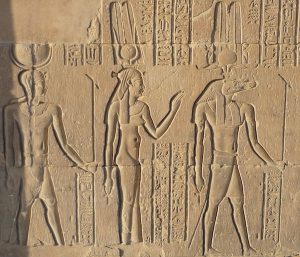
In front or behind? Enlarged further on.
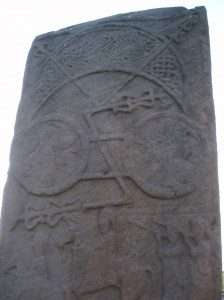
A Pict symbol. Question. Goggle-eyed? A weaving pattern within the crescent of something? Enlarged elsewhere.
Continued: "The lunar nodes are the points in the sky where the orbits of the sun and moon intersect, and they indicate the places where eclipses can occur...In Hindu astrology they are deified as the head and tail of a serpent-dragon and are called Rahu and Ketu, both of whom are involved in the Vedic Creation myth called the 'Churning of the Milky Ocean'. ['Galactic Alignment'. Mentioned elsewhere]. Try ''eclipse'' and ''churning'' relative to what ''milk'' represents - OUTSIDE of the obvious.
And/or: "Various Mystery Schools from Ancient Egypt onwards have maintained the tradition. The principle work of the Western Esoteric Tradition is expansion of consciousness. It deals with the ‘ground of all being’, unmanifest, beyond time and space, which differentiates countless nodes of being evolving through a manifest universe. The purpose of these nodes of being is to realise the Divine Intention, which as a play is an image in the mind of the playwright until the actors make it real in performance. It is for us to recognise and handle constructively what flows from this proposition. The Divine Intention is concerned with the true purpose and destiny of each one of us." ['The Society of the Inner Light'].
The fruit of ones labours.
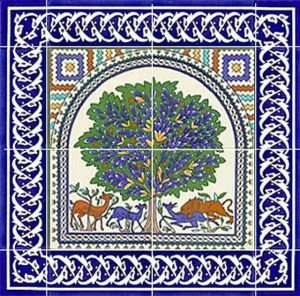
Found on a church/synagogue floor in Jericho. LATE BC: A vast amount of material exists in early psycho-analytical literature on the subject and significance of the Dragon. A great deal of this is well synthesized in The Psychology of the Unconscious by Jung. Briefly it may be said that the Dragon refers to the instincts, to undomesticated libido. We have already defined the libido not as sexual desire alone as the Freudians claim, but as the sum total of all psychic energy, the life force peculiar to any organism. Undomesticated libido would therefore represent that portion of psychic energy which has not yet been recognized and hence employed by consciousness. In consequence, it remains in a crude, undeveloped,, unutilized and undomesticated state. AND/OR: I am a poisonous dragon, present everywhere and to be had for nothing. My water and fire dissolve and compound. Out of my body thou shalt draw the Green and the Red Lion. AND/OR: Roast those things, therefore, and boil them in that which comes forth from the horse’s belly, for seven, fourteen, or twenty-one days. Then it becomes the Dragon eating his own wings and destroying himself; this being done, let it be put in a furnace, which lute diligently, and observe that none of the spirit may escape. And know that the periods of the earth are in the water which is bound until you put the bath upon it. [ 'The Philosophers Stone' / I. Regardie]. BLEMMYES to enlarge. Question. 3 or 4 toes? Or does it matter?
Side note: ''In the Chinese Zodiac the year of the snake directly follows the year of the dragon.'' ['Impossible'].
And/or: There is no Year of the Lion in the Chinese Zodiac.''
A work in progress: "The matter being thus melted and burned, take the brain thereof and triturate it in most sharp vinegar till it become obscured. This done, it lives in the putrefaction; the dark clouds which were in it before it died in its own body will be changed. This process being repeated, as I have described; it dies again as I said, thence it lives....What would be the effect of this libido ascent upon consciousness? Our text tells us. The brain, clearly, is the conscious intellectual life of the spirit. Sharp vinegar must without doubt refer to the libido, the vital living spirit. This assumption is justified in my mind by a significant allusion in a highly mystical and devotional treatise. Here, the spirit is represented as speaking metaphorically to the ego, its persona, in these words: “Wolfs bane is not so sharp as steel; yet it pierceth the body more subtly. Even as evil kisses corrupt the blood, so do my words devour the spirit of man. I breathe, and there is infinite disease of the spirit. As an acid eats into steel, as a cancer that utterly corrupts the body; so am I unto the spirit of man. I shall not rest until I have dissolved it all.”.....It is in this manner that the Stone, which, according to Hermes, is the vine of the Wise, becomes their Wine, which, by the operations of Art, produces their rectified Water of life, and their most sharp Vinegar. The Elements of the Stone cannot be dissolved but by this Nature wholly Divine; nor can a perfect dissolution be made of it, but after a proportioned digestion and putrefaction, at which the operation of the Second Key of the First Work is ended....
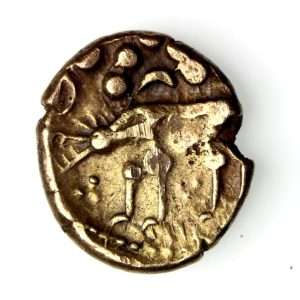 The philosophers give it many names; for sometimes they call it wine, sometimes water of life, sometimes vinegar, sometimes oil, according to the different degrees of Preparation, or according to the diverse effects which it is capable of producing. .... Yet I let you know that it is properly called the Vinegar of the Wise, and that in the distillation of this Divine Liquor there happens the same thing as in that of common vinegar; you may hence draw instruction: the water and the phlegm ascend first; the oily substance, in which the efficacy of the water consists, comes the last, etc....The Lunaria is the White Mercury, the most sharp Vinegar is the Red Mercury; but the better to determine these two mercuries, feed them with flesh of their own species - the blood of innocents whose throats are cut; that is to say, the spirits of the bodies are the Bath where the Sun and Moon go to wash themselves....
The philosophers give it many names; for sometimes they call it wine, sometimes water of life, sometimes vinegar, sometimes oil, according to the different degrees of Preparation, or according to the diverse effects which it is capable of producing. .... Yet I let you know that it is properly called the Vinegar of the Wise, and that in the distillation of this Divine Liquor there happens the same thing as in that of common vinegar; you may hence draw instruction: the water and the phlegm ascend first; the oily substance, in which the efficacy of the water consists, comes the last, etc....The Lunaria is the White Mercury, the most sharp Vinegar is the Red Mercury; but the better to determine these two mercuries, feed them with flesh of their own species - the blood of innocents whose throats are cut; that is to say, the spirits of the bodies are the Bath where the Sun and Moon go to wash themselves....
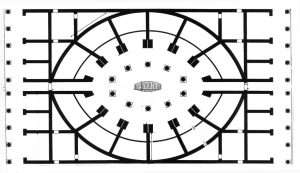
'Bathing' to enlarge.
Dissolved in this way, into what, for lack of other and better words, may be termed a homogeneous magnetic fluid, the Stone may well be called the Vine of the Wise. As these hermetic processes go forward, and the fluidic substance matures and develops in the right direction, it is known as the philosophical Wine. The Wine is extracted from the Vine - that is, the dissolved constituents of the entire personality which, because of this dissolution, evinces a possibility of further and new growth.
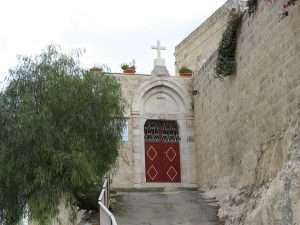
The Wine represents the same substance symbolized by the Vine, but on a higher plane. Because of the attention we have given to it, the wine we extract and develop from the grape vine is a higher development of the source from which it came. In that sense it is an evolution.

Division.
We could likewise suggest that the Unconscious is the Vine, and the libido, which issues from the hidden depths of the psyche, answers to the Wine of which Eudoxus so enigmatically speaks. So far as this alchemical Wine is concerned, as it continues to be subjected to the coction and influence of the fire, further development increases its virulence, so to speak, at which junction it is denominated as a most sharp Vinegar. It is an acid fluid continuing the process of disintegration yet further and in a more subtle way invading the entire mental and psychic sphere, as a preliminary to the reconstruction of the sphere of sensation on a better and diviner plan.....

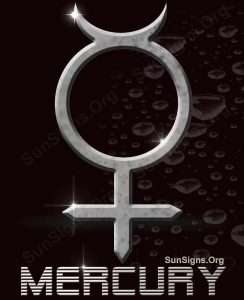 The Mercury of the wise men is a watery element cold and moist. This is their Permanent Water, the spirit of the body, the unctuous vapour, the blessed water, the virtuous water, the water of the wise men, the philosopher's vinegar, the mineral water, the dew of heavenly grace, the virgin's milk, the bodily Mercury; and with other numberless names is it named in the books of the philosophers; which names truly - though they are divers notwithstanding - always signify one and the same thing, namely, the Mercury of the wise men. Out of this Mercury alone all the virtue of the Art is extracted and - according to its nature - the Tincture, both red and white.....
The Mercury of the wise men is a watery element cold and moist. This is their Permanent Water, the spirit of the body, the unctuous vapour, the blessed water, the virtuous water, the water of the wise men, the philosopher's vinegar, the mineral water, the dew of heavenly grace, the virgin's milk, the bodily Mercury; and with other numberless names is it named in the books of the philosophers; which names truly - though they are divers notwithstanding - always signify one and the same thing, namely, the Mercury of the wise men. Out of this Mercury alone all the virtue of the Art is extracted and - according to its nature - the Tincture, both red and white.....

'Bathing' to enlarge.
But I had almost forgot to tell thee that which is all in all, and it is the greatest difficulty in all the art - namely, the fire. It is a close, airy, circular, bright fire: the philosophers call it their sun and the glass must stand in the shade. It makes not the Matter to vapour - no, not so much as to sweat. It digests only with a still, piercing, vital heat. It is continual and therefore at last alters the chaos and corrupts it. The proportion and regimen of it is very scrupulous, but the best rule to know it by is that of the Synod: ‘Let not the bird fly before the fowler.” Make it sit while you give fire, and then you are sure of your prey. For a close I must tell thee the philosophers call this fire their bath, but it is a bath of Nature, not an artificial one; for it is not any kind of water but a certain subtle, temperate moisture which compasseth the glass and feeds their sun or fire. In a word, without this bath nothing in the world is generated....
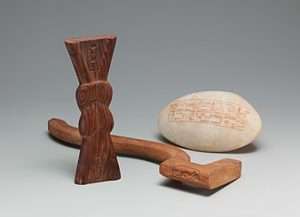

Eight strands each. Sixtyfour in total. A 'generation' thing?
Now, that thou mayst the better understand what degree of fire is requisite for the work, consider the generation of man, or any other creature whatsoever. It is not kitchen fire nor fever that works upon the sperm in the womb, but a most temperate, moist, natural heat which proceeds from the very life of the mother. It is just so here. Our Matter is a most delicate substance and tender, like the animal sperm, for it is almost a living thing. Nay, in very truth, it hath some small portion of life, for Nature doth produce some animals out of it. For this very reason the least violence destroys it and prevents all generation; for if it be overheated but for some few minutes the white and red sulphurs will never essentially unite and coagulate. On the contrary, if it takes cold but for half an hour - the work being once well begun - it will never sort to any good purpose....

Sheaths found.

Here are described the nature of the alchemists’ basic material and the divisions made upon it. The four substances of the verse refer to he four elements of Earth, Air, Water and Fire. “One to two” represent the automatic division of the homogenous magical Agent into its polarities of male and female, the two poles of positive and negative, active and passive, etc., the two opposites which pervade and characterize the whole of nature. These are the two extremes between which, in its unenlightened state, the ego constantly swings like a pendulum. It is this extreme which has to be overcome psychologically. [same].
The Vine of the Wise is the perfected and purified Stone. It bears comparison with the opening verses of the 15th {'fifteen'}chapter of the Gospel of St. John:
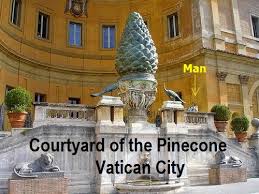 I am the true Vine and my Father is the husbandman. Every branch in me that beareth not fruit he taketh away; and every branch that beareth fruit, he purgeth it, that it may bring forth more fruit. Now ye are clean through with the word which I have spoken unto you. Abide in me, and I in you. As the branch cannot bear fruit of itself, except it abide in the vine; no more can ye, except ye abide in me. I am the vine, you are the branches. He that abideth in me, and I in him, the same bringeth forth much fruit; for without me ye can do nothing.
I am the true Vine and my Father is the husbandman. Every branch in me that beareth not fruit he taketh away; and every branch that beareth fruit, he purgeth it, that it may bring forth more fruit. Now ye are clean through with the word which I have spoken unto you. Abide in me, and I in you. As the branch cannot bear fruit of itself, except it abide in the vine; no more can ye, except ye abide in me. I am the vine, you are the branches. He that abideth in me, and I in him, the same bringeth forth much fruit; for without me ye can do nothing.
 The Vine yields wine for man’s pleasure. But it does so only through the application of an intelligence and a skill external to itself. Itself unaided, it remains but a vine. So by the alchemical artifice of putrefaction and distillation, the crude material of the astro-mental sheath is purified, becoming, so to speak, the wine or spirit thereof. Noteworthy also, is the fact that the Vine and wine generally are sacred in mythology to Bacchus. On the Qabalistic Tree of Life he is referred to Tipharas, the solar centre, the source of reference of all the dying Gods who teach immortality, resurrection, and healing. The glorified and purified consciousness which is the Philosopher’s Stone is likewise a Tipharas attribution - and often is termed the Augoeides, the deathless solar body, the wedding garment of scripture. Thus the Stone is immortality, it is consciousness resurrected from death, gifted with divine healing. [Same].
The Vine yields wine for man’s pleasure. But it does so only through the application of an intelligence and a skill external to itself. Itself unaided, it remains but a vine. So by the alchemical artifice of putrefaction and distillation, the crude material of the astro-mental sheath is purified, becoming, so to speak, the wine or spirit thereof. Noteworthy also, is the fact that the Vine and wine generally are sacred in mythology to Bacchus. On the Qabalistic Tree of Life he is referred to Tipharas, the solar centre, the source of reference of all the dying Gods who teach immortality, resurrection, and healing. The glorified and purified consciousness which is the Philosopher’s Stone is likewise a Tipharas attribution - and often is termed the Augoeides, the deathless solar body, the wedding garment of scripture. Thus the Stone is immortality, it is consciousness resurrected from death, gifted with divine healing. [Same].
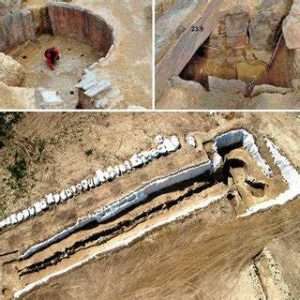
Copious amounts of Cinnabar used at Montelirio Tholos.
 Something hinted at: ''More often when you see the 'twin' sisters on tomb walls, you find Nephthys standing behind Isis, as if she were a shadow of her, eclipsed by Isis. However, looking at a New Kingdom sarcophagus, you see Nephthys standing at the head and Isis at the feet. During the Old Kingdom Pyramid Texts the placement of the goddesses is reversed." [Page 39 'The Union of Isis and Thoth'].
Something hinted at: ''More often when you see the 'twin' sisters on tomb walls, you find Nephthys standing behind Isis, as if she were a shadow of her, eclipsed by Isis. However, looking at a New Kingdom sarcophagus, you see Nephthys standing at the head and Isis at the feet. During the Old Kingdom Pyramid Texts the placement of the goddesses is reversed." [Page 39 'The Union of Isis and Thoth'].
Something unknown 'becoming' known? Manifestation of? Feet or head first?
From a different perspective: ''....Remember how holy women followed Jesus ....and ministered to Him of their substance, and how the three Marys stood before the cross and especially how Mary Magdalene - called the tower - saw the risen Christ first of all before the apostles...'' [Page 88 'Mary Magdalene: Insights from Ancient Magdala / J. Ristine].
Before/After...as a means...?
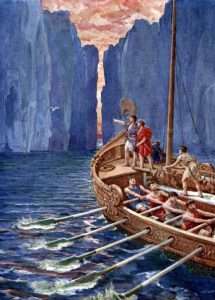
Definition of mizrach: {1} ''an ornamental or sacred picture hung on the east wall of a house or synagogue in the direction of Jerusalem toward which Jews face when in prayer. {2 } the eastern wall of a synagogue.''
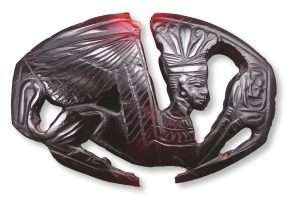
A sard plaque showing Tiye as a winged female sphinx with the cartouche of Nebmaatra. The headdress, with foliage, is identical to other female sphinxes from Western Asia. 'Flattened' ENDS? Any 'handles'?
Working example: {in relation to the parents of Tiye. The wife of Amenhotep III}: "Whether Yuya had any foreign ancestry remains very unclear {Canary Islands?}. His title 'gods father' has been interpreted as indicating a king's father-in-law, but it is a relatively common priestly title {N.B. Was trained as a 'chariot' warrior}. Although Thuya has religious titles associating her with Min and Amun, she was also a hekeret nesut: 'royal ornament'. The precise meaning and implications of this term is uncertain and debated, but it was significant: many high officials, particularly those associated with the palace, were SONS OF WOMEN who carried this title. Thuya's coffin carries a text calling her mother of Tiye, and also of the priest Anun {i.e., brother and sister}. The inscription on a magnificent grano-diorite statue of Anun from the Luxor region, gives him many titles, including 'greatest of seers in the House of the Benben' and second prophet of Amun. Anun's own tomb at QURNA contained a spectacular painting showing him in front of an elaborate attired Amenhotep III and Tiye, who are seated on the dais with a triple canopy over them {'kiosk'?}." [Page 15 'Ancient Egypt' / March-April 2024].
'Raised'.
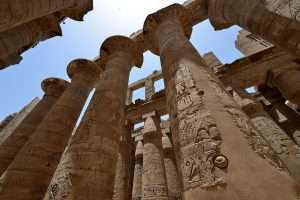
KARNAK: Bird or worm's eye view?
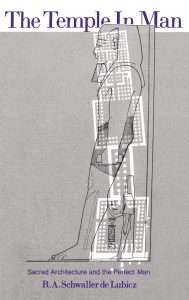
Whose leaning/supporting on who? Ahead/behind to enlarge. 'KNEE'?
"The Symplegades (/sɪmˈplɛɡədiːz/; Greek: Συμπληγάδες, Symplēgádes) or Clashing Rocks, also known as the Cyanean Rocks (Κυανέαι), were, according to Greek mythology, a pair of rocks at the Bosphorus that clashed together whenever a vessel went through. They were defeated by Jason and the Argonauts, who would have been lost and killed by the rocks except for Phineus' advice. Jason let a dove fly between the rocks to see exactly how fast they'd have to row to beat the rocks; the dove lost only its tail feathers. The Argonauts rowed mightily to get through and lost only part of the stern ornament. After that, the Symplegades stopped moving permanently."

The tail end of the ''stinger'' = two swimming ducks.
Side note: "The Symplegades are sometimes identified with (or confused with) the Planctae (Πλαγκταί) or Wandering Rocks, which are mentioned in the Odyssey and Apollonius of Rhodes' Argonautica. In Apollonius's telling, the Symplegades were encountered on the way to the Golden Fleece and the Planctae were encountered on the return voyage."


When the north wind blows. Heading south?
From a different perspective: ''Viewed from the rear, the ship seems to move away from the onlooker and shows that its displacement is ensured by the mizzen-sail, exclusive of the others. Alone it has the wind dead aft; alone, it transmits the energy to the ship gliding over the water. Now the cabalists write artimon {mizzen-mast} and pronounce antemin or antimon, a vocable behind which they hide the name of the subject of the sages {i.e., antimony i.e., has 'flame retardant and medicine properties....also conveys youth, glory, beauty, the most notable part of things....shines like fire''}.... the Flower of all metals FROM the prime substance - 'Fire stone' {i.e., the 'roughhewn' cubic stone { ''of six facets''} i.e., ''a complete coagulation of mercurial water....because our mercury carries within itself the sulphurous principle, rendered soluble'' .....AS long as it remains 'fixed' to the hermetic ship still in the process of 1st stage....has to get to a ''blessed haven'' {Rhodes Island?}....'' [Page 309-11 'Dwellings of the Philosophers'].

Downward Dog pose. {Convex}.

Boat pose? {concave}. Sarah to enlarge.
Side note: "One other point worth clarifying is the peculiar references to Mary's boat having no sails or oars. This lack of propulsion sounds odd...could be an allegorical allusion of some nature. The answer to this riddle lies in the alternative meaning for a ships mast. Just as the blade and chalice that form the outline of the Star of David {male/female} - so too is the ships mast - a phallic symbol - as the ship is a female one. The ship is the vessel that holds the individual or community, but it is the mast that propels it along - so both are required....
'Place of Rowing'.
Thus the curious reference to a ship with no mast merely implies that Mary Magdalene arrived in France without Jesus and most probably without her sons too. 'The legend seems to confirm this when they speak only of Mary arriving with her Egyptian slave; that is her daughter Sarah." [Hypothesis from the author: 'Scota: Egyptian Queen of the Scots' / R. Ellis / Page 17].
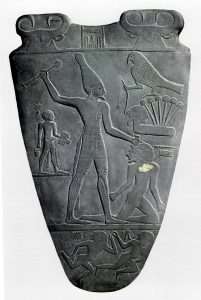 Servant / slave as a means.....?
Servant / slave as a means.....?
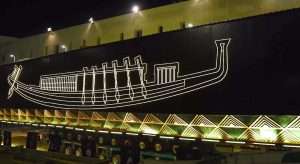
'Body' = vessel. The cedar boat of Khufu.
And/or: The ancients were right to attach so much importance to the idea of the vital spark that sought to rise above earthly confines, and as we have seen repeatedly it is a mistake to believe that this teaching meant that we should despise the body. Through its windows we can catch glimpses of the infinite, which to look upon otherwise would be like looking directly at the sun without protective glasses tor our eyes . We see heaven through a darkened glass indeed, but as much for our own good as for any other reason. This may come as a surprise to those who think that practitioners of esoteric disciplines seek only to transcend the physical. In truth if we are wise we will realize that our physical selves are of the utmost value.
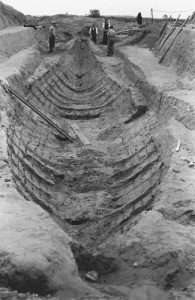
Found S/E England. The N/W TIP OF EUROPE. Sutton-Hoo-Suffolk: "Before any vessel may be filled with any specific content, it must be empty. Before a single number is accountable, Zero must be assumed. No creation is possible without the void. Writing can only be recorded on BLANK paper, or sound on a clean tape." {Page 24 'Magical Ritual Methods' / W. Gray}.
From their safe harbourage we depart on voyages of discovery and to them we return, as from any joumey, to the welcome of home {'bower'?}. Microcosmically, there is an echo here of the souls longing for the place of its origin, wherever we may personally believe this to be. In our long search for the promised land, the paradisial home of our exiled states, we learn that there must always remain a point of contact with the roots of BEING. While we yet remain in incarnation the body is that point of contact for us. So before flying forth towards whatever infinite realm you seek or are drawn, remember to be in tune with yourself as well as with the infinite. Make friends with your human chariot before you leave it behind, and be sure to return to its welcome embrace at your journey’s end ." {'The Western Way' / C+J Matthews}.
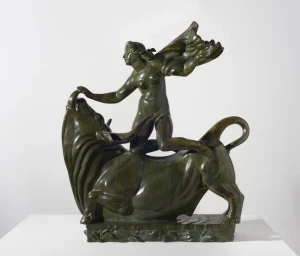
Silk scarf? kneeling? 'Hold ones tongue'?
And/or: In Greek mythology, Europa (/jʊəˈroʊpə, jə-/; Ancient Greek: Εὐρώπη, Eurṓpē, Attic Greek pronunciation: [eu̯.rɔ̌ː.pɛː]) was a Phoenician princess from Tyre and the mother of King Minos of Crete. The continent of Europe is named after her. The story of her abduction by Zeus in the form of a bull was a Cretan story; as classicist Károly Kerényi points out, most of the love-stories concerning Zeus originated from more ancient tales describing his marriages with goddesses. This can especially be said of the story of Europa.
[1]
Early reference to Europe is in a fragment of the Hesiodic Catalogue of Women, discovered at Oxyrhynchus.[2] The earliest vase-painting securely identifiable as Europa dates from the mid-7th century BC.[3]
Greek Εὐρώπη (Eurṓpē) may have been formed from εὐρύς (eurus), "wide, broad"[4] and ὤψ/ὠπ-/ὀπτ- (ōps/ōp-/opt-): "eye, face, countenance".[5] Broad has been an epithet of Earth herself in the reconstructed Proto-Indo-European religion.[6]
It is common in ancient Greek mythology and geography to identify lands or rivers with female figures. Thus, Europa is first used in a geographic context in the Homeric Hymn to Delian Apollo, in reference to the western shore of the Aegean Sea.
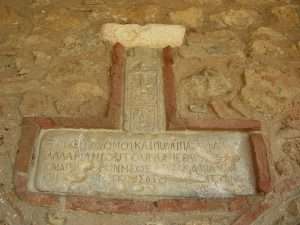
Wide or narrow awareness?
From a different perspective: "When I practise meditation I need a simple focus for my attention to keep me conscious, otherwise I’ll drift off into deep sleep instead of becoming deep awake. I find the breath is perfect for this. Sensual breathing is very pleasurable and I enjoy returning my attention to my breath if it starts to wander. Inevitably my thoughts come and go. But I don’t try to stop thinking. That’s impossible. If my thoughts are agitated I simply become conscious that I’m listening to myself talking to myself. I pay attention to the silent presence which is listening. I become conscious of being spacious awareness within which the thoughts are arising." [Page 185 'The Mystery Experience'].
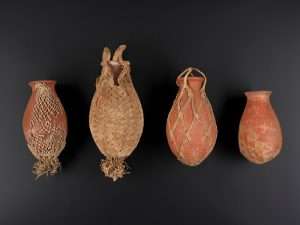
From a different perspective: Found with the Qurna Queen and child: ''under a rocky outcrop {'overhang' / overlook?} on the north side of the valley at Thebes.''
N.B. At CARAL - 'six' pyramids. In the foundations of the main one {central?} are found rocks enclosed in 'net bags' {omphalos stone}: "stacked up against the inner retaining walls - to give the structure strength."

'flat'?
The very FIRST civilisation in the America's where no weapons or pottery is found {'untouched by fire'}. Culture based on making fishing nets {'cotton'} with their neighbours on the coast. Took weaving to a new level {'eight'}. Woman's skeleton found with 'flattened' head. ['Blowing Up History' / S3 EP2].
Madeira to enlarge.
A safe harbour. A NATURAL ONE. As one example the harbour that began the Nazca culture. The one that has its most ancient geoglyph - the candelabra.
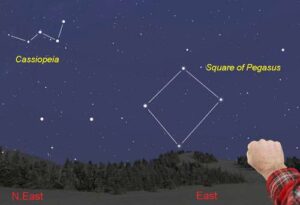 REFRESHER: When I practise meditation I need a simple focus for my attention to keep me conscious, otherwise I’ll drift off into deep sleep instead of becoming deep awake. I find the breath is perfect for this. Sensual breathing is very pleasurable and I enjoy returning my attention to my breath if it starts to wander. Inevitably my thoughts come and go. But I don’t try to stop thinking. That’s impossible. If my thoughts are agitated I simply become conscious that I’m listening to myself talking to myself. I pay attention to the silent presence which is listening. I become conscious of being spacious awareness within which the thoughts are arising. In the same way that a puddle of water becomes transparent if you stop splashing in it and let the mud settle, so my thoughts becomes less agitated when I stop focusing my attention on them. Then my mind naturally becomes calm, which means I can easily sink into the mystery experience. There was a time when I had a macho approach to meditation. I saw myself as a spiritual warrior fighting an internal battle to silence my thoughts. I viewed the thinking mind as an ‘enemy’ that I needed to subdue. But I don’t approach meditation like that these days. Now I’m much kinder to myself. I simply allow things to be as they are. If my mind is agitated, I let it rage until it’s spent. When my mind becomes still, I treasure the calm. [Page 185 'The Mystery Experience' / T. Freke].
REFRESHER: When I practise meditation I need a simple focus for my attention to keep me conscious, otherwise I’ll drift off into deep sleep instead of becoming deep awake. I find the breath is perfect for this. Sensual breathing is very pleasurable and I enjoy returning my attention to my breath if it starts to wander. Inevitably my thoughts come and go. But I don’t try to stop thinking. That’s impossible. If my thoughts are agitated I simply become conscious that I’m listening to myself talking to myself. I pay attention to the silent presence which is listening. I become conscious of being spacious awareness within which the thoughts are arising. In the same way that a puddle of water becomes transparent if you stop splashing in it and let the mud settle, so my thoughts becomes less agitated when I stop focusing my attention on them. Then my mind naturally becomes calm, which means I can easily sink into the mystery experience. There was a time when I had a macho approach to meditation. I saw myself as a spiritual warrior fighting an internal battle to silence my thoughts. I viewed the thinking mind as an ‘enemy’ that I needed to subdue. But I don’t approach meditation like that these days. Now I’m much kinder to myself. I simply allow things to be as they are. If my mind is agitated, I let it rage until it’s spent. When my mind becomes still, I treasure the calm. [Page 185 'The Mystery Experience' / T. Freke].
Still waters run deep.

To sublimate higher/lower or lower/higher or does it matter? ALL FROM the 'cross of matter'....as a means...?
 And/or: ''Because the awakened one puts himself behind, he steps ahead. Because he gives way, he gains. Because he is selfless, he fulfils himself. The still is the lord of restless.'' Lao - Tzu.
And/or: ''Because the awakened one puts himself behind, he steps ahead. Because he gives way, he gains. Because he is selfless, he fulfils himself. The still is the lord of restless.'' Lao - Tzu.
'Foremost of the Westerners'.
'153' ?
And: ''She had a task, one commissioned by an 'angel' {higher?}, according to Mark's account. 'Go, tell his disciples and Peter: He is going AHEAD of you into Galilee. There you will see him, just as he told you.'' [Page 75 'Mary Magdalene' / J. Ristine].
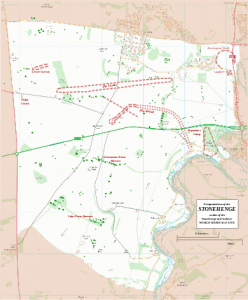
Convex / concave or both?
From a different perspective: ''....Remember how holy women followed Jesus ....and ministered to Him of their substance, and how the three Marys stood before the cross and especially how Mary Magdalene - called the tower - saw the risen Christ first of all before the apostles...'' [Page 88 'Mary Magdalene: Insights from Ancient Magdala / J. Ristine].
And/or: Before/After...as a means...?
Working example: Isis / Nephthys. As seen either at the head or feet of coffins. Which and why?
Refresher: ''She had a task, one commissioned by an 'angel' {higher?}, according to Mark's account. 'Go, tell his disciples and Peter: He is going AHEAD of you into Galilee. There you will see him, just as he told you.'' [Page 75].
Side note: ''2012 {'twelve'}: The Clock Tower is renamed the Elizabeth Tower to honour HM Queen Elizabeth II's Diamond Jubilee. 2017: The largest and most extensive conservation of the Elizabeth Tower { in the Palace of Westminster} begins to preserve the clock tower for future generations.... The moniker Big Ben has been in use for over 150 years, and the nickname was originally applied only to the enormous bell inside the tower. The Great Bell received it's sobriquet in honor of Sir Benjamin Hall, the First Commissioner for Works, who raised Big Ben to its current place atop the tower.''
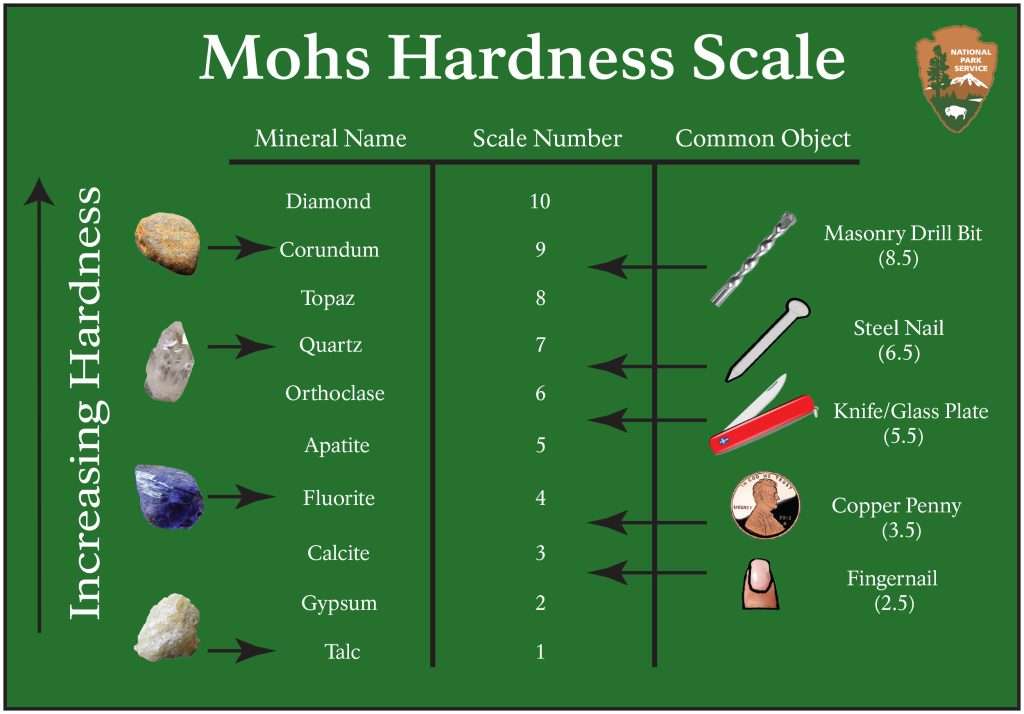 ''Diamonds (10) also show a variation in hardness (the octahedral faces are harder than the cube faces). For further information see articles from the American Mineralogist on microhardness, the Knoop tester, and diamonds. Mohs' hardness is a measure of the relative hardness and resistance to scratching between minerals.''
''Diamonds (10) also show a variation in hardness (the octahedral faces are harder than the cube faces). For further information see articles from the American Mineralogist on microhardness, the Knoop tester, and diamonds. Mohs' hardness is a measure of the relative hardness and resistance to scratching between minerals.''
''The Mohs scale of mineral hardness is based on the ability of one natural sample of mineral to scratch another mineral visibly. The samples of matter used by Mohs are all different minerals. Minerals are chemically pure solids found in nature. Rocks are made up of one or more minerals. As the hardest known naturally occurring substance when the scale was designed, diamonds are at the top of the scale. The hardness of a material is measured against the scale by finding the hardest material that the given material can scratch, or the softest material that can scratch the given material. For example, if some material is scratched by apatite but not by fluorite, its hardness on the Mohs scale would be between 4 and 5...''
''Ten minerals make up the Mohs Scale from softest to hardest, they are talc (1), gypsum (2), calcite (3), fluorite (4), apatite (5), feldspar (6), quartz (7), topaz (8), corundum (9) and diamond (10).''
Soapstone (also known as steatite or soaprock) is a talc-schist, which is a type of metamorphic rock. It is composed largely of the magnesium-rich mineral talc. It is produced by dynamothermal metamorphism and metasomatism, which occur in subduction zones, changing rocks by heat and pressure, with influx of fluids but without melting. It has been a carving medium for thousands of years.


Common factors?
A working example: The temple of Serabit el-Khadim is located on a plateau on top of a mountain in south-west Sinai. From earliest dynastic times, pharaohs sent expeditions to Sinai in search of turquoise and copper, and abundant seams of turquoise were found in the Serabit region. Hathor had the epithet ‘Lady of Turquoise’, so it is no surprise to find a temple dedicated to Hathor near the mine workings....The temple is compact, about 70m long by 35m wide, but full of stelae erected along its processional routes. Although the temple that we see today was started by Senusret I, Petrie reports finding the breast and back of a stone falcon, inscribed with the cartouche of Sneferu, which he thought dated to that king’s reign (c.2613-2589 BC). This would make it the earliest object found at the site, but Gardiner (1955) describes this dating as ‘very suspect’. It is probably a later piece on which the cartouche of Sneferu was written to celebrate his memory.
Petrie also found a small head of green steatite {soap stone}. It is only 7cm high, but would have been part of a statuette, around 30cm tall, dedicated to Hathor. The cartouche on the forehead identifies Queen Tiye, wife of Amenhotep III. The head’s features follow the artistic principles of that time, with almond-shaped eyes and a thin nose. The down-turned mouth is often seen in portrayals of Tiye, and has led to her reputation as a tough character. Petrie writes of the ‘haughty dignity of the face’ and how the expression is one of ‘disdain without malice’. ['Page 52 'Ancient Egypt' - Nov-Dec 2024].
Happy or sad?

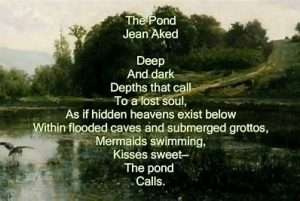 Refresher: "......obedience to the voice of the Great Teacher in his heart. That soundless voice, speaking within his heart, drowns for him all the clamourous judgements of the world. Listening ever to the Voice of that inner Lord, he pursues his way, unperturbed as the earth is unperturbed, firm as a pillar {'tower'?}, clear as a waveless lake." [ Chapter 12, 'The Yoga of the Bhagavat Gita']. That link to the ''teacher'' of the Dead Sea Scrolls. Explained within.
Refresher: "......obedience to the voice of the Great Teacher in his heart. That soundless voice, speaking within his heart, drowns for him all the clamourous judgements of the world. Listening ever to the Voice of that inner Lord, he pursues his way, unperturbed as the earth is unperturbed, firm as a pillar {'tower'?}, clear as a waveless lake." [ Chapter 12, 'The Yoga of the Bhagavat Gita']. That link to the ''teacher'' of the Dead Sea Scrolls. Explained within.
Tower of the Fish?
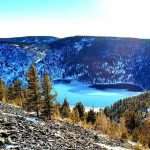
A side step: "This book deals with the esoteric significance of a 13th century zodiac in one of the most beautiful churches in Italy, within the framework of a true symbolism...This study concerns itself with such topics as esotericism, mediaeval history and lore, astrology, secret writing, ecclesiastical doctrines and art history..." ['The Secret Zodiac'].
Follow the title of the book to 'see' it in its universal 'framework'.

Where have you seen it before?
"Ranking equal in excitement with the Neanderthal bear - skull altar is the carved stone zodiac of thirteen signs fashioned by the North American Mound Builder culture, and discovered in the Ouachita River, [near bend of ] Hot Springs, Arkansas. The Mound Builders flourished around the time of Christ, all over the eastern half of North America, so this zodiac as an artefact is some 2000 years old. Its tradition, however, is at least 20,000 years old - for in Israel we find another thirteen - zodiac inlaid in the floor of an old synagogue. One could perhaps, argue that the Mound Builders and the ancient Hebrews had independently conceived of a thirteen zodiac, based on the lunar year, if both were moon worshipers. However, there is a clincher. Both zodiacs involve a spider." [Chapter 10, 'Cities of Dreams'. Mentioned elsewhere].
What do spiders 'catch'?
''She likes to keep them alive to be eaten later.'' ['Lord of the Rings: The Return of the King' 2003].

'Web' of manifestation?
The author Stan Gooch attempting to define all the cultural mysteries to moon symbolism only... all the way back to Neanderthal man; and that relationship to Cro-Magnon man. This subject defined solely as ''metaphysical meanderings'' [Chapter 11].

''Gold fly-shaped pendants from ancient Egypt have been interpreted as military awards, possibly forming part of an honorary Order, that were given by the king to symbolise a brave soldier's persistence in battle.''
Question. When all the available evidence is put forward and understood beyond its first impressionable one , what do you think? See Lethbridges book on 'Gog Magog' to understand something further. Then try ''Spider''.
N.B. Mary Magdalene was known as the 'thirteenth' disciple.
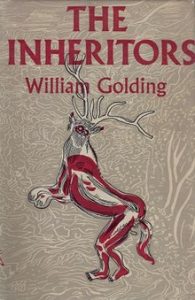
‘The heavy matter through which we move is not the antithesis of cosmic consciousness but its densest and most inert expression’ (216). The first stirrings of consciousness often appear crude and barbaric but, within the context of their times, they are valid signs of a people attempting to relate to the hidden realities behind appearances; they are the foundations of religion.' {The Western Way: A Practical Guide to the Western Mystery Tradition / C. + J. Matthews}.
Side note: Question. Cro-Magnon man in relation to Neanderthal man - which understood 'objectivity' {and all its benefits} - first? Or does it matter?
'The Implied Spider: Politics and Theology in Myths' / W. Doniger.
"Everyone has an internal thought process: that silent other self who speaks to you; the one you debate with." [First sentence; first paragraph; first page of the book by Q. S. Lam].
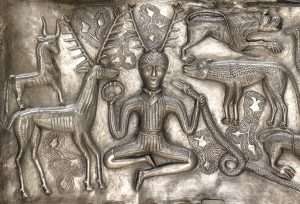
Sun or moon? Linen or silk? Horn or antler?
"The concept of the external archetype is important for the present book, for it does look as if Neanderthal had evolved an archetypal response to the moon - probably because of the , again, probably greater influence of the moon on the Neanderthal female menstrual cycle - while Cro-Magnon, for his part, had evolved an archetypal responce to the sun." [Chapter 17, 'Cities of Dreams'].
As mentioned in the same book the Mound builders had a fascination with the numbers 12 and 13. As does Gobekli tepe [not mentioned]. The 'spider' also important - or more importantly what it implies to the overall subject - not just one aspect of it. That same symbol that was also used within the DESIGN of the overall plan of the Nazca Lines. Those 'eight' legs {among others} that represent something other than the obvious.

Spiral, threads and …..?
"We can say then with confidence that the human responses to the numbers 3 and 7 and 13, and the seven - fold maze, and the snake and the spider are not archetypal, since we cannot identify in ourselves any biological situation of which they form part."..."These are entirely sociological and historical matters, and our reaction to them purely the result of cultural conditioning. There are not seven etheric chakras in the body, as the Indian esotericists claim [no one else has found them], and still less do they correspond to the endocrine glands, as if often alleged, of which there happen to be nine. Nor are there seven openings in the body, unless you are prepared to count the two eyes, ears and nostrils as one each." ['Cities of Dreams'].
A good example [if only for this reader] of not working through those 'first impressions'. To understand the whole picture define its parts, [or 'keys']. In other words using the above example look up [in the usual box] such words as ''chakras'' or ''nine'' or ''seven'' or ''spider'' or ''snake''.
That link to the legend of the 'lost' thirteenth zodiac sign - relative to the individual.
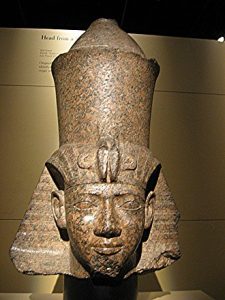
'Dome' on top of ''tower''?
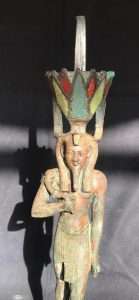
From the 'waters' of creation {Self becoming?} - a lotus flower.
From a different perspective, i.e.,a {working?} one..."The Uxmal priest and priestess who were to lead the ceremony laid special cloths on the ground to form an altar. Many crystals and ceremonial objects were arranged on the altar. Finally, first one, then two, and eventually thirteen Mayan crystal skulls were laid out on the altar in a tight circle. And then a Mayan weaving was placed over them, hiding them from view, for it was not quite time yet for their ''special'' ceremony...About fifteen or so elders and indigenous people were asked to join the inner circle...The Mayan priestess lit ceremonial herbs and incense in a small, ancient cauldron, filling the air with a pungent scent. Then she raised her arms as her male companion blew the sound of the conch and opened the ceremony with prayers to the four directions...A woman said to me later that she felt all through the ceremony that the Tower of Babel was slowly crumbling. So perhaps in coming together in this way with the Mayans in this ancient ceremony we were symbolically ending the divisions among countries, cultures etc...As the last smoke of the cauldron drifted over the crowd and the ceremony ended we came together like old friends from long lost tribes...We were a rainbow of One Spirit {'aura'?}" ['Serpent of Light Beyond 2012'. Emphasis, this readers].

'Spirit' or 'Soul' ?
''Nasturtium being a flowering plant is sometimes translated as 'nose twister' because of its pungent scent.'' ['Imossible' ].
N.B. Symbol of the 'lower' will is the altar.
'Tower of Babel' in relation to lower. 'Rainbow' = natures equivalent of 'Gnosis' {'higher'} Representation of - within landscape symbolism, i.e.,what are the 'constituents' of a rainbow; how are they made; what do they 'connect' ? Try ''flint'' for an 'alternative' viewpoint but on the same 'pole'.
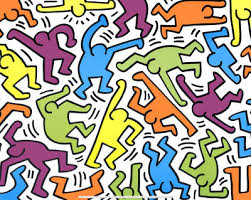 "In the circumstances, a good deal of nonsense has been written in recent years by the psychoanalysts and feminist writers [of both sexes] on the alleged psychological [i.e.,archetypal] significance of items mentioned in the previous paragraph [snake, spider, mazes, 'numbers' etc. This readers input]. But the clear position is that our response in these cases is to be understood as sociological and historical, as purely the outcome of cultural practice and conditioning. It is very important that we grasp this truth. For otherwise we shall have people continuing to claim that precisely designed seven-fold mazes, amongst others, are independently generated psychological 'archetypes' - and not therefore, and on the contrary, vital clues to the origins of our civilization." ['Cities of Dreams'].
"In the circumstances, a good deal of nonsense has been written in recent years by the psychoanalysts and feminist writers [of both sexes] on the alleged psychological [i.e.,archetypal] significance of items mentioned in the previous paragraph [snake, spider, mazes, 'numbers' etc. This readers input]. But the clear position is that our response in these cases is to be understood as sociological and historical, as purely the outcome of cultural practice and conditioning. It is very important that we grasp this truth. For otherwise we shall have people continuing to claim that precisely designed seven-fold mazes, amongst others, are independently generated psychological 'archetypes' - and not therefore, and on the contrary, vital clues to the origins of our civilization." ['Cities of Dreams'].
Strangely enough - understanding the 'full' story gives a deeper meaning to those possible ''origins''. Before that bigger question can be asked. Fact or fiction. A possibility or not?
As is the intent of: "A divergent thought intervened, breaking Thomas's continuous attention. It was then that the symbol of Maitre Jacques dissolved into an image he had registered into his mind from childhood: an angel and a devil were tormenting a poor old man, each trying to lead him in its own direction. Freed by this distraction, Thomas's imagination started to wander, mixing belief with superstition, symbol with fantasy, and mocking fundamental judgements such as 'good and 'bad' {'feast of fools' link?}. It evoked legendary temptations and produced the image of Mephistopheles and Faust, leading his rationalizations instinctively to take revenge against the attention he had been giving to the suggestions of Maitre Jacques. That's the very kind of fiction i must watch out for. Its easy to invent under pretext of initiation! Hold on to your common sense, Jean Thomas. Humanity has been able to arrive at the age of reason and must not take these fairy tales seriously!''... Why this reaction that suddenly jarred him with revolt? Whom was he revolting against? Against the idea of Maitre Jacques? Self reproach forced him to look at himself..." ['Journey Into Light' / Isha Schwaller de Lubicz].
Maitre Jacques in relation to 'higher'. Jean {John} Thomas in relation to 'lower' as a means...?
{N.B. Only read when a good foundation has been established - but understanding who the genuine authors are of this 'subject material' gives deeper answers to those internal questions while allowing one also to answer {among others} - such riddles as 'Fulcanelli'}.
REFRESHER: "Everyone has an internal thought process: that silent other self who speaks to you; the one you debate with." [First sentence; first paragraph; first page of the book by Q. S. Lam].
Side note: The same question could be asked to the contents within the book 'The Sword in the Sun' / A. Duncan. Enlarged elsewhere.
Question. Parables {parody?} only? Fairy tales?
The same question can be applied to the following..."There is really no doubt that the original prehistoric moon calendar served purely religious purposes. Even in historic times, Jewish and Islamic holy festivals were regulated by the moon - while sun calendars were employed in respect of purely civic events. There is no practical point in having two calendars. No, the position is that an ancient, traditional calendar - serving some non practical purpose - has been partly replaced by one of more usefulness for everyday affairs." ['Dream Culture of the Neanderthals' / S. Gooch]. Try ''Ishtar'' - for an alternative viewpoint - and/or subject material to define ''some non practical purpose''.

'The Way of Banksy' {Even money?} OR 'Javelin Prayer' {Odds-on?}. As one of the means {or ways} to ....?
Another example. The Sumerian equivalent for the 'Benben', [or Benbenet.Explained elsewhere]...is the word ’Shem’. Because it looks like a missile. Mr Sitchin concludes therefore; almost instantly; then that is what it must be. Thereafter he uses no other word to describe it other than "missile", Or, as indicated on page 149, a 'sky-borne vehicle'. The word 'shem' derived from chapter eleven, of Genesis, in relation to the 'Tower of Babel'. Where all... 'spoke one language'. Exoteric equivalent of that 'inner' language that only this subject explains. Once understood, that true 'language', has now been found, [verified, of sorts, within the book 'The Sacred History by J. Black].
"The Arcanum "The Tower of destruction" teaches a general and universal law that it presents in the comprehension for of the tower of Babel. A general and universal law - this means to say a law that operates on a small and large scale - in individual biography as well as in that of mankind, and in the past, present and future equally. According to this law, he who rebels against his ''higher self'' will no longer live under the law of the vertical but rather that of the horizontal, i.e.,he will be a ''fugitive and a wanderer on the earth." [genesis iv,12]." [Extract from the book by Tomberg. 'Letter 16' ].
Cain and Abel?
N.B. Planets = ''Wandering Stars''. As a means...?


Restoration = middle ground = renewal. 'Gap/void' to enlarge.
Side note: {something to ponder on relative to the above}: "From the above inscription {i.e., in relation to the Memphite Theology, i.e.,the ''union'' of something}, we can deduce that, at some point, ancient Egyptians regarded the land of Egypt as shared between Horus and Seth. Then, for reasons that are not clear, Horus was given total control of the whole of Egypt. Could it be that the Memphite Theology, reflects historical events that occurred in the late 2nd and early 3rd dynasties? Could it explain the placing of Seth on the serekh of King Peribsen, and the placing of both Seth and Horus on the serekh of King Khasekhemwy, only to revert back to just Horus on Netjerykhet's serekh? This idea has indeed occurred to some Egyptologists." ['Imhotep the African'].
Serekh = ''facade'' = 'Face on' as opposed to {say} 'in profile'? Enlarged throughout.
Refresher: "Mars, is called the star of the East, or Red Horus, sometimes Horus of the Horizon." {Her-Bak}.
And/or: Could the 1st {i.e., Scorpion King?} and the 4th dynasties be included. Especially the 'unfinished' or 'collapsed' pyramid of 'Djed'- efre?
Recall the significance of ''four'' - if only in the ''horizontal'' sense of the 'word' {logos}.
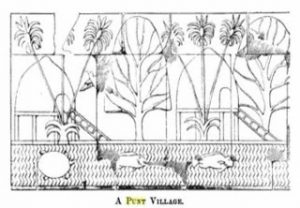
Raised {'circular'?} 'Huts' in the mythic Land of Punt. A ''new conception''? As a means....? Question. 'Turtle' or tortoise?

'Wedding' ring? carapace?
And/or: {something hinted at}: " After the stress and shock of the sudden awakening to the fundamental error of separateness - after the lightening flash of true knowledge has toppled the crown off the Tower of Common Sense - as shown in the 16th Major Trump, there comes a period of calm and gradual growth. In the second stage which we considered in the previous lesson, there is a sudden and painful overthrow of the 'false' wisdom of the world, a momentary, but never-to-be-forgotten glimpse of reality, of the absolute unity of life. In the 'third' stage this new conception of the Oneness of all, begins gradually to unfold. What happens to this unfoldment, and the specific activities involved therein, we may discover from the study of the 17th key of the Tarot....This picture develops the esoteric meaning of the Hebrew letter Tzaddi, named the ''fish hook''....That which pulls the 'fish' {Nun, i.e.,14th letter} OUT of Water {Mem, i.e., 13th letter}….''To hook'' is to draw, to entice, to procure....Has a particular application to the Christian aspects to the Ageless Wisdom, i.e., Jesus chose fishermen for disciples, and promised them that they should become 'fishers of men'...." [Pages 96/159 of the book by P. F. Case. Vol 1]. Try ''153''.
'Tower of the Fish'?
INTERNAL process of an understanding of something? REGARDLESS of subject?
''Unity'' in relation to ''lower/upper'' and/or ''higher'' and the word ''Yoga'' ? ALL as a means....?
''Moses'' ?

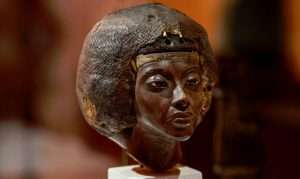
"The Great of Dread in the Foreign Lands."
Apply the above to ''get a hang'' on the following: ''....since women played the leading role in the Dionysos cult. It was expressly added that the priestesses of Dionysos were the successors of the daughters of Semachos {i.e., foreign 'hero' - who is speculated to be the originator of the said 'cult' - from a 'mining' region 'S/E' Attica}. Another version mentions only one daughter, who received a 'deer skin' {nebris} from a god as a present. This was more than the gift of a special type of garment. It indicates the bestowal of a rite in consequence of which the deer skin could be worn: nebri-zein also means the rending of an animal. The cult action in which the sacrificial animal was dismembered, however, required at least two persons..."
REFRESHER: 'Sacrifice something of the lower to understand something of the higher'.
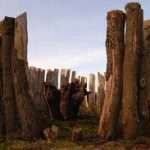 ''Rending'' = 'something ripped apart, as in lightening splitting a tree' {or ''tower''?}.
''Rending'' = 'something ripped apart, as in lightening splitting a tree' {or ''tower''?}.
Oak? as a means....?
Try ''second/ry'' / ''sea people'' for something further.
'Fisher of Men' and/or archetypes/hieroglyphs?
Try ''deer''.
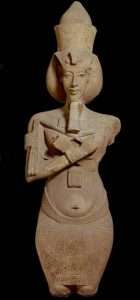
''Severed, lost abandoned''?
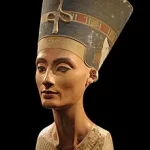
''New soul''?
Side note: ''We have briefly met Kiya, the other known wife of Akhenaten, noting that she held a title, Greatly Beloved Wife of the King, that appears never to have been borne by any other individual in Egyptian history. Her origins are wholly unknown, although, like Nefertiti, there have been speculations that she might have been a foreigner....'' [Page 50 'Nefertiti' / A. Dodson].
Question. Which sounds the 'Greater' title: The ''beautiful lady has come'' OR ''greatly beloved''?
'Daughters of Saturn: From Fathers Daughter to Creative Woman' / P. Reis].
Refresher: ''Three of the Amarna letters - a collection of hundreds of cuneiform tablets discovered in Akhenaten's capital city of Akhetaten in the late 19th century - mention Meritaten using the name Mayati. In two of these letters, she is said to have quasi-royal status. After Nefertiti's death, however, Meritaten appears without her previous title of royal daughter, but as 'first lady' and later with a nearly royal rank....At least one artefact from Tutankhamun's tomb which belonged to the 'queen pharaoh', has two cartouches side by side, one with her coronation name, Ankhkheperure, and the other her birth name, Meritaten.'' [Page 35 'Archaeology' / September-October 2022].

''Take this as a sign of the wholeness you have become.'' Jung's dream prior to death.

''His Beloved''. Should he not have mentioned that to a teenage girl. Prior to taking sacred vows? Kingship or something else? Question. ''Lets talk about it'' - a phrase often used by members of the same family. Why do they NOT talk about anything other than that comfortable subject - 'climate change'? To lead by example?
''The mythic search for the Beloved of the Soul is synonymous with the soul's journey throughout life in an effort to reclaim the parts of the self that have been severed, lost or abandoned. In doing so, we create a new body and soul; a holy place {'Adytum'?} more suited to contain the depth mysteries and realities that we discover along the journey. To 'die' to one's self and to be remade into a more living, spiritual being is part of the journey of Osiris and the task of Isis, so that a living monument {'Boulder'?} may be erected to signify the depth of what has been lost and is now reclaimed, the depth of what was hidden to the eyes and is now within the 'heart' of the sojourner, revealed.'' [Page 353 'Dreams of Isis' / N. Ellis].
'Daughters of Saturn' / P. Reis.
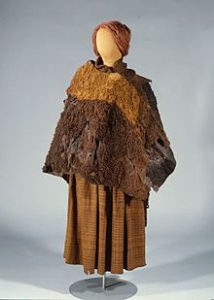

'Severed'?
A working example: Huldremose Woman, or Huldre Fen Woman, is a female bog body recovered in 1879 from a peat bog near Ramten, Jutland, Denmark. Analysis by Carbon 14 dating indicates that she lived during the Iron Age, sometime between 160 BCE and 340 CE. The mummified remains are exhibited at the National Museum of Denmark....The body was found with the legs bent behind the back, and a nearly severed right arm. It is thought that the arm was damaged before she died.[2] Apart from this, the corpse was well intact.....
Unlike many other bog bodies, which are often found naked, the Huldremose Woman was found clothed with an array of accessories. Analysis of these items, including the rare evidence of plant fibre textile, has shown that peoples of the Scandinavian Early Iron Age had knowledge of and used a wide but previously unrecognized range of textile weaving and dyeing technologies, as well as animal skin technologies.[5] Her clothing has undergone extensive analysis by scientists at the Danish National Research Foundation's Center of Textile Research and the National Museum of Denmark.
Huldremose woman wore several layered sheep skin capes with the woolly sides turned outward. These were of a complex construction...."The two skin capes are made from well-prepared, curly fleeces. The outer cape is the largest, measuring 82 cm in height and 170 cm in width (Fig. 3). It is constructed of five primary, rectangular skin pieces, with two minor triangular pieces under the yoke. Most pieces are from dark sheep skin, but on the fur side, it has an insertion of four light goat skin pieces. On the flesh side, it has an upper, front lining of dark sheep skin, which is a unique detail.

Emphasis on right 'breast' and 'knees'? "Hands"?
The inner cape is slightly smaller, measuring 80 cm in height and 150 cm in width (Fig. 4). It is constructed of 7-8 primary sheep skin pieces, mostly rectangular and 22 secondary patches of sheep, goat and deer skin. Both capes have an asymmetrical design with a slanting neckline."[5]

“Most certainly, I tell you, one who doesn’t enter by the door into the sheep fold, but climbs up some other way, is a thief and a robber."
She also wore a wool plaid scarf, fastened by a bird bone pin, and a wool plaid skirt. Analysis by scientists at the National Museum of Denmark has shown that the colour of the skirt was originally a blue or purple plaid, while the scarf was a red plaid.[6] Chemical dye analyses showed the use of natural plant dyes and mordants and revealed that threads of at least 5 colours were woven to create the complex plaid patterns. Impressions on the skin of the Huldremose Woman, as well as a small amount of surviving degraded fibres, suggest that below her wool clothing, she wore a white inner garment made from plant fibres that reached from the shoulders to below the knees....
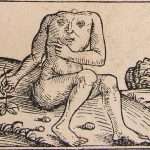
Remedy?
Later forensic analysis found evidence of strangulation, her hair was tied with a long woolen rope, which was also wrapped around her neck several times....
Many of the bog bodies were young adults, adolescents and children, who seemed to be largely fit and healthy. Some were naked except for a well-preserved piece of rope, a hat or a cloak, and sometimes their clothes were buried separately from them nearby in the bog.....
In America, bogs have a pleasant association with New England’s cranberry harvest and traditional Thanksgiving dishes. In Northern Europe, bogs offer more sinister produce, from wads of ancient butter to leathery chunks of human bodies—which give archaeologists a view of life and death as it was centuries ago....
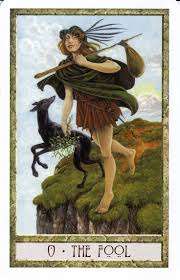
Head in the clouds?
 Most bog objects have been discovered during the process of harvesting peat, an organic soil composed of vegetation like sphagnum moss that has decayed over time. When dried, it can be burned and used as a fuel. But peat in a cold wetland environment also creates anoxic (oxygen-free) conditions that slow the decomposition of organic remains in the bog. The combination of cool climate and anoxic water in these northern bogs makes conditions just right for long-term preservation.....Numerous examples of “bog butter” have emerged in Scotland and Ireland. These stinky, yellowish globs can weigh up to 50 kilograms (110 pounds) and are generally found in wooden containers or animal skins for protection. Dating to 3000 BCE, some of the butter is made out of dairy fat, and some of it is made from lard or tallow, according to isotope testing. Butter was ubiquitous in many past eras, acting not only as a food but as a salve for wounds and a substitute for cash in paying taxes, so it’s also possible it was buried to protect a family’s wealth from thieves....
Most bog objects have been discovered during the process of harvesting peat, an organic soil composed of vegetation like sphagnum moss that has decayed over time. When dried, it can be burned and used as a fuel. But peat in a cold wetland environment also creates anoxic (oxygen-free) conditions that slow the decomposition of organic remains in the bog. The combination of cool climate and anoxic water in these northern bogs makes conditions just right for long-term preservation.....Numerous examples of “bog butter” have emerged in Scotland and Ireland. These stinky, yellowish globs can weigh up to 50 kilograms (110 pounds) and are generally found in wooden containers or animal skins for protection. Dating to 3000 BCE, some of the butter is made out of dairy fat, and some of it is made from lard or tallow, according to isotope testing. Butter was ubiquitous in many past eras, acting not only as a food but as a salve for wounds and a substitute for cash in paying taxes, so it’s also possible it was buried to protect a family’s wealth from thieves....
The bog-preserved people are technically natural mummies, but their bodies aren’t like the desiccated mummies from Egypt or freeze-dried mummies from the high Andes. Many peat bogs have highly acidic water, which actually dissolves skeletons by leaching out the calcium phosphate in the bones. But the skin and organs are preserved thanks to the lack of oxygen. Tannins, a chemical compound in the peat, turn the skin brown and leather-like, and the result is a human-shaped skin bag that retains astonishing detail—fingerprints, whiskers, wrinkles.
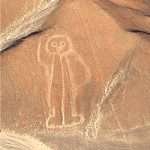
Wine 'sack'?
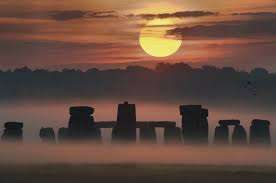
On the ''north western'' fringe of Europe. In ancient times covered in forests.
Continued: ''As we prepared to return to the 'city', i wondered whether the harvest of my own life would be as easy as our day's work and as joyous as our celebration. What was i prepared to sacrifice? What had i outgrown? Where would the knife fall? And what fruit would rest in my hand? The sun, and its warmth, had slipped behind the horizon....It was time to go. The WANING moon had risen, a crones sickle shining in the black sky, reminding us of time's daily harvest....preparing herself for winter's rest. A wild thrashing in the high stalks froze me in MID-TURN....An enormous buck in full rack of seven tines suddenly appeared in the northern field. He was as white as the moonlight...He leapt forward and disappeared into the woods...the world was reenchanted...it felt like the shedding of old skins.'' [Page 257 'The Book of Shadows' / P. Curott].

90?

Known for its copper mines. Hook?
A work in progress: ''The Hammer and Sickle - first recorded appearence ''as a pair'' was in 1894 on Chilean coins {the southern most country in the world}....recently removed from many countries flags and banned from others....Became adopted as the official symbol of the Soviet Union in 1922.'' ['Chase the Case'].
Tutankhamun?
REFRESHER: "You can only go half way into the darkest forest; then you are coming out the other side." Chinese proverb.
''The best way out is always through." Robert Frost. ['Alone' / History Channel].

Coat of arms - Chile. Mantle?
Side note: ''The Buck-eye is an American variety of the Horse chestnut tree.'' ['The Chase' / 2018].
Something extra: ''Amenhotep 's highest attested regnal date is Year 38, which appears on wine jar-label dockets from Malkata...Malkata (or Malqata; Arabic: الملقطة, lit. 'the place where things are picked up'), is the site of an Ancient Egyptian palace complex built during the New Kingdom, by the 18th Dynasty pharaoh Amenhotep III. It is located on the West Bank of the Nile at Thebes, Upper Egypt, in the desert to the south of Medinet Habu. The site also included a temple dedicated to Amenhotep III's Great Royal Wife, Tiy, which honors Sobek, the crocodile deity.''

Shepherd Kings?
''The Temple of Ramesses III at Medinet Habu was an important New Kingdom period temple structure in the West Bank of Luxor in Egypt. Aside from its size and architectural and artistic importance, the mortuary temple is probably best known as the source of inscribed reliefs depicting the advent and defeat of the Sea Peoples during the reign of Ramesses III.'' [Wiki].
''Foreign / Stranger'' to enlarge. As a means.....
'Nobles' ?
"The Aqsa Mosque (Arabic: جامع الأقصى, romanized: Jāmiʿ al-Aqṣā, lit. 'congregational mosque of Al-Aqsa'), also known as the Qibli Mosque or Qibli Chapel (المصلى القبلي, al-muṣallā al-qiblī, lit. 'prayer hall of the qibla (south)'),[2] is the main congregational mosque or prayer hall in the Al-Aqsa mosque compound in the Old City of Jerusalem. In some sources the building is also named al-Masjid al-Aqṣā,[3][4][5] but this name primarily applies to the whole compound in which the building sits, which is itself also known as "Al-Aqsa Mosque".[6] The wider compound is known as Al-Aqsa or Al-Aqsa mosque compound, also known as al-Ḥaram al-Sharīf (الحرم الشريف, lit. 'The Noble Sanctuary')."
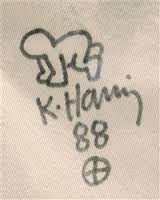 Continued: That same process he [Mr Sitchin], applies to other ‘words’. Which fits in with his personnel hypothesis. Verified by the same. With his interpretation of the word, Til..mun. ’Land of Missiles’. [ Explained elsewhere ]. His understanding of the word ’cross’ in the same vein, i.e.,"Archaeological finds have confirmed the extensive Minoan worship of the bull, and some cylinder seals depict the bull as a 'divine' being accompanied by a cross symbol, which stood for some unidentified star or planet". [ Chapter three. ’The 12th planet’ ].
Continued: That same process he [Mr Sitchin], applies to other ‘words’. Which fits in with his personnel hypothesis. Verified by the same. With his interpretation of the word, Til..mun. ’Land of Missiles’. [ Explained elsewhere ]. His understanding of the word ’cross’ in the same vein, i.e.,"Archaeological finds have confirmed the extensive Minoan worship of the bull, and some cylinder seals depict the bull as a 'divine' being accompanied by a cross symbol, which stood for some unidentified star or planet". [ Chapter three. ’The 12th planet’ ].
Mr sitchin is a good example of other authors like Mr R. Bauval or Mr A. Alford. Their research is excellent. Many ‘keys’ of information to be found; in relation to this subject; unbeknown to the same authors; but because they have no idea of the esoteric side to that same information their conclusions are off the mark.
Mr Alford believes; as with some other authors; that Mr Khufu will be found under the Pyramid without understanding the esoteric side of what came to be known as ’Labyrinths’. [ Explained elsewhere ]. Or understanding what 'esoteric' information there is on Mr Khufu. Only when this final subject is taken into account and understood in its complete form; not its 'first impressionable' one; will a complete answer/picture emerge. That final piece of the jigsaw. That last piece that will complete that overall picture. As all other subjects do in their own way. The human history one. Therefore - that which was once lost - is now found. Represented in this subject as the 'head of the corner stone'.
"Nature is a Labyrinth, in which the very haste you move with, will make you lose your way." [Francis Bacon]. Try ''Levens Hall''.
"The scope and volume of the tradition is a refection of the endless labyrinth of possibility which is your souls true relation to the universe. Nothing more." [Quote by M. Katz. Emphasis, this readers].
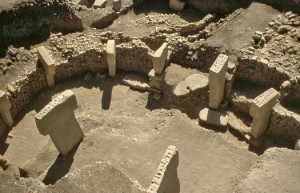
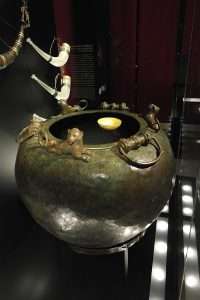
All bronze. Cauldron with three 'handles' and three reclining lions.
Gobekli-tepe. Some call the ‘Navel of the hill’. A link to ‘Pot belly’. You cant have one without the other. A link to those ‘ample’ shaped female figurines. Symbolic of being ‘full’ of something.
"...The Sun is its father the moon its mother, the wind hath carried it in its belly, the earth is its nurse..." Continued elsewhere. ['Emerald Tablet].
Follow the title of the book.
Side note: Such author's as R. Hutton speculate on above as well as the 'double figurine' of same picture elsewhere}. Conclusion = ''human copulation''. For this reader a closer answer would be found in the Janus symbolism,i.e.,'anima' related as opposed to 'shadow'. Enlarged throughout. See it?

Riveted chair?
Side note: A 'working' example {i.e., in relation to the intent of 'Janus' symbolism}: "...The principle reason for it is that it is impossible to sit between two stools {and/or throne?}.

In the middle of the base plate. Asleep. Both male animal and human. 'Lower'?
And people usually think that they can sit between two stools, that is, that they can acquire the new and preserve the old; they do not think this consciously of course but it comes to the same thing....G. once said that there was no sense in our going on any further in this way and that we ought to make a definite decision whether we wanted to go on with him, wanted to work, or whether it was better to abandon all attempts in this direction, because a half serious attitude would give no results whatever. He added that he would only continue to work with those who would make a definite decision to struggle with mechanicalness in themselves and with sleep. There is no sense in sitting between two stools - he had said. Whoever does not want to wake up, at least let him sleep well.'' ['In Search of the Miraculous']. Try ''throne''.
Continued: ‘Milk’ having an esoteric meaning to that same ‘feminine aspect’. As does ‘Butter’. Subtle links to lower/higher. ’Churning’ in relation to ‘grinding’. Think on it? [ Benefits of. Explained within some of the books mentioned ].
That link to the legend of the 'lost thirteenth'. Enlarged elsewhere. try ''thirteen''.
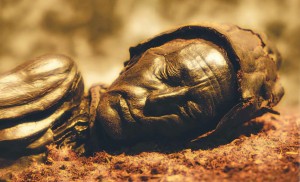
Sacrificial victim or a willing participant? + Most bog bodies found throughout Europe S/E - N/W. Coicidence?

Goddess of crossroads.
Many pots/cauldrons of the same found in sacred ‘bogs'. [ Timeteam...and in the book ‘Seahenge’. Mentioned elsewhere ]. That same link to Cauldron/pot/cup symbolism. Time team program of same = ‘Seven Buckets and a Buckle’. A link to ‘seven’ symbolism and Orion's belt.
A work in progress: The Book of Genesis, chapter 15, tells us that, soon after Abram received the blessing of the God Most High, the Lord visited his word upon him in a vision. He commanded Abram to look up at the stars and count them, if he could. God promises that Abram’s descendants will be as numerous as the stars, or possibly will be as the stars. All he has to do is make a covenant with the Lord by performing a peculiar ritual sacrifice. Abram is told to take five animals, split the heifer, the goat, and the ram in half, and leave the two birds whole. The ten resulting sections, the six separated halves and the four unseparated halves, can be attributed to the spheres on the Tree of Life, according to the sages of the Sefer Yetzirah. Abram made his strange sacrifice of the split animals at sunset and fell into a deep sleep. We are told that thick and dreadful darkness came over him, and the Lord spoke within it describing the future of Abram’s descendants. And then a curious thing happened. Abram had a vision of a smoking firepot with a blazing torch. According to most authorities, this is an ancient symbol of the presence of the God Most High. This torch or pillar went through the gap between Binah and Tiferet and Yesod and Tiferet. This, Genesis tells us, sealed the covenant between Abram and his god.....
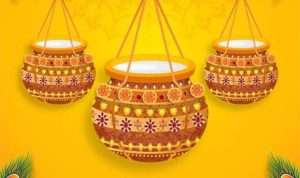
Twentysix links in a figure of 'eight'.
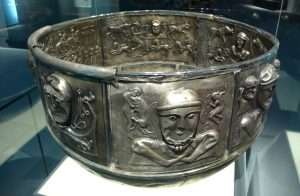 Later, when Abram was ninety-nine years old, the God Most High made a return appearance to confirm the covenant. This time the Lord changed Abram’s name to Abraham, by adding an h, or the Hebrew letter heh, in the middle. Heh, is a pictogram of a window in ancient Hebrew. ['The Mysteries of the Great Cross of Hendaye'].
Later, when Abram was ninety-nine years old, the God Most High made a return appearance to confirm the covenant. This time the Lord changed Abram’s name to Abraham, by adding an h, or the Hebrew letter heh, in the middle. Heh, is a pictogram of a window in ancient Hebrew. ['The Mysteries of the Great Cross of Hendaye'].
Gap = 'void'?
And/or: The event, which gave Abram his insight into the nature of time, which was the window of the letter heh needed to spell Abraham, was his covenant with God. At this event, we are told in Genesis, a fiery torch passed through the alignment of sacrifices from the northwest to the southeast, an alignment preserved to this day by the location of the Black Stone in the cube or Kaaba of Mecca. This line from the northwest to the southeast corner is the galactic axis, of course. Abraham’s covenant represents a shift from the High God of the El to a new hidden god controlling the temporal quality of the galactic axis and its alignments. This God, unlike the placid and benign El, could become angry and dispense judgment and destruction......
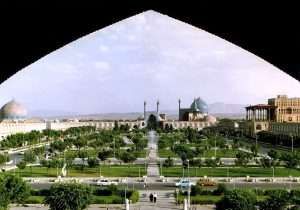
Charbagh gardens {'afar'?}. 'Window'?
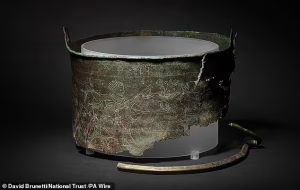
The Bromeswell bucket is a stunning copper alloy vessel that broke into pieces after it was buried at the historic site in Suffolk in the sixth century.
It is decorated with a hunting scene featuring naked warriors in combat with leaping lions.
The ancient Greek pantheon is filled with deities, each holding sway over various aspects of life and nature. Maybe the most mysterious of the Greek goddesses, Hecate stands out as a figure shrouded in mystery and reverence. Often depicted holding torches at a three-way crossroad, she is the goddess of magic, witchcraft, the night, moon, ghosts, and necromancy....
Hecate’s influence stretches far and wide, from her role in Greek mythology to her enduring presence in modern pagan practices. As we delve into her story, we’ll uncover the layers {'onion'?} that make Hecate a fascinating and multifaceted deity, revered and feared in equal measure. Hecate, or Hekate in ancient Greek, is a name that resonates with power and mystique. The origins of her name are somewhat debated, but one theory suggests it’s derived from the Greek word “hekatos,” meaning “worker from afar.” This could allude to her distant, enigmatic nature or her dominion over the moon, which shines from afar.
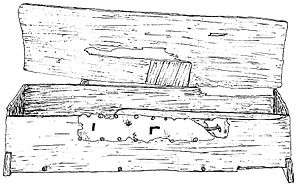
Mastermyr chest. GOTLAND. Most of the find had been placed in the chest, but there were also objects around it such as three bronze cauldrons, three bells and a fire-grid of iron. A chain, made up of 26 figure-of-eight shaped links, was wrapped around it. It served both as an extra lock and handle since the chest was too heavy for the original handle. The chest and the other items had probably been placed in a boat which capsized and sank in the lake. Another theory is that the chest was temporarily hidden at the water's edge.
The chest contained Viking-era blacksmithing and woodworking tools. It also contained several products of such work, including elements of several locks. The chest and its contents provide a valuable insight into technology during the Viking Age.
Continued: The Black Stone was the physical seal of this covenant, a gift from the sky, a token of God’s favor. It is interesting to note that the description in Genesis 15:17 of the smoking firepot with a blazing torch coming out of it also suggests the path of a meteor through the sky. The actual placement of the Black Stone within the Kaaba also suggests the northwest-southeast axis of the galaxy as seen in two dimensions. The stone that fell from heaven is a physical piece of evidence for the presence of the God Most High. With this in mind, we can understand the reference in Psalm 118 to the rejected stone that became the head of the corner, and Jesus’ denunciation of the Jewish elders for not understanding their own religion. [same].
SIDE NOTE: "I will tame the primal obsessions. Greed, anger, pride, hatred, and use them as powerful bullocks to plough the field of consciousness. Sowing the 'seed' of Om Kali Ma, transmitted to me by a skilful farmer. I will reap a vast harvest of illumination..." [Poem by Ramprasad Sen. Taken from the book 'The Path of the Priestess: A Guidebook for Awakening the Divine Feminine' / Sharron Rose]. Question. Anima/soul/ 'light'?
Apis Bull {Shadow/spirit/ 'fire'?}. As a means...?
And/or: ''When Plato writes about Poseidon, the first god-king of Atlantis, this should remind us that Poseidon was the original half-fish form of Zeus/Jupiter. Poseidon was also god of the raging sea, god of subterreanean, volcanic depths, whose bull-bellowing roar signalled climatic catastrophe. Poseidon was at work at both the beginning and end of Atlantis's history." [Page 163/4 'Secret History of the World' / J. Black].
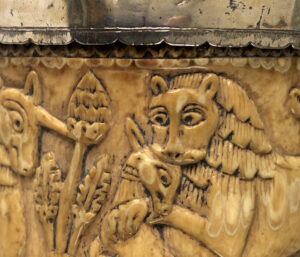
Horn of Africa?
Ethiopia link?
''IO the most volcanic active body in the Solar System. A moon of Jupiter and the 4th largest moon in the Milky Way. The 'name' consists of the third and fourth vowels of the alphabet.'' ['Chase the Case'].
Sacred five days of the year?
'Leap year'?
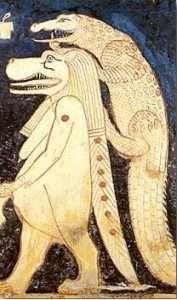
'Mistress of Pure Water'.
Continued: "IN this context the word 'spirit' means the mind that blows through many places like the wind. The friend of Job also calls mind spirit when he says: 'I am filled with reasoning and the spirit of my BELLY binds me' {Job 32:18}. In Proverbs memory is called the belly; hence Solomon says: 'Bring your heart close to my teaching, which will be beautiful for you if you keep it in your belly and will overflow on your lips so that you will trust in god' {Prov. 22:17-18}. The first authority says, then, that the spirit of his belly compelled him to speak because the thoughts and reflections and reasonings held in his memory were great and efficacious, and thus spirit signifies mind, which like the spirit comes and goes where it pleases." [From the book 'The Third Spiritual Alphabet' by Francisco de Osuna]. Try ''memory''. Connect the two.
A working example {and/or something extra}: ''And when the harsh fire , the primeval sulphur, burns in the pit of our stomachs, it is difficult for us to choose to be good hearted." [Page 93 'The Secret History of the World' / J. Black].
Try ''Sulphur''.
'Mercury' and 'Salt'?
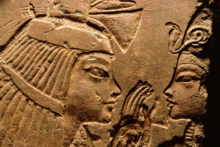
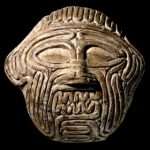
And/or: ''As well as in medicine, the Chinese and Japanese tend to lay great emphasis on the role of the solar plexus in spiritual practice. If you contemplate a statue of a meditating Buddha, you will see someone who has gathered himself inward, and that the center of this meditation, his center of mental and spiritual gravity, is his lower belly....He has sunk down into the center within himself - sometimes called the 'hara' - that is connected with all life. [Page 76 same book].
''A gathering within'' = 'Golden Child'?
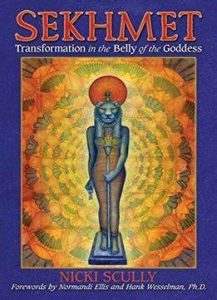
'Fire' in a different form. Best foot forward?
Astronomical equivalent {i.e.,that very first one - i.e.,first method used to imply those universal keys/principles?}: "The second curiosity is that warriors previously identified with stars on or very close to the ecliptic are 'killed' in the same manner, by a blow to the 'belly'. In terms of magnitude these stars are not particularly bright, but they are significant in astronomical terms because of where they lie. When warriors are struck in the belly, the most central part of the anatomy, a useful mental image directs the eye to the ecliptic, the apparent path of the sun. This helps to focus attention on Mars closeness to the ecliptic when Ares too is wounded in the stomach when 'Pallas Athene drove the spear into the pit of Ares stomach where his under girdle went round him'. The incident doubly reminds the audience of the ecliptic, because Athene as Jupiter closely follows the path of the sun.
Try ''girdle'' / ''belly'' / ''navel'' as well as ''Pallas Athene''.
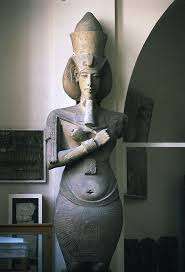
"Those feminine features like wide hips and enhanced breasts suggest a hormone imbalance." [Same program]. Define those keys {i.e., navel , belly , etc] - to 'see' things associated with ''real life''. As {one} example try ''pregnant'' and/or ''umbilicus'' and/or ''milk''. Question. Alabaster?
L. S. "Looked through the eye of a medic, its not a statue its a symptom."
D. C. "Could it not be an exaggerated form of abstract and symbolic art?''
L. S. "Could be, but we know he asked for things to be depicted according to real life, so if we take that on board, then this figure is clearly abnormal." ['Tutankhamun: The Truth Uncovered'/ BBC 4].
SIDE NOTE: For this reader if a medical condition was responsible {if only in part} then the word 'psychosomatic' would be more appropriate rather than there final conclusion of it being the result of incest. As is...
"Mainstream prophets who predict the future sometimes project their intuitions about their own fate onto the larger situation in the world. In this regard, a study of modern prophets and their eschatological utterances is revealing. Many of these visionaries make passionate - and very specific- predictions about the end of the world. For all of them, the end was near, and they were convinced this was true. When the predicted date rolled around, a great majority of these prophets experienced accidents, or died suddenly. Now, what does this say about self-determination, free will, and their 'prophetic ability'..." ['Galactic Alignment'].
Think on it relative to that universal 'bit' in relation to cause and effect and/or THEREFORE freedom of Will?
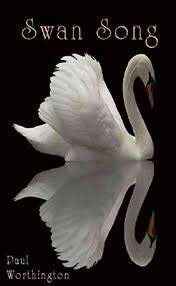
A 'pure' number?

''The Birth of the New Man.'' Smith and Jones to enlarge.
Refresher: "Contrary to what might be considered logical, the mineral kingdom is not situated at the bottom, of the lowest register of the temple walls that explains the phases of becoming. As the first corporeal form, the metallic or mineral kingdom is the closest to the origin, closer to the spirit that animates everything. Because it is created and not procreated. It is located at the uppermost register of the tableaux. The personages at this highest level symbolize non-procreated principles and are depicted without navels. The lowest register portrays Royal Man, symbol of the ultimate aim of creation. Between the two {'void'?} is located the register of pure Number, corresponding to the plant kingdom, and next is the register of combinations or geometry of Numbers, the animal kingdom. The temple is fashioned by man in the image of the heavens, in the image of his world...The incarnation of the universe in man is the fundamental theme of all religions...." [Page 27 'The Egyptian Miracle: An Introduction to the Wisdom of the Temple' / R. A. Schwaller de Lubicz].
Mercury/sulphur/salt?
And/or: ''If Cadmus/Enoch 'named' the planets and the stars {i.e., invented 'language'}, it was Orpheus who measured them, and by measuring them, invented numbers. There are eight notes in an octave....He is a transitional figure....Came from the north {'pure' link?} bringing with him a gift of music...." [Pages 150/2 'The Secret History of the World' / J. Black].
''In Botany the root that stabalises a plant is called an anchor root.'' AND/OR: ''When water is added to grain it is called Oat milk.'' ['The Chase' / 11.3.22].
And/or: The teeth of the serpent/dragon that Cadmus slew sprouted 'warriors'.
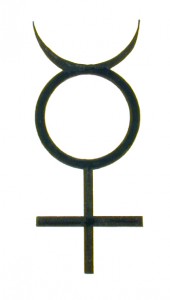
Any 'eureka' moments?
This symbol is the only hieroglyphic on the outer wall of the Great Pyramid...The name given to the pyramid was 'Akhet Khufu', which meant ''horizon of Khufu'' - this later term was misunderstood by later Egyptologists, who turned it into the name Cheops. This pregnant symbol is {also?} located above the passageway which pierces into the rock foundations of the vast structure. As a symbol, it survived into modern times - as the symbol for Libra, the cosmic balance, which now consists of three elements...When he had drawn the sigil, he ran the back of his pencil {'lead'?} through the curvature of space {'arc' / Uas?} - between the solar disc and the horizon of earth...'The invisible {'crescent'?} space is just as important as the Sun and Earth. Do you see how even the most simple-seeming of the arcane symbols are steeped in hermetic antiquity?' ['The Zelator'. Italics/parenthesis, this readers].
"For Amon reigns over the invisible, while Ra is Neter of the visible world." ['Her-Bak'].
Question. If Khufu = Libra. What do the other two represent . Leo/Virgo? Enlarged elsewhere.

Khonsu behind Hathor {'middle'} behind Sobec at Kom Ombo. Left to right. Question. With or without 'navels' - as a means....?
Something extra: "We have come now to our study of Libra, which the sun enters at the fall equinox...Every 'air' sign is always triune; for every mode of expansion implies the transcending of a duality. In Libra, Leo's self assertion and Virgo's self criticism are reconciled and overcome through self consciousness to humanity....
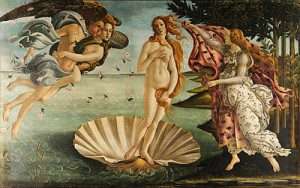
Venus rules over Taurus: A beginning or end?
In this consecration the self remains...as a focused lens in and through which the light of the whole operates. A focused lens; a womb, a chalice: thus Libra is 'ruled' by Venus, the ingatherer and the creator of meanings as well of the seed. Venus, the fruitful, gives birth in Libra..." ['Page 118 'The Zodiac as the Universal Matrix']. Try ''seed'' / ''soil'' / ''trees'' etc.
Flagon?
Follow the title of the book to see something from that original {'seeding'?} point of view.
Khufu/Khafre or Menkaure?
Continued: "The twelfth house closes the cycle of human experience. It is the last stage on the way of creative accomplishment {anima?}. Here, the individual either consolidates his successes into a seed, whence will arise a new cycle {Aries?} of growth, or he meets the accumulated results..." ['The 12 Astrological Houses'].
Understanding the above not only gets us closer to defining the {mind set?} of all individuals who participate within the subject as a whole - but gives clues to possible burial locations within 'landscape' symbolism of same intent and purpose , i.e.,Aries a link to Osiris. Soil and seed in relation to Dendera - of which it is said, the very first representation of a Zodiac, within Egypt was discovered. Other clues, throughout.
The REAL questions however, remain the same.
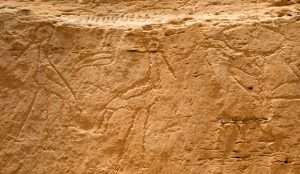
The earliest hieroglyph ever found for the ''horizon'' - if only in Egypt.
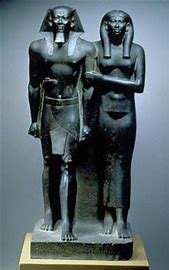
Fire and water. Spirit /Soul. Which and why?
"They come, the waters of life which are in the sky. They come, the waters of life which are in the earth...The sky is aflame for you, the earth trembles for you, before the divine birth...The two mountains are split apart. The god comes into being, the god has power in his body...The month is born, the fields live." [Pyramid Texts, 2063].
Question. What is that month?
Define those 'keys' to give further information on Akhenaten.
El-Tel Bethsai? {Israel}.
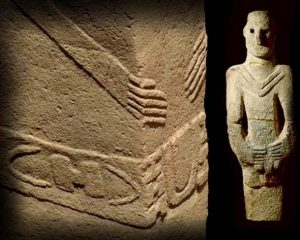
Try ''butter'' by way of ''transforming fingers''.
Something to ponder on {in relation to same picture}..."Placentas, when featured in ancient myth and ritual, are often associated with the theme of 'twins', a matter that may well have some bearing on the presence of the twin pillars at the center of the enclosures at Gobekli-tepe. For example, among the Baganda tribe of Uganda the placenta and umbilical cord of the kings {king-ship?} are considered the source of his ''twin'' {mulongo}, which is seen as the ghost or spirit of the 'placenta'. During the monarchs life it is kept under constant watch in a specially built 'Temple of the Twin', and at the first sight of the lunar crescent each month it is brought into the kings presence for a special ceremony. Once the ceremony is complete, the ''twin'' is exposed in the doorway of the temple for the moon to shine upon it, and also anointed with butter..." ['Gobekli Tepe' by A. Collins]. Try ''twin'' and/or {by association; to the above} ''womb'' ' / ''milk'' - in the usual box, for something further {insight?} - to ponder on.
Helen and Menelaus to enlarge.
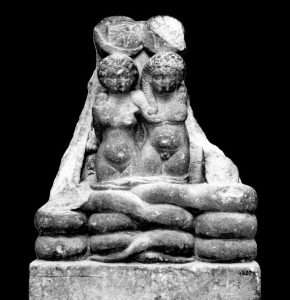
Egyptologist Giuseppina Capriotti of the Italian National Research Council believes a statue in the Cairo Museum depicts the twin children of Mark Antony and Cleopatra, Alexander Helios and Cleopatra Selene. The sandstone statue was discovered near the temple of Hathor in Dendera on the west bank of the Nile in 1918.
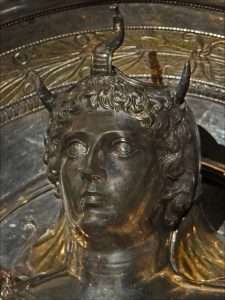 Maya 'Hero' twins ?
Maya 'Hero' twins ?
''The placenta is a flat organ that feeds the foetus through the umbilical cord.''
Side note:''The pastry croissant takes its name from the French word for Crescent.'' ['Reddiculous'].
''A croissant is a buttery, flaky, French viennoiserie pastry inspired by the shape of the Austrian kipferl but using the French yeast-leavened laminated dough.[1] Croissants are named for their historical crescent shape, the dough is layered with butter, rolled and folded several times in succession, then rolled into a thin sheet, in a technique called laminating. The process results in a layered, flaky texture, similar to a puff pastry.''
Side step: ''Derived from the Italian word for 'trouser leg' - Calzone is given for a folded over pizza.'' ['Riddiculous' / ITV].
''Break me for luck or pull me as a joke. What am i?'' ['Reddiculous'].
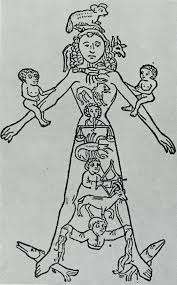 Side note: "Aries {Ram} = 'head'. Gemini {Twins} = arms. Leo {Lion} = heart. Libra {Scales} = pelvis. Sagittarius {Man-horse} = thighs. Aquarius {Waterman} = lower leg. Taurus {Bull} = neck and throat. Cancer {crab/crayfish} = chest and breasts. Virgo {Virgin} = stomach, womb. Scorpio {Scorpion} = sexual parts. Capricorn {Goat-fish} = knees. Pisces {Fish} = feet.
Side note: "Aries {Ram} = 'head'. Gemini {Twins} = arms. Leo {Lion} = heart. Libra {Scales} = pelvis. Sagittarius {Man-horse} = thighs. Aquarius {Waterman} = lower leg. Taurus {Bull} = neck and throat. Cancer {crab/crayfish} = chest and breasts. Virgo {Virgin} = stomach, womb. Scorpio {Scorpion} = sexual parts. Capricorn {Goat-fish} = knees. Pisces {Fish} = feet.
''The founding of many ancient cities was accompanied by special ceremonies. As C. Kerenyi says: 'Ceremonial is the translation of a mythological value into an act'. According to Plutarch's account of the founding of Rome, a circle was drawn with a plough around the chosen center of the new city. Other sources speak of a 'square Rome'. Apparently we have a square witin a circle. In the Eurasian world the square plan and the circle plan were used separately in different cases. ..
''Three and four'' to enlarge.
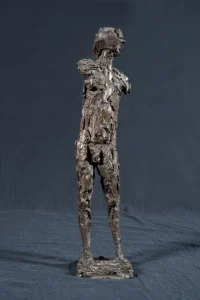
Little Warrior.
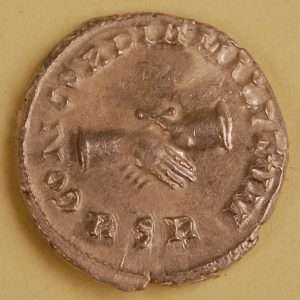
Reverse of a Carausius silver denarius from the Hoard, showing two clasped hands (symbolising the unity of the ruler and the army), alongside the abbreviation 'RSR'. This alludes to a line from Virgil's Eclogues - Redeunt Saturnia Regna or "The Golden Ages have returned".
Continued: ''The square plan was sanctioned by the sacred books of Avesta, i.e., the founding city of Vara was a square, each side the length of a horses run {approx 2 miles}, for 'mans dwelling and the cattle pens' {'manger'?}. The army constituted the backbone of the administration. It was divided into two main groups - the right and left 'arms'. As the nomads always pitched their tents facing the south, the left arm meant the eastern army group and the right arm the western....The military organization was based on the decimal principle. Usually the 'greater family' corresponded to the unit of ten; the clan to a hundred; and the tribe to a thousand.'' [Pages 28-30 'The Origins of Russia' / Vernadsky].
Sheep decans?
''Mythology is not religion but may be called religion's twin sister....Mythology may be likened to philosophy - that kind of philosophy which is in search of fundamental principles. But philosophy's main vehicle is thought, and mythology's the IMAGE. Both became the 'handmaid' of religion.'' {same book}.
And/or: "Gudea made offerings of honey and butter when the foundations were laid; when the building was finished an auspicious day was waited for, and when it came the image of the god was removed to the new temple, and Gudea sprinkled the ground with oil and set out offerings of honey, butter, wine, dates, grain mixed with milk, foods untouched by 'fire', for the gods." [Chapter 3, 'The Sacred Bee'].
Cancer to enlarge.
Islams equivalent of those 'foundations' being the Mosque of Piety. Enlarged elsewhere.
"...and it is he who guides me; who gives me food and drink. And when i am ill, it is he who cures me; who will cause me to die and then to live [again]. [Quran 26:78-81].
Christian equivalent. ‘The cup overfloweth’.That link;eventually; to the ‘Heart’ symbol. [ Explained elsewhere = Potential of ].

'She who loves silence'.
The Senet board game found in most if not all of the tombs of dynastic Egypt. Sometimes called the ‘Middle’ way. Those Chakras a link to the spinal chord in the middle of the back/body. Indirect link to the same. Egyptians called it the ‘Djed Column’. The spine of Osiris. See ’Egyptian mysteries’. Middle of book. L. Lamy. For picture /info of same. With ‘headgear’on top.
''In {'Pop'} music - the 'middle eight' = eight bars.'' ['The Chase' / 10.1.22].
From a different perspective: ''The names Piggy in the Middle and Pickle in a Dish are of unknown derivation. "Pickle in the middle" derives from the game of baseball. When the base runner is caught off base between two opposing players, one of whom has the ball, he is "in a pickle" (that is, in trouble).''
And/or: '''Doubling a number THREE times is equivalent to multiplying it by eight.'' ['The Chase'].
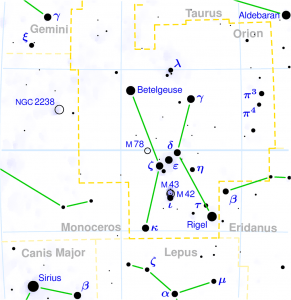
Spirit/Soul. Left to right or right to left as a means...?
Side note: ''Today the word 'apocryphal' carries different associations, but really it means hidden - or esoteric. In the apocryphal Testament of Job, he was rewarded for being conscious of what he did not know, conscious of what he had lost. Job's 'sons' and 'daughters' were returned to him, his daughters bearing 'golden girdles'. One 'belt' gave Job the ability to understand the language of the angels {'higher'?}, the second the secrets of 'creation' and the third the language of the Cherubim." [Page 155 'The Secret History of the World' / J. Black].
Continued: "This is the beginning of the praising's and glorifications for going out and coming into the Neterkhert, glorious in Amentet, the beautiful place. These words are for allowing one to go out into the light in all the forms that a person may desire, to play the Senet game in the resulting booth, and to go forth as a living soul.....Who is this person that is being spoken about? [[Page 178 ' Egyptian Book of the Dead' / M . Ashby].
Chapter '17' is to some the most important in the same book.
Analogy {i.e., from a different perspective}: "The reiterated 'I have been' and 'I was' of Gwion's Hans Taliesin riddle suggests that the Boibel-Loth alphabet, which is the solution, originally consisted of twenty mystical titles of a single Protean male....which was kept secret....But why does it contain so many approximations to Biblical names taken from Genesis and Exodus....all names concerned with Sinai, Southern Judea and Edomite Dead Sea region? This is the region which the Essene communities were settled...." [Page 148/9 'The White Goddess'].
Enlarged elsewhere.
''I'' and ''thou'' of other religious texts?
And/or: "...in so far that the Grail Seeker, must ask three key questions about it. These are: What is the Grail? What is the purpose of the Grail? Who is served by the Grail? As has been discovered in many a modern context, it is not enough to be able to answer difficult questions that solve a problem, but the ability to discern the right questions that need to be answered. The Grail stories tell of what happens when a Grail seeker wins through to a revelation {eureka moment?} of the 'Grail' but fails in his wonder to ask the right questions. All disappears as a phantasm and he finds himself back in the enchanted Wasteland, with castigation heaped upon him for his lost opportunity." ['Experience of the Inner Worlds']. Enlarged elsewhere.
Hebrew equivalent of same...The letters of ‘YHVH’ now in ‘human form’. [ ‘World Mysticism’. By P. Gandy. Chapter seven. ] Or the Sumerian equivalent. The word Din.gir. [ Chapter five of 12th Planet fame.] ‘Gir’...Representing the Hebrew equivalent of the ‘godhead’. [ Explained elsewhere ]. Or for the Pagan equivalent...The five star Pentagram in its ‘human’ form. [ Explained elsewhere ]. That same symbol that is drawn in its completion with one single line or thread. A link to a co-existence of something. Micro within the Macro.See pictures below in order to understand the 'pieces' within the 'whole'.
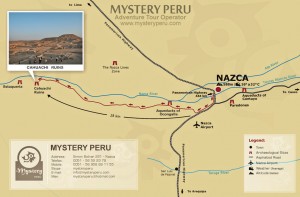
"And the Nazca Lines were created by removing rocks from the top soil leaving a slightly different colour surface exposed to the air {'red/fire' link?}...Because it never rains here, these patterns have been preserved for thousands of years...So when the shamans and priests prayed to the wind, they asked the wind not to touch the Nazca Lines or the other side of the River {i.e.,Cahuachi - enlarged elsewhere]. Then they prayed that long in the future this city would be reopened at the right moment...So as to reveal special knowledge that would help the entire world." ['Serpent of Light Beyond 2012'].Wind/Rain - Top/down in relation to Bottom/up as a MEANS...?
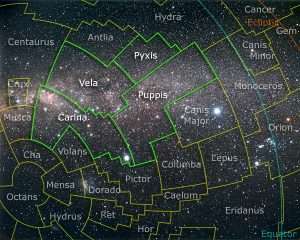
Argo Navis, scanned from AF2-01
As are certain shapes drawn by the Nazca ‘lines’. Especially the 'Fish'. Symbolic of a ‘life form’ within its own journey. Drawn, using one line only. One 'thread'. As is the same with the 'Golden raft of El Dorado'. One central figure, ['sun' god], surrounded by twelve others.
" All created in one pouring of gold." ['Discovery History' channel Feb. 2014].
Sumerian equivalent the figure 'Oannes'. Half man,half fish. The tail end of something and the beginning of something else.[Chapter six.'The Sirius Mystery']. 'Lower' in relation to the 'higher'. 'Wet' way relative to 'dry' way. Understanding / indicative of.
"Ancient legend tells that in the Inca lake, the Titicaca, there evolved a mystical game, that with the passage of time was made into a festival. El Sapu [the frog] was the main character in the exciting game where the Inca, 'Son of' the sun, would throw for luck with his court. In those times the royal family would throw gold pieces into the lake, with the hope of catching some frogs attention, who were known for their 'magical' powers." [ Internet...info@sapomiami.com]. Recall what the frog represents.
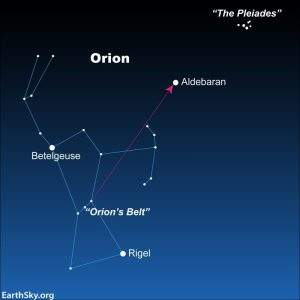
UPSIDE DOWN in the southern hemisphere.
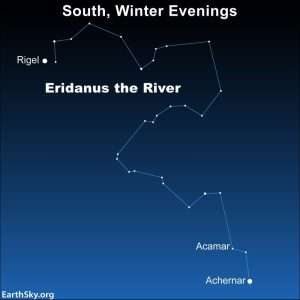
Begins at the left foot of Orion: And/or: ''Any circle drawn around Earth divides it into two equal halves called hemispheres. There are generally considered to be four hemispheres: northern, southern, eastern, and western.''
''Lake Titicaca, straddling the border between Peru and Bolivia in the Andes Mountains, is one of South America's largest lakes and the world’s highest navigable body of water. Said to be the birthplace of the Incas, it’s home to numerous ruins. Its waters are famously still and brightly reflective. Around it is Titicaca National Reserve, sheltering rare aquatic wildlife such as giant frogs.''
And/or: ''The Sea of Galilee (Hebrew: יָם כִּנֶּרֶת, Judeo-Aramaic: יַמּא דטבריא, גִּנֵּיסַר, Arabic: بحيرة طبريا), also called Lake Tiberias or Kinneret, is a freshwater lake in Israel. It is the lowest freshwater lake on Earth and the second-lowest lake in the world (after the Dead Sea, a salt lake),[3] at levels between 215 metres (705 ft) and 209 metres (686 ft) below sea level.

'flat' top?
It is approximately 53 km (33 mi) in circumference, about 21 km (13 mi) long, and 13 km (8.1 mi) wide. Its area is 166.7 km2 (64.4 sq mi) at its fullest, and its maximum depth is approximately 43 metres (141 ft).[5] The lake is fed partly by underground springs, but its main source is the Jordan River, which flows through it from north to south and exits the lake at the Degania Dam.''
The birthplace of....?
''In geography and cartography, hemispheres of Earth are any division of the globe into two equal halves (hemispheres), typically divided into northern and southern halves by the equator or into western and eastern halves by an imaginary line passing through the poles. Hemispheres can be divided geographically, culturally, religiously, or based on prominent geographic features. Understanding these divisions is essential for studying Earth's geographic distribution, cultural differences, and the prominence of various geographic features.''

Fire AND water. Truncated pits?

Silbury Hill. The 'last' to be created.
A practical {synchronistic?} example could be described by the application of a lucky charm as used in a recent program on the 'Silk Road' {David Baddiel / Discovery Channel}. Of all the lucky charms he could pick {prior to a 'journey'} - he chose a frog, with notches along its back bone, which when applied with pressure ,i.e.,the accompanying stick - makes the frog sound.
The Chinese equivalent as explained in the same book [chapter nine] Fuxi and sister, the two 'fish/snake tailed' {i.e.,amphibians} founders of Chinese civilization. One of which is holding ' a carpenters and masons square' as an "emblem of his role as creator of civilization". Both figures in 'black', i.e.,representing 'dark' / unknown 'aspects'. The inscription says that they governed the world within the seas. Think about it, in relation to the 'divine bit' relative to an understanding, with the 'unconscious' ...as a start point. [Representational of, only].
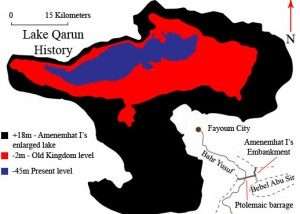

'Snake/Dragon head' on land. 'tail' in the sea.
Those 'fish tails' that over generations [development of] 'transformed' into Dragons and eventually their 'tails' became symbolic of something else. Dragon and serpent one of the same. The same in the sense that is as "opposing ends on the same pole." Smaller 'picture' within the bigger picture. An understanding of 'self' within a 'development'...relative to an overall 'framework'. The micro within the macro. That understanding explains why those who ruled wanted their final resting place on the 'tail end' of those same Dragon forms. The tail end of something, represents the beginning of something else. Question. What is that something else? Clue...the emperor of China was known as the 'Son of heaven'. ['Cygnus Mystery' book]. Together with, the Chinese equivalent of sky religion, was 'the Sky Father' which meant the Lord of light. Same book.
Side note: ''In the Chinese Zodiac the year of the snake directly follows the year of the dragon.'' ['Impossible'].
And/or: There is no year of the lion in the Chinese Zodiac.''
 Also in literal use in 16c. English, "tail of a beast," especially in heraldry.
Also in literal use in 16c. English, "tail of a beast," especially in heraldry.
Big cup, tiny penis or just a little man? Would Mother Russia join him or erase him? Gog-Magog to enlarge.
If we look now at Paris one thing is too evident: that the Baker's shops have got their Queues, or Tails ; their long strings of purchasers arranged in tail, so that the first come be the first served,—were the shop once open! This waiting in tail, not seen since the early days of July, again makes its appearance in August. In time, we shall see it perfected, by practice to the rank almost of an art ; and the art, or quasi-art, of standing in tail become one of the characteristics of the Parisian People, distinguishing them from all other Peoples whatsoever....
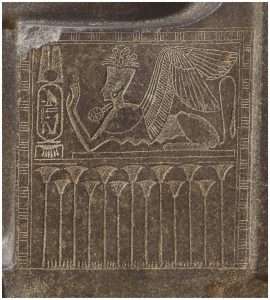
A dyad of Horemheb and Mutnodjmet from Karnak, now in the Museo Egizio, Turin. The sphinx depicted on the side of Mutnodjmet’s throne has arms raised in adoration of her cartouche. Images: Museo Egizio, Turin.
[Carlyle, "The French Revolution," 1837]..Also used 18c. in sense of "braid of hair hanging down behind" (attested by 1748), originally part of the wig, in later 18c. of the hair of the head....QUEUE. From the French, which signifies tail; an appendage that every British soldier is directed to wear in lieu of a club. Regimental tails were ordered be nine inches long. [William Duane, "A Military Dictionary," Philadelphia, 1810]..queue (v.)..."to stand in or join a line" (intransitive), by 1924, from queue (n.). Transitive sense of "arrange in or cause to form a line" is by 1928. Earlier "tie or fasten the hair in a braided pigtail" (1777). Related: Queued; queueing. Churchill is said to have coined Queuetopia (1950), to describe Britain under Labour or Socialist rule.'' ['Online Etymology Dictionary'].'Feast of the Tail'?
Continued: "The Yangtze river heading south until it comes to its first bend - a mountain range of hard limestone - that cannot be eroded through the eons. It turns back on itself back into China. Appears in creation myths about the country - an army of dragons used to return the river back into China..." ['Sacred Rivers' by Simon Reeves. BBC 1].
S/E OR S/W? HEAD OF THE CORNER?
Side note: Sneferu 1st pyramid unstable on sand. His second unstable on its 'corners'. Cedar trunks used ''to support the walls. The 3rd becomes a 'true' pyramid. Corbelling used. Recall the meaning of 'pyr'amid.
In other words the landscape was the sole reason for the sites choose. A supply of limestone in relation to the Bent Pyramid. This was known before the start of the 1st pyramid to the South. An 8 stepped construction. Recall what 'eight' represents.
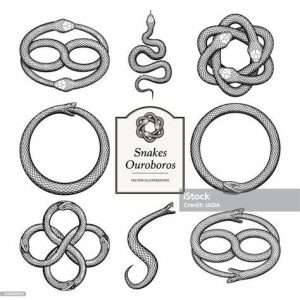 ''These beams are placed into the surrounding walls that protects the sarcophagus {i.e., within the 'void' of the 'second' middle chamber {of 'three'} - BEGINNING just ABOVE ground level}. Much later in history we have a spell from the Book of the Dead - a resurrection Spell - that says very clearly: 'Put cedar beams in the wall and throw water over it. That is what protects you from your enemies'...Maybe here {'Bent Pyramid'} was the first time it was used.'' [Vassil Dobrev: 'Legends of the Pharaohs' / S.1. E.2].
''These beams are placed into the surrounding walls that protects the sarcophagus {i.e., within the 'void' of the 'second' middle chamber {of 'three'} - BEGINNING just ABOVE ground level}. Much later in history we have a spell from the Book of the Dead - a resurrection Spell - that says very clearly: 'Put cedar beams in the wall and throw water over it. That is what protects you from your enemies'...Maybe here {'Bent Pyramid'} was the first time it was used.'' [Vassil Dobrev: 'Legends of the Pharaohs' / S.1. E.2].
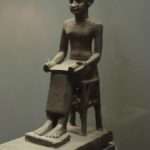 REFRESHER: ''Whose height is like that of cedar trees.'' {Amos ii.9}. Therefore Jupiter link. Question. Any conjunction between Saturn/Jupiter? Used as a start/end point?
REFRESHER: ''Whose height is like that of cedar trees.'' {Amos ii.9}. Therefore Jupiter link. Question. Any conjunction between Saturn/Jupiter? Used as a start/end point?
''Upright''.
Abydos to enlarge.
'Lost in the Cedar Wood' / Johnny Flynn and Robert MacFarlane.

''Mountains Low. Valleys High''. Question. Who's 'leaning' on who?
Side note: ''My favourite 'Book' of the Bible is The Song of Songs {1:16/17}: The bridegroom is described as the Temple - but the bride is described as the Holy Land....at one point of the poem the bride says to the bridegroom - all green is our bed - to which he says that the roofs are made of cedars.'' [Kathleen Nichols / Pilgrimage of Grace / Magdala / 28.2.22].
 A working example: ''Theres something more about autumn than 'meets the eye'. The sense of smell is really interesting. It is the only SENSE that is fully formed in the foetus - and its your most dominant sense till about Ten year old - when vision takes over. And thats why when we smell something later in life we often go back to a childhood memory....The Native American peoples believed that you can gain strength from the Cedar {'Western Red'} - just by leaning against it.'' [ Louise Rounds: 'Gardeners World' / Autumn 2022].
A working example: ''Theres something more about autumn than 'meets the eye'. The sense of smell is really interesting. It is the only SENSE that is fully formed in the foetus - and its your most dominant sense till about Ten year old - when vision takes over. And thats why when we smell something later in life we often go back to a childhood memory....The Native American peoples believed that you can gain strength from the Cedar {'Western Red'} - just by leaning against it.'' [ Louise Rounds: 'Gardeners World' / Autumn 2022].
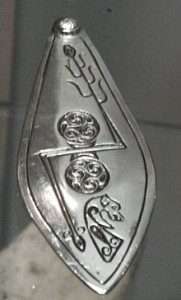 Refresher: ''The Monarchy of the eye in relation to the Democracy of the nose.''
Refresher: ''The Monarchy of the eye in relation to the Democracy of the nose.''
''Memory'' to enlarge.
Side note: ''We typically think of 'fall' as the North American version of the word 'autumn', but it was in fact in widespread usage in England until relatively recently. Originally a shortening of the phrase fall of the leaf, the phrase was common in England in the 17th century....While the September equinox usually occurs on September 'twentytwo' or 23, it can very rarely fall on September 21 or September 24. A September 21 equinox has not happened for several millennia. However, in the 21st century, it will happen twice—in 2092 and 2096.''
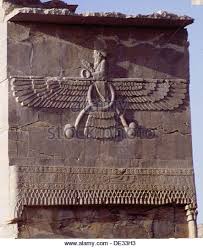
In profile or face on? L-R OR R-L?
Continued: From a different perspective: ''The spiritual world is not an ethereal, hazy double of the physical sense world, but reveals itself to our heightened sensibilities in guite other forms. Steiner often elucidates the difference between sense experience and the 'supersensible' by reference to memory. To the EYE, the objects of the sense world appear in a certain way....Supersensible experience refers to no past sense impression, but rather to present soul and spiritual ASPECTS of our world.''

Different aspects of the same theme?
[Page 230 'How to Know Higher Worlds'].
"For as the heavens are higher than the earth, so are my 'ways' higher than your ways." {Isa.Iv.8-9}.
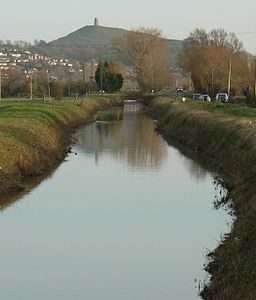

''The hole under the hatch'' {Chasm?}. 'Oak Island'.
But oh! that deep romantic chasm which slanted down the green hill athwart a cedarn cover!
A savage place! as holy and enchanted as e’er beneath a waning moon was haunted by woman wailing for her demon-lover! And from this chasm, with ceaseless turmoil seething, as if this earth in fast thick pants were breathing, a mighty fountain momently was forced: Amid whose swift half-intermitted burst huge fragments vaulted like rebounding hail, Or chaffy grain beneath the thresher’s flail: And mid these dancing rocks at once and ever It flung up momently the sacred river. Five miles meandering with a mazy motion through wood and dale the sacred river ran, then reached the caverns measureless to man, and sank in tumult to a lifeless ocean.''
'Roofless'?
Side note: Horseshoe type 'buildings' in 'three' segments found - together with upturned vases. Found close to boundary/enclosure walls. Other clues towards defining a mind set within the same documentary: Elongated skulls / Oracle forecasts made from the 'right shoulder of a sheep, put into a fire' / Battlefield mentioned: ''5th {five} milestone away from Troyes''. [Attila's Forbidden Tomb' ].
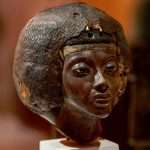
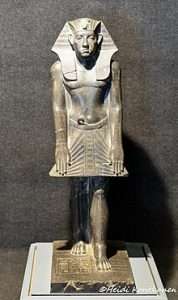 Continued: ''And ’mid this tumult Kubla heard from far ancestral voices prophesying war! The shadow of the dome of pleasure floated midway on the waves; where was heard the mingled measure from the fountain and the caves. It was a miracle of rare device, a sunny pleasure-dome with caves of ice!
Continued: ''And ’mid this tumult Kubla heard from far ancestral voices prophesying war! The shadow of the dome of pleasure floated midway on the waves; where was heard the mingled measure from the fountain and the caves. It was a miracle of rare device, a sunny pleasure-dome with caves of ice!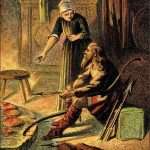
Funerary scones or wedding cakes?
And/or: Kubla Khan: or, A Vision in a Dream: A Fragment (/ˌkʊblə ˈkɑːn/) is a poem written by Samuel Taylor Coleridge, completed in 1797 and published in 1816. According to Coleridge's preface to Kubla Khan, the poem was composed one night after he experienced an opium-influenced dream after reading a work describing Shangdu, the summer capital of the Yuan dynasty founded by the Mongol Emperor Kublai Khan. Upon waking, he set about writing lines of poetry that came to him from the dream until he was interrupted by "a person from Porlock". The poem could not be completed according to its original 200–300 line plan as the interruption caused him to forget the lines. He left it unpublished and kept it for private readings for his friends until 1816 when, at the prompting of Lord Byron, it was published.
Porlock is a coastal village in Somerset, England, 5 miles (8 km) west of Minehead. It has a population of 1,440. In 2010, Porlock had the most elderly population in Britain, with over 40% being of pensionable age. There is evidence for 10th or 11th century origin for the name Porlock as Portloc or Portloca meaning enclosure by the harbour, from the Old English port and loca,[3] and in the Domesday Book the village was known as "Portloc".[4] In 914 the Vikings plundered Porlock. [Wiki].

 A side step: ‘Theseus/Minotaur/Labyrinth’. One Thread connects all three. As it does with the neolithic 'triple spiral' emblem as seen in such locations as Newgrange in Ireland, or even within the book 'Power within the Land'. Mentioned elsewhere.
A side step: ‘Theseus/Minotaur/Labyrinth’. One Thread connects all three. As it does with the neolithic 'triple spiral' emblem as seen in such locations as Newgrange in Ireland, or even within the book 'Power within the Land'. Mentioned elsewhere.
Spiral, in relation to 'whirlwind', in relation to, 'altered states', in relation to 'corbelled' [as seen for example within the niche of the 'queens chamber' and/or especially within the Grand Gallery, Egypt]. One a precursor to the other. As a representation of something.
Bridging a void?

When the north wind blows. Heading south?

Shepherd Kings?
Side note: The mystical experience of the galgal, or cycle, of the Tree of Knowledge is the whirlwind, or sufah in our Talmudic reference.'® The galgal is also spoken of in the Bahir as a womb. This is a cycle of time in which the future is born. All of time happens within the sphere defined by the Teli. The Bahir also tells us that the Teli is revealed in the heart of heaven.’? This is both our own human, personal, spiritual center, the heart of man, and the heart at the center of our own Milky Way galaxy. Together they pulsate in harmonic fractals of the same wave.... The word sufi—composed of three Arabic letters, the sa, the wa, and the fa—has many different connotations and derivations. To some, it means safa, or “purity.” Others see it as safwe, or “the selected ones.” Other contenders are saf, “line” and “row,” because,the Sufis follow the “straight path” of Muhammad. Suf, “wool,” is also a good candidate because the Sufis often wore long woolen robes. The Greek word sophia, or wisdom, is also a possible candidate. But the inner meaning of sa-wa-fa is sufah, or “whirlwind.”*° This inner meaning points to the process of spiritual transformation that is at the heart of Sufism. ['The Mysteries of the Cross of Hendaye'].
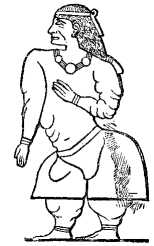
Queen of Punt. Opposite end on the same pole? i.e., 'Fat of the Land'. Isaiah 19:19 to enlarge.
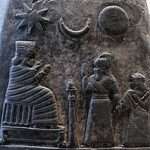
'Spots' or 'stripes'?
AND/OR: ''In the center of the altar, just below the line of elemental tools, Jeanette placed a copper pentacle. Above it she placed a statue of a figure i had never seen before. It was African. All of her features seemed elongated - an equiline nose, large and upwardly slanting eyes {'almonds'?}, narrow ears, and hair rising straight up from her head like a crown of waves. Even her breasts were long and narrow. Her entire upper torso was covered with lines of red dots, her lower half was painted with white lines from her waist to her toes. 'That's Oya.' Jeanette emphasized the second syllable of her name. 'She's a very powerful orisa of Ifa, the Yoruban religion of my ancestors. Maybe, one of the most powerful. She's the whirlwind, the tornado.'' [Page 238 'The Book of Shadows'].
Spots / Stripes to enlarge.
Side note: ''Elongation, in astronomy, the angular distance in celestial longitude separating the Moon or a planet from the Sun. The greatest elongation possible for the two inferior planets (those closer than the Earth to the Sun) is about 48° in the case of Venus and about 28° in that of Mercury.''
Near/Afar to enlarge. {'line of sight'}?
Continued: ''To suffer serious consequences as a result of your own actions is to 'reap the whirlwind'....'' ['The Chase'].
And/or: From a different perspective: 'The phrase is generally understood to be a reference to opera sopranos, who were traditionally amply contoured. The imagery of Wagner's opera cycle Der Ring des Nibelungen and its last part, Götterdämmerung, is typically used in depictions accompanying uses of the phrase. The "fat lady" is thus the valkyrie Brünnhilde, who was traditionally presented as a very buxom lady. Her farewell scene lasts almost twenty minutes and leads directly to the finale of the whole Ring Cycle.[1] As Götterdämmerung is about the end of the world (or at least the world of the Norse gods), in a very significant way "it is [all] over when the fat lady sings."
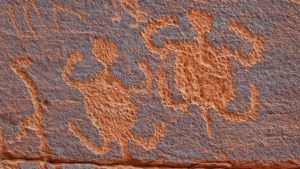
Possible turtle people emerging from a horizontal crack. 'Carapace' to enlarge.

A 'hiding' place for a lamp?
''God' is the Light of the heavens and the earth. The parable of 'his' Light, is as if, there were a niche and within it a lamp, the lamp enclosed in glass, the glass as it were a brilliant star lit from a blessed tree, an olive, neither of the East, or of the West, whose oil is well-neigh luminous, though 'fire' scarce touches it; light upon light....." [Quran 24:35].
"'...foods untouched by fire''. Anything? It also indicates a direction - AS A MEANS - to a further understanding. Getting it or forgot it? Then use the 'find' box.
N.B. Glastonbury Tor in relation to ''Isle of glass''.
"The meaning of the niche is the faithful heart of the believer. The 'lamp' enlightening the niche of the heart is the essence of the heart, while the light that it sheds is the divine secret...."[ Chapter 9, 'The Secret of Secrets'].
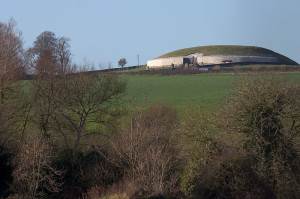
Newgrange On its Hill.
Built before Stonehenge or the Pyramids. Near the river Boyne.
"Newgrange is surrounded by archaic myth and legend. Known anciently as Brugh na Boinne, ['Palace' of the Boyne], this grand monument is said to be the 'tomb' of 'three times fifty sons of kings', belonging to the legendary kingdom of Tara." [Chapter eleven. 'The Cygnus Mystery']. Understanding this subjects symbolism, informs the reader what Newgrange is a representation of. Another clue...What does '150' represent, and ''tomb'' and...
"In more ancient times, it was the brugh ['palace'] or sidhe ['mound'], of Angus Mac Og, [Angus the young son], a leader of the legendary Tuatha de Danann, the children of the goddess Danu. Yet even before Angus got his hands, [link to 'grasp' symbolism] on Newgrange, it belonged to his father, Dagda, the 'good god'." [Same book and chapter, and / or 'The Kingship and Landscape of Tara' by Edel Bhreathnach].
Neolithic / pagan equivalent of the 'Wilderness story'. Or more to the point, the Hebrew equivalent of same. Question. What was Moses a representation of?
Side note. "Approximately 150 miles from Stonehenge to the west of Wales where the blue stones were quarried." ['Secrets of Stonehenge' /Satellite TV]. Coincidence or a meaningful one?


Paul Alexander. The Man. R.I.P.
"The river Boyne, like other Irish rivers, springs from a source beyond our time and space. This is the well of Segais, a place glimpsed repeatedly in descriptions of the 'Otherworld,' or of poetic art. Nine hazels grow above it, and their nuts fall into the water. Salmon dwell there, and feed upon the same. The 'nuts,' the 'water,' and the 'salmon' are all suffused with imbas, ''the great knowledge'' which illuminates the understanding of the wise.....Many have sought the the imbas of the Boyne. Heroes and sages have waited beside a pool of the river to spear the 'miraculous' salmon of wisdom; and the 'pygmy' harper Senbecc voyaged upstream in a little boat of bronze, in quest of the secrets of the nine hazels. The cryptic treatise which modern scholars call ''The Caldron of Poesy'' speaks of poets standing on the banks of the river every seven years in the middle of June, hoping to catch the imbas as it sped against the current.............We read such things and wonder what they mean."[Chapter entitled 'The Waters of Vision and the Gods of Skill' from the book 'Alexandria' Vol 1. Mentioned elsewhere].
'Tough nut to crack'?

Which ones the hero? or more importantly which one is the real patriot?

R.I.P
Refresher: ''I am the wind that blows across the sea; I am the wave of the deep; I am the roar of the ocean; I am the stag of seven battles; I am the hawk on the cliff; I am the ray of sunlight; I am the greenest of plants; I am a wild boar; I am a salmon in a river; I am a lake on a plain; I am the word of knowledge; I am the point of a spear; I am the lure beyond the ends of the earth; I can shift my shape like a god.'' ['The Song of Amergin' / Ancient Irish Text].
Duration 'Six' minutes.
{And/or}: "...once the Strong Door {oak?] is opened, the 'spell' of the otherworld is lifted and 'remembrance returns' in a painful flood." [Page 47 'Mabon and the Mysteries of Britain: An Exploration of the Mabinogion' / C. Mathews].
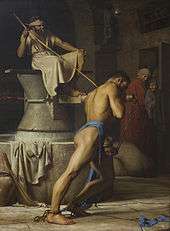

''Its best to talk about it.'' Question. Does that notable family talk about anything internal? Black or white? To lead by example? Kingship?
Something extra: {meaning got from it?}: ''How can we escape from the 'wheel'? This was the problem of the Sun-hero Samson when he was harnessed to the corn-mill of Gaza; and it should be noted that the term 'corn-mill' was applied in Greek philosophy to the revolving heavens. Samson revolved the problem magnificently by pulling down both posts of the temple so that the roof collapsed upon everyone. The Orphics had another quieter solution and engraved it in cypher on gold tablets tied around the necks {'taurus' link?} of their beloved dead. It was not to forget. To refuse to drink the water of Cypress- shaded Lethe however thirsty one might be, to accept water only from the sacred {hazel-shaded?} pool of Persephone, and thus to become immortal lords of the dead, excused further Tearing to Pieces, Destructions, Resurrections and Rebirths. The cypress was sacred to Hercules...typified rebirth...and the word 'cypress' is derived from Cyprus, which was called after Cyprian Aphrodite, his mother." [Page 140 'The White Goddess' / R. Graves. Includes parethsis].
Try forgetting/Remembering. And/or: Bitter/sweet.
'Sunshade'?
"We can consider a related question: in which direction does inspiration move between the worlds? The Boyne springs from Segais , and its 'virtue' comes from the 'magic' hazels at its source. Why then in ''The Cauldron of Poesy'' does the imbas move upstream rushing from sea to spring? [Same chapter, same book i.e., 'Alexandria' / Vol 1].
Sea's = E/W? Rivers S/N?
N.B. The oasis Siwa in Egypt was chosen also because of its springs.
"A spring in the step''.
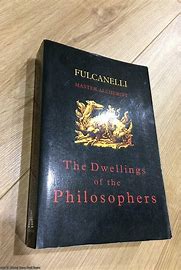
Mantle within the earth relative to the one on a fireplace.....as a means?
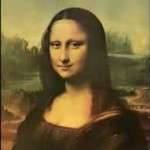
Anima?
"The initiate is he who possess the 'lamp' of Trismegistus, the 'mantle' of Apollonius, and the 'staff' of the patriarchs. The lamp - is reason illuminated by science; the mantle - is full and complete self possession, which isolates the sage from blind tendencies; and the staff - is the help of the secret and everlasting forces of nature. The lamp enlightens present, past and future, lays bare the conscience of men and manifests the inmost recesses of the female heart {anima?}. The lamp burns with a triple flame, the mantle is thrice folded and the staff is divided into three parts. The number nine [i.e.,3x3. Recall what the ''triple'' of any number indicates - TOGETHER WITH WHAT THREE INDICATES. Clue. ''knock, knock. Hear anything?] - is that of divine reflections; it expresses the divine idea in all its abstract power, but it signifies also extravagance in belief, and hence superstition and idolatry [i.e.,negative aspect]. For this reason Hermes made it the number of initiation, because the initiate reigns over superstition; [positive over negative] he alone can advance through the darkness, leaning on his 'staff', enveloped in his 'mantle' and lighted by his 'lamp'. Reason has been given to all men, but all do not know how to make use of it..." [Chapter Nine. 'Transcendental Magic' by E. Levi. Parenthesis; this readers input].
The observer being observed?
As a side note - what does ''transcendental'' indicate. Only mentioned in order to keep the reader fixed on this web sights main aim - objectivity at all times. It keeps ones feet firmly grounded. It reigns in - those first impressions {'horses' and 'chariot' in relation to the emotional stuff?}. As for the word ''magic'' - Look it up.
Side note: The English word 'focus' comes from the Latin for 'fireplace'. ['The Chase' / ITV / 31.1.22].
Hestia to enlarge.
'On Having No Head: Zen and the Rediscovery of the Obvious' / D. E. Harding.
"Everyone has an internal thought process: that silent other self who speaks to you; the one you debate with." [First sentence; first paragraph; first page of the book by Q. S. Lam].
"Magic being a practical science demands preliminary theoretical knowledge, as with all practical sciences." [From within the book by Tomberg].
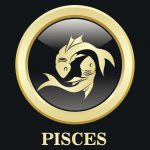
Little fish or large one?
"It was Heraclitus, at the dawn of western philosophy, who took a river as a symbol of linear time in his pronouncement that ''One cannot step into the same stream twice.'' But Greek myth hints at a deeper reality when it speaks of the cosmic river Okeanos, traditionally assigned the epithet ''flowing back upon itself'' - the source of all streams and seas. And in one verse of the 'IIiad,' - the origin of the 'gods.' ''[Same book].
"A river of thoughts."
Analogy of same. "From the earth did we create you, and in to it shall we return you, and from it shall we bring you out once again." [Quran 20:55].

''The Birth of the New Man.'' Smith/Jones to enlarge
"The 'river' springs from a hidden eternal source; but it flows everywhere, throughout the world, and returns at last to its own origin. In the mortal sphere, the eyes 'feed' the mind; in the land of Promise, where the senses leap from the well of knowledge, it is the mind which feeds the eyes. 'See' it? Immanence and transcendence are wedded here, as they are in the mystery of incarnation which lies at the basis of the sacred art of Christianity." Put ''incarnation'' in the usual box. [ 'Gifts of the Desert: The Forgotten Path of Christian Spirituality' by Kyriacos C. Markides]. Then try ''transcendent.''
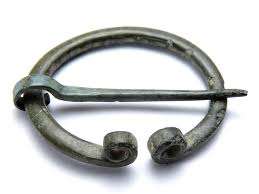
Penannular brooch. 'Gap'?
Side note: ''Seville (/səˈvɪl/ sə-VIL; Spanish: Sevilla, pronounced [seˈβiʎa] (![]() listen)) is the capital and largest city of the Spanish autonomous community of Andalusia and the province of Seville. It is situated on the lower reaches of the River Guadalquivir, in the southwest of the Iberian Peninsula.''
listen)) is the capital and largest city of the Spanish autonomous community of Andalusia and the province of Seville. It is situated on the lower reaches of the River Guadalquivir, in the southwest of the Iberian Peninsula.''
Continued: "The waters of the Gap:[key] The Mythology of Aquae Sulis' by R. Stewart.
''The 'eyes of the soul' - are what we call in modern Hermeticism the 'lotus flowers' or simply 'lotuses', and what Hindu yoga names 'chakra centers' or 'chakras'."
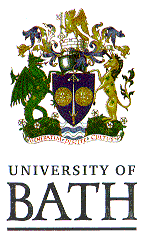
Griffin and Unicorn 'sacred' animals within this subject. Sacred in relation to the intent of 'esoteric'. A 'mystical' intent and potential relative to a learning curve - one that supposedly benefits the individual. Represented by those two ''imaginative'' figures. A potential 'to be' realized - from a figment? of the imagination to realization - symbolic of. Question. Childhood fantasies? Try ''horn'' , i.e.,what does it REPRESENT?
"A valuable insight into the origin of the site is found within the place name itself...Aquae Sulis. Aquae of course, is Latin, and means ''the waters of'', but the term 'Sulis' has never been translated or analysed. In various inscriptions the word Sulis is linked directly to the name Minerva, a Roman Goddess, and Sulis is also found in its own right as a separate name specifically referred to as feminine...''The waters of the Goddess of the gap''...
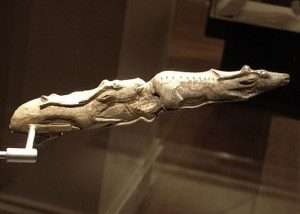
The 'tip' of a mammoth horn - in two pieces.
A working example: ''The final medial location we shall discuss is First Mesa with its corresponding star Alnitak {'the girdle'}. Alnitak is the eastern star of the belt and the last of the three to rise. Indeed, the villages of First Mesa were the last to be settled....The narrow mesa provides a breathtaking location for a pueblo, and Walpi is perhaps the most dramatically stuated of all the Hopi villages. Literally meaning ''the place of the gap'' this pueblo of over one hundred rooms is perched on the extreme tip of the mesa.'' [Page 67/8 'The Orion Zone' / G. A. David].
Elden Pueblo was the original home of a number of clans, including Badger, Water, Snake, and Antelope...'' [Page 69 same book].
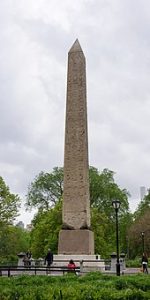
'Bridge' a gap?
Together with...in both Welsh and old Irish, the word ''suil'' or ''sulis'' means an eye, gap or orifice." [Both paragraphs taken from the above mentioned books]. Think about it in relation to the 'gap' implied between 'salt' and 'fresh' water. What 'it' represents [macro]. Together with the word ''leap''. What it represents [micro] - Relative for an understanding to take place. Hebrew equivalent - the 'gap' between the top three [i.e.,Kether, Binah and Hokhmah] and the rest of the tree. The 'gap' between higher/lower. Represented as a 'void' [Daath]. Anything? Or the word 'see' as indicated throughout. That link to the word ''Gnosis''. Its main intent and purpose - the end result of which - could be described as ''the transcendent third''.
"Got to see it, rather than just read it..." John Humphrys talking to D. Tennant and Greg Doran in relation to the plays by W. Shakespeare. [400th anniversary. Radio 4. 23/04/16].
'Ineffable' = ''incapable of being expressed or described in words.'' Once the above is applied - that which was once ''ineffable'' - becomes 'effable' ?

Sutton-Hoo-Suffolk: "Before any vessel may be filled with any specific content, it must be empty. Before a single number is accountable, Zero must be assumed. No creation is possible without the void. Writing can only be recorded on BLANK paper, or sound on a clean tape." {Page 24 'Magical Ritual Methods' / W. Gray}.
And/or..."Gnostics interpret the stories and teachings of their spiritual tradition as signposts pointing beyond words altogether to the mystical experience of the ineffable mystery." [From the book by T. Freke and P. Gandy].
Analogy of same..."Why does the world begin with Chaos? The Greek word chaos, associated with the verb 'chasko', signifies a void, an abyss, unlimited space, infinite darkness, unformed matter...Although it is difficult to see how any order can exist prior to chaos, some scholars have argued on the basis of its etymology that Chaos signifies ''a moment of division or separation'' and thus implies ''a change that takes place in some already existing entity or situation.'' This is certainly possible, but problems arise when it comes to identifying the ''entity or situation'': the usual explanation, derived from Near Eastern parallels, that Chaos represents the gap between earth and sky [before these two actually exists]...If we accept the view that some primal substance or situation antedates the existence of chaos, we must remember that Chaos means ''darkness'' as well as ''gap'': although a change in a pre-existent situation may be implied, this change itself is lost in darkness and imperceptibility."[Chapter 4, 'The Origin of the Gods: A Psychoanalytic Study of Greek Theogonic Myth' by R. Caldwell]. 'See' it? i.e.,...
''Light'' in relation to a ''line of sight''.
''Live coals'' ?
 ''Two fires ignited by rotating drills and kept going by pieces of coal obtained from Black Mesa represent the suns gift to Masau'u , who in turn redirects Tawa's warmth and light to the earth for the benefit of all its creatures including humankind....
''Two fires ignited by rotating drills and kept going by pieces of coal obtained from Black Mesa represent the suns gift to Masau'u , who in turn redirects Tawa's warmth and light to the earth for the benefit of all its creatures including humankind....

'Needle' to the sky? To 'bridge' a void? ONE horn or TWO?
At one point in the Wuwutcim ritual - in the Sparrow Hawk Moon of November- Being an initiation involving the symbolic 'death' of adolescent males and their subsequent rebirth as mature men {'chattering sparrows'?} - Men with large pointed stars on their foreheads descend the kiva ladder along with Masau'u, whose face and neck is coated an ashen grey.....the face and body of the god are a shiny black...associated with coal....This New Fire Ceremony is a re-establishment of a connection between the living and the dead. At the time when the central star of Orions Belt is directly above {'line of sight'?} the fire burning down in the kiva, a Two Horn priest recounts the Emergence legend in which Masau'u played a crucial role and reminds the participants of the long journey their ancestors made from the tripartite underworld {i.e., golden, silver, bronze} - up to the present existence {i.e., iron}.'' [Page 47 'The Orion Zone' / G. A. David].
N.B. That 'journey' back made in REVERSE order i.e., From 'iron' back DOWN to 'gold' - in the INNER SENSE of the word.
"Well, now that we have 'seen' each other, said the unicorn - if you'll believe in me, i'll believe in you. Is that a bargain?' 'Yes, if you like,' said Alice.'' {'Through the Looking Glass' / L. Carroll. Emphasis, this readers]. Try ''glass''. And/or ''mirror''.
''Most common beliefs state that all unicorns are male. However, these beliefs have no real foundation. Moreover, unicorns are usually associated with grace, purity, and innocence, all virtues of fair maidens and fairies.''

Mastermyr chest. GOTLAND. Most of the find had been placed in the chest, but there were also objects around it such as three bronze cauldrons, three bells and a fire-grid of iron. A chain, made up of twentysix figure-of-eight shaped links, was wrapped around it. It served both as an extra lock and handle since the chest was too heavy for the original handle. The chest and the other items had probably been placed in a boat which capsized and sank in the lake. Another theory is that the chest was temporarily hidden at the water's edge.
The chest contained Viking-era blacksmithing and woodworking tools. It also contained several products of such work, including elements of several locks. The chest and its contents provide a valuable insight into technology during the Viking Age.

Inner/outer?
Unicorns have been linked to Scotland for centuries. In Celtic mythology the unicorn was a symbol of purity and innocence, as well as masculinity and power. Tales of dominance and chivalry associated with the unicorn may be why it was chosen as Scotland’s national animal.While the animal is mythological, the ideals it represents are what make it a perfect fit as the national animal for Scotland, and because like this proud beast – Scots would fight to remain unconquered....

Keresh (Hebrew קֶרֶשׁ) is a Talmudic unicorn living in the forest of Bei Ila'ei. It is similar to a deer, but the length of its body is said to be sixteen cubits (8.6 m / 28.3 ft).
The unicorn was first used on the Scottish royal coat of arms by William I in the 12th century. In the 15th century, when King James III was in power, gold coins even appeared with the unicorn on them. When Scotland and England unified under the reign of James VI of Scotland in 1603, the Scottish Royal Arms had two unicorns supporting a shield. When James VI became James I of England and Ireland, he replaced the unicorn on the left of the shield with the national animal of England, the lion, to show that the countries were indeed united....
The unicorn representing Scotland in the coat of arms is always depicted bounded by a golden chain, which is often seen passing around its neck and wrapping all around its body. The unicorn was believed to be the strongest of all animals – wild and untamed, and that it could only be humbled by a virgin maiden. It is possible that the entrapment symbolises the power of the Scottish kings – they were strong enough to tame even a unicorn....Did you know that Scotland has a National Unicorn Day? It's on the 9 April every year!
3x3?

Embossed/Debossed?
Side note: ''Nicknamed The Unicorn, the black hole is located right next to a red giant star called V723 Mon in the constellation of Monoceros. That's only 1,500 light-years from Earth, and the object appears to have a mass just three times that of the Sun. Both of those are possible records for black holes.'' [Wiki].
''Monoceros is a faint constellation on the celestial equator. Its definition is attributed to the 17th-century Dutch cartographer Petrus Plancius. It is bordered by Orion to the west, Gemini to the north, Canis Major to the south, and Hydra to the east.''
 Side note: ''The Dancing Girl is unusual and almost unique. At Harappa, what has been found far more commonly, are mysterious seals carved in reverse {embossed?} maybe to act as a stamp, leaving a clear image in wax {bee's wax?} - perhaps to seal a transaction....50% of which represent the unicorn. Normally associated with medieval Europe but which has its origins here in Pakistan...Eventually it completely disappeared from this region and travelled through Mesopotamia into ancient Greece and into the legends of Europe.'' ['Treasures of the Indus' / BBC4].
Side note: ''The Dancing Girl is unusual and almost unique. At Harappa, what has been found far more commonly, are mysterious seals carved in reverse {embossed?} maybe to act as a stamp, leaving a clear image in wax {bee's wax?} - perhaps to seal a transaction....50% of which represent the unicorn. Normally associated with medieval Europe but which has its origins here in Pakistan...Eventually it completely disappeared from this region and travelled through Mesopotamia into ancient Greece and into the legends of Europe.'' ['Treasures of the Indus' / BBC4].
Refresher: East a beginning. West its ending....
As is: ''Snakes and Ladders dates back to ancient India {moksha patam} - a board game for the 'young'....'' ['Chase the Case'].
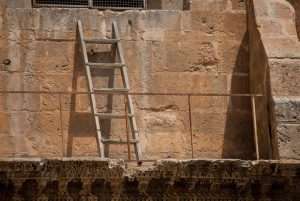
Looking in or out?
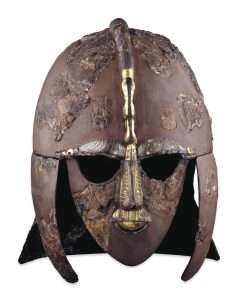
Snakes or dragons? Sweat of the brow?
The game was popular in ancient India by the name Moksha Patam. It was also associated with traditional Hindu philosophy contrasting karma and kama, or destiny and desire. It emphasized destiny, as opposed to games such as pachisi, which focused on life as a mixture of skill (free will)[5] and luck. The underlying ideals of the game inspired a version introduced in Victorian England in 1892. The game has also been interpreted and used as a tool for teaching the effects of good deeds versus bad. The board was covered with symbolic images used in ancient India, the top featuring gods, angels, and majestic beings, while the rest of the board was covered with pictures of animals, flowers and people.[6]  The ladders represented virtues such as generosity, faith, and humility, while the snakes represented vices such as lust, anger, murder, and theft. The morality lesson of the game was that a person can attain liberation (Moksha) through doing good, whereas by doing evil one will be reborn as lower forms of life. The number of ladders was fewer than the number of snakes as a reminder that a path of good is much more difficult to tread than a path of sins. Presumably, reaching the last square (number 100) represented the attainment of Moksha (spiritual liberation).[citation needed]
The ladders represented virtues such as generosity, faith, and humility, while the snakes represented vices such as lust, anger, murder, and theft. The morality lesson of the game was that a person can attain liberation (Moksha) through doing good, whereas by doing evil one will be reborn as lower forms of life. The number of ladders was fewer than the number of snakes as a reminder that a path of good is much more difficult to tread than a path of sins. Presumably, reaching the last square (number 100) represented the attainment of Moksha (spiritual liberation).[citation needed]
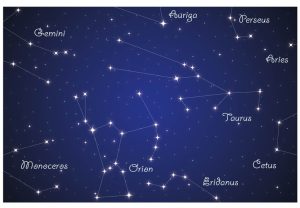

Someone's pet monkey? Where exactly does he put his fingers to wind it up?
Continued: Analogy {i.e.,from a different perspective}: "It should be said that totem animals formed an extremely important part in the mystery beliefs of our remote ancestors. They remain important in folk lore and mythology, whether in the animal-headed gods of the Egyptians or in the creatures of fairy tales that often give guidance into 'hidden' realms or bring aid or information. Thus more attention might well be paid to the mythical creatures that appear in Rosicrucian and alchemical symbolism. They are guides and bearers of forces and influences beyond the normal frontiers of human cognition..." [Extract from the book by G. Knight. Emphasis,this readers].
From something 'unknown'[''darkness''] - to becoming 'known', i.e.,a known value. a KNOWN QUANTITY. The boundaries between the two = a gap. That ''gap'' that can be bridged by - a leap of the imagination?
![220px-Paderborner_Dom_Dreihasenfenster[1]](https://esotericbasics.co.uk/wp-content/uploads/220px-Paderborner_Dom_Dreihasenfenster1.jpg) The author {Caldwell} using Freudian psychoanalysis to determine all aspects of Greek mythology; Paternal sexuality in relation to their offspring - becoming aware of their own ''desires'' [in all forms and shapes] because of it - i.e.,''divine fire signifies paternal sexuality'' and/or ''The theft of fire is a sexual crime''.[Chapter 3]. He does the same with the concept of the word 'Ambrosis' - the 'food of the gods' [Explained elsewhere]. "Ambrosia is the Greek version of various divine substances in Indo - European mythology that symbolize semen and paternal sexuality." [Chapter 4].
The author {Caldwell} using Freudian psychoanalysis to determine all aspects of Greek mythology; Paternal sexuality in relation to their offspring - becoming aware of their own ''desires'' [in all forms and shapes] because of it - i.e.,''divine fire signifies paternal sexuality'' and/or ''The theft of fire is a sexual crime''.[Chapter 3]. He does the same with the concept of the word 'Ambrosis' - the 'food of the gods' [Explained elsewhere]. "Ambrosia is the Greek version of various divine substances in Indo - European mythology that symbolize semen and paternal sexuality." [Chapter 4].
Finally he speculates on why Tantalos was punished for revealing to men the 'mysteries of the gods'...i.e.,"If we knew nothing further about the exact content of these secrets, we might never the less suppose, on the hypothesis that myths represent the wish of fulfillments of childhood fantasies, that the ''secrets'' of the gods are in fact the secrets of the parents, specifically the secrets of parental sexuality." [Chapter 4].
A closer answer would be got from the chapter 'A Feast of Maturity' from the book 'A Mythic Life' / J. Houston.
Psychology -this subjects main ''teaching'' aid. It attempts to define the 'bigger' picture - represented by something- other than the obvious. Question. Why is that subject chosen? Clue. 'You cant have one without the other [in relation to the 'divine bit'] but one has to come before the other'. Can there be any other subject to define that 'point' to the observer and/or reader?

Self-serving?
Question. When all the available information is accessed - what do you think? Can you see what the author cannot?

''I'M just glad he got his FLOWERS while he was alive.'' {BBC NEWS/21.2.22}. ''A selfless man''. R.I.P
A side step: "Other examples of a Cauldron of Regeneration are to be found in the cauldron of the Alchemists and the cauldron of the Chinese and Hindu philosophers. In all these instances the cauldron is believed to have 'power' to change the base materials into the spiritual, the mortal into the 'immortal' {effable / ineffable?}. It brewed the drink of immortality and spiritual regeneration, and also the drink of inspiration." [Chapter 10, of the book by M. Esther Harding]. Link to ''Ambrosia''. Concept of.
Honey mead?
Holyhead?
'Twentytwo'?

R.I.P.
''In 1965 Vietnam seemed like just another foreign war, but it wasn't
It was different in many ways, as so were those that did the fighting.
In World War II the average age of the combat soldier was twentysix
In Vietnam he was nineteen.'' [Paul Hardcastle].
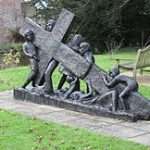
Childs play?
Side note: ''Once in a courtyard cafe in Khan el Khalil, i caught the scent of the body of heaven, the intoxicating perfume of pressed flowers. What were those bright petals crushed {'bruised'?} in the embrace of form? What were the names of her children? On the way to Giza a splash of red petal had streaked past the car. ''What was that flower?'' i asked the driver. 'Zu-hoor. All are zu-hoor. Flower is for woman to know. Dont ask me i'm a man.' In Khan el Khalil essence of zu-hoor wafted across the table, mingled with the aroma of thick, black coffee.'' [ Page 335 'Dreams of Isis'].
''Ethiopia is Africa's leading producer of coffee.''
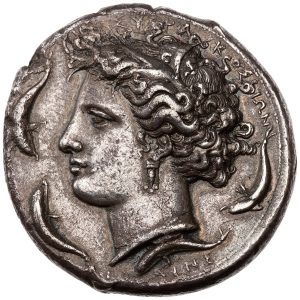
Arethusa.

''Minerva protecting Peace from Mars or Peace and War is a painting by Peter Paul Rubens. He produced it in London between 1629 and 1630, during a diplomatic mission from the Spanish Netherlands to Charles I of England. It is now in the National Gallery, London.
It shows Minerva (goddess of war, wisdom and crafts) fighting off Mars, with the nude figure of the goddess Pax (commonly known as "Peace" in English) in the centre.''
A {working?} example {the very first one?}: "Hera cleansed all the dirt from her fair body with ambrosia, then she anointed herself with olive oil, ambrosia, very soft, and scented specially for herself - if it were so much as shaken in the bronze floored 'house' of Zeus, the scent pervaded the universe of heaven and earth. With this she anointed her delicate skin, and then she plaited the fair ambrosial locks that flowed in a stream of golden tresses from her immortal head. She put on the wondrous robe that Athene had worked for her with consummate art, and had embroidered with manifold devices; she fashioned it about her bosom with golden clasps, and she girdled herself with a girdle that has a hundred tassels: she then fastened her earrings, three brilliant pendents that glistened most beautifully, through the pierced lobes of her ears, and threw a lovely new veil over her head..." ['Homer's Secret Iliad'].

Sumerian equivalent i.e., pictographic sign for gods = Two syllable word: Din.gir. [ Shem in relation to Mu and me-s]. Explained within. [Page 169, 12th Planet]. Mentioned elsewhere].
Side note: The ''pierced earlobes'' in the tomb of King Tut. Coincidence or a ?
And/or the ''Ear tablets'' found at Sais in the Nile Delta. Enlarged elsewhere.
Now use that principle {inspiration?} to define the following...
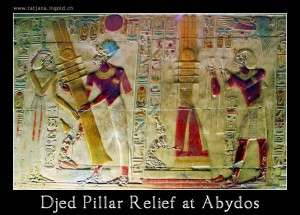 Compare all four 'Human forms' to see if you agree or disagree. in relation to this subject. Firstly with Mr Sitchin ‘hypothesis’ of it being a ’rocket ship’. Or Mr Burkert opinion, [ ‘Creation of the Sacred’. Chapter four ]...that all headgear is worn...,"To increase the height". Which fits in with his...authority over the masses hypothesis... While recalling obvious circumstantial information such as; as it is in Miss Lamys book...that the ‘human spine’ can be both in the horizontal and vertical position.
Compare all four 'Human forms' to see if you agree or disagree. in relation to this subject. Firstly with Mr Sitchin ‘hypothesis’ of it being a ’rocket ship’. Or Mr Burkert opinion, [ ‘Creation of the Sacred’. Chapter four ]...that all headgear is worn...,"To increase the height". Which fits in with his...authority over the masses hypothesis... While recalling obvious circumstantial information such as; as it is in Miss Lamys book...that the ‘human spine’ can be both in the horizontal and vertical position.

In Timaeus Plato wrote ''God laid the soul of the world in the shape of a cross through the cosmos, and stretched out over it, the world body.'' Think about it, in relation to what this subject implies, relative , to horizontal / vertical, together with the precession of the Equinoxes. It was also, according to Stecchini ''the symbol of the Pythagorean sect.'' [ Secrets of the Great Pyramid] . See anything in reverse? [or upside down].
"The symbolic significance of the Djed pillar, found widely throughout Egypt, is not known. It is thought to represent stability. It seems likely that the symbol represents four separate pillars, one inside the other, each representing one of the cardinal points. Loss of any single pillar would lead to instability." [Page 124, 'The Tutankhamun Prophecies']. Question. What do you think when all the available 'evidence' is assessed?
"The four - tiered Djed column is also an emblem peculiar to Asar [Osiris]. In amulet form it represents the trunk of the Acacia tree in which Asar was concealed and found by Auset [Isis] after his death. It is also believed to signify the spinal cord of the god, symbolically 'raised' at his restoration. Its four tiers correspond to the four regions of the spine: the cervical, thoracic, lumbar, and sacred vertebrae. In amulet form, the Egyptians believed "it gives the power to reconstitute the body and become a perfect soul."

Wedding ring?
Side note: ''The term nfr has been incorporated into many names in Ancient Egypt. Examples include Nefertiti, Nefertari, and Neferhotep.
The term was extremely positive considering that it refers to the heart, which to the ancient Egyptians was the home of feelings and intent (good and bad).
'Beautiful' one?
Some scholars suggest that it was used in ancient Egyptian construction where 'nfrw' was used to denote 'level zero' of a building and in accounting where 'nfr' would refer to a zero balance.'' [Wiki].
'Eclipse'?
Libra? Weighing of the Heart?
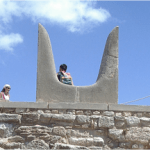
''V'' ?
''Called by astronomers the First Point of Aries, this junction where the sun crosses the equator in its northward journey marks zero point in the measurement of right ascension which can be conceptualized as celestial longitude.'' [Page 117 'The Orion Zone' / G. A. David].
''Ascension Island is part of the United Kingdom Overseas Territory of St Helena, Ascension, and Tristan da Cunha. The territory is presided over by a Governor who is resident in St Helena and appointed by HM the King.''
N.B. Directly ''straight south'' of the UK. Under the equator.
Continued: ''The Djed column symbolizes the 'Principle of Renewal,' which Asar performs as 'sovereign' of all human beings, in that he serves as the prototype of the human form. One of his names, ''Un Nefer,'' means to ''spring up, arise." The hieroglyphic sign used to denote his name in this aspect is the hare, a symbol of the spring season in numerous cultures, and a representation of 'reproduction' in nature. However, in the context of Asar, the hare represents the circulation of the individual life force, which ''rises'' from this life into the next." [Chapter two, 'The Sacred Tradition in Ancient Egypt']. That understanding of which cannot come about without its 'eureka' moments.
An intuitive 'leap'? or a leap of faith?
A working example: ''By day there is an exhalation {nightly one = inhalation}, as the sun comes forth, expressed by the AIR god, Shu, joyfully raising the sun-boat aloft in the Book of Day's first hour. This daytime sky encompassed by Nut is the sun gods 'light span' of life, beginning with his birth in the first glimmer of light {'shining'?} in the S/E and journeying in increasing brightness to noonday SOVEREIGNTY, followed by fullness and maturity in the afternoon of life. Then as light wanes, he descends into the sunset of old age in the N/W, where the great sky goddess swallows the sun in order for him to be reborn again at dawn.'' [Page 17/18 'Hathors Alchemy' / A. Roberts].
''Meridian of the Sun.'' to enlarge.
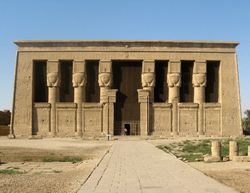 ''From this NOONDAY chamber the journey flows westwards to the 'Pure House' along a connecting small passage which also intersects with the crypts entrance leading from the Per-Neser above, an entrance precisely aligned with the eighth hour.'' [Page 94].
''From this NOONDAY chamber the journey flows westwards to the 'Pure House' along a connecting small passage which also intersects with the crypts entrance leading from the Per-Neser above, an entrance precisely aligned with the eighth hour.'' [Page 94].
Octave?
Leads eventually to the the ''Field of Reeds.''
And/or: ''Enclosed by the sky goddess Nut, the heavenly sun shines on the head of Hathor placed on an ediface representing Denderah temple. On the legs of Nut is a scarab, symbolizing the zodiacal sign of Cancer, which is equated with Mesore, the last month of the Egyptian year when Re's annual birth is celebrated. This combination of 'birth' - mirrors the Book of Day's opening scene...'' [Page 81].
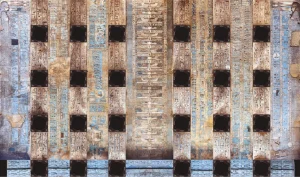
Spots + stripes?
''In the Christian tradition, the twentyfifth of March, is the date that Mary was told she would give birth to Jesus.''
Conception to enlarge.
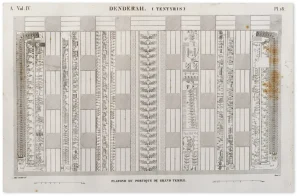
A reconstruction of the pronaos’s ceiling by Jollois and de Villiers. Image: Description de l’Égypte, vol.IV, pl.19. AND/OR: The Greek word “pronaos” (Πρόναος) refers to the outer part of an ancient Greek temple. It forms a portico immediately in front of the cella, which is the inner sanctuary of the temple. The pronaos is delimited by the front wall of the cella and the columns or the antae (the projecting walls at the sides of the cella). Essentially, it serves as an entrance area or vestibule before entering the main temple structure. In early Christian architecture, the term “pronaos” was also used to describe the narthex, which is the entrance or lobby of an early church.
N.B. 'Twentyfour' columns within Denderah. 'Eighteen' on the inside six on the facade.
And/or: The inner space of the temple of Seti I at Abydos dedicated to six Egyptian gods. On the facade of the building can be seen six apertures either side of the main entrance. A total therefore of thirteen.
Inner/Outer.
Right at the heart of Egypt, situated 60 miles north of Luxor and to the south of Abydos, lies the Dendera temple complex – an important religious site in antiquity.
The construction of the main structure of the complex, the Temple of Hathor, was commissioned by the pharaoh Ptolemy XII. His daughter Cleopatra VII, the last pharaoh of Egypt, continued the construction work after his death. Commemorating her dedicated support, a relief showing Cleopatra and her son Caesarion graces the outer southern wall of the temple {'BEHIND'?}, serving as an enduring testament to her patronage.

90 V 180? {18x6}.
The temple is perhaps best known for the Dendera Zodiac, an intricately carved circular bas-relief depicting celestial constellations, including those of the zodiac, which is now on display in the Musée du Louvre. The real gem of the temple, however, is the beautifully decorated ceiling commonly known as the ‘Rectangular Zodiac’. It is located in the pronaos of the temple, which is roughly the size of two tennis courts. The brilliance of its original colours can be seen today thanks to the restoration work sponsored by Egypt’s Supreme Council of Antiquities. The worship of Hathor can be traced as far back as the Early Dynastic Period (c.3100-2686 BC) in Egypt.

Astro ceiling in Senenmut bare tomb chamber. White plaster? 'Folded'?
She was a multifaceted deity associated with various aspects of life, including music, dance, and rhythmic movements. She was also the personification of emotions and the moods aroused by music. She could be joyful and tender, but sometimes full of rage, dissonant, and violent. Hathor assumed the sacred role of the goddess of birth and fertility, presiding over the cyclical rhythms that define life’s perpetual dance. Frequently portrayed as a celestial cow adorned with a radiant solar disc between her majestic horns, she symbolises motherhood and nourishment. Her milk was the Milky Way, overarching the celestial dome, giving nourishment to souls during their perilous journey through the underworld. As a celestial deity, she helped to preserve cosmic harmonies.

Milky white?
Those cosmic harmonies are the subject of the ceiling of the pronaos of her temple. The ceiling is supported by TWENTYFOUR imposing columns, fashioned in the likeness of a sistrum, a musical instrument symbolic of the goddess Hathor. The seven panels (Central, East 1-3, and West 1-3) of the ceiling beautifully depict the different celestial rhythms observed by the ancient Egyptians. Together they encompass the totality of existence: from the present, on the central panel, to eternity on the sides. The three panels to the east of the central one represent the day, and the three to the west represent the night. Those cosmic harmonies are the subject of the ceiling of the pronaos of her temple. The ceiling is supported by 24 imposing columns, fashioned in the likeness of a sistrum, a musical instrument symbolic of the goddess Hathor. The seven panels (Central, East 1-3, and West 1-3) of the ceiling beautifully depict the different celestial rhythms observed by the ancient Egyptians. Together they encompass the totality of existence: from the present, on the central panel, to eternity on the sides. The three panels to the east of the central one represent the day, and the three to the west represent the night.
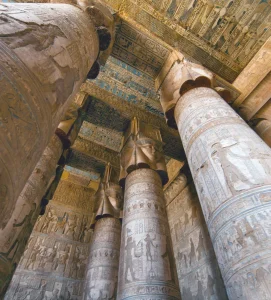 The central panel, on the temple’s axis, sets the connection between heaven and earth, the divine and the mundane. It represents the present and depicts a winged solar disc, a symbol of Horus incarnated as the pharaoh.
The central panel, on the temple’s axis, sets the connection between heaven and earth, the divine and the mundane. It represents the present and depicts a winged solar disc, a symbol of Horus incarnated as the pharaoh. 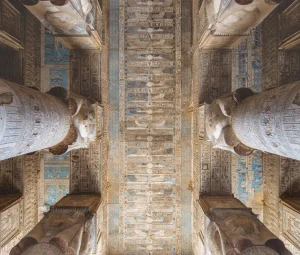 On panel East 1, 12 boats representing the 12 diurnal hours of the day, carry the sun on its daily journey across the sky. A different representation of the sun sits on each boat: a child at sunrise; a teen at mid-morning; a four-headed ram at noon; a mature man at mid-afternoon; and an old man at sunset. Panel West 1 represents the lunar month. The moon is depicted in perhaps the most exquisite scene of the whole ceiling, at the centre of this panel. Fourteen deities – the Heliopolitan Ennead – are climbing a staircase, helping with the reconstruction of the dismembered body of Osiris, the moon, shown as the eye of Horus. Each step on the staircase represents one of the days of the moon’s waxing. The reconstruction is orchestrated by the wisdom of Thoth, who presides over the scene.
On panel East 1, 12 boats representing the 12 diurnal hours of the day, carry the sun on its daily journey across the sky. A different representation of the sun sits on each boat: a child at sunrise; a teen at mid-morning; a four-headed ram at noon; a mature man at mid-afternoon; and an old man at sunset. Panel West 1 represents the lunar month. The moon is depicted in perhaps the most exquisite scene of the whole ceiling, at the centre of this panel. Fourteen deities – the Heliopolitan Ennead – are climbing a staircase, helping with the reconstruction of the dismembered body of Osiris, the moon, shown as the eye of Horus. Each step on the staircase represents one of the days of the moon’s waxing. The reconstruction is orchestrated by the wisdom of Thoth, who presides over the scene.
Panels East 2 and West 2 depict one of the most ingenious ideas devised by the ancient Egyptians: the decans. They divided the sky into thirtysix equal parts, in each of which they identified a group of stars so that they could recognise that region at night. The first decan to appear on the eastern horizon at sunset marked the first hour of the night. As the night advanced, a new decan appeared on the horizon, allowing them to count the 12 hours of the night. Every ten days, a new decan appeared on the horizon at sunset.
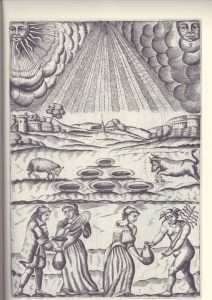
Venus/Mars. Taurus/Aries. Sheep decan?
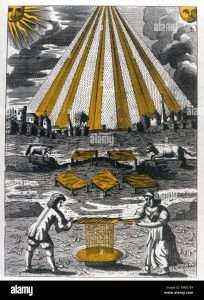
Twisting.
In the outer panels, East 3 and West 3, the ceiling is enclosed by two images of the goddess Nut arched across the sky. She is eternity, the vast and dark space in which the celestial dance occurs. She is shown swallowing the sun at sunset and giving birth to the sun at sunrise. These two panels are further divided into an upper and a lower track. In the lower one, the boats of the decans navigate the nightly ocean, while the upper one shows the different planets, stars, and constellations, including the 12 constellations of the zodiac. Astronomer priests standing on the roof of the temple carefully observed, measured, and recorded the movement of the celestial bodies, and noticed their correspondence to natural events (such as the flooding of the Nile, which coincided with the rising of the star Sirius near the sun and marked the beginning of their year). Based on their observations, they created calendars that regimented their rituals and festivals. These rituals regulated the activities of Egyptian society: the time to plough, the time to plant, the time to harvest.
Side note: The frequency of eclipses varies depending on the type of eclipse12. In most calendar years, there are two lunar eclipses, but in some years, one, three, or none occur1. Solar eclipses occur two to five times a year, with five being exceptional1. The average number of total solar eclipses in a century is 66 for Earth as a whole1. Approximately once every eighteen months, a total solar eclipse is visible from some place on the Earth’s surface

Seventytwo to enlarge.

Head/Feet = Aries/Pisces?
And/or: A work in progress: ''A unique scene to Abydos. In the sacred precinct of the complex {at the time of Tutankhamun?} . The symbol of Osiris being carried by 24 priests after a procession outside for a certain feast, and supposedly the head of Osiris is buried here. Outside the walls are found at least 2000 rams {heads?} in mummified form {in a long procession?}. The idea of Akhenaten is long gone, its not there anymore - because, as a matter of fact, found in the FOUNDATION of Ramses II temple just a kilometer away were found fragments from Amarna - used as filler for his foundation.'' {Dr. Sameh: 'Tutankhamun: Allies and Enemies' / PBS America}.
The indication being its a negative act. From the Aten 'back to' Amun.
Question. Could it not have been a positive one?
'Two steps forward and one back' to enlarge. Retrograde?
As Dr. Samek says at the beginning of the program: '100 years after the discovery of Tutankhamun, people believe that this is a chance for Tutankhamun to give his story. But does it? Does his tomb, mummy and objects tell us what he really wanted to say? Or is it us that are imposing our own ideas upon him?

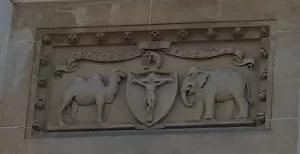
Inverness - CITY - Coat of Arms. Desert animals?
Continued: 'Thirteen' in relation to: "The full moon gives its clue. The markings seen on its face are called The Mark of the Hare in Tibet, China, and Ceylon, as well as in Africa and North America. Indeed the Hare in the Moon is as well known as our own Man in the Moon. The rabbit or hare represents to the negro as well as to the American Indian, the animal incarnation of the hero. We recall the stories of Brer Rabbit among the negroes of the United States which correspond exactly to myths of a rabbit hero in West Africa. In North America Indian mythology Hare plays a similar role. For instance, among the Iroquois, Great Hare is one form of Great Manitu, the Great Spirit, who is either himself the moon or his grandmother is the moon. This hare incarnation corresponds roughly to the Christian symbolism of Christ as Hero, who is the Lamb that was slain. The Easter Bunny contains a symbolism that lies close to these ideas. Easter, as we shall see later, was originally a moon festival and was connected with the resurrection of the moon man or moon hero, long before the dawn of Christianity." [Chapter 2, 'Women's Mysteries: Ancient and Modern' by M. Esther Harding]. From something [unknown] - representation of - to becoming known.

'Wedding' ring? Carapace?
''What is a desert? Deserts cover more than one-fifth of the Earth's land area, and they are found on every continent. A place that receives less than 10 inches (twentyfive centimeters) of rain per year is considered a desert. Deserts are part of a wider class of regions called drylands.''
WET/DRY.
''Inverness is a city on Scotland’s northeast coast, where the River Ness meets the Moray Firth. It's the largest city and the cultural capital of the Scottish Highlands. Its Old Town features 19th-century Inverness Cathedral, the mostly 18th-century Old High Church and an indoor Victorian Market selling food, clothing and crafts. The contemporary Inverness Museum and Art Gallery traces local and Highland history.''
'New City'?
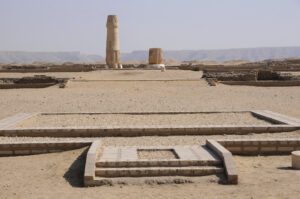
Amarna. Outdoors. Light.

Karnak. Indoors. Shadow.
Side note: The Grand Bazaar (Turkish: Kapalıçarşı, meaning ‘Covered Market’; also Büyük Çarşı, meaning ‘Grand Market’[1]) in Istanbul is one of the largest and oldest covered markets in the world, with sixtyfour covered streets and over 4,000 shops on a total area of 30,700 m2, attracting between 250,000 and 400,000 visitors daily. In 2014, it was listed No.1 among the world's most-visited tourist attractions with 91,250,000 annual visitors. The Grand Bazaar at Istanbul is often regarded as one of the first shopping malls of the world.. The Grand Bazaar is located inside the walled city of Istanbul, in the district of Fatih and in the neighbourhood (mahalle) bearing the same name (Kapalıçarşı). It stretches roughly from west to east between the mosques of Beyazit and of Nuruosmaniye. The Bazaar can easily be reached from Sultanahmet and Sirkeci by trams (Beyazıt-Kapalıçarşı stop).

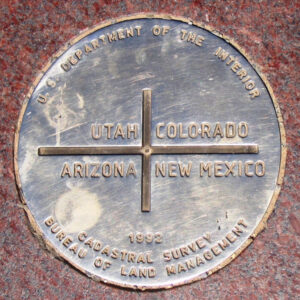 The construction of the future Grand Bazaar's core started during the winter of 1455/56, shortly after the Ottoman conquest of Constantinople and was part of a broader initiative to stimulate economic prosperity in Istanbul.[7] Sultan Mehmed II had an edifice erected devoted to the trading of textiles[1][8] and jewels near his palace in Constantinople.[9] It was named Cevâhir Bedestan ("Bedesten of Gems") and was also known as Bezzâzistan-ı Cedîd ("New Bedesten") in Ottoman Turkish. The word bedesten is adapted from the Persian word bezestan, derived from bez ("cloth"), and means "bazaar of the cloth sellers".[10] The building – named alternately in Turkish İç ("Internal"), Antik ("Ancient"), or Eski ("Old") Bedesten – lies on the slope of the third hill of Istanbul, between the ancient Fora of Constantine and of Theodosius. It was also near the first sultan's palace, the Old Palace (Eski Saray), which was also in construction in those same years, and not far from the Artopoleia (in Greek) (Ἀρτοπωλεῖα), the city's bakers' quarter in Byzantine times.[11]
The construction of the future Grand Bazaar's core started during the winter of 1455/56, shortly after the Ottoman conquest of Constantinople and was part of a broader initiative to stimulate economic prosperity in Istanbul.[7] Sultan Mehmed II had an edifice erected devoted to the trading of textiles[1][8] and jewels near his palace in Constantinople.[9] It was named Cevâhir Bedestan ("Bedesten of Gems") and was also known as Bezzâzistan-ı Cedîd ("New Bedesten") in Ottoman Turkish. The word bedesten is adapted from the Persian word bezestan, derived from bez ("cloth"), and means "bazaar of the cloth sellers".[10] The building – named alternately in Turkish İç ("Internal"), Antik ("Ancient"), or Eski ("Old") Bedesten – lies on the slope of the third hill of Istanbul, between the ancient Fora of Constantine and of Theodosius. It was also near the first sultan's palace, the Old Palace (Eski Saray), which was also in construction in those same years, and not far from the Artopoleia (in Greek) (Ἀρτοπωλεῖα), the city's bakers' quarter in Byzantine times.[11]
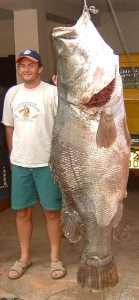
The water elephant.
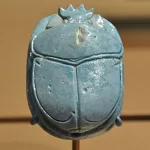
Hard shell. 'Triple' aspect? Amenhotep to enlarge.
Continued: ''The number of crocodiles and soft-shelled turtles, both dangerous aquatic reptiles, is unusually high at Hierakonpolis; moreover, the percentage of wild mammals (nearly 16% compared to only 1.2% at HK11) suggests this is one of the rare Predynastic sites where hunting was not just a minor economic activity. The species that were hunted are also exceptional. Animals such as hare and Dorcas gazelle are more numerous than at other sites, but also present are Barbary sheep, which have previously only been recorded from Adaima, and Dama gazelle, which have not been found at any other Predynastic site. Control over wild animals, as a symbol that chaos has been subdued, is a recurrent theme in Predynastic iconography.....Cattle were always dominant, but the relative importance of pig was low at Hierakonpolis (including HK29A) and other Upper Egyptian sites when compared to those in Lower Egypt, where the ecological conditions for pig keeping were more favourable. In Upper Egypt goats outnumber sheep, while the opposite is true for Lower Egypt, probably because goats are better adapted to harsher circumstances....
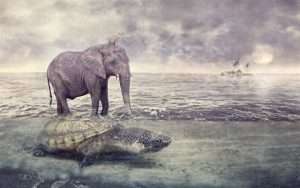
Heavy feet? Surfing on the 'back'?
 The unusual nature of the animal remains from HK29A is apparent from both the quality of the aquatic fauna and the quantity of wild mammals present. The fish fauna are exceptional because of the large size of the Nile perch, some of which were at least 1.5 m long. At other Predynastic sites, specimens of over 1 m in length occur only occasionally, whereas large specimens predominate at HK29A. It would thus appear that for the events happening at the temple, special efforts were made to capture large Nile perch, which can only be found in the deeper parts of the Nile.''
The unusual nature of the animal remains from HK29A is apparent from both the quality of the aquatic fauna and the quantity of wild mammals present. The fish fauna are exceptional because of the large size of the Nile perch, some of which were at least 1.5 m long. At other Predynastic sites, specimens of over 1 m in length occur only occasionally, whereas large specimens predominate at HK29A. It would thus appear that for the events happening at the temple, special efforts were made to capture large Nile perch, which can only be found in the deeper parts of the Nile.''
Working towards the pinnacle of something?
'Sheep decans' to enlarge.

Seated on what?
Side note: ''The Barbary sheep (Ammotragus lervia), also known as aoudad (pronounced [ˈɑʊdæd]) is a species of caprine native to rocky mountains in North Africa. While this is the only species in genus Ammotragus, six subspecies have been described. Although it is rare in its native North Africa, it has been introduced to North America, southern Europe, and elsewhere. It is also known in the Berber language as waddan or arwi, and in former French territories as the moufflon.''
Continued: ''Jugged is a cookery term associated with the hare.''
'Prison{er}' to enlarge.
'Slow boiled'?
Side note: ''According to family tradition the British Prime Minister - Winston Churchill - was one-sixteenth Iroquois.'' ['The Chase'].
American 'Mother'?
 ''Cricinfo defines a bunny as "Also known as rabbit, a member of the side who cannot bat and is chosen as a specialist bowler or wicketkeeper, and who almost always bats at number 11.''
''Cricinfo defines a bunny as "Also known as rabbit, a member of the side who cannot bat and is chosen as a specialist bowler or wicketkeeper, and who almost always bats at number 11.''
Eleven/twelve{2x12?}/thirteen....

Whats the common factor? A beginning or end?
A working example: ''On the night of June twentyfourth AD, 726 a Maya official named Ajpach' Waal reached the pinnacle of his career. He was granted an audience with the thirteenth king of Copan, known to scholars as eighteen Rabbit, but to his subjects as Waxaklajuun Ubaah K'awaiil...A six storey staircase led to a ritual platform at the city's center. 18 Rabbit was responsible for building the lower half, which he dedicated to his fathers honour...3 months later {September 14th 726AD} Ajpach himself built his own 'stairway'' - a 6 stepped one - ''made up of onehundred and sixtyfour hieroglyphic blocks, each measuring about a foot tall {cubit?}.'' ['Archaeology' / July/August 2021].
Eighteen + six = twentyfour.
Denderah to enlarge.
Solstice/Equinox?
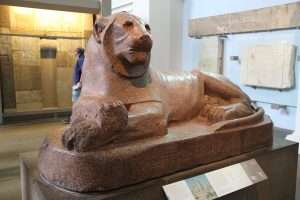
Gebel Barkal lions. At rest?

Reverse it. From a southern perspective = upside down 'cross'?
And/or: "We have just climbed the ancient steps to the ancient Temple Mount, now the Al Aqsa Mosque. These are the steps pilgrims took for centuries. We are going up to the Hulda Gates, or the double and triple gates that they call it today - so that we can reflect on this prayer of the Assembly {Psalms}. This is the door from the time of Jesus {now covered/blocked/walled up with stone work - as was an aspect of Ramses Temple}. When i first learned about this the Franciscan who told me about it said i could always picture Mary with Jesus in Her Arms coming here into the temple to present him to the Lord and RESTING for a moment to catch your breath on this doorpost. The Hulda Gates are a link to the Old Testament prophetess Hulda. That led up to the dwelling of the Lord. A link to the 150 Psalms. The oldest written around the time of Moses. The south corner of the temple called the trumpeting corner. " [Day six: Psalms. Prayer of the Assembly: Lent 2024. Magdala. Israel].
N.B. Each of the 3 Gates walled up with eleven courses of brick. A total of 'thirtythree'.
Other nuggets mentioned: "Trumpets blown on the sabbath" {i.e., day of REST}. + "Psalm fortyseven speaks about the coronation of God as king, the head of the year. Goes up with trumpet blasts."
Coming and going.
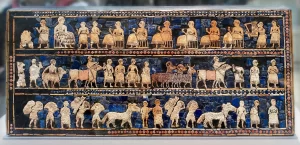
Elongated. ''Coming to a peak''?
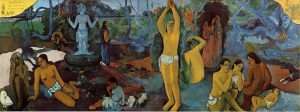
"Where-do-we-come-from. What-are-we. Where-are-we-going."
And/or: "Blow the trumpet at the new and full moon" {Psalm eightyone}. + "Psalm 150 with trumpets, harps and lyre." + "Psalm 121 - grouped within The Psalms of Ascent - coming from the spring of Siloam. The spring of Gishon {which became the pool of Siloam}, where they would walk in pilgrimage all the way up to the temple: 'I raised my eyes to the mountains from whence shall come my help. My help comes from the Lord, who made Heaven and Earth. He will guard my coming and going. I rejoiced...Our feet are standing here in the Gates of Jerusalem." {Day 6 / Lent / Magdala}.
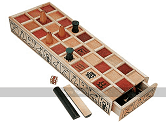
The 'middle' way.
A working example: "Although the conversation had floundered in my own ignorance, Mark quickly redirected it. From Steiner, he led the talk back, with little difficulty, to Theosophy, about which I knew a little, and then further back to the Hermetic "Brotherhood of Luxor,” about which (once again) I had to admit I knew nothing. It was clear that he was trying to find out from which direction I was coming, and where I was going, yet his questions were always kindly, and always articulately phrased." ['The Zelator'].
Side note: The pulpit is generally reserved for clergy. This is mandated in the regulations of the Catholic Church, and several others (though not always strictly observed). Even in Welsh Nonconformism, this was felt appropriate, and in some chapels a second pulpit was built opposite the main one for lay exhortations, testimonies and other speeches.[3] Many churches have a second, smaller stand called the lectern located in the Epistle side, which can be used by lay persons, and is often used for other Scripture lessons and ordinary announcements. The traditional Catholic location of the pulpit to the left side of the chancel or nave has been generally retained by Lutherans and many Anglicans,[4] while in Presbyterian and Baptist churches the pulpit is located in the centre behind the communion table.[5] Many modern Roman Catholic churches have an ambo that functions as both a pulpit and lectern."
'Standing'.
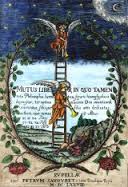
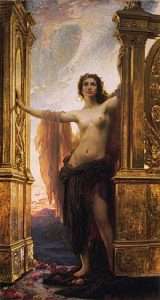
Goddess of Dawn. Gateway to the light. 'Buttress'?
"The Huldah Gates (Hebrew: שערי חולדה, Sha'arei Hulda) were one of the Gates of the Old City of Jerusalem leading into the Jerusalem Temple compound in the Hasmonean period and were named as such in the Mishnah.[1] The term is currently being used for the remains of two later sets of gates, the Triple Gate and the Double Gate, known together as the Huldah Gates,[2] built as part of the much extended Herodian Temple Mount, situated in Jerusalem's Old City.[3] Both sets of gates were set into the Southern Wall of the Temple compound and gave access to the Temple Mount esplanade by means of underground vaulted ramps.[3] Both were walled up in the Middle Ages. The western set is a double-arched gate (the Double Gate), and the eastern is a triple-arched gate (the Triple Gate).[3] There still are a few Herodian architectural elements visible outside and inside the gates, while most everything else of what we see today is later, Muslim-period work....
Side note: "The history of "esplanade" is completely on the level. The Italians created "spianata," for a level stretch of ground {balance?}, from their verb "spianare," which means "to make level." "Spianare" in turn comes from the Latin verb explanare, which also means "to make level" and which is the source of our verb "explain." Middle-French speakers borrowed "spianata" as "esplanade," and in the late 1500s we borrowed the French word. In the late 17th century, and even later, esplanades were associated with war....

Happy or Sad?
The word was used to refer to a clear space between a citadel and the nearest house of a town or to a slope around a fortification used for defence against attack. Today, however, esplanades are usually for enjoyment."
Pavilion / Collonade?
"An esplanade is a level open stretch of paved or grassy ground, often found near a river or large body of water. It is designed for walking or driving and provides a pleasant area for people to enjoy. Historically, esplanades were also used as clear fields of fire for fortress guns outside city walls. Nowadays, they are primarily used for leisure and enjoyment 1234. For example, you might find a tree-lined esplanade by a river, perfect for seaside strolling, or an esplanade where people gather to watch events like fireworks displays "

Man in the moon?
Continued: The name "Huldah gates" is taken from the description of the Temple Mount in the Mishnah (Tractate of Midot 1:3). Two possible etymologies are given for the name: "Huldah" means "mole" or "mouse" in Hebrew, and the tunnels leading up from these gates called to mind the holes or tunnels used by these animals. Alternatively, in a possible folk etymology, the First Temple prophetess Huldah[4][5] was said to have held court in this area and, indeed, her tomb[6] was placed here by some as well.
'Warrens'?
Dormouse/Shrew mouse?
Side note: ''The opposite is true for the December Solstice when summer begins in the Southern Hemisphere and winter starts in the North. The solstice (combining the Latin words sol for “Sun” and sistere for “To Stand Still”) is the point where the Sun appears to reach either its highest or lowest point in the sky for the year and thus ancient astronomers came to know the day as one where the Sun appeared to stand still.''
''Upright''?

Day or night?
 And/or: ''Equinoxes happen directly between the solstices and mark the beginning of the Spring and Fall seasons. The term equinox, like solstice, finds its origin in Latin with the roots aequus meaning “Equal” and nox meaning “Night.” Astronomers define the equinox as the moment the Earth’s Equator on its axis passes the same plane of the Sun’s equator, but its name reveals more of what we experience of these March and September dates here on Earth as most places on the planet on the day of the Equinox will experience roughly as much night time as day time, hence “Equal Night.” ['The Franklin Institute'].
And/or: ''Equinoxes happen directly between the solstices and mark the beginning of the Spring and Fall seasons. The term equinox, like solstice, finds its origin in Latin with the roots aequus meaning “Equal” and nox meaning “Night.” Astronomers define the equinox as the moment the Earth’s Equator on its axis passes the same plane of the Sun’s equator, but its name reveals more of what we experience of these March and September dates here on Earth as most places on the planet on the day of the Equinox will experience roughly as much night time as day time, hence “Equal Night.” ['The Franklin Institute'].

 Continued: Other clues to get into that universal mindset: The word 'Lakam' {bannerman/flag/stela} identified with Ajpach who travelled ''200 miles over rugged terrain'' {'foreign/stranger/NOBLE links} + identified with ''bags of goods'' and ''two vessels found with the remains of a man'' and ''two of the glyphs in the staircase depict ball players'' and ''teeth with jade and pyrite inlays'' AND ESPECIALLY ''the staircase prominently features the Lord of the mighty 'CITY' of Calakmul, whose kings were known as the Kaan, or Snake Dynasty.''
Continued: Other clues to get into that universal mindset: The word 'Lakam' {bannerman/flag/stela} identified with Ajpach who travelled ''200 miles over rugged terrain'' {'foreign/stranger/NOBLE links} + identified with ''bags of goods'' and ''two vessels found with the remains of a man'' and ''two of the glyphs in the staircase depict ball players'' and ''teeth with jade and pyrite inlays'' AND ESPECIALLY ''the staircase prominently features the Lord of the mighty 'CITY' of Calakmul, whose kings were known as the Kaan, or Snake Dynasty.''
''Nineteen Snake Kings''?
Question. Did Ajpach have a ''daughter''?
Side note: ''Pyrite is an iron sulfide mineral with a metallic luster. It has and a brassy coloring that is similar to gold, because of this resemblance it is also known by the name Fools Gold. It comes from the cubic crystal system and has an opaque transparency and a brittle texture. Pyrite's meaning is purity and unblocks creativity....The pyrite group of minerals is a set of cubic crystal system minerals with diploidal structure. Each metallic element is bonded to SIX "dumbbell" pairs of non-metallic elements and each "dumbbell" pair is bonded to six metal atoms.'' [Wiki].
''Six'' and ''eight'' as a means....?
And/or: ''The pigments yellow, brown and red ochre take their colour from the oxide of iron.'' ['The Chase'].
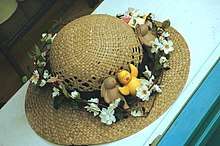
Easter bonnet. Rabbit out of the hat?
Continued: Something hinted at: "Quercetanus's daughter used in her process a 'powder of projection' - a material that was becoming a common rabbit in the alchemists hat, along with elixirs and philosophers stones. Supposedly a powder of projection {see Part 1} was a 'material' capable of 'transmuting' a metal into silver and gold..." ['The Chemistry of Alchemy'].
Analogy: ''As mentioned earlier, the king is gods intellect, represented by the three highest sefiroth, Kether, Chokhmah, and Binah. The feminine concept, through which we can recieve and grasp god's intellect, is Malkhuth, and hence it is referred to as 'The King's Daughter'. The 'kings daughter' is thus seen as our ability to understand, the mysteries of the Torah.'' [From the chapter and book 'The Lost Princess and Other Kabbalistic Tales' / A. Kaplan and C. Kramer].
And/or: ''The adjoining block, with its text facing in the opposite direction, names the 'Kings Daughter of his Body, his Beloved. Praised by the Lord of the Two Lands'....'' ['Nefertiti' / A. Dodson].
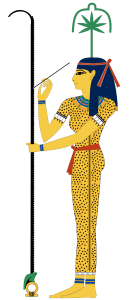
Spots and Stripes?
Spirit into Soul?
Meritaten?
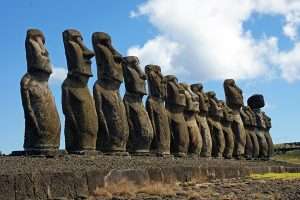
Inward or outward?
The seventh force, known as Malkhuth (Kingship), is seen as being feminine. Like the womb of the female, it is seen as the power to receive and hold (and eventually give back something more perfect). It is thus the Sabbath which gives us the power to hold on to the original forces of creation and integrate them into our lives. It is also the center point, where instead of looking outward, we look inward, and integrate holiness into ourselves. {'The Lost Princess'}.
Easter Island.
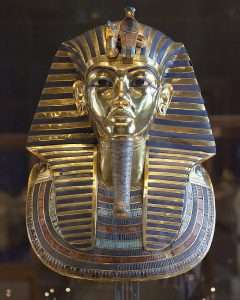 A work in progress: ''Three of the Amarna letters - a collection of hundreds of cuneiform tablets discovered in Akhenaten's capital city of Akhetaten in the late 19th century - mention Meritaten using the name Mayati. In two of these letters, she is said to have quasi-royal status. After Nefertiti's death, however, Meritaten appears without her previous title of royal daughter, but as 'first lady' and later with a nearly royal rank....At least one artefact from Tutankhamun's tomb which belonged to the 'queen pharaoh', has two cartouches side by side, one with her coronation name, Ankhkheperure, and the other her birth name, Meritaten.'' [Page 35 'Archaeology' / September-October 2022].
A work in progress: ''Three of the Amarna letters - a collection of hundreds of cuneiform tablets discovered in Akhenaten's capital city of Akhetaten in the late 19th century - mention Meritaten using the name Mayati. In two of these letters, she is said to have quasi-royal status. After Nefertiti's death, however, Meritaten appears without her previous title of royal daughter, but as 'first lady' and later with a nearly royal rank....At least one artefact from Tutankhamun's tomb which belonged to the 'queen pharaoh', has two cartouches side by side, one with her coronation name, Ankhkheperure, and the other her birth name, Meritaten.'' [Page 35 'Archaeology' / September-October 2022].
A working {contemporary} example: ''I am only sure of the impact that my father's history had on me, his first born daughter, the first granddaughter of Jacob. At times this family story seems deeper than i will ever be able to plumb. But even in my limited uncovering, i feel a resonance.'' [Page xiv 'Daughters of Saturn' / Patrica Reis].

 And/or: ''I had a dream while visiting my parents in the house my father built....I am sleepling in my old room in my childhood bed, and i dream that i am in this room, although i am now 44....I hear a great swelling sound of music which i identify as the 'music of the spheres'.... I find the sourse of this music through a second storey window looking onto the garden below....I see my father with flowing white hair and long white beard....sitting on farm equipment...looks like a thresher...playing it like a harp. What transpired BETWEEN the actual and real event is a long and painful daughter-father story - one filled with love and passion, rage and revenge, oppression, seperation, liberation, and much later, a sense of peace and reconcilation.'' [Page xvi 'Daughters of Saturn: From Fathers Daughter to Creative Woman' / P. Reis].
And/or: ''I had a dream while visiting my parents in the house my father built....I am sleepling in my old room in my childhood bed, and i dream that i am in this room, although i am now 44....I hear a great swelling sound of music which i identify as the 'music of the spheres'.... I find the sourse of this music through a second storey window looking onto the garden below....I see my father with flowing white hair and long white beard....sitting on farm equipment...looks like a thresher...playing it like a harp. What transpired BETWEEN the actual and real event is a long and painful daughter-father story - one filled with love and passion, rage and revenge, oppression, seperation, liberation, and much later, a sense of peace and reconcilation.'' [Page xvi 'Daughters of Saturn: From Fathers Daughter to Creative Woman' / P. Reis].
''Music of the Spheres'' in relation to:
" The Jabirian Islamic authors, assimilated ideas from east and west, proposed a 'material', an elixir, might be found that could cure the 'sick' metals {i.e.,lead, tin ,iron} and make them well {i.e., by way of silver and gold} - but they did not say they had it, just that it would be nice if they had." [Same book i.e., 'The Chemistry of Alchemy'].
Question. What planets represent them?
To get a full explanation try the chapter 'The Salamander of Lisieux' within the book 'The Dwellings of the Philosophers' / Fulcanelli].
Animal/plant as well as 'mineral' {by way of 'mercury' / 'sulphur' and 'salt'} - as a means....?
Side note: Gunpowder discovered by the Chinese {accidently} - while looking to ''turn base metals into gold.'' ['Flog It' / 8.1.20].
A {working?} example: "Artemis, the mother-goddess of the temple, eventually became identified with the Roman goddess Diana, though their mythologies differed: Artemis was a goddess of fertility, whereas Diana was the virgin moon goddess of the hunt. Yet in the biblical story, and in the minds of the alchemist, the identities merged, and ''Diana'' became a symbol for silver..." [Same book].
 Side note: {a working example}: Diane goes on the hunt for a 'treasure'. Gets to the final destination. As cool as they come. Not normally a gambler - but she gambles her small 'pot' for a hopefully bigger one. Must be a relation to 'Cool Hand Luke': 'Don't worry about it,' she says to Ben as the 'treasure' is almost got.'' ['Tipping Point' /ITV / 9.11.20].
Side note: {a working example}: Diane goes on the hunt for a 'treasure'. Gets to the final destination. As cool as they come. Not normally a gambler - but she gambles her small 'pot' for a hopefully bigger one. Must be a relation to 'Cool Hand Luke': 'Don't worry about it,' she says to Ben as the 'treasure' is almost got.'' ['Tipping Point' /ITV / 9.11.20].
Continued: 'Sun' and 'Moon'. Recall what they represent. Question. Why should the 'angel' Gabriel be linked to the 'moon'; and Michael to the 'sun'? What does it represent? Clue. Something of the 'higher' rather than the 'lower' - BUT both are equal, i.e.,you can't have one without the other; like opposite ends on the same pole? and/or - the tail end of something begins the process of something else?
Those eureka moments being a bridge between the two. The author of 'Cities of Dreams' giving information on only one of those aspects - all the way back to Neanderthal man, i.e., "So there we have the much vaunted religion of the sun, on the widely separated continents. In each case that religion is clearly little more than an outgrowth and an overgrowth of the much older, and still powerful, original moon worship." [Chapter 10 of same book]. You cannot have one without the other - for that understanding to take place. That ''understanding'' this 'subject' defines - of which Neanderthal man - was well aware of - or becoming aware of. i.e.,...
"Haematite, a Greek word meaning bloodstone, the official name for red ochre or red oxide of iron, is chemically Fe2 O3. This chemical substance is frequently produced by the weathering of magnetite, Fe3 O4. That is to say, when magnetite is exposed to the atmosphere at the earths surface, it turns into haematite. Digging down through the haematite one comes upon magnetite, and it is clear that the one substance turns into the other. In this excavating of red ochre Neanderthal man could not have failed to notice this phenomenon. As it happens, however, magnetite is highly magnetic. It is what is called in historical times the Lodestone [i.e., the 'leading stone']. If a small sliver of magnetite is floated on the surface tension of water, the sliver swings round until it points to magnetic north. Might it not well be that Neanderthal, accidentally or otherwise, discovered this 'magical' property of magnetite?'' [Charter 2, same book].
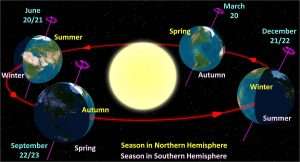
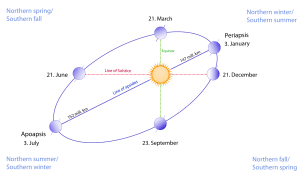 Understanding ''stones'' ''north'' ''incarnation'' amongst others, tells the reader what Neanderthal man was attempting to define about himself. His inner self. Using the moon and what he understood about it, as only one aspect within that learning process. That would define himself within the bigger picture. The Micro within the Macro. Summary enlarged elsewhere.
Understanding ''stones'' ''north'' ''incarnation'' amongst others, tells the reader what Neanderthal man was attempting to define about himself. His inner self. Using the moon and what he understood about it, as only one aspect within that learning process. That would define himself within the bigger picture. The Micro within the Macro. Summary enlarged elsewhere.
As one example: "Such an analysis serves also to check up and interpret mathematically the general findings of psychology concerning the progressive development of the human psyche and of its functions or modes of activity. It also verifies the ancient 'occult' idea of the division of human life into 7-year cycles, each of which marks the unfolding of one particular aspect of the individual's character and means of self expression. The first seven years see the development of the power of self awareness, or intuition - as understood by C. Jung. The young child sees everything in terms of personality. It is hard for him to differentiate between subjective and objective, inanimate and animate, because he lives so completely in a subjective world." [Page 190 'The Astrology of Personality' / Dane Rudhyar].
Cro-magnon versus Neanderthal man?
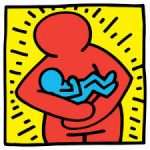 Continued: "He has an ''intuition'' of things rather than objective perceptions. He has not yet succumbed to the ''heresy of separateness'' which creates a chasm {'void'?} between subject and object {or other subjects}, between I and Thou. Thus the mystic, who strives to reach complete at-one-ment with the ALL {that ''bit''?} - is urged to become again ''as a little child'' - a stage which is related theoretically to the period after the third birth, between 56 and 63. This first septenate corresponds also to the infancy of mankind...." [Same page. Same book].
Continued: "He has an ''intuition'' of things rather than objective perceptions. He has not yet succumbed to the ''heresy of separateness'' which creates a chasm {'void'?} between subject and object {or other subjects}, between I and Thou. Thus the mystic, who strives to reach complete at-one-ment with the ALL {that ''bit''?} - is urged to become again ''as a little child'' - a stage which is related theoretically to the period after the third birth, between 56 and 63. This first septenate corresponds also to the infancy of mankind...." [Same page. Same book].
''I and Thou'' in relation to 'higher/lower''?
Side note: The angles within the Bent Pyramid - from a greater to a lessor 'degree' of something - Do they correspond to the square or the circle {''squaring the circle''?}.
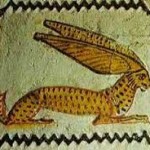
Find it to understand it.
Another 'key'..."The reading of the literature of the hare also brings up another question: why is it that the hare figures in so many divergent cultures in particular myths......an examination of those relating to the hare might well be worth while, if only for the light they might throw on the origin and structure of those myths that are linked with other animals. But before starting on our inquiry we are putting forward the hypothesis that there is much more involved than this. The hare is an archetype: that is, as the name implies, one of the original nuclei or formation-patterns of awareness that primitive man used as a tool of communication to come to terms with his environment and also with the internal environment of his instincts and feelings". [Chapter one 'The Leaping Hare' by G. Evans and D. Thompson]. Together with...
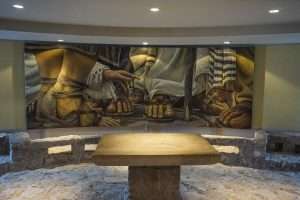
Feet touching the ground? Sandels? Left one in motion. {Static or dynamic]
"So the mighty reputation of mistletoe is then purely 'magical'. In support of that view, it had to be cut at certain times of the moon's cycle, with a sickle made of gold, and had to be caught in a white cloth so that it should not touch the ground, ['virgin' link. This readers input]. I am personally sure that the sickle must represent the crescent moon - and if it was made of gold rather than silver, that is perhaps because silver tarnishes so readily. Common mistletoe is an evergreen. Evergreens as a whole were favoured by the goddess, [also a link to 'Green Language'. This readers input], since they continue to grow among the other dead plants of winter, when the sun is also absent. The plant has a further remarkable property. If a spray of it is kept for several months, the 'whole' turns a golden colour. J. G. Frazer is convinced that here is the mystical 'Golden Bough' of classical legend...
Side note: "...known to absorb {the mistletoe} the spiritual quintessence of its host tree." As a means.…? Enlarged elsewhere.
''Well done you boys in green.'' ['Finding Jack Charlton' / BBC 2}.

Three in one?
A working example: ''The secret is hidden not in the top but in the roots of the tree....The roots extend into the inorganic realm, into the mineral kingdom {'quartz'?}. In psychological terms, this would mean that the self has its roots in the body, indeed in the bodys chemical elements...The secret hidden in the roots is like a secret sealed inside a bottle {'glass'?}...this spirit is like the numen of the tree, its 'spiritus vegetativus', which is one of the definitions of Mercurius. As the 'life' principle of the tree it is a sort of spiritual quintessence abstracted from it and could also be described as the 'principium Individuationis'. The tree would then be the outward and visible sign of the realization of the self....The tree comparison occurs as early as Eulogius of Alexandria {600AD} who says: ''Behold in the Father the root, in the Son the branch {'yellow'?}, and in the Spirit the fruit {'red'?}; for the substance in the THREE IS ONE.'' [Page 195/6 'Alchemical Studies'].
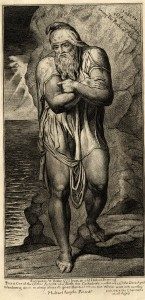
Right foot anchored. {static?}.
And/or: Sack is an antiquated wine term referring to white fortified wine imported from mainland Spain or the Canary Islands.
The Collins English Dictionary, the Chambers Dictionary, and the Oxford English Dictionary all derive the word "sack" from the French sec, meaning "dry". However, the OED cannot explain the change in the vowel, and it has been suggested by others that the term is actually from the Spanish word sacar, meaning "to draw out", as in drawing out wine from a solera, which led to sacas. The word "sack" is not attested before 1530.
Julian Jeffs writes: "The word sack (there are several spellings) probably originated at the end of the fifteenth century, and is almost certainly derived from the Spanish verb sacar ("to draw out"). In the minutes of the Jerez town council for 1435, exports of wine were referred to as sacas."[Wiki].
Try ''Mistletoe'' for a take on the same THEME.
''Its favourite host trees include apple, hawthorne and poplar trees. It prefers to grow on trees in open areas with plenty of light, rather than in dense woodlands. Keep a look out for mistletoe in parks, gardens and orchards....Despite its romantic reputation {'kissing under the tree at Xmas'}, mistletoe is actually poisonous to humans. It contains a toxic substance called phoratoxin, which is particularly concentrated in the leaves....''
What would the 'remedy' be? Wisdom?
Continued: ...Common mistletoe grows very rarely on the oak tree. But it was the oak mistletoe which was most prized. And it was the oak tree which was the most revered tree of all - not just by the Druids - they who knew the oak - but throughout the whole of Europe. Why should the oak be special? Because it is the tree which is most frequently struck by lightening."[Chapter 13 'Cities of Dreams'. Mentioned elsewhere].
Side note: ''The Royal Oak pub in Winchester claims to be the oldest in the land.'' ['Birtain's Most Historic Towns: Winchester'].
''The Oaks being one of the English classic horse races is restricted to fillies.'' ['The Chase'].
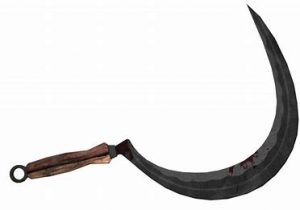
Crescent shape? Semi-circle?
 And/or: "The ONE ritual which has come down to us performed by the Druids - was the cutting of the mistletoe when it was found growing on the Oak....The pearl was always a symbol of the moon in the Celtic west; the moon being the pearl of 'heaven'....The Oak was the tree of the Celtic Jupiter, who was the 'sun' god....Celtic statues have been found showing him with both the solar 'wheel' and the thunderbolt....When therefore the 'moons' living pearl was found on the 'suns' sacred tree, it was 'evidence' that the 'sacred marriage' had taken place...." [Page 118 'GogMagog'].
And/or: "The ONE ritual which has come down to us performed by the Druids - was the cutting of the mistletoe when it was found growing on the Oak....The pearl was always a symbol of the moon in the Celtic west; the moon being the pearl of 'heaven'....The Oak was the tree of the Celtic Jupiter, who was the 'sun' god....Celtic statues have been found showing him with both the solar 'wheel' and the thunderbolt....When therefore the 'moons' living pearl was found on the 'suns' sacred tree, it was 'evidence' that the 'sacred marriage' had taken place...." [Page 118 'GogMagog'].
Try ''pearl'' to enlarge i.e., Scallop shell / Venus etc. Oak Island?
Chokhmah {Chokmah} and Binah?
| Zodiac Sign | Archdemon Name | Meaning of Name |
|---|---|---|
| Cancer | Phahkaiel | "Flask of God" |
| Leo | Serattiel | "Cutting of God" |
| Virgo | Sehaliel | "Profit of God" |
| Libra | Hadakiel | "Thorn of God"
|
"Flask" = scroll?
Side note: "If one were briefly to characterize the transforming energy of life in Aries, one could say that it strikes from above, like lightening...One can say of Aries that it represents the awakening of conscious activity - from 'unconscious' sleep...Thus in Aries, the transformation energy comes from outside the organism - whereas {as an example} in Leo it has its source inside...Because he stands at the beginning of cycles of manifestation, he has a longing for the fulfilment of the end of cycles...Aries represents the 'upper' pole; Capricorn, the 'lower' one. [Page 18-22 'Zodiac as the Universal Matrix'].

The eye of a Horus child?
A working example {synchronistic?}: ''I found the Australopithecus fossil beneath this tree. Its the only tree in the area to have been struck by lightening. Thats how we remembered where we had found the fossil. Its a remarkable tree.'' [Matthew Berger: 'The Two Million Yearold Boy' / Nat. Geo].
''Theres a lot more to be discovered on planet earth. You have to see the world with childrens eyes. Thats how great discoveries are made. You have stepped off the path.'' [ Lee Berger].
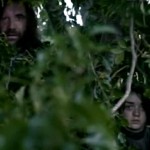 Think about it relative to - inspiration - by way of a 'lightening strike'. Evergreen / mistletoe / golden sickle / indicative of something becoming known [hence the link to the 'moon' - what it represents. What it represents that is to a subject - as a whole - not just a woman's menstrual cycle in relation to a single hypothesis]. The golden sickle represents that boundary line between dark and light ['silver / gold' and/or 'moon / sun']. In other words from something unknown to becoming known. Representing the use of a 'tool' to imply that potential; that end result; that transition of a ''boundary'' line. That final known quantity represented as a 'process' in the making. Using plant and animal symbolism. Plant symbolism used as a precursor to that final one. That intuitive one - by way of - an intuitive leap.
Think about it relative to - inspiration - by way of a 'lightening strike'. Evergreen / mistletoe / golden sickle / indicative of something becoming known [hence the link to the 'moon' - what it represents. What it represents that is to a subject - as a whole - not just a woman's menstrual cycle in relation to a single hypothesis]. The golden sickle represents that boundary line between dark and light ['silver / gold' and/or 'moon / sun']. In other words from something unknown to becoming known. Representing the use of a 'tool' to imply that potential; that end result; that transition of a ''boundary'' line. That final known quantity represented as a 'process' in the making. Using plant and animal symbolism. Plant symbolism used as a precursor to that final one. That intuitive one - by way of - an intuitive leap.
"It was also said [i.e.,mistletoe] can open all locks''[ Same chapter]. Anything?

 N.B. Tiphareth {Hebrew} = Oak = Stout heart?
N.B. Tiphareth {Hebrew} = Oak = Stout heart?
Side note: ''Well done you boys in green.'' ['Finding Jack Charlton' / BBC 2}.
Question. Francis Bacon quote in relation to the purpose of Oak Island. Enlarged elsewhere. If indeed there is a universal 'connectedness' between all cultures by way of those - keys/signs/correspondences/ archetypes etc.,- how would that relate to those Oak timbers that were found below that solitary tree {Oak?}.
Question. Any mistletoe on it?
Side note: How would an Eclipse {both Lunar and Solar} fit into the greater scheme of things? And/or Supernova in relation to iron/silver/gold {i.e., iron {lower?} silver/gold {higher?}.

Found at Gobekli tepe. Copy cats?
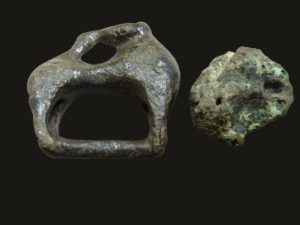
Horse biting its own tail buckle. Found at Tvaakar in Sweden {i.e., in the north}.
"The last of the two 'children' of Nut and Geb, Auset and her 'consort' [Asar] enjoyed the longest and most revered treatment in Egyptian religion. As the fourth born, the number four is especially associated with her, and was regarded by the Egyptians to be a fortunate day, number and configuration. In the Pythagorean symbolism derived from the Sacred science, the number four represents physical manifestation and established existence, an appropriate value assigned to the Neter ['god'] who brings forth to fruition and gives 'birth.' The Osirian mythos praises her maternity of the child Heru [Horus], the particulars of which share a strong resemblance to the later Christian accounts of the birth of the savior. In this role the Neter fulfills the ''Principle of Fruition.'' The 'thet' symbol was specific to Auset; it is often referred to as the ''buckle'' or ''girdle'' of the Neter. It is said to represent her 'womb', which brings forth all earthly life. In amulet form it was worn to grant an individual access to the ''secret places in the Duat''. [Same chapter, same book].
The 'horn' of plenty?
'The Forge and the Crucible' by Eliade.
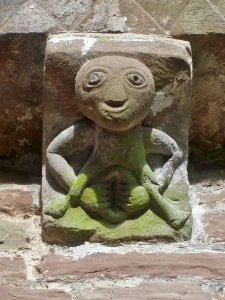
Sheela-na-gigs (above) adorn many twelfth and thirteenth-century Romanesque churches, mainly in Ireland. They typically portray older women with lined, almond-shaped eyes and an incorrigible grin. But her most distinguishable trait is always her pose — squatting, her hands pulling apart her labia to expose her gaping vagina.
What a stone-cold hussy.
The meaning of the Sheela-na-gigs is still hotly debated. One theory is she is a pagan touchstone to protect mothers giving birth. Supposedly, women would touch the screaming vulva to make the baby come out.
Side note: Twatt is a settlement in the parish of Birsay on the Mainland of Orkney, Scotland.
The settlement name originates from the Old Norse þveit, meaning 'small parcel of land'.[citation needed] The Norse word commonly produces in England the place name element Thwaite.[6][7]
The name Twatt is similar to the common English expletive "Twat," (a vulgar word for vulva and also an insulting term meaning a weak or contemptible individual). For this reason, Twatt remains a source of amusement to people from outside the parish. Its name featured at no. 4 of the most vulgar sounding names in Rude Britain, along with its Shetland namesake.
'Hard NUT to crack'.
Continued: Recall the ''girdle'' stones that enclose those three 'plugs' in the ascending passage. Recall the relationship of horizontal / vertical within those two 'monuments'. That same 'form' that the 'savior' was laid on to, prior to a 'resurrection'.
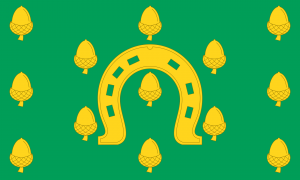
'Rutland: 'Three and four.''
"Western exegetes have not understood that in the New Testament chapter of Revelation contains the symbolic exposition of a yogic science, taught to John and other close disciples by Jesus. John mentions {Rev. 1:20} the ''mystery of the seven stars'' and the ''seven churches''; these symbols refer to the seven lotuses of light, described in Yoga treatises as the seven ''trap doors'' ..."
'The Lotus Eaters' [ 'Odyssey' / Homer].
Question. How many ''trap'' doors within that pyramid? Therefore true/untrue? Question 2. Nothing more than a Yogic exercise? Try ''hinge''.
Define {'see'} the above to get an idea {''hang on''?} - the following: The Cerrigydrudion Crown. A Celtic piece of ancient artwork. Bronze {'red'?} and leather {'cow'?] headpiece. ''Possibly signifies 'warrior' headgear - with palm leaf and lotus designs - neither of which are common to these islands {UK}.'' ['Inside Museums: St. Fagan/Cardiff. Sat.TV].
A working example: Recall Odysseus journey back to his homeland. Lotus island being its 'first stage'.
'Spirit/Soul' - as a means....?
Question. What would ''hang on'' be represented with - if anything?

YHVH in a different form. See anything?
Or Chapter four of the book 'The Sirius Mystery', ["the sacred fifty']. 'Number' symbolism in relation to the 'lower' half, i.e., the 'dog' constellations. That link to Gilgamesh, Marduk and Herod, in the 'negative' sense. I.e.,"Fifty anonymous companions, seemingly important only as a numerological element in the story, and in later times discarded as useless", [in relation to Gilgamesh. Chapter four. 'The Sirius Mystery'].
Side note: Odysseus also had a dog. His most 'loyal' one.
Continued: While recalling that Gilgamesh was known as the 'feller of the Cedars', [that same 'wood' that became the inner core/sanctum of amongst other things...'Solomons' temple]. Question. Difference between 'builder' and 'feller'?... and the story ends with the 'Hero' losing the 'plant of eternal life', chiefly because he 'slept', [in some stories ...a 'snake' stole it].
Spirit or Soul? As a means....?
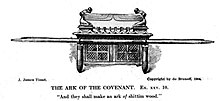
From a different perspective: Made of Shittim wood i.e., 'thorny' tree that GROWS in a 'desolate place' and gives plenty of 'cool' shade. 'Food for thought' = ''Manna''? Try ''Sunshades'' to see it from a different perspective.
A work in progress: Zahi Hawass goes looking to find the tomb of Nefertii - along the west branch in the Valley of Kings - Among other items, he finds a silver ring {'13' loops}, together with two wooden poles inscribed: 'Lord of the Two Lands. ['Valley of the Kings: The Lost Tombs' / 2021].
Juniper/Cedar? i.e., of the conifer/'pine' family.
And/or: When Tutamkhamun reopened Karnac to the god Amun - it was celebrated with ''thirteen carrying bars {poles} instead of eleven which was the norm support for the august god.'' ['Legends of the Pharaohs: Tutankhamun'].
''No building projects took place under his reign at Karnac, just a stela, at the entrance, with an inscription of the above details.''
So the question is: what does 'thirteen' represent?

Inner/outer. A beginning or end?
Male or female aspect?
Airborne?
Question. Any serpentine forms at Karnac?
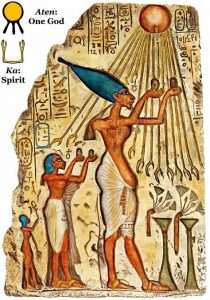 And/or: No building structure found where his temple {mortuary?} should have been. What was found instead was a 'new city' - within which was found inscribed on MUD BRICK a dedication or cartouche - to the ''Dazzling Aten''. A serpentine shape surrounded/encompassed it. Artisan's {'Blacksmith'} creating works with gold/silver and gems.
And/or: No building structure found where his temple {mortuary?} should have been. What was found instead was a 'new city' - within which was found inscribed on MUD BRICK a dedication or cartouche - to the ''Dazzling Aten''. A serpentine shape surrounded/encompassed it. Artisan's {'Blacksmith'} creating works with gold/silver and gems.
"Gold earrings and studs could be decorated with polychrome stone or glass inlay, gold granulation and amuletic symbols, A mid-Eighteenth Dynasty fashion epitomised by the elaborate earrings found in Tutankhamun's tomb. Decoration often included solar imagery, such as rosettes, falcons, and uraei, while the dangling beaded strings might seem to represent the suns rays, as in the hieroglyph for 'shine' or the symbol of the Aten. On Tutankhamun's gilded shrine, Queen Ankhesenamun wears this style of earring, which was favoured by the royal ladies of Amarna." ['Ancient Egypt' / Jan-Feb 2025].
''The Imperial State Crown contains four pearls that are said to have been used as earrings by Elizabeth I.'' ['The Chase' / 2018].
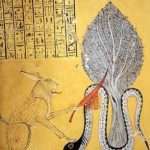
Long or short ears? ''Cheek by jowl.''?
From a different perspective {but 'golden' nuggets to be found}: ''According to the text, the figure following behind the sacrificer is named the ''Meridian of the Sun,'' and his head is to be cut off. This striking off of the golden head is also found in the manuscripts of Splendor Solis as well as in the Rorschach printing of 1598. The 'sacrifice' in the vision is of an initiate who has undergone the experience of solificatio. In alchemy, sun is synonymous with gold. Gold, as Michael Maier says, is the ''circulatory work of the sun,'' ''shining CLAY MOULDED into the most beauteous sustance, wherein the solar rays are gathered together and shine forth.'' [Page 72 'Alchemical Studies'].
Side note: Also found in the ''new city'' a solitary fish. Never before found in Egypt according to Zahi Hawass. In its mouth was a single golden nugget.
Salmon?
Upstream or downstream?
Refresher: ''The Inca's referred to gold as the 'sweat of the sun'...'' ['Pawn Stars' / 2020].

Sweat of the brow?
''In science Archimedes is said to have cried out ''i have found it'' after determining the means of finding the purity for GOLD.''
"Eureka" comes from the Ancient Greek word εὕρηκα heúrēka, meaning "I have found (it)", which is the first person singular perfect indicative active of the verb εὑρίσκω heurískō "I find".[1] It is closely related to heuristic, which refers to experience-based techniques for problem-solving, learning, and discovery.''
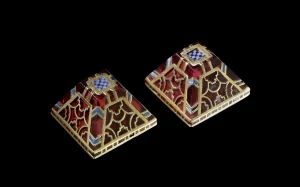
Millefiori art form from Sutton Hoo: Truncated top of 'pyramids'. Blue and black. 'Horizon' to enlarge {i.e., next level up}. Side note: The flooring {'foundation'} of {say} the Freemasons lodges = White/black squared tiling. One's a beginning. Which and why?
A working example: ''The purse-lid was the top of a leather pouch for coins.[2] The leather has decayed but forty Frankish coins and two small ingots were found with the lid.
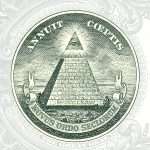
'Back' of the dollar bill. Glass eye?
Each coin was from a different mint, indicating a deliberately selected collection.[3] The purse hung from the waist belt by the three hinges seen on top of it. The parts of the lid in other non-jewellery materials had decayed, but it probably had a plate behind the metalwork made of valuable whalebone "ivory"; the lid is now displayed with a plain replacement plate, although the original may well have had decorative carving.''
Side note: ''The term millefiori is a combination of the Italian words "mille" (thousand) and "fiori" (flowers). Apsley Pellatt in his book Curiosities of Glass Making was the first to use the term "millefiori", which appeared in the Oxford English Dictionary in 1849; prior to that, the beads were called mosaic beads.''

'Glass'?
"Sheet of glass" to enlarge.
And/or: ''A UK metal detectorist has unearthed a rare 1,400-year-old Anglo-Saxon sword harness pyramid crafted in gold and garnet from India or Sri Lanka.

'Spirit' or 'Soul'?
This tiny, bejeweled treasure was discovered in April in Breckland, Norfolk, east England, by amateur archaeologist and metal detectorist Jamie Harcourt. The rare artifact dates to 560-630 AD and was used to hold a warrior’s sword in its scabbard while riding. It is thought to have been lost by a wealthy-warrior serving an Anglo-Saxon king at a time when the modern English county of Norfolk was part of the Kingdom of East Anglia.
“Sword harness pyramids” usually come in pairs and they pinned down two leather clasps that stopped swords jumping out of their scabbards when on horseback. However, the exact way in which the pyramids were attached to the swords and scabbards is not clear because the leather usually rots away.''

The 'minds eye' from a different perspective. Can u 'see' it?
Continued: ''The lid formed part of an ensemble of richly decorated fittings to the clothing and weapon worn by the body that were probably made as a set. These consist of a gold belt buckle, and gold and garnet shoulder-clasps, sword harness and scabbard mounts.
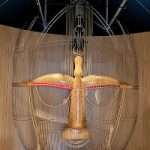
Sweat of the brow.
In particular the purse used a combination of small and large pieces of garnet in a way comparable to the shoulder-clasps.[4] The burial can be seen as a dramatic expression of the aspirations of East Anglian royalty, within which the ensemble of regalia is a careful construct; it situates the owner in a dual inheritance of coin-distributing, sceptre-wielding late Roman consuls, and Germanic warrior culture, with its rich iconography of powerful animals, gods and victors.
The lid consists of a kidney-shaped cellwork frame enclosing a sheet of horn, on which were mounted pairs of exquisite garnet cellwork plaques depicting birds, wolves devouring men, geometric motifs and a double panel showing animals with interlaced extremities. The maker derived these images from the ornament of the Swedish-style helmets and shield-mounts also in the burial. In his work they are transferred into the cellwork medium with dazzling technical and artistic virtuosity.
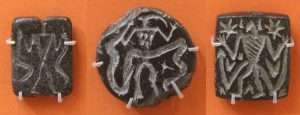
'triangles'?

Sutton Hoo purse clasp: Wolfs / eagles and ducks.
On the outside of the lid there are symmetrical images of a man surrounded by two wolves, a version of the ancient Master of Animals motif. In between these images are two more symmetrical figures, this time depicting an eagle swooping down upon its prey. To the ancient Anglo-Saxons, these images probably held great significance, but to modern historians it is difficult to be sure of the symbolism in these figures. It is possible that the heraldic composition of the men and the wolves alludes to the family name of the Sutton Hoo ship burial – the Wuffingas, or Wolf's People. They could also, along with the eagle, exhibit power, heroism, and courage.[4] Above the animal and human figures the artists inlaid abstract designs.''
Put those 'nuggets of gold' together to attempt a universal mind set.
Join the dots......

Sweat of the brow?
Continued: The flag of Lebanon is formed of two horizontal red stripes enveloping a horizontal white stripe. The white stripe is to be two times a red one (ratio 1:2:1)—a Spanish
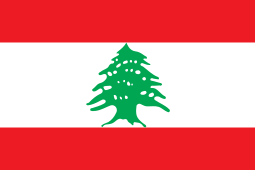 "The cedar of Lebanon is mentioned seventyseven times in the bible, especially in the book Psalms chapter 92 verse 12 where it says that : 'The righteous shall flourish like the palm tree.
"The cedar of Lebanon is mentioned seventyseven times in the bible, especially in the book Psalms chapter 92 verse 12 where it says that : 'The righteous shall flourish like the palm tree.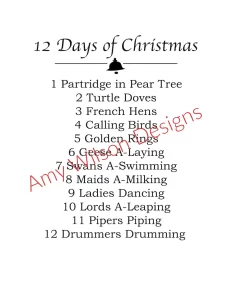
Ones ''true love'' = ''Beloved''?
Continued: That link between 'coiled' and 'uncoiled'. Recall what both represent. End result... two steps forward and two back, and/or back to 'square' one? Hence..."discarded as useless?
 That final link to a 'fallen' state, but still with the potential of making that about u-turn, i.e.,that divine spark is always there regardless of a negative [or dark] constant ''state of affairs.'' That potential is still dormant. Still lies concealed, untill a ''new awareness dawns.'' By way of - that individual effort. Represented by a ''u-turn.''
That final link to a 'fallen' state, but still with the potential of making that about u-turn, i.e.,that divine spark is always there regardless of a negative [or dark] constant ''state of affairs.'' That potential is still dormant. Still lies concealed, untill a ''new awareness dawns.'' By way of - that individual effort. Represented by a ''u-turn.'' Morning'?...Is there some clue here as to the mystery of how light can emerge from darkness?...An earlier tradition of Lucifer's 'fall from grace' is more subtle in its implications and may be nearer to its approximation to the truth. Lucifer, one of the seven angels around the 'throne of the creator' of the solar universe... " [From the chapter 'Light out of Darkness' within the book by Wellesley Tudor Pole. Emphasis, this readers].
Morning'?...Is there some clue here as to the mystery of how light can emerge from darkness?...An earlier tradition of Lucifer's 'fall from grace' is more subtle in its implications and may be nearer to its approximation to the truth. Lucifer, one of the seven angels around the 'throne of the creator' of the solar universe... " [From the chapter 'Light out of Darkness' within the book by Wellesley Tudor Pole. Emphasis, this readers].
Does ''photon'' know the answer?
A working example?..."It was generally understood, as many of our group commented, that this dark side energy was among us for a reason. It was very much a part of the problem we sought to help heal in the world, and we knew we had to deal with it in a good way - with love, compassion, and even gratitude, especially toward the member of our group who 'had agreed', at some 'higher' level of her being, to play such a difficult role {'fall' link?}. We had to plan." ['Serpent of Light Beyond 2012'].
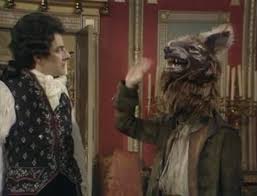 SIDE NOTE: Simplified {in the present sense of the word}: "What we call 'evil' is the manifestation of a soul considerably out of balance - evil is the disharmony of the soul. Hell is not a place, but a state of mind. Both poles are necessary to find the perfection of balance which leads us to what the Bible calls heaven. Again, heaven is not a place, but a state of mind - a state of being. It is by experiencing too much negative and too much positive that we find the balance between them. 'Evil' is when this experience is taken to extremes. All of creation is constantly seeking the neutral point between conflicting forces. In the modern world the masculine polarity has been dominant at the expense of the caring, compassionate, receptive, feminine. It has been grab and take rather than help and give. The next age will seek to redress the imbalance. Male and female polarities, i should point out, are within us all, it is not a man/woman division. It is a cosmic law that when two forces, male/female, positive/negative, unite, a third force is 'created'. This could be where the concept of the religious Trinity originates - the Father-Mother-Son or, in Western religions where the feminine has been discarded, the Father-Son-Holy Spirit {divine 'bit' link}. It is the interplay between the positive and negative poles of each entity that keeps energy vibrating at a particular rhythm and sets one vibration apart from another..." ['Truth Vibrations'. Parenthesis, this readers].
SIDE NOTE: Simplified {in the present sense of the word}: "What we call 'evil' is the manifestation of a soul considerably out of balance - evil is the disharmony of the soul. Hell is not a place, but a state of mind. Both poles are necessary to find the perfection of balance which leads us to what the Bible calls heaven. Again, heaven is not a place, but a state of mind - a state of being. It is by experiencing too much negative and too much positive that we find the balance between them. 'Evil' is when this experience is taken to extremes. All of creation is constantly seeking the neutral point between conflicting forces. In the modern world the masculine polarity has been dominant at the expense of the caring, compassionate, receptive, feminine. It has been grab and take rather than help and give. The next age will seek to redress the imbalance. Male and female polarities, i should point out, are within us all, it is not a man/woman division. It is a cosmic law that when two forces, male/female, positive/negative, unite, a third force is 'created'. This could be where the concept of the religious Trinity originates - the Father-Mother-Son or, in Western religions where the feminine has been discarded, the Father-Son-Holy Spirit {divine 'bit' link}. It is the interplay between the positive and negative poles of each entity that keeps energy vibrating at a particular rhythm and sets one vibration apart from another..." ['Truth Vibrations'. Parenthesis, this readers].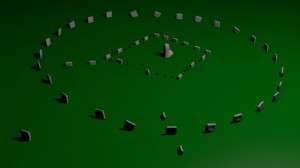
Feet on firm ground?

Hollow/void to enlarge. Daath?
Continued: Analogy of same - with something extra..."The greater vision of unity lies in the transformations of the goddess, the dancer at the 'heart of the rose'. This is a mystery to be found also in the legends of the Holy Grail and the secret of the jewel in the head of the alchemical toad {or frog?}. That which fell from the crown of the fallen Son of the Morning. Reflect upon these deep things. And thus may the wisdom of the stars shine in your brow {'mantle'?}, the grail of love flow from your heart, the waters of life encompass your loins, and the stones {'cobbles'?} of the Earth support your feet. This is the image and function of redeemed humankind, the new Adam and new Eve, conjoined in the new heaven/earth, the new Avalon where the green 'apples' have turned to gold."
Side note: In Chwarszczany, Poland, the Knights Templars were given land They built the Chapel of St. Stanislaus.
Last fall, a research team using ground-penetrating radar (GPR) uncovered a number of crypts, as well as the possible remains of an underground passageway or tunnel, while conducting excavations at the chapel of Saint Stanislaus in Chwarszczany.
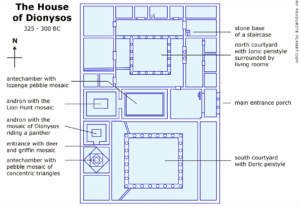
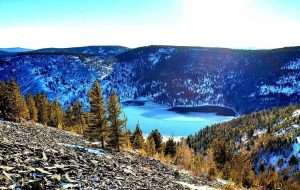
Lady of the lake?
“According to legends and medieval documents, there was a well in the vicinity of the chapel,” Przemysław Kołosowski, the lead archaeologist working on the site, tells CNN. “Rumor has it that the well served as an entrance to a secret tunnel. This still requires an exhaustive archeological investigation.”
As Jakub Pikulik reported for Polish newspaper Gazeta Lubuska last year, renovations and archaeological work at the site have been ongoing since 2004. Kołosowski’s team commenced work in July 2019, scanning the chapel and surrounding fields with the help of a hundred or so volunteers.
An excavation expected to unearth a medieval fortress yielded no substantial finds from the period. But archaeologists did discover centuries-old cobblestones, the walls of an 18th-century distillery, Bronze Age pottery and iron nails, and a 1757 coin likely left behind by Russian troops stationed nearby during the Seven Years’ War.
Inside the chapel, archaeologists investigating a small depression beneath the stone floors {'cobbled'?} found seven vaulted crypts. Per a statement from OKM, the German manufacturer of the GPR technology used by the researchers, these underground crypts “cannot be dated back to Templar times.” Instead, Gazeta Lubuska notes, the crypts were likely constructed later, only to be emptied during renovations in the second half of the 19th century. {Historis Greatest Mysteries: Lost Fortune of the Templars / S5 EP3}.
N.B A dried up lake not far away.
''In the U.S, the Prime rib is the term used to a roast or steak cut from the seven ribs immediately before the loin.'' ['The Chase'].
''The Imperial State Crown contains four pearls that are said to have been used as earrings by Elizabeth I.'' ['The Chase' / 2018].

In profile or face on?
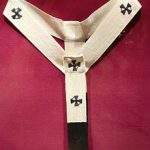
Fork in the road?
''Absolute Unity is the hidden 'god' of the Hebrews, the unknown 'god' who is incomprehensible; the unutterable of the Egyptians {i.e., Amun = ''hidden''}.....As soon as 'Unity' slits into two, presenting the two facets of any comprehensible thing {i.e., as one example represented as male' and 'female'} - there is Trinity....It is found at the origin of all things {''child'' link}.....The world emanates from the god of gods - ''he contemplates his own face''. [Page 78 'The Egyptian Miracle'].

'Higher' / 'lower' ?
"We pointed out above that the law of the tower of Babel is universal, i.e., that it works both in individual biography and in humanity - and even in other hierarchies. The point of this 'law' is that all autonomous activity from below inevitably 'meets' with divine reality above. What one has built through the autonomous effort of the ''lower self'' must, sooner or later, be confronted by divine reality, and undergo the effects of comparison with it..."[Extract from the book by Tomberg].
Stack/Stacked?

Mali. The Hero. Higher over lower?
The word ''comparison'' eventually links up to incarnation/reincarnation; on a day by day basis.
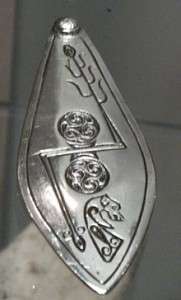
'Broken sword' as a bolt of lightening? 'Dog' in 'lower' half?
"The Flaming Door is perhaps Eleanor Merry's most famous work and made an important contribution to the renewal of Celtic mythology. Slumbering in the ancient saga's and legendsare the secrets of initiation: when men and women found their way through the 'flashing door''{sword' link?} - the threshold between the physical and spiritual worlds." ['The Flaming Door' / E. C. Merry].

Trickster or devilish imp? Question. Has someone pinched someone's hair gel?
"Lucifer attacks us in different ways. 'Lucifer' makes us liable to make mistakes. He endowed matter with a glamour that would dazzle people and blind them to higher truths. He injected a paradoxical, tricky quality into the heart of the universe and at the same time injected a perverse quality into our hearts that responds to the 'tricky' quality 'out there' [link to, 'like attracts like'. This readers input].
It is because of 'lucifer' that, as St Paul puts it, 'the good i would do, i do not, but the 'evil' i would not do, i do.' St Paul, who as we shall see was an initiate of the Mystery tradition, is saying that part of me always knows what is right, but that it is often overruled by a part that is in thrall to 'lucifer'.... ....This is right at the heart of what it is to be human. There is no easy way out and no easy answer. The road is always fraught with the danger of 'death', but if we do not take that road, we will die in our beds without ever having lived. In other words we must put at risk what we value most, [link to wants/needs in this 'material' world. This readers input]. Or we will lose it anyway. Beyond a certain point, there is no return. That point must be reached." [Chapter 3, 'The Sacred History'. Mentioned elsewhere].
Understanding this subject, according to the same authors, takes the individual up to, and beyond that point.
''Primordial Mound'' link?
 Analogy {abstract?} with same intent {principle?} in mind..."Tis an ill wind that blows NO minds." Quote from the book 'Cosmic Trigger' by R. A. Wilson.
Analogy {abstract?} with same intent {principle?} in mind..."Tis an ill wind that blows NO minds." Quote from the book 'Cosmic Trigger' by R. A. Wilson.
The words 'Lucifer' and 'Satan' both symbolic of something else, other than the obvious. I.e., 'Lucifer' a link to the 'fall'. The word 'Satan' more a link to the 'material' world. Both relative to that 'inner understanding' of something. Potential of. [See chapter 4, 'The Secret History of the World'].
Refresher: Understanding this subject, according to the same authors, takes the individual up to, and beyond that point.
"That's why it is unwise to posit Heaven and Hell as eternal contraries. There are subtle or crude graduations within these states, and Satan himself finds his redemption in Lucifer, who is sublimation into spiritual light." ['Journey into the Light'].
As a {working?} example: "This Khonsu is somehow a new, spiritualised Atum, and this one will make Horus reappear in all his glory. This Horus-lucifer whom Seth held bound in Ptah; for Seth is the one who shackles and incarcerates...Horus is delivered from evil represented by Seth; the earthly jailor from the beginning of time." ['Sacred Science'].
Try ''Khonsu'' to 'see' something further - if only in attempting to define subject material within {say} a ''landscape''.
Side note: "Allegories must always be sought in the teaching evoked by their imagery. So for the legend of Ra, or Isis', struggle to save her son Horus from the domination of the scorpion, symbol of Seth..." Same book.
Try ''scorpion'' and/or Ra in relation to Atum, and both in relation to Amun to place the parts within the whole - in order to define the 'mind set' of those that attempt to define something internal.
Side note: A very good book to 'evaluate' such 'relationships' would be 'Egyptian Book of the Dead' / M. Ashby.
'The Scorpion King' ? While recalling that Orion was stung by same. And placed 'opposite' in the night sky.
''As above, so below.'' If Scorpion 'King' represents one half of something THEN what [who?} does Orion represent?

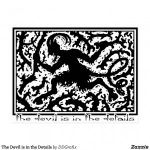 Continued: "It is more than pure and simple healing which is the object of sacred 'magic'; it is the restoration of freedom, including here the freeing of the imprisonment of doubt, fear, hate, apathy and despair. The ''evil spirits'' which deprive man of his freedom, are not at all beings of the so-called ''hierarchies of evil'' or ''fallen hierarchies''. Neither Satan nor Belial, nor Lucifer, nor Mephistopheles have ever deprived anyone of his freedom. Temptation is there only weapon and this presupposes the freedom of he who is tempted [as a representation of something. This readers input]. But possession by an ''evil spirit'' has nothing to do with temptation. It is invariably the same thing with Frankenstein's monster. One engenders an 'elemental' being and one subsequently becomes the slave of ones own 'creation'.
Continued: "It is more than pure and simple healing which is the object of sacred 'magic'; it is the restoration of freedom, including here the freeing of the imprisonment of doubt, fear, hate, apathy and despair. The ''evil spirits'' which deprive man of his freedom, are not at all beings of the so-called ''hierarchies of evil'' or ''fallen hierarchies''. Neither Satan nor Belial, nor Lucifer, nor Mephistopheles have ever deprived anyone of his freedom. Temptation is there only weapon and this presupposes the freedom of he who is tempted [as a representation of something. This readers input]. But possession by an ''evil spirit'' has nothing to do with temptation. It is invariably the same thing with Frankenstein's monster. One engenders an 'elemental' being and one subsequently becomes the slave of ones own 'creation'.
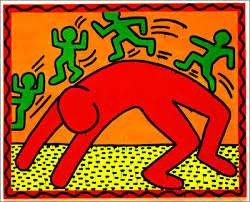
Bridge over troubled waters?

The ''demons'' or ''evil'' spirits of the New Testament are called today in psychotherapy ''neuroses of obsession'' - ''neuroses of fear'' - ''fixed ideas'', etc. They have been discovered by contemporary psychiatrists and are recognized as real - i.e., as ''parasitic psychic organisms'' independent of the conscious human will and tending to subjugate it." [Taken from 'letter three' of the book by Tomberg].
Feeling better? ''Freedom'' in relation to 'primary' and 'secondary'. Enlarged elsewhere. All the above a link to what {within this subject is defined/labelled} as the ''guardian at the gate.''
''Freewill is the greatest 'giant' in the land." Try ''giant''.
Side note: How would the word in bold print be represented?
'Devil in the details'.

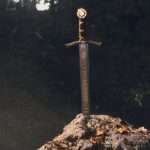 "It is thought that the word Saxon derives from seax {a small sword/knife}. Possession of a knife signified the status of a FREE person in early Anglo Saxon society. It would be suspended from a belt." ['Digging For Britain' / S9 EP1].
"It is thought that the word Saxon derives from seax {a small sword/knife}. Possession of a knife signified the status of a FREE person in early Anglo Saxon society. It would be suspended from a belt." ['Digging For Britain' / S9 EP1].
Side note: THE universe is not merely what the senses show. It is not the outer scene alone — in fact, it is never the outer scene alone but always the combination of oneself with it....
Imhotep.

Special scarab respecting the 'ancestors' of Amenhotep III. Hard {carapace} shell. 'Triple' aspect?
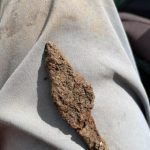
An iron angle backed knife found at a site. 'Whale' to enlarge.
It is not merely the perceptions of the senses, this hard world of earth, that outer point of light in the sky, but perceptions of ideas, insights into truths, realisations of meaning, the seeing of familiar things in a new light, intuition of essences, experiences of suffering and of bliss. It is given as bread from heaven as much as fact from earth. On its grandest scale it lies beyond all command of the senses and is only discerned inwardly in the understanding. There can suddenly be opened within the heart or in the mind a realm of experience that is not the external world (though it may interpenetrate it) and we are then bathed in the light of meaning - in that light without violence, which is pure experience, luminosity without shadow, in which the hardness of self vanishes. We see: with the authority that meaning gives us.

Priests of Anubis, the guide of the dead and the god of tombs and embalming, perform the opening of the mouth ritual. Extract from the Papyrus of Hunefer, a 19th-Dynasty Book of the Dead (c.1300 BCE)
 We touch: without the sense of separateness and externality that all physical touch inevitably gives us. We feel: in depth, without talking to ourselves, without the mirror of surface personality. Every experience of that light deeply creates us. It is creating light, transforming meaning, which all have sought since the beginning of time, light that can do no violence to anyone, meaning that shows us what we have always known and never had the strength to remember. Not only do we feel ourselves created by every experience of that light, but this, we say, is what we are always looking for - this meaning and reality, this bliss that we have misinterpreted and sought in a thousand useless physical directions - this is what we all desire, which the outer light of life pretends to offer, but never properly gives, this union which we perceive really is union, the secret idea behind our odd, searching, incomplete lives. How is this light obtained? How can we obtain this union with meaning? Through what does it shine? Where must the knife enter to open a way for it? It has always been spoken about. A man must begin to dissect himself away from himself to find it. This, in brief, is the substance of all teachings concerning it....
We touch: without the sense of separateness and externality that all physical touch inevitably gives us. We feel: in depth, without talking to ourselves, without the mirror of surface personality. Every experience of that light deeply creates us. It is creating light, transforming meaning, which all have sought since the beginning of time, light that can do no violence to anyone, meaning that shows us what we have always known and never had the strength to remember. Not only do we feel ourselves created by every experience of that light, but this, we say, is what we are always looking for - this meaning and reality, this bliss that we have misinterpreted and sought in a thousand useless physical directions - this is what we all desire, which the outer light of life pretends to offer, but never properly gives, this union which we perceive really is union, the secret idea behind our odd, searching, incomplete lives. How is this light obtained? How can we obtain this union with meaning? Through what does it shine? Where must the knife enter to open a way for it? It has always been spoken about. A man must begin to dissect himself away from himself to find it. This, in brief, is the substance of all teachings concerning it....

He is the king who introduced the royal title Sa-Rê (meaning “Son of Ra”) and the first to connect his cartouche name with the sun god Ra.

Wife / Mother / Grandmother of the Old Kingdom pharaohs. 'Dissected'?
And this he cannot do unless he begins to see himself directly as a new conscious experience, a new event, the daily event of himself - not analytically, not critically, nor as a source for talkativeness. This kind of consciousness, whose direction leads towards the region through which meaning is received, is not what we ordinarily have. Very much stands in our way. First in strength is imagination. We imagine we have it. The imagination is a psychic material out of which every substitute for reality can be made, the most powerful force in life; and second, we have to put into constant practice this process of using consciousness as a dissecting knife. This requires effort that is not needed in life. So we easily forget, and fail to keep alive what we began." {'The Mark' / M. Nichols}.
Continued: The name of the Saxons may derive from a kind of knife associated with the ethnos; such a knife has the name seax in Old English, Sax in German, sachs in Old High German, and sax in Old Norse.[8][9] The seax has had a lasting symbolic impact in the English counties of Essex and Middlesex, both of which feature three seaxes in their ceremonial emblem. The names of these counties, along with the names "Sussex" and "Wessex", contain a remnant of the root of the word "Saxon".
The Elizabethan-era play Edmund Ironside suggests that the name "Saxon" derives from the Latin saxa (stones; singular form: saxum):[10]
Their names discover what their natures are, More hard than stones, and yet not stones indeed.
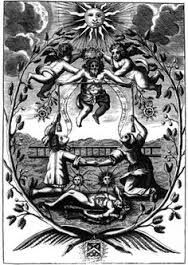
Ladder no longer required. ''Gap'' {void} now filled {attained?}. Hebrew equivalent. All within the 'form' of the Vesica Pisces {i.,e.,middle 'bit'}. Anything?
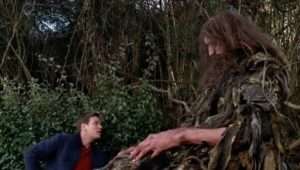 Continued: "In the Theosophical and Tarot tradition, the moon represents unconscious desires and the fears that accompany the senses of losing control or falling into the unconscious realm of sleep and dreams. However, if one is afraid to enter one's own 'astral' {look it up} territory, one can never truly know oneself - and the mystery of initiation is about little more than this. The real confrontation that the 'moon' represents is the meeting with the 'Dweller on the Threshold' of which esoteric teachers speak. This is the giant force of accumulated negatives or wrongdoings, the hideous part of the self that a person would rather not look at and would like to pretend doesn't exist, and which rises up at the point of real psychic growth. This 'demon' must not only be looked at, but integrated into the being, in order to establish wholeness...There is a line in 'Jacobs ladder', a film... where a character paraphrases a mystical saying: 'If you're holding on, then angels seem like demons, tearing your life away, but if you let go, you'll see them as angels, freeing you'. It is very true. Heart-breaking so...The gates and their guardians in the initiatory path are also found in the Tibetan Bardo Thodol, and the ancient Egyptian Book of Coming Forth by Day...They are a useful map of the initiatory process that becomes engaged when you start to seek truth and flee falsity." [Extract from the book 'The Magister'. Mentioned elsewhere].
Continued: "In the Theosophical and Tarot tradition, the moon represents unconscious desires and the fears that accompany the senses of losing control or falling into the unconscious realm of sleep and dreams. However, if one is afraid to enter one's own 'astral' {look it up} territory, one can never truly know oneself - and the mystery of initiation is about little more than this. The real confrontation that the 'moon' represents is the meeting with the 'Dweller on the Threshold' of which esoteric teachers speak. This is the giant force of accumulated negatives or wrongdoings, the hideous part of the self that a person would rather not look at and would like to pretend doesn't exist, and which rises up at the point of real psychic growth. This 'demon' must not only be looked at, but integrated into the being, in order to establish wholeness...There is a line in 'Jacobs ladder', a film... where a character paraphrases a mystical saying: 'If you're holding on, then angels seem like demons, tearing your life away, but if you let go, you'll see them as angels, freeing you'. It is very true. Heart-breaking so...The gates and their guardians in the initiatory path are also found in the Tibetan Bardo Thodol, and the ancient Egyptian Book of Coming Forth by Day...They are a useful map of the initiatory process that becomes engaged when you start to seek truth and flee falsity." [Extract from the book 'The Magister'. Mentioned elsewhere].
For a working example try Q. S. Lam.
'The Triumph of the Moon' / R. Hutton.
The above author {if only for this reader} employing such dramatic {in your face?} phrases as ''giant forces'' and ''hideous parts of'' and ''heartbreaking so'' - to define something - within a natural 'course of events' - in relation to a learning curve. Something less dramatic {yet abstract} could be...
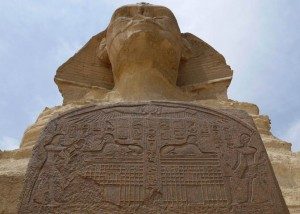
One or 'two' lions? Red lion or Green one?

Mother Russia's Prince of Peace. R.I.P.
"...This silence in itself is a mighty symbol. It is the stillness of the great feminine archetype, whether in the silence of the Sephirah Binah on the Tree of Life, the great Temple of form of all the spheres; or in the great silent UNmanifest Sea of the Ain Sof beyond Kether, the ultimate 'feminine principle'. In the silence a 'unicorn' approaches wearing a golden collar. It bows to the 'lion'. The lion thereupon breaks the sword in two, and casts the pieces into the waters of the fountain. The testing having been done, the way to the higher worlds is clear, and the lion no longer bars the way. The roaring lion in the path, the Dweller on the Threshold or Shadow Self, is no longer a barrier to progress. A white 'dove' now appears with an olive branch of peace and wisdom. The lion 'devours' it and is quieted, and the unicorn joyfully departs." [Extract from 'The Rose Cross and the Goddess' by G. Knight].
Hence: "...the single horn had been 'seeded' by the imaginative faculties...'' ['The Zelator']. 'See' it? ALL AS A MEANS...? Try ''horn''.
Cognitive faculty link?
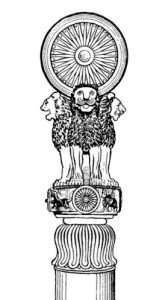
'Thirtytwo' above {vertical}. 'Twentyfour' below {horizontal}.
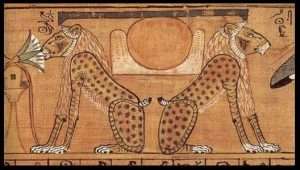
Egypts equivalent. Horizontal = 'horizon'. And/or: ''Aker was an ancient earth-god in Egypt. He was believed to guard the gates of the dawn from which the sun rose each morning. He was portrayed as a double-headed lion.'' Question. What represents a 'dawning' - the beginning of something brand new? Spots/Stripes?
A working example: ''As a result of the eventual unification of India {Mauryan Dynasty}, which involved terrible bloodshed and loss of life, Ashoka became a committed Buddhist and adopted the lion as the symbol of a new era of peace - because the Buddha belonged to the Shakya, or Lion Clan and the emperor was his devout follower - a mighty ruler of his kingdom, like the lion that rules the forest. Ashoka ruled his kingdom using the principle of universal truth and divine law, or dharma, which he understood to include such characteristics as honesty, compassion, mercy, benevolence, nonviolence, and kindness to animals....Represented with four lions sitting back-to-back atop an abacus decorated with wheels and other animals. The wheel signifies the wheel of law in Buddhism, and its thirtytwo spokes represent the 32 physical attributes of Buddha.'' [Page 37 'Archaeology' / Sep-Oct 2023].
32x2 = 'sixtyfour'.
Refresher: ''Monarchy of the eye in relation to the democracy of the nose.''
From a different perspective {a more 'grounded' one}: ''The 'magician' is the arcanum of the wholeness of consciousness, or concentration without effort. Force is the arcanum of the natural integrity of BEING, or power without effort. Because force subdues the 'lion' not by force similar to that of the lion BUT rather by a force of a higher order and on a higher plane....The 'Virgin' tames the lion and thereby invites us to leave the plane of quantity....for the plane of quality.'' Page 275 'Meditations on the Tarot'].
Odds/Evens.
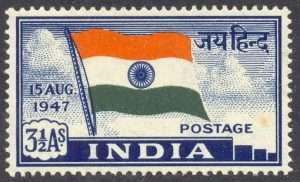
'Fifteen' and 'twentyfour' to enlarge.
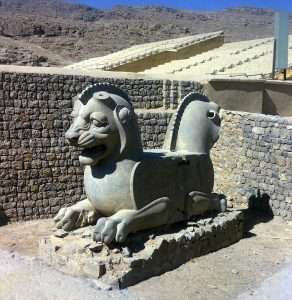
Analogy: Persepolis ( 'Throne of Jamshid') was the ceremonial capital of the Achaemenid Empire (c. 550–330 BC). It is situated in the plains of Marvdasht, encircled by southern Zagros mountains of the Iranian plateau. Modern day Shiraz is situated 60 km (37 mi) southwest of the ruins of Persepolis. The earliest remains of Persepolis date back to 515 BC. It exemplifies the Achaemenid style of architecture. UNESCO declared the ruins of Persepolis a World Heritage Site in 1979.[2]
The complex is raised high on a walled platform, with five "palaces" or halls of varying size, and grand entrances. The function of Persepolis remains unclear.'' UNIVERSAL MINDSET?
''The lion capital is among the first group of significant stone sculptures to have appeared in South Asia after the end of the Indus Valley Civilisation 1,600 years earlier. Their sudden appearance, as well as similarities to Persepolitan columns of Iran before the fall of the Achaemenid Empire in 330 BCE, have led some to conjecture an eastward migration of Iranian stonemasons among whom the tradition of naturalistic carving had been preserved during the intervening decades. Others have countered that a tradition of erecting columns in wood and copper had a history in India and the transition to stone was but a small step in an empire and period in which ideas and technologies were in a state of flux. The lion capital is rich in symbolism, both Buddhist and secular....The whole structure is 2.1 metres (7 ft) tall, carved out of a single block of sandstone and highly polished, was secured to its monolithic column by a metal dowel. Erected after Ashoka's conversion to Buddhism, it commemorated the site of Gautama Buddha's first sermon some two centuries before....
Stone/metal/plant....as a means?
In July 1947, Jawaharlal Nehru, the interim prime minister of India, proposed in the Constituent Assembly of India that the wheel on the abacus be the model for the wheel in the centre of the Dominion of India's new national flag, and the capital itself without the lotus the model for the state emblem. The proposal was accepted in December 1947.''
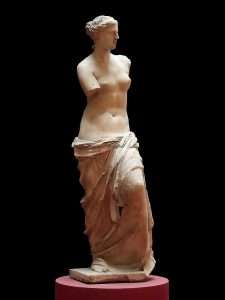
''If you say that you would give your right arm to do or have something, you mean you would like it very much.'' And/or: ''Do not let your left hand know what your right hand is doing, so that your giving may be in secret. And your Father who sees in secret will reward you” (Matthew 6:3-4 ESV). 'Serpent hands'?
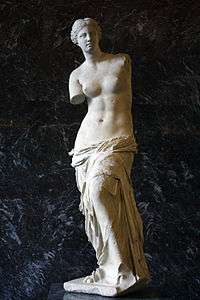
''What does being someone's right arm mean: someone's close assistant and the person they trust to help and support them in everything they do.'' Question. Lower half 'clothed'? Left leg in motion?
And/or: She is the 'mother' of the usual Divine fish-child Dylan who, after killing the usual Wren {as the new year Robin does on St. Stephen's day} becomes Llew Llaw Gyffes - the 'lion with the Steady Hand' - the accomplished 'sun-hero' with the usual heavenly 'twin' at his side....the usual Matriarchal Triple or White goddess who gives her son Llew Llaw a 'name' {new one?} and a set of arms." [Pages 97/100 'The White Goddess'].
'Raised ones'?
'Cognitive Behavioral Therapy: Techniques for Retraining The Brain' / J. Satterfield.
Side note: ''The Venus de Milo is an over 2 metres (6 ft 7 in) tall[a] Parian marble statue[3] of a Greek goddess, most likely Aphrodite, depicted with a bare torso and drapery over the lower half of her body.[2] The figure's head is turned to the left.[5] The statue is missing both arms, the left foot, and the earlobes.[6] There is a filled hole below her right breast that originally contained a metal tenon that would have supported the right arm.[7] The Venus' flesh is polished smooth, but chisel marks are still visible on other surfaces.''
Question. Could the 'arms' {if viable} be added or detracted?
N.B. Milo just north of the Sea of Crete. The 'place' Zeus was born.
Wet/Dry. Male/Female to enlarge.
From another perspective {the 'pagan' one?}: "Lastly I would like to acknowledge not another person, but a realization. It is both known and expected that portions of this book will incite many conflicting feelings {Gemini?} within its reader, as several of the prime concepts defy standard norms of esoteric and social practice. But this kind of 'stirring up' is precisely the type of THRESHOLD EVENT that the Druids themselves would have engendered....The Druids great motto: Y GWIR YN ERBYN BYD = 'The truth against the world', has one key word in its midst, which encapsulates this message perfectly. It is hoped that the reader will come to understand why it is there." [Preface to the book 'The 21 Lessons of Merlyn: A Study in Druid Magic and Lore' / D. Monroe. Includes underscore].
Upstream or Downstream?
Question. {as seen from a different perspective, i.e.,that final sentence}: Tower of Babel v Gnosis? Middle ground = ''threshold'' ? Try that one.
 Exercise: Apply those ''imaginative faculties'' by way of the cognitive one to 'see' the Egyptian analogy of same: "Leo, however, becomes Virgo. And that metamorphosis is expressed in the mysteries symbol of the Sphinx, Guardian of the path {gate?} to the Gt. Pyramid. The Sphinx is a mythical creature with the body of a lion and the head of a 'Virgin' {androgyne link}. It represents therefore, that process which unites the energies of the two zodiacal signs, Leo and Virgo; a human process, in which the personalised emotion power of the human ego {N.B. 'feelings' represented with Gemini} - THE LION - King of the beasts - King of the desert - transforms itself into the potentiality and expectancy of the 'virgin woman', waiting for the fecundity - within the sanctuary of the pyramid. This may seem an unnecessary complex riddle {link to the Sphinx riddle. Enlarged elsewhere} - But ancient symbols have great value - if only because they compel one to avoid the pitfall of ''taking things for granted''. By making things difficult, they force the mind to dig down into the roots of reality and to fathom deeply unconscious vital processes." ['The Zodiac as the Universal Matrix' / Dane Rudhyar].
Exercise: Apply those ''imaginative faculties'' by way of the cognitive one to 'see' the Egyptian analogy of same: "Leo, however, becomes Virgo. And that metamorphosis is expressed in the mysteries symbol of the Sphinx, Guardian of the path {gate?} to the Gt. Pyramid. The Sphinx is a mythical creature with the body of a lion and the head of a 'Virgin' {androgyne link}. It represents therefore, that process which unites the energies of the two zodiacal signs, Leo and Virgo; a human process, in which the personalised emotion power of the human ego {N.B. 'feelings' represented with Gemini} - THE LION - King of the beasts - King of the desert - transforms itself into the potentiality and expectancy of the 'virgin woman', waiting for the fecundity - within the sanctuary of the pyramid. This may seem an unnecessary complex riddle {link to the Sphinx riddle. Enlarged elsewhere} - But ancient symbols have great value - if only because they compel one to avoid the pitfall of ''taking things for granted''. By making things difficult, they force the mind to dig down into the roots of reality and to fathom deeply unconscious vital processes." ['The Zodiac as the Universal Matrix' / Dane Rudhyar].


Paul Alexander: The Man.
A working example: She is the 'mother' of the usual Divine fish-child Dylan who, after killing the usual Wren {as the new year Robin does on St. Stephen's day} becomes Llew Llaw Gyffes - the 'lion with the Steady Hand' - the accomplished 'sun-hero' with the usual heavenly 'twin' at his side....the usual Matriarchal Triple or White goddess who gives her son Llew Llaw a 'name' {new one?} and a set of arms." [Pages 97/100 'The White Goddess'].
''Libra is the sign of initiation''.
Try ''Libra'' to 'see' a different take on that universal merry go round - on why the Giza complex was built in the first place. Question. Any planets within that constellation?
Understanding those concepts {keys} to attempt to define a start and end point {alpha/omega and/or Zep-Tepi} - within those boundaries {'cusps'?} of ancient Egypt.
Side note - as seen from a different perspective - {that very first one?}: "The twelfth house {Pisces?} closes the cycle of human experience. It is the last stage on the way of creative accomplishment. Here, the individual either consolidates his successes into a 'seed', whence will arise a new cycle of growth {anima?} or he meets the accumulated results of his failures..." ['The Twelve Astrological Houses'].
Continued: {analogy?}: "The lion at the base of the floriated letter is swallowing a bird like creature. Perhaps it is significant of the Logos, the missing bull {authors hypothesis} - that each of the creatures has something in its mouth..." [Page 92. 'The Secret Zodiac' / F. Gettings ].

 A working example: She is the 'mother' of the usual Divine fish-child Dylan who, after killing the usual Wren {as the new year Robin does on St. Stephen's day} becomes Llew Llaw Gyffes - the 'lion with the Steady Hand' - the accomplished 'sun-hero' with the usual heavenly 'twin' at his side....the usual Matriarchal Triple or White goddess who gives her son Llew Llaw a 'name' {new one?} and a set of arms." [Pages 97/100 'The White Goddess'].
A working example: She is the 'mother' of the usual Divine fish-child Dylan who, after killing the usual Wren {as the new year Robin does on St. Stephen's day} becomes Llew Llaw Gyffes - the 'lion with the Steady Hand' - the accomplished 'sun-hero' with the usual heavenly 'twin' at his side....the usual Matriarchal Triple or White goddess who gives her son Llew Llaw a 'name' {new one?} and a set of arms." [Pages 97/100 'The White Goddess'].

Karma or fate?
And/or: Llew Llaw Gyffes ('the Lion with the Steady Hand'), a type of Dionysus or Celestial Hercules worshipped in ancient Britain, is generally identified with Lugh, the Goidelic Sun-god, who has given his name to the towns ofLaon, Leyden, Lyons and Carlisle (Caer Lugubalion). The name 'Lugh' may be connected with the Latin lux (light) or kicus (a grove); it may even be derived from the Sumerian lug meaning 'son'. 'Llew' is a different word, connected with leo (lion), an appellation of Lugh's. In Ireland he was called 'Lugh the Long-handed', defeater of the Africans, the earliest settlers in Ireland; he possessed a magic spear which thirsted for blood and flashed fire or roared aloud in battle; and he was the first to use the horse in warfare. When he approached from the West, at the Battle of Moytura, Breas (Boreas?) Balor, the one-eyed King of the old Gods and later styled Lugh's grand¬ father, cried out: 'I wonder that the Sun has risen in the West today rather than in the East.' His druids answered: 'Would that it were no more than the Sun! It is the glowing face of Lugh the Long-handed'—which nobody could gaze upon without being dazzled. {same}.
Dazzling Aten?

A clip around the ear-hole?
And/or: "Astrology and astronomy comes from the tradition of the Babylonians....A secret knowledge for the wise....to understand something about themselves....Two of those gods in the Babylonian culture were associated with planets Jupiter and Saturn. Marduk being identified with Jupiter and the king with Saturn. In 7BC a conjunction of both planets took place 'three' times in the constellation of Pisces. Supposedly the birth date of Christ.
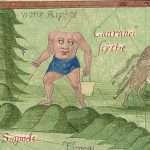
Over hills and dales?
"This can only occur when the planets are in opposition to the sun" {'line of sight'}. ....So a coming together of god and king - becoming a brighter light. Saturn was known as the "Steady one". Pisces was associated with the god of wisdom, life and creation. It told the wise men 'coming from the East' that a new order was approaching: 'Out with the old - in with the new.'...Mars { Nergal} was also part of that conjunction {in its final phase}. In the Babylonian culture that meant that the new king had to come from the West, specifically Syria Palestine because Mars was the Star of the west." 🕯️ The Search in The Desert | 1st Sunday of Advent | Star of Wonder: Pilgrimage to Light | Magdala
N.B. 'Twentyfour' mentioned {Numbers 24} in Advent 1 and Psalm 24 in Advent 2.
'The King and the Emperor' / Rebbe Nachman.
Horemheb?
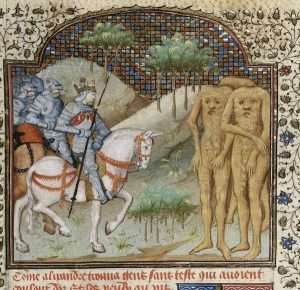
Ships of the desert: East or West?

Remedy?
Under Sumu-la-El, Marduk appeared in oaths and several year names,[19] namely year name 22, which recorded fashioning a throne for Marduk, and year name 24, which recorded making a statue for Zarpanitum.[20]
'Twentytwo / Twentyfour'?
'The Lost Princess' / Rebbe Nachman.
''Saint Stephen's Day, also called the Feast of Saint Stephen, is a Christian saint's day to commemorate Saint Stephen, the first Christian martyr or protomartyr, celebrated on 26 December in Western Christianity and 27 December in Eastern Christianity. The Eastern Orthodox churches that adhere to the Julian calendar mark Saint Stephen's Day on 27 December according to that calendar, which places it on 9 January of the Gregorian calendar used in secular contexts. In Latin Christian denominations, Saint Stephen's Day marks the second day of Christmastide.''

'Three in one'?
Something to ponder on: "The ancient Egyptian word 'Ren' means ''name''. The name is an essential attribute to the personification of a being....The ancient symbols of which are ''mouth'' and water''. The name is sometimes found encircled by a 'rope of light' called a cartouche...." [Page 137 'Egyptian Book of the Dead' / M. Ashby].
Side note: That ancient zodiac sign for Pisces - with a fish in its mouth. 'Caught' it or devouring it? As a means...?

''Longest''? E/W? What about N/S. A 'river'?
Continued: From a different perspective {with something extra}: ''The most important interpretation of Mercurius is his relation to Saturn....To the early alchemists it was lead not quicksilver that was associated with Saturn: ''My spirit is the water that loosens the rigid limbs of my brothers'' and/or: ''Quicksilver comes from the heart of Saturn.....The most perfect water and flower in the world.'' And/or: ''It is the power of the colour of water since water is 'destruction'....Khunrath calls this transformation ''luring the red/green lion out of Saturns mouth {'opening of the mouth'?}...A link to ''the lion of the tribe of Judah therefore Christ.'' [Pages 227/8 'Alchemical Studies'].
Imhotep?
That very first one?

''minds eye''.
Question. Where did Imhotep aquire that mindset? Were his parents scribes? OR Shamans? Was shamanism the origin of it all i.e., to externalize that internal awareness - by way of - 'concrete' monuments and/or rivers and seas?
For others to INTERNALIZE? - by way of - the objective process?
 Refresher: "The truly creative accomplishment of the human individual is accomplishment in totality and in plenitude of humanhood; and the framework of such a creative accomplishment is provided by the four basic phases of experience represented by the four ''angles'' of the birth-chart - first, fourth, seventh and tenth houses. These constitute the cross of human living: the permanent self, the rooted and centred personality...At the center of this cross, when lived in balance {Libra?} activity and in the conscious use of power {'meridian' and/or 'grace'?}, the Rose of human plenitude blossoms forth...'' ['The 12 Astrological Houses'].
Refresher: "The truly creative accomplishment of the human individual is accomplishment in totality and in plenitude of humanhood; and the framework of such a creative accomplishment is provided by the four basic phases of experience represented by the four ''angles'' of the birth-chart - first, fourth, seventh and tenth houses. These constitute the cross of human living: the permanent self, the rooted and centred personality...At the center of this cross, when lived in balance {Libra?} activity and in the conscious use of power {'meridian' and/or 'grace'?}, the Rose of human plenitude blossoms forth...'' ['The 12 Astrological Houses'].
Continued: And/or - but now with different keys,i.e.,from a different perspective, {i.e.,Hebrew}..."This path, leading from Yesod to Tiphareth, is the direct line of contact between the individuality and personality and on it are developed the first glimmerings of mystical or 'higher' {deeper?} consciousness. Before 'mystical' consciousness can gain a hold {grasp and 'gap' link} in the 'lower' vehicles; these vehicles have to be quietened and this process is symbolized by likening the process of development to a journey through a desert or wilderness {and/or eventually a 'river'?} - when the soul is thrown - entirely upon its own resources - assisted only by faith."
A reference is made to the 'dark night of the soul' {enlarged elsewhere} and he continues with...

